Ice recrystallisation inhibition protein or antifreeze proteins from Deschampsia species of grass
Spangenberg , et al. Ja
U.S. patent number 10,184,133 [Application Number 14/873,090] was granted by the patent office on 2019-01-22 for ice recrystallisation inhibition protein or antifreeze proteins from deschampsia species of grass. This patent grant is currently assigned to AGRICULTURE VICTORIA SERVICES PTY. LTD.. The grantee listed for this patent is Agriculture Victoria Services Pty Ltd. Invention is credited to Renata Martina Polotonianka, German Spangenberg, Peter John Ulrik.



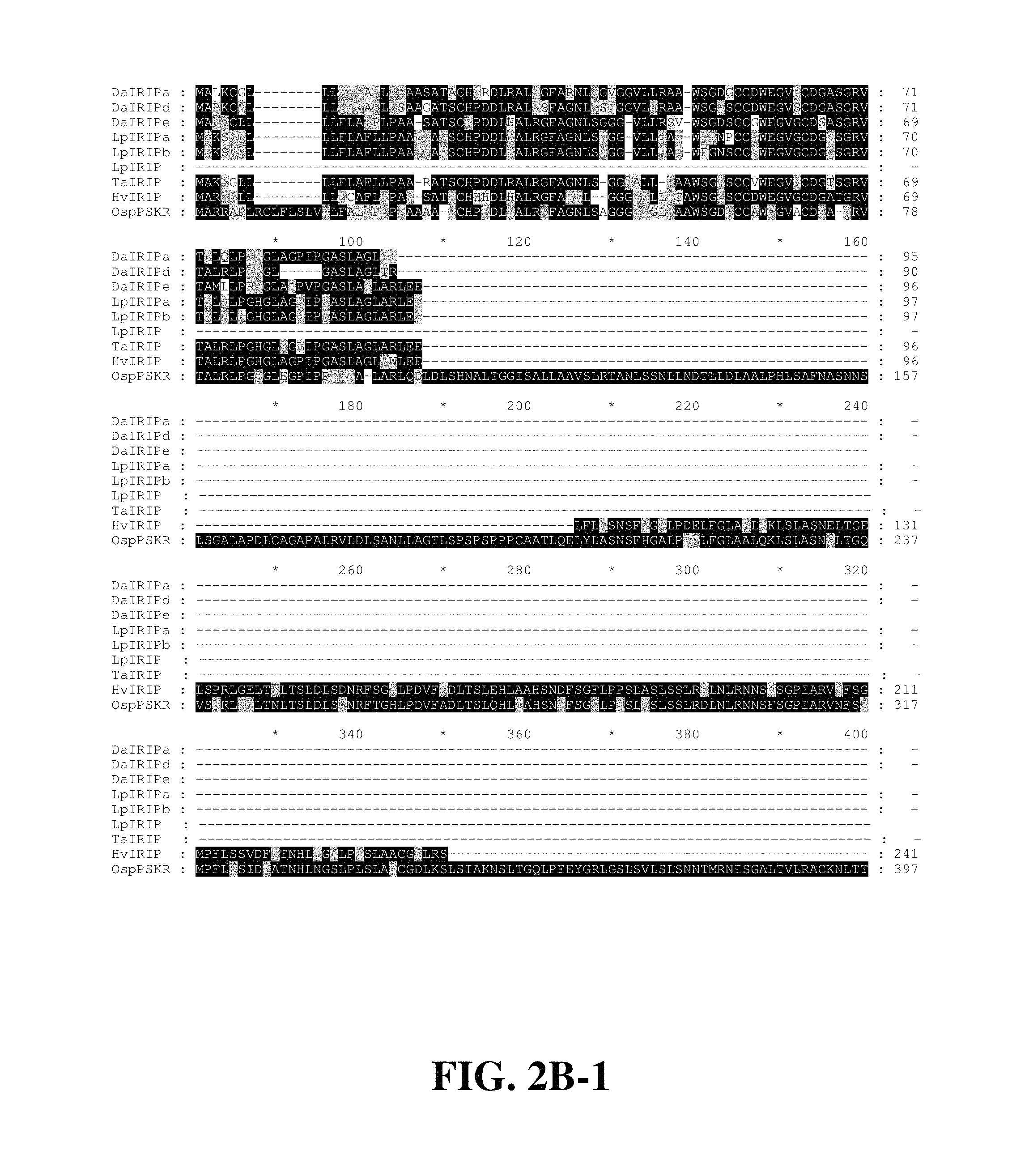
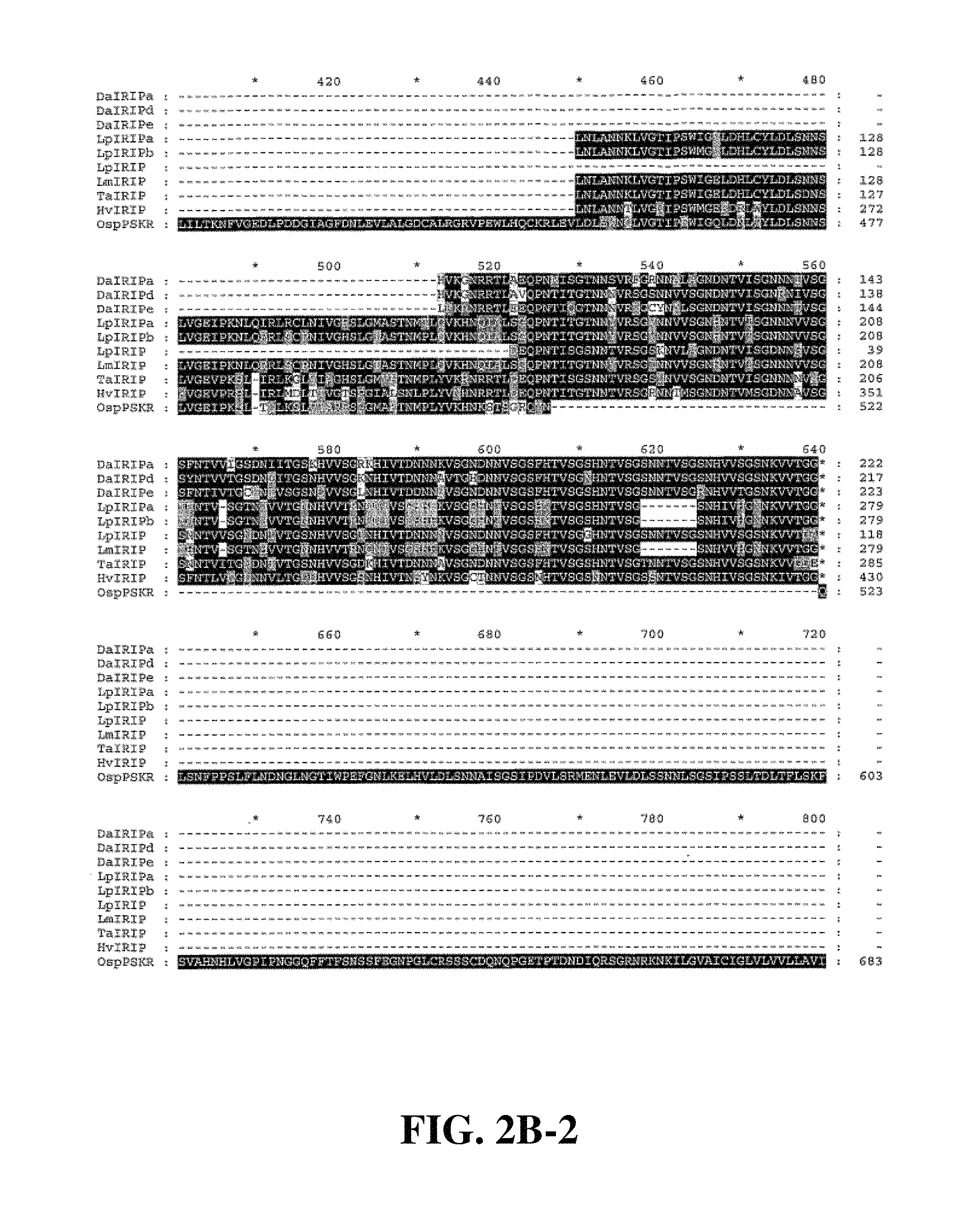
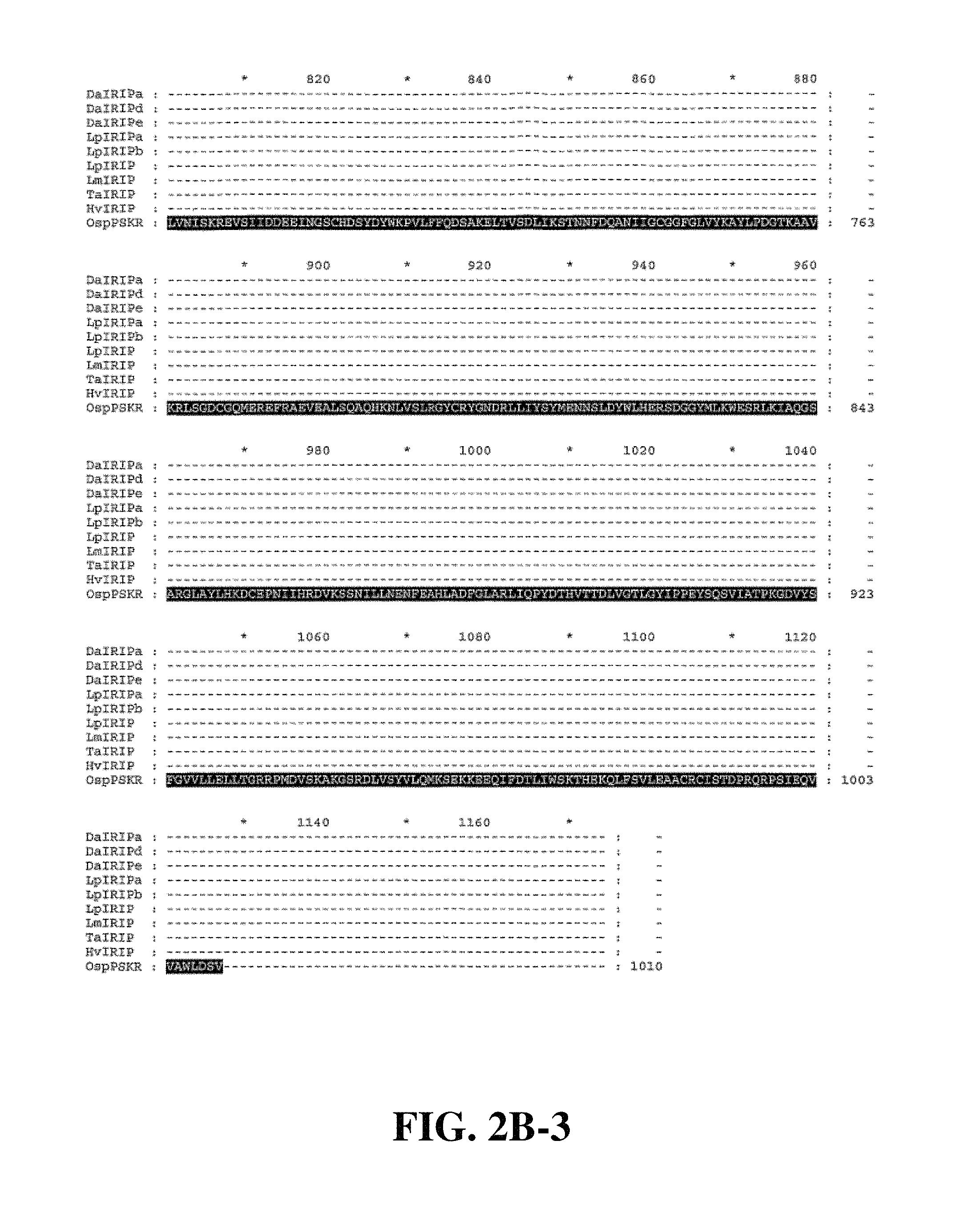
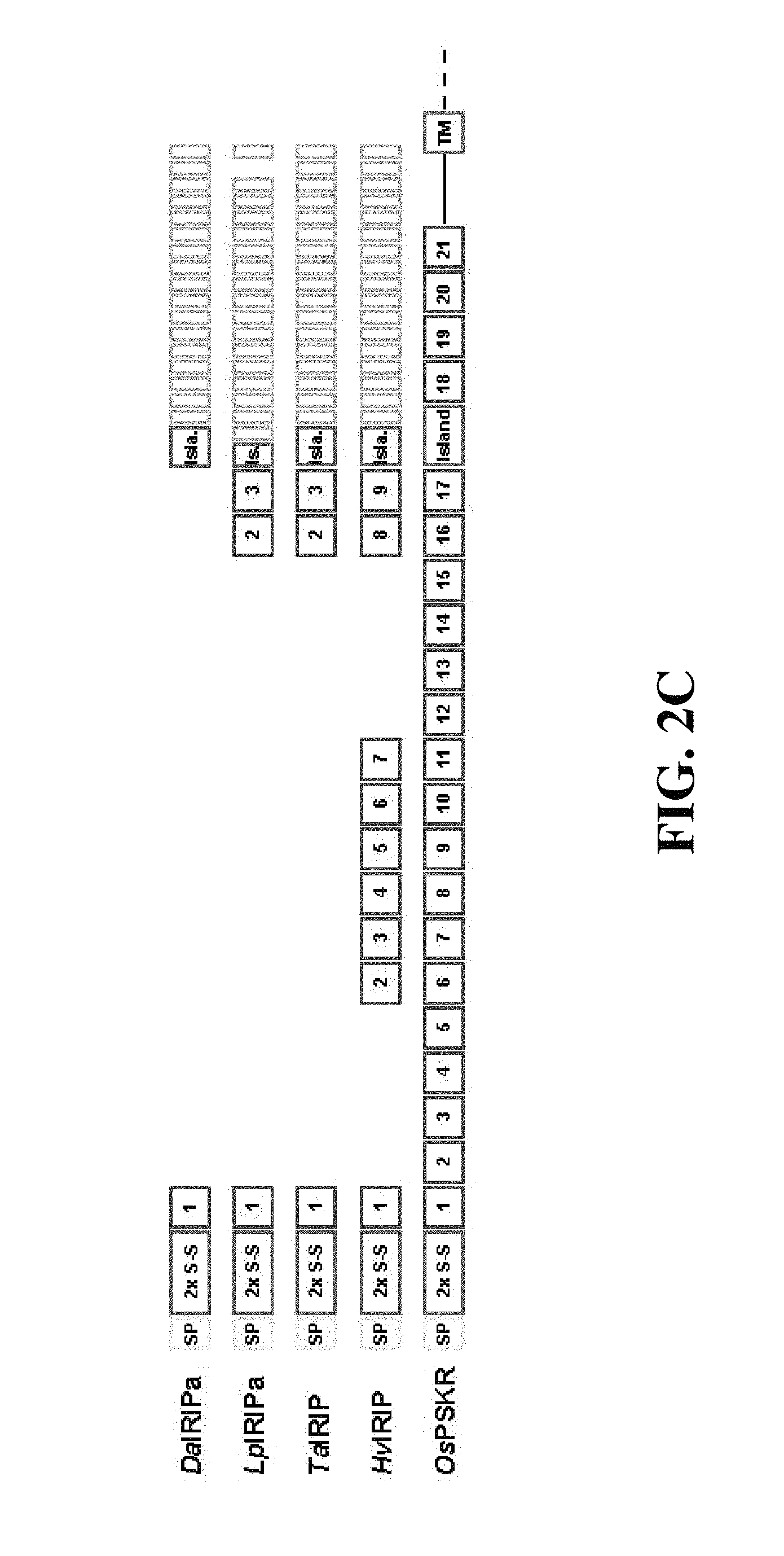

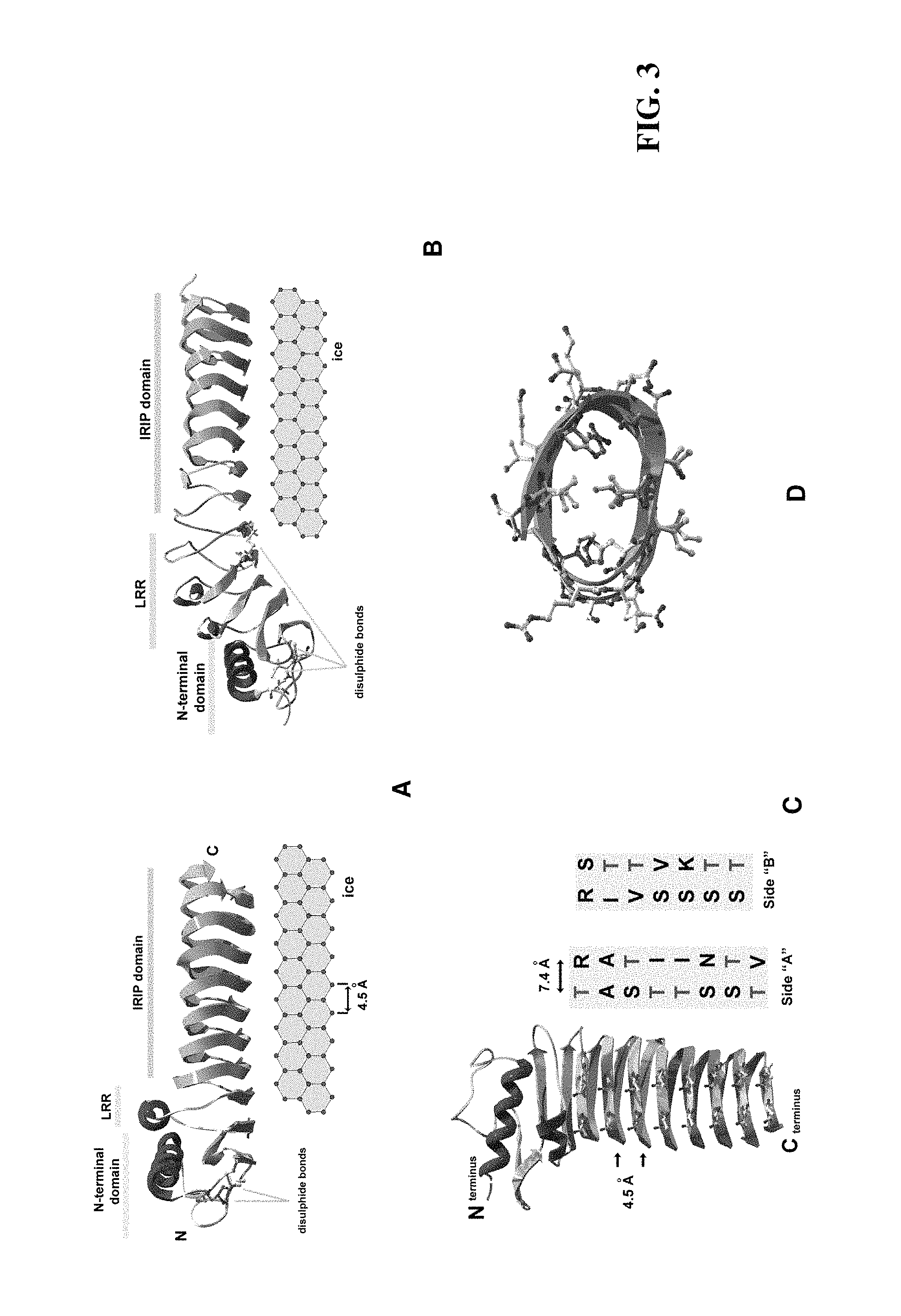
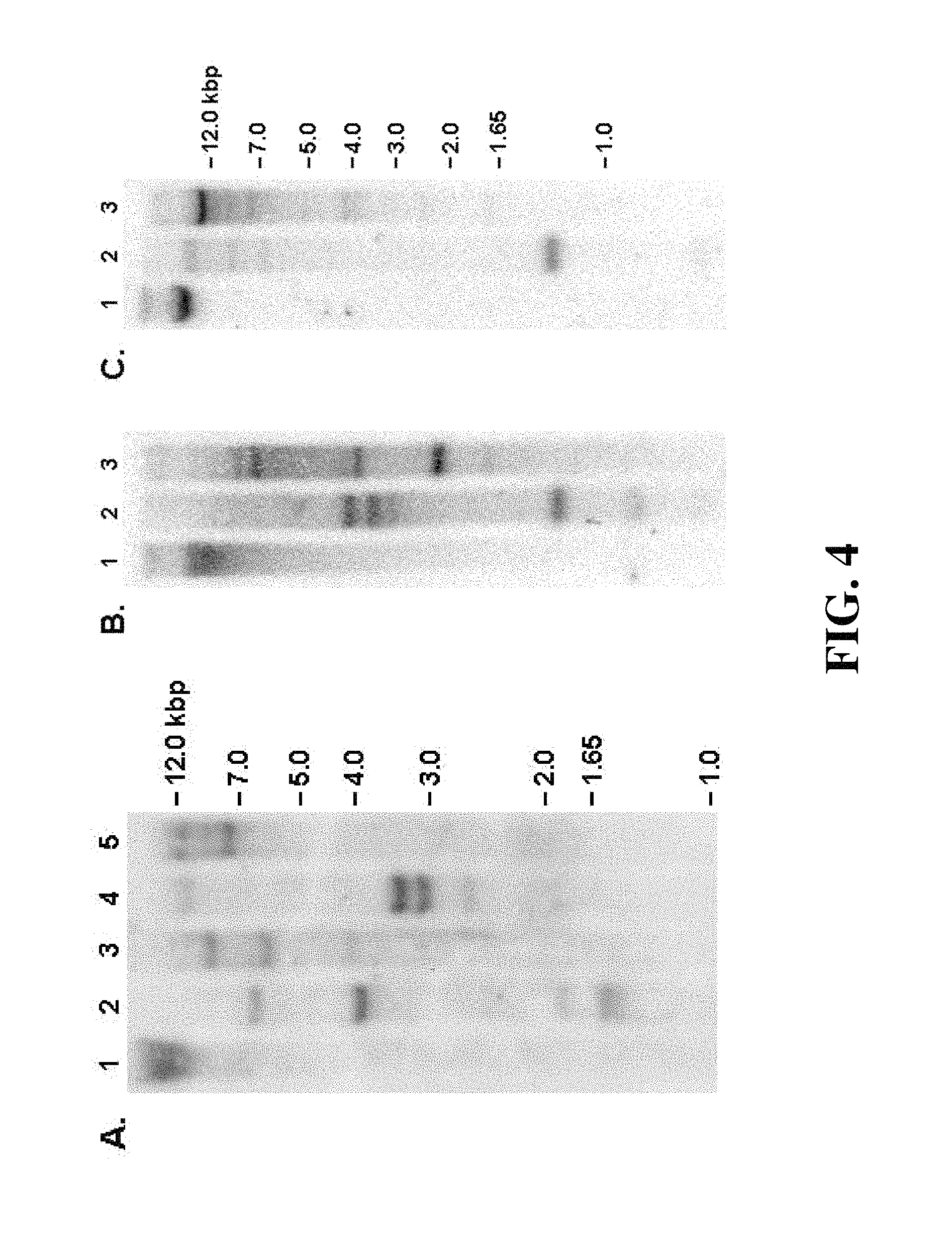


View All Diagrams
| United States Patent | 10,184,133 |
| Spangenberg , et al. | January 22, 2019 |
Ice recrystallisation inhibition protein or antifreeze proteins from Deschampsia species of grass
Abstract
The present invention relates to nucleic acids or nucleic acid fragments encoding amino acid sequences for polypeptides involved in tolerance to freezing and/or low temperature stress in plants. More particularly, the present invention relates to nucleic acids or nucleic acid fragments encoding amino acid sequences for ice recrystallization inhibition proteins (IRIPs) in plants, and the use thereof for the modification of plant response to freezing and/or low temperature stress. Even more particularly, the present invention relates to polypeptides involved in tolerance to freezing and/or low temperature stress in Deschampsia and Festuca species.
| Inventors: | Spangenberg; German (Bundoora, AU), Ulrik; Peter John (Westgarth, AU), Polotonianka; Renata Martina (Collingwood, AU) | ||||||||||
|---|---|---|---|---|---|---|---|---|---|---|---|
| Applicant: |
|
||||||||||
| Assignee: | AGRICULTURE VICTORIA SERVICES PTY.
LTD. (Attwood, Victoria, AU) |
||||||||||
| Family ID: | 34596440 | ||||||||||
| Appl. No.: | 14/873,090 | ||||||||||
| Filed: | October 1, 2015 |
Prior Publication Data
| Document Identifier | Publication Date | |
|---|---|---|
| US 20160251674 A1 | Sep 1, 2016 | |
Related U.S. Patent Documents
| Application Number | Filing Date | Patent Number | Issue Date | ||
|---|---|---|---|---|---|
| 13975378 | Aug 26, 2013 | ||||
| 13104869 | May 10, 2011 | ||||
| 10580868 | |||||
| PCT/AU2004/001633 | Nov 24, 2004 | ||||
Foreign Application Priority Data
| Nov 24, 2003 [AU] | 2003906477 | |||
| Current U.S. Class: | 1/1 |
| Current CPC Class: | C07K 14/415 (20130101); C12N 15/8273 (20130101); Y10T 436/13 (20150115) |
| Current International Class: | A01H 1/00 (20060101); C12N 15/82 (20060101); C07K 14/415 (20060101); A01H 5/12 (20180101) |
References Cited [Referenced By]
U.S. Patent Documents
| 6852841 | February 2005 | Jarman |
| 7132263 | November 2006 | Demmer |
| 2004/0146884 | July 2004 | Demmer |
| 2007/0250964 | October 2007 | Spangenberg |
| 1990013571 | Nov 1990 | WO | |||
| 1999037782 | Jul 1999 | WO | |||
| 2004022700 | Mar 2004 | WO | |||
Other References
|
McKersie et al. Acta Physiologiae Plantarum, 1997, vol. 19, No. 4, pp. 485-495, Abstract only. cited by examiner . Wallis et al. Plant Molecular Biology, 1997, vol. 35, No. 3, pp. 323-330, Abstract only. cited by examiner . Fan et al. Plant Cell Reports, Nov. 2002, vol. 21, No. 4, pp. 296-301, Abstract only. cited by examiner . Huang et al. Plant Molecular Biology, Oct. 2002, vol. 50, No. 3, Abstract only, pp. 333-344. cited by examiner . Y: Tomczak et al. (Biophysical Journal, Feb. 2002, vol. 82, No. 2, pp. 874-881, Abstract only. cited by examiner . Agriculture Victoria Services Pty Ltd., International Search Report, International Application No. PCT/AU2004/001633, 399., dated Sep. 2, 2008. cited by applicant . Atici et al., "Antifreeze proteins in higher plants," Phytochemistry, 64:1187-1196 (2003). cited by applicant . Gidekel et al., "Identification and Characterization of three novel cold acclimation-responsive genes from the extremophile hair grass Deschampsia Antarctica Desv.," Extremophiles 7:459-469 (2003). cited by applicant . Kuiper et al., "A theoretical Model of a Plant Antifreeze Protein from Lolium perenne," Biophysical Journal, 81 :3560-3565 (Dec. 2001). cited by applicant . Pudney et al., The physico-chemical characterization of a boiling stable antifreeze protein from a perennial grass (Lolium perenne), Archives of Biochemistry and Biophysics,410:238-245 (2003). cited by applicant . CoreNucleotide. NCBI [online]. 2007, [retrieved on May 31, 2007]. Retrieved from the Internet: <URL: http://www.ncbi.him.nih.gov/entrez/viewer. fcgi?db=nuccore&id=7573547>, 2pp. cited by applicant . Agriculture Victoria Services Pty Ltd., Supplemental European Search Report for EP Application No. 04797081.9 dated Sep. 2, 2008. cited by applicant . Database EMBL [Online] Jan. 12, 2002 (Jan. 12, 2002), "Hordeum vulgare subsp. Vulgare cv.Akashinriki cDNA clone:baak11i18, 3'mRNA sequence." XP002470735, Retrieved from EBI accession No. EMBL:AV910970, Abstract. cited by applicant . Database EMBL [Online] Jan. 4, 2006 (Jan. 4, 2006 ), "EST26793 Larval Stage 1 Aedes aegypti cDNA clone AEMR-LS1-076-006-U.AB1 5', mRNA sequence." XP002470736, Retrieved from EBI accession No. EMBL: DW210529, Abstract. cited by applicant . Harrison et al., "Acclimation to freezing temperatures in perennial ryegrass (Lolium perenne)", Steel in Translation, Abstract, 1 page (1998). cited by applicant . Lee et al., "Molecular cloning of abscisic acid-responsive mRNAs expressed during the induction of freezing tolerance in bromegrass (Bromus inermis Leyss) suspension culture", Plant Physiology, American Society of Plant Physiologists Rockville, MD, US, vol. 101 (1993), pp. 1089-1096. cited by applicant . Sidebottom, C. et al., "Heat-stable antifreeze proteins from grass", Nature, vol. 406, Jul. 2000, p. 256. cited by applicant . Tase et al., "Analysis of hardening related proteins in Lolium temulentum L.", Dialog Med line, Abstract, 2 pages (1996). cited by applicant. |
Primary Examiner: Bui; Phuong T
Attorney, Agent or Firm: McDermott Will & Emery LLP
Claims
What is claimed:
1. A method of increasing tolerance of freezing and/or decreasing low temperature stress in a plant, said method including: introducing into said plant a nucleic acid construct that includes a substantially purified or isolated nucleic acid sequence encoding a protein from a Deschampsia species wherein the nucleic acid sequence encoding the protein is SEQ ID NO: 37; and expressing the nucleic acid sequence encoding the protein, thereby increasing tolerance of freezing and/or decreasing low temperature stress in the plant.
2. The method of claim 1, wherein the introducing the nucleic acid construct into the plant and the expressing the nucleic acid sequence results in an increased tolerance of freezing in the plant.
3. The method of claim 1, wherein the introducing the nucleic acid construct into the plant and the expressing the nucleic acid sequence results in an decrease of low temperature stress in the plant.
Description
The present invention relates to nucleic acids or nucleic acid fragments encoding amino acid sequences for polypeptides involved in tolerance to freezing and/or low temperature stress in plants. More particularly, the present invention relates to nucleic acids or nucleic acid fragments encoding amino acid sequences for ice recrystallisation inhibition proteins (IRIPs) in plants, and the use thereof for the modification of plant response to freezing and/or low temperature stress. Even more particularly, the present invention relates to polypeptides involved in tolerance to freezing and/or low temperature stress in Deschampsia and Lolium species.
Plants have evolved a range of physiological and biochemical responses to freezing and low temperature stress. As a consequence of poikilothermy many plant species are tolerant of temperature extremes, including exposure to sub-zero temperatures. Subzero temperatures negatively impact on plant cells in many ways. As temperatures drop below freezing ice crystal formation initially takes place extracellularly, in the apoplasm. This leads to an elevation of infracellular solute concentration as water is lost by osmosis to the extracellular ice, resulting in severe dehydration. Desiccation, whereby as much as 90% of intracellular water can be lost at -10.degree. C., induces multiple forms of membrane damage. Furthermore, extracellular ice obstructs gas and solute exchange, and growing ice crystals cause plasmolysis.
Plants and other organisms that are exposed to subzero temperatures have evolved varied mechanisms to confer tolerance to freezing stress including deployment of variant isozymes, synthesis of osmoprotectants and compatible solutes, and modification of membrane lipid composition. A particular characteristic of tolerance to freezing, and to temperature stresses in general, is the phenomenon of acquired tolerance. For freezing stress this is termed cold acclimation, whereby a transition to low, non-freezing temperature can confer tolerance of subsequent exposure to otherwise lethal subzero temperatures.
A common response of plant and other species with tolerance to subzero temperatures and freezing is the expression of anti-freeze proteins (AFPs). AFPs have an affinity for ice, by virtue of structural complementarity, thereby inhibiting its growth. Adsorbtion of AFPs onto ice surfaces has two distinct effects: thermal hysteresis (TH) and recrystallisation inhibition (RI). TH results from a noncolligative freezing point depression as ice front growth becomes restricted to sterically unfavourable spaces between AFPs. This broadens the gap between the melting and freezing points of ice, and this range is the measure of TH. AFPs mediate the effect of RI by interfering with the migration of ice boundaries which normally thermodynamically favour the creation of large, ice crystals at the expense of smaller ones. Thus RI activity limits the growth of large ice crystals that have the potential to puncture cell walls and membranes and cause plasmolysis. RI activity has been identified in extracts from a limited number of plant species, and the nucleotide sequence of one ice recrystallisation inhibition protein (IRIP) conferring such activity has been reported from Lolium perenne.
Antarctic hair grass Deschampsia antarctica is one of only two angiosperms to have overcome the geographical and environmental impediments to colonising the Antarctic continent. It grows in favourable locations along the western coast of the Antarctic Peninsula. D. antarctica is an over-wintering species with a short growing season that at Palmer Station (64.degree.47'S), is typically November to March. In respect of low temperature stress, on Leonie Island in northern Marguerite Bay (67.degree.36'S) towards the southern limit of distribution of D. antarctica, air temperatures below -30.degree. C. have been recorded during the austral winter. During the growing season, when plants are most vulnerable to freezing stress, episodes of temperatures down to -15.degree. C. can occur early in the growing season. D. antarctica has a well developed cold-acclimation response, and significant cellular damage only occurs in plants exposed to temperatures substantially below those at which they freeze.
Despite D. antarctica's well developed freezing tolerance no biochemical or physiological mechanisms have been identified that can coherently account for this capacity.
There is a need for materials useful in modifying the tolerance to freezing and low temperature stress in a wide range of plants, and for methods for their use.
It is an object of the present invention to overcome, or at least alleviate, one or more of the difficulties or deficiencies associated with the prior art.
In one aspect, the present invention provides substantially purified or isolated nucleic acids or nucleic acid fragments encoding IRIPs from a Deschampsia species, preferably Antarctic hair-grass, Deschampsia antarctica, or functionally active fragments or variants thereof.
In a preferred embodiment of this aspect of the invention, the substantially purified or isolated nucleic acid or nucleic acid fragment includes a nucleotide sequence selected from the group consisting of (a) sequences shown in FIGS. 8A-8H, 9A, 9B, 11, 12, 14A-14D, 15A, 15B, 17A-17C, 18A, 18B, 20A-20C, 21, 23A-23C, and 24 hereto; (b) complements of the sequences recited in (a); (c) sequences antisense to the sequences recited in (a) and (b); (d) functionally active fragments and variants of the sequences recited in (a), (b) and (c); and (e) RNA sequences corresponding to the sequences recited in (a), (b), (c) and (d).
In another aspect, the present invention provides substantially purified or isolated nucleic acids or nucleic acid fragments encoding IRIPs from a ryegrass (Lolium) or fescue (Festuca) species. These species may be of any suitable type, including Italian or annual ryegrass, perennial ryegrass, tall fescue, meadow fescue and red fescue. Preferably the species is a ryegrass, more preferably perennial ryegrass (L. perenne).
In a preferred embodiment of this aspect of the invention, the substantially purified or isolated nucleic acid or nucleic acid fragment includes a nucleotide sequence selected from the group consisting of (a) sequences shown in FIGS. 26A-26X, 27A, 27B, 29A-29F, 30A, and 30B hereto; (b) complements of the sequences recited in (a); (c) sequences antisense to the sequences recited in (a) and (b); (d) functionally active fragments and variants of the sequences recited in (a), (b) and (c); and (e) RNA sequences corresponding to the sequences recited in (a), (b), (c) and (d).
The present invention provides substantially purified or isolated nucleic acids or nucleic acid fragments encoding amino acid sequences for a class of polypeptides which are related to IRIP or functionally active fragments or variants thereof. Such proteins are referred to herein as IRIP-like. The genes which encode these polypeptides are expressed in a similar manner to IRIP. The invention also encompasses functionally active fragments and variants of nucleic acids encoding such polypeptides.
The individual or simultaneous enhancement or otherwise manipulation of IRIP or like gene activities in plants may enhance or otherwise alter the freezing and/or low temperature tolerance of plants.
The modification of plant freezing and/or low temperature tolerance based on the individual or simultaneous enhancement or otherwise manipulation of IRIP or like gene activities in plants has significant consequences for a range of applications in plant production and plant protection. For example, it has applications in increasing the range and productivity of plants.
Methods for the modification of plant freezing and/or low temperature tolerance may facilitate the production of, for example, plants with enhanced tolerance of freezing and/or low temperature stress.
Nucleic acids according to the invention may be full-length genes or part thereof, and are also referred to as "nucleic acid fragments" and "nucleotide sequences" in this specification.
The nucleic acid or nucleic acid fragment may be of any suitable type and includes DNA (such as cDNA or genomic DNA) and RNA (such as mRNA) that is single- or double-stranded, optionally containing synthetic, non-natural or altered nucleotide bases, and combinations thereof.
Such nucleic acid fragments could be assembled to form a consensus contig.
In a further aspect of the present invention there is provided a substantially purified or isolated regulatory element from a Deschampsia species, preferably Deschampsia antarctica, said regulatory element being capable of modifying plant response to freezing and/or low temperature stress.
More preferably the regulatory element includes a nucleotide sequence selected from the groups consisting of (a) sequences shown in FIGS. 32 and 33 hereto; (b) complements of the sequences recited in (a); and (c) functionally active fragments and variants of the sequences recited in (a) and (b).
In a further aspect of the present invention there is provided a substantially purified or isolated regulatory element from a Lolium or Festuca species, preferably Lolium perenne, said regulatory element being capable of modifying plant response to freezing and/or low temperature stress.
More preferably the regulatory element includes a nucleotide sequence selected from the group consisting of (a) sequence shown in FIG. 34 hereto; (b) complement of the sequence recited in (a) and (c) functionally active fragments and variants of the sequences recited in (a) and (b).
Preferably the regulatory element is a promoter.
Preferably the regulatory element is isolated from an IRIP nucleic acid or nucleic acid fragment.
As used herein, the term IRIP-like relates to polypeptides that are produced in the plant in substantially the same organs and at substantially the same developmental stages as IRIP.
The term "isolated" means that the material is removed from its original environment (eg. the natural environment if it is naturally occurring). For example, a naturally occurring nucleic acid or polypeptide present in a living plant is not isolated, but the same nucleic acid or polypeptide separated from some or all of the coexisting materials in the natural system, is isolated. Such nucleic acids could be part of a vector and/or such nucleic acids could be part of a composition, and still be isolated in that such a vector or composition is not part of its natural environment.
As used herein, the term "consensus contig" refers to a nucleotide sequence that is assembled from two or more constituent nucleotide sequences that share common or overlapping regions of sequence homology. For example, the nucleotide sequence of two or more nucleic acid fragments can be compared and aligned in order to identify common or overlapping sequences. Where common or overlapping sequences exist between two or more nucleic acid fragments, the sequences (and thus their corresponding nucleic acid fragments) can be assembled into a single contiguous nucleotide sequence.
The term "purified" means that the nucleic acid or polypeptide is substantially free of other nucleic acids or polypeptides.
By "functionally active" in respect of a nucleic acid it is meant that the fragment or variant (such as an analogue, derivative or mutant) is capable of modifying the tolerance of freezing and/or low temperature stress in a plant. Such variants include naturally occurring allelic variants and non-naturally occurring variants. Additions, deletions, substitutions and derivatizations of one or more of the nucleotides are contemplated so long as the modifications do not result in loss of functional activity of the fragment or variant. Preferably the functionally active fragment or variant has at least approximately 80% identity to the relevant part of the above mentioned sequence, more preferably at least approximately 90% identity, most preferably at least approximately 95% identity. Such functionally active variants and fragments include, for example, those having nucleic acid changes which result in conservative amino acid substitutions of one or more residues in the corresponding amino acid sequence. Preferably the fragment has a size of at least 30 nucleotides, more preferably at least 45 nucleotides, most preferably at least 60 nucleotides.
By "functionally active" in respect of a polypeptide is meant that the fragment or variant has one or more of the biological properties of an IRIP or IRIP-like protein. Additions, deletions, substitutions and derivatizations of one or more of the amino acids are contemplated so long as the modifications do not result in loss of functional activity of the fragment or variant. Preferably the functionally active fragment or variant has at least approximately 60% identity to the relevant part of the above mentioned sequence, more preferably at least approximately 80% identity, most preferably at least approximately 90% identity. Such functionally active variants and fragments include, for example, those having conservative amino acid substitutions of one or more residues in the corresponding amino acid sequence. Preferably the fragment has a size of at least 10 amino acids, more preferably at least 15 amino acids, most preferably at least 20 amino acids.
The term "construct" as used herein refers to an artificially assembled or isolated nucleic acid molecule which includes the gene of interest. In general a construct may include the gene or genes of interest, a marker gene which in some cases can also be the gene of interest and appropriate regulatory sequences. It should be appreciated that the inclusion of regulatory sequences in a construct is optional, for example, such sequences may not be required in situations where the regulatory sequences of a host cell are to be used. The term construct includes vectors but should not be seen as being limited thereto.
The term "vector" as used herein encompasses both cloning and expression vectors. Vectors are often recombinant molecules containing nucleic acid molecules from several sources.
By "operatively linked" is meant that said regulatory element is capable of causing expression of said nucleic acid or nucleic acid fragment in a plant cell and said terminator is capable of terminating expression of said nucleic acid or nucleic acid fragment in a plant cell. Preferably, said regulatory element is upstream of said nucleic acid or nucleic acid fragment and said terminator is downstream of said nucleic acid or nucleic acid fragment.
By "an effective amount" it is meant an amount sufficient to result in an identifiable phenotypic trait in said plant, or a plant, plant seed or other plant part derived therefrom. Such amounts can be readily determined by an appropriately skilled person, taking into account the type of plant, the route of administration and other relevant factors. Such a person will readily be able to determine a suitable amount and method of administration. See, for example, Maniatis et al, Molecular Cloning: A Laboratory Manual, Cold Spring Harbor Laboratory, Cold Spring Harbor, the relevant disclosure of which is incorporated herein by reference.
It will also be understood that the term "comprises" (or its grammatical variants) as used in this specification is equivalent to the term "includes" and should not be taken as excluding the presence of other elements or features.
Genes encoding other IRIP or IRIP-like proteins for modifying the tolerance of plants to freezing and/or low temperature stress, either as cDNAs or genomic DNAs, may be isolated directly by using all or a portion of the nucleic acids or nucleic acid fragments of the present invention as hybridisation probes to screen libraries from the desired plant employing the methodology well known to those skilled in the art. Specific oligonucleotide probes based upon the nucleic acid sequences of the present invention may be designed and synthesized by methods known in the art. Moreover, the entire sequences may be used directly to synthesize DNA probes by methods known to the skilled artisan, such as random primer DNA labelling, nick translation, or end-labelling techniques, or RNA probes using available in vitro transcription systems. In addition, specific primers may be designed and used to amplify a part or all of the sequences of the present invention. The resulting amplification products may be labelled directly during amplification reactions or labelled after amplification reactions, and used as probes to isolate full length cDNA or genomic fragments under conditions of appropriate stringency.
In addition, short segments of the nucleic acids or nucleic acid fragments of the present invention may be used in protocols to amplify longer nucleic acid fragments encoding homologous genes from DNA or RNA. For example, polymerase chain reaction may be performed on a library of cloned nucleic acid fragments wherein the sequence of one primer is derived from the nucleic acid sequences of the present invention, and the sequence of the other primer takes advantage of the presence of the polyadenylic acid tracts to the 3' end of the mRNA precursor encoding plant genes. Alternatively, the second primer sequence may be based upon sequences derived from the cloning vector. For example, those skilled in the art can follow the RACE protocol [Frohman et al. (1988) Proc. Natl. Acad Sci. USA 85:8998, the entire disclosure of which is incorporated herein by reference] to generate cDNAs by using PCR to amplify copies of the region between a single point in the transcript and the 3' or 5' end. Using commercially available 3' RACE and 5' RACE systems (BRL), specific 3' or 5' cDNA fragments may be isolated [Ohara et al. (1989; Proc. Natl. Acad Sci USA 86:5673; Loh et al. (1989) Science 243:217, the entire disclosures of which are incorporated herein by reference]. Products generated by the 3' and 5' RACE procedures may be combined to generate full-length cDNAs.
In a further aspect of the present invention there is provided a substantially purified or isolated IRIP or IRIP-like polypeptide from a Deschampsia species, preferably from Antarctic hair-grass, Deschampsia antarctica; and functionally active fragments and variants thereof.
In a preferred embodiment of this aspect of the invention, the substantially purified or isolated polypeptide includes an amino acid sequence selected from the group consisting of sequences shown in FIGS. 10, 13, 16, 19, 22 and 25 hereto; and functionally active fragments and variants thereof.
In a still further aspect of the present invention there is provided a substantially purified or isolated IRIP or IRIP-like polypeptide from a ryegrass (Lolium) or fescue (Festuca) species; and functionally active fragments and variants thereof.
The ryegrass (Lolium) or fescue (Festuca) species may be of any suitable type, including Italian or annual ryegrass, perennial ryegrass, tall fescue, meadow fescue and red fescue. Preferably the species is a ryegrass, more preferably perennial ryegrass (L. perenne).
In a preferred embodiment of this aspect of the invention, the substantially purified or isolated polypeptide includes an amino acid sequence selected from the group consisting of sequences shown in FIGS. 28 and 31 hereto; and functionally active fragments and variants thereof.
The Applicant has found that the polypeptides of the present invention include relatively few leucine rich repeat (LRR) motifs.
Preferably said LLR motifs from a Deschampsia species include the consensus sequence:
TABLE-US-00001 (SEQ ID NO. 128) LxLxxNxLTGxIPxxLGxLxxLxx
or the consensus sequence:
TABLE-US-00002 (SEQ ID NO. 143) LxLxxNxLSGxIPxxLGxLxxLxx
Preferably said LRR motifs from a Lolium or Festuca species include the consensus sequence:
TABLE-US-00003 (SEQ ID NO. 129) LxLxxNxLTGxIPxxLGxLxxLxx
or the consensus sequence:
TABLE-US-00004 (SEQ ID NO. 144) LxLxxNxLSGxIPxxLGxLxxLxx
Applicant has found that polypeptides of the present invention including relatively few LRR motifs, preferably 3 or fewer LRR motifs, more preferably 1 or fewer LRR motifs, may be more efficient at modifying tolerance of freezing and/or low temperature stress in a plant than nucleic acids or nucleic acid fragments having relatively more LRR motifs, for example approximately 9 or more LRR motifs. Similarly, the nucleic acids or nucleic acid fragments encoding such polypeptides may be more efficient at modifying tolerance of freezing and/or low temperature stress in a plant.
In a further embodiment of this aspect of the invention, there is provided a polypeptide recombinantly produced from a nucleic acid or nucleic acid fragment according to the present invention. Techniques for recombinantly producing polypeptides are known to those skilled in the art.
Availability of the nucleotide sequences of the present invention and deduced amino acid sequences facilitates immunological screening of cDNA expression libraries. Synthetic peptides representing portions of the instant amino acid sequences may be synthesized. These peptides may be used to immunise animals to produce polyclonal or monoclonal antibodies with specificity for peptides and/or proteins comprising the amino acid sequences. These antibodies may be then used to screen cDNA expression libraries to isolate full-length cDNA clones of interest.
A genotype is the genetic constitution of an individual or group. Variations in genotype are essential in commercial breeding programs, in determining parentage, in diagnostics and fingerprinting, and the like. Genotypes can be readily described in terms of genetic markers. A genetic marker identifies a specific region or locus in the genome. The more genetic markers, the finer defined is the genotype. A genetic marker becomes particularly useful when it is allelic between organisms because it then may serve to unambiguously identify an individual. Furthermore, a genetic marker becomes particularly useful when it is based on nucleic acid sequence information that can unambiguously establish a genotype of an individual and when the function encoded by such nucleic acid is known and is associated with a specific trait. Such nucleic acids and/or nucleotide sequence information including single nucleotide polymorphisms (SNP's), variations in single nucleotides between allelic forms of such nucleotide sequence, can be used as perfect markers or candidate genes for the given trait.
Applicants have identified a number of SNPs of the nucleic acids or nucleic acid fragments of the present invention. These are indicated (marked with grey on the black background) in the figures that show multiple alignments of nucleotide sequences of nucleic acid fragments contributing to consensus contig sequences. See for example, FIGS. 8A-8H, 11, 14A-14D, 17A-17C, 20A-20C, 23A-23C, 26A-26X and 29A-29F hereto.
Accordingly, in a further aspect of the present invention, there is provided a substantially purified or isolated nucleic acid or nucleic acid fragment including a single nucleotide polymorphism (SNP) from a nucleic acid fragment shown in FIGS. 8A-8H, 9A, 9B, 11, 12, 14A-14D, 15A, 15B, 17A-17C, 18A, 18B, 20A-20C, 21, 23A-23C, 24, 26A-26X, 27A, 27B, 29A-29F, 30A, and 30B hereto, or complements or sequences antisense thereto.
In a still further aspect of the present invention there is provided a method of isolating a nucleic acid or nucleic acid fragment of the present invention including a single nucleotide polymorphism (SNP), said method including sequencing nucleic acid fragments from a nucleic acid library.
The nucleic acid library may be of any suitable type and is preferably a cDNA library.
The nucleic acid fragments may be isolated from recombinant plasmids or may be amplified, for example using polymerase chain reaction.
The sequencing may be performed by techniques known to those skilled in the art.
In a still further aspect of the present invention, there is provided use of nucleic acids or nucleic acid fragments of the present invention including SNP's, and/or nucleotide sequence information thereof, as molecular genetic markers.
In a still further aspect of the present invention there is provided use of a nucleic acid or nucleic acid fragment according to the present invention, and/or nucleotide sequence information thereof, as a molecular genetic marker.
More particularly, nucleic acids or nucleic acid fragments according to the present invention and/or nucleotide sequence information thereof may be used as a molecular genetic marker for quantitative trait loci (QTL) tagging, QTL mapping, DNA fingerprinting and in marker assisted selection, particularly in grasses and cereals. Even more particularly, nucleic acids or nucleic acid fragments according to the present invention and/or nucleotide sequence information thereof may be used as molecular genetic markers in grass and cereal improvement, e.g. tagging QTLs for tolerance to freezing and/or low temperature stress. Even more particularly, sequence information revealing SNPs in allelic variants of the nucleic acids or nucleic acid fragments of the present invention and/or nucleotide sequence information thereof may be used as molecular genetic markers for QTL tagging and mapping and in marker assisted selection, particularly in grasses and cereals.
In a still further aspect of the present invention there is provided a construct including a nucleic acid or nucleic acid fragment according to the present invention. The construct may be a vector.
In a preferred embodiment of this aspect of the invention, the vector may include a regulatory element such as a promoter, a nucleic acid or nucleic acid fragment according to the present invention and a terminator; said regulatory element, nucleic acid or nucleic acid fragment and terminator being operatively linked.
In a further preferred embodiment of this aspect of the invention, the vector may include a regulatory element according to the present invention, a further nucleic acid molecule and a terminator; said regulatory element, further nucleic acid molecule and terminator being operatively linked.
In a still further preferred embodiment of this aspect of the invention, the vector may include a regulatory element according to the present invention, a nucleic acid or nucleic acid fragment according to the present invention and a terminator, said regulatory element, nucleic acid or nucleic acid fragment and terminator being operatively linked.
The vector may be of any suitable type and may be viral or non-viral. The vector may be an expression vector. Such vectors include chromosomal, non-chromosomal and synthetic nucleic acid sequences, eg. derivatives of plant viruses; bacterial plasmids; derivatives of the Ti plasmid from Agrobacterium tumefaciens, derivatives of the Ri plasmid from Agrobacterium rhizogenes; phage DNA; yeast artificial chromosomes; bacterial artificial chromosomes; binary bacterial artificial chromosomes; vectors derived from combinations of plasmids and phage DNA. However, any other vector may be used as long as it is replicable, or integrative or viable in the plant cell.
The regulatory element and terminator may be of any suitable type and may be endogenous to the target plant cell or may be exogenous, provided that they are functional in the target plant cell.
In another embodiment, the construct or vector may include more than one nucleic acid. The nucleic acids within the same construct or vector may have identical or differing sequences. In one preferred embodiment, the construct or vector has at least two nucleic acids encoding functionally similar enzymes. In a particularly preferred embodiment, each further nucleic acid molecule has one or more upstream regulatory elements and one or more downstream terminators, although expression of more than one further nucleic acid molecule from an upstream regulatory element or termination of more than one further nucleic acid molecule from a downstream terminator(s) is not precluded.
Preferably the regulatory element is a promoter. A variety of promoters which may be employed in the constructs and vectors of the present invention are well known to those skilled in the art. Factors influencing the choice of promoter include the desired tissue specificity of the vector, and whether constitutive or inducible expression is desired and the nature of the plant cell to be transformed (eg. monocotyledon or dicotyledon). Particularly suitable promoters include but are not limited to the constitutive Cauliflower Mosaic Virus 35S (CaMV 35S) promoter and derivatives thereof, the maize Ubiquitin promoter, the rice Actin promoter, and the tissue-specific Arabidopsis small subunit (ASSU) promoter. Alternatively, the regulatory element may be a regulatory element according to the present invention.
A variety of terminators which may be employed in the vectors and constructs of the present invention are also well known to those skilled in the art. The terminator may be from the same gene as the promoter sequence or a different gene. Particularly suitable terminators are polyadenylation signals, such as the CaMV 35S polyA and other terminators from the nopaline synthase (nos), the octopine synthase (ocs) and the rbcS genes.
The further nucleic acid molecule may be a sequence, for example a gene or fragment thereof, or sequence antisense thereto, which is capable of modifying plant response to freezing and/or low temperature stress. It may be a nucleic acid or nucleic acid fragment according to the present invention, but is not limited thereto.
The vector, in addition to the regulatory element, the nucleic acid or nucleic acid fragment of the present invention and the terminator, may include further elements necessary for expression of the nucleic acid or nucleic acid fragment, in different combinations, for example vector backbone, origin of replication (ori), multiple cloning sites, recognition sites for recombination events, spacer sequences, enhancers, introns (such as the maize Ubiquitin (Ubi) intron), antibiotic resistance genes and other selectable marker genes [such as the neomycin phosphotransferase (npt2) gene, the hygromycin phosphotransferase (hph) gene, the phosphinothricin acetyltransferase (bar or pat) gene and the gentamycin acetyl transferase (aaacCI) gene], and reporter genes (such as beta-glucuronidase (GUS) gene (gusA) and green fluorescent protein (gfp)]. The vector may also contain a ribosome binding site for translation initiation. The vector may also include appropriate sequences for amplifying expression.
As an alternative to use of a selectable marker gene to provide a phenotypic trait for selection of transformed host cells, the presence of the construct or vector in transformed cells may be determined by other techniques well known in the art, such as PCR (polymerase chain reaction), Southern blot hybridisation analysis, histochemical GUS assays, visual examination including microscopic examination of fluorescence emitted by gfp, northern and Western blot hybridisation analyses.
Those skilled in the art will appreciate that the various components of the construct or vector are operatively linked, so as to result in expression of said nucleic acid or nucleic acid fragment. Techniques for operatively linking the components of the vector of the present invention are well known to those skilled in the art. Such techniques include the use of linkers, such as synthetic linkers, for example including one or more restriction enzyme sites.
The constructs and vectors of the present invention may be incorporated into a variety of plants, including monocotyledons (such as grasses from the genera Deschampsia, Lolium, Festuca, Paspalum, Pennisetum, Panicum and other forage and turf grasses, corn, oat, sugarcane, wheat and barley), dicotyledons (such as Arabidopsis, tobacco, white clover, red clover, subterranean clover, alfalfa, eucalyptus, potato, sugarbeet, canola, soybean, chickpea) and gymnosperms.
Techniques for incorporating the constructs and vectors of the present invention into plant cells (for example by transduction, transfection or transformation) are well known to those skilled in the art. Such techniques include Agrobacterium-mediated introduction, electroporation to tissues, cells and protoplasts, protoplast fusion, injection into reproductive organs, injection into immature embryos and high velocity projectile introduction to cells, tissues, calli, immature and mature embryos. The choice of technique will depend largely on the type of plant to be transformed.
Cells incorporating the constructs and vectors of the present invention may be selected, as described above, and then cultured in an appropriate medium to regenerate transformed plants, using techniques well known in the art. The culture conditions, such as temperature, pH and the like, will be apparent to the person skilled in the art. The resulting plants may be reproduced, either sexually or asexually, using methods well known in the art, to produce successive generations of transformed plants.
In a further aspect of the present invention there is provided a plant cell, plant, plant seed or other plant part, including, e.g. transformed with, a construct or vector of the present invention.
The plant cell, plant, plant seed or other plant part may be from any suitable species, including monocotyledons, dicotyledons and gymnosperms.
The present invention also provides a plant, plant seed or other plant part, or a plant extract, derived from a plant cell of the present invention.
The present invention also provides a plant, plant seed or other plant part, or a plant extract, derived from a plant of the present invention.
In a further aspect of the present invention there is provided a method of modifying tolerance of freezing and/or low temperature stress in a plant, said method including introducing into said plant an effective amount of a nucleic acid or nucleic acid fragment, construct and/or a vector according to the present invention.
Using the methods and materials of the present invention, the tolerance of freezing and/or low temperature stress in a plant may be increased or decreased or otherwise modified. For example, the tolerance of freezing and/or low temperature stress may be increased or otherwise altered. They may be increased, for example, by incorporating additional copies of a sense nucleic acid or nucleic acid fragment of the present invention. They may be decreased, for example, by incorporating an antisense nucleic acid or nucleic acid fragment of the present invention.
In a further aspect of the present invention there is provided a preparation for transforming a plant comprising at least one nucleic acid according to the present invention. The preparation may contain vectors or other constructs to facilitate administration to and/or transformation of the plant with the nucleic acid.
The present invention will now be more fully described with reference to the accompanying Examples and drawings. It should be understood, however, that the description following is illustrative only and should not be taken in any way as a restriction on the generality of the invention described above.
In the Figures:
FIG. 1. RI assay on total extracts of leaves from non-acclimated (grown at 22.degree. C.) and cold acclimated (5.degree. C.) D. antarctica. A, Initial ice crystal structure following snap freezing. B, Ice crystal structure after 16 h incubation at -3.degree. C. Capillary B contains extraction buffer; capillaries 1-7: 1000, 250, 62.5, 15.6, 3.91,
0.977 and 0.244 .mu.g mL.sup.-1 respectively of total leaf protein. Extracts were either untreated or subject to incubation at 95.degree. C. for 5 min as indicated. Endpoint of RI activity defined as the lowest protein concentration (.mu.g mL.sup.-1) at which ice crystal structure in B remains unchanged from that in A.
FIGS. 2A-1, 2A-2, 2B-1, 2B-2, 2B-3, 2C, 2D. FIG. 2A-1 and FIG. 2A-2: Repeat structures of representative IRIP orthologues HvIRIP (FIG. 2A-1; SEQ ID NO. 126) and DaIRIPd (FIG. 2A-2; SEQ ID NO. 31). Four cysteine residues conserved in LRR proteins, and predicted to form two disulphide bridges are shown, connected by lines to show predicted bridges. A highly conserved 9 amino acid motif including 3 of these cysteine residues is underlined. Consensus sequences for plant LRRs (SEQ ID NOs. 128 and 143) (Kobe and Kajava (2001) Curr Opin Struct Biol 11:725), and the IRIP repeat (SEQ ID NO. 141) are shown in bold below the tandem repeat alignments, and identical residues are apparent. FIG. 2B-1; FIG. 2B-2; FIG. 2B-3: Sequence alignment of IRIP orthologues and a putative PSKR orthologue from Oryza sativa. Sequences include LpIRIP (Sidebottom, et al. (2000 Nature 406:256)) (SEQ ID NO. 124), predicted IRIP orthologue TaIRIP derived from assembly of T. aestivum sequences in the NCBI EST database (SEQ ID NO. 125), predicted HvIRIP derived from assembly of H. vulgare sequences in the NCBI EST database (SEQ ID NO. 126), predicted LmIRIP derived from assembly of L. multiflorum sequences in the NCBI EST database (SEQ ID NO. 142), and OsPSKR a putative PSKR orthologue from Oryza sativa (NP_911036) (SEQ ID NO. 127). Sequences of the present invention are DaIRIPa (SEQ ID NO. 17), DaIRIPd (SEQ ID NO. 31) DaIRIPe.7 (SEQ ID NO. 38), LpIRIPa (SEQ ID NO. 102) and LpIRIPb (SEQ ID NO. 120). Identical and conserved residues are apparent from the alignments. Four invariantly conserved cysteine residues are also apparent. FIG. 2C: Schematic of domain organisation in IRIP orthologues and OsPSKR. SP: signal peptide; 2.times. S-S; domain predicted to form 2 disulphide bridges; LRRs numbered; Island/Isla/Is.: island domain; IRIP repeats unlabelled; TM: transmembrane domain. FIG. 2D: Phylogenetic tree of IRIP orthologues and LRR proteins. Branch lengths are proportional to the number of amino acid substitutions per site (indicated by scale bar). LRR proteins include accession number as suffix.
FIG. 3. Structural modelling of IRIPs. Panel A, Theoretical structure of DaIRIPa aligned along the prism face of ice (parallel to the a-axis). Panel B, Theoretical structure of LpIRIPa aligned along the prism face of ice (parallel to the a-axis). Cysteine residues at positions 120 and 143 have been modelled to participate in an additional disulphide bond, relative to DaIRIPa. Panel C, Ribbon backbone diagram of DaIRIPa highlighting the amino acid residue composition of the two putative ice binding surfaces, side "A" and side "B". Panel D, Cross-sectional view of ribbon backbone of 2 .beta.-roll loops of DaIRIPa showing positions of amino acid residue side chains.
FIG. 4. Genomic organisation of IRIP genes. A, D. antarctica genomic Southern probed with DaIRIPe. B, L. perenne polygenic genomic Southern probed with LpIRIPa. C, L. perenne isogenic genomic Southern probed with LpIRIPa. 1: Undigested; 2: SphI; 3: KpnI; 4: HindIII; 5: BamHI.
FIG. 5. SNP-based genetic mapping. A, Distribution of locus-specific amplification primers, genomic amplicons and putative SNP loci across the components of the LpIRIPa transcriptional unit. LpIRIP SNPs are indicated using the nomenclature na (number), indicating that the SNP was identified between NA.sub.6 parental haplotypes, and the relevant base pair coordinate. SNPs derived from single gene copies that segregate in the F.sub.1 progeny are shown in bold, while SNPs that potentially discriminate between paralogous gene copies are shown in normal text. B, Genetic map order in the upper part of the LG1 of the NA.sub.6 parental genetic map, showing the LpIRIPNA476-detected SNP locus.
FIG. 6. Analysis of IRIP gene expression in response to temperature. A, Northern blot of RNA from D. antarctica leaves and roots grown at 22, 4, and -16.degree. C., probed with DaIRIPe. B, Northern blot of RNA from L. perenne leaves and roots grown at 22 and 4.degree. C., probed with LpIRIPa.
FIG. 7. RI assay on total extracts of E. coli expressing a putative orthologue of histone H3.2 and DaIRIPe. A, Initial ice crystal structure following snap freezing. B, Ice crystal structure after 16 h incubation at -3.degree. C. Capillary EB contains extraction buffer; capillary BSA 1000 .mu.g mL.sup.-1 bovine serum albumin; capillary PC cold acclimated D. antarctica leaf extract as positive control; capillaries 1-4: 400, 100, 25 and 6.25 .mu.g mL.sup.-1 respectively of total extracts of E. coli.
FIG. 8A to FIG. 8H. Nucleotide sequences of the nucleic acid fragments contributing to the consensus contig sequence DaIRIPa (SEQ ID NOs. 1-15)
FIG. 9A to FIG. 9B. Consensus nucleotide sequence of DaIRIPa (SEQ ID NO. 16)
FIG. 10. Deduced amino acid sequence of DaIRIPa (SEQ ID NO. 17)
FIG. 11. Nucleotide sequences of the nucleic acid fragments contributing to the consensus contig sequence DaIRIPb (SEQ ID NOs. 18-20)
FIG. 12. Consensus nucleotide sequence of DaIRIPb (SEQ ID NO. 21)
FIG. 13. Deduced amino acid sequence of DaIRIPb (SEQ ID NO. 22)
FIG. 14A to FIG. 14D. Nucleotide sequences of the nucleic acid fragments contributing to the consensus contig sequence DaIRIPd (SEQ ID NOs. 23-29)
FIG. 15A to FIG. 15B. Consensus nucleotide sequence of DaIRIPd (SEQ ID NO. 30)
FIG. 16. Deduced amino acid sequence of DaIRIPd (SEQ ID NO. 31)
FIG. 17A to FIG. 17C Nucleotide sequences of the nucleic acid fragments contributing to the consensus contig sequence DaIRIPe7 (SEQ ID NOs. 32-36)
FIG. 18A to FIG. 18B. Consensus nucleotide sequence of DaIRIPe7 (SEQ ID NO. 37)
FIG. 19. Deduced amino acid sequence of DaIRIPe7 (SEQ ID NO. 38)
FIG. 20A to FIG. 20C. Nucleotide sequences of the nucleic acid fragments contributing to the consensus contig sequence DaIRIPe8 (SEQ ID NOs. 39-44)
FIG. 21. Nucleotide sequence of DaIRIPe8 (SEQ ID NO. 45)
FIG. 22. Deduced amino acid sequence of DaIRIPe8 (SEQ ID NO. 46)
FIG. 23A to FIG. 23C. Nucleotide sequences of the nucleic acid fragments contributing to the consensus contig sequence DaIRIPf (SEQ ID NOs. 47-52)
FIG. 24. Consensus nucleotide sequence of DaIRIPf (SEQ ID NO. 53)
FIG. 25. Deduced amino acid sequence of DaIRIPf (SEQ ID NO. 54)
FIG. 26A to FIG. 26X. Nucleotide sequences of the nucleic acid fragments contributing to the consensus contig sequence LpIRIPa (SEQ ID NOs. 55-100)
FIG. 27A to FIG. 27B. Consensus nucleotide sequence of LpIRIPa (SEQ ID NO. 101)
FIG. 28. Deduced amino acid sequence of LpIRIPa (SEQ ID NO. 102)
FIG. 29A to FIG. 29F. Nucleotide sequences of the nucleic acid fragments contributing to the consensus contig sequence LpIRIPb (SEQ ID NOs. 103-118)
FIG. 30A to FIG. 30B. Consensus nucleotide sequence of LpIRIPb (SEQ ID NO. 119)
FIG. 31. Deduced amino acid sequence of LpIRIPb (SEQ ID NO. 120)
FIG. 32. Nucleotide sequence of promoter region of DaIRIPa extending to the initiating ATG (underlined) (SEQ ID NO. 121)
FIG. 33. Nucleotide sequence of promoter region of DaIRIPd extending to the initiating ATG (underlined) (SEQ ID NO. 122)
FIG. 34. Nucleotide sequence of promoter region of LpIRIPa extending to the initiating ATG (underlined) (SEQ ID NO. 123)
FIG. 35. Plasmid map of vector used for DaIRIPa gain of function biolistic transformation of wheat.
FIG. 36. Plasmid map of vector used for DaIRIPd gain of function biolistic transformation of wheat.
FIG. 37. Plasmid map of vector used for DaIRIPe7 gain of function biolistic transformation of wheat.
FIG. 38. Plasmid map of vector used for DaIRIPe8 gain of function biolistic transformation of wheat.
FIG. 39. Plasmid map of vector used for LpIRIPa gain of function biolistic transformation of ryegrass.
FIG. 40. Plasmid map of vector used for LpIRIPb gain of function biolistic transformation of ryegrass.
FIG. 41. Plasmid map of vector used for LpIRIPa loss of function biolistic transformation of ryegrass.
FIG. 42. Plasmid map of vector used for LpIRIPb loss of function biolistic transformation of ryegrass.
FIG. 43. Plasmid map of vector used for DaIRIPa gain of function Agrobacterium mediated transformation of wheat and barley.
FIG. 44. Plasmid map of vector used for DaIRIPd gain of function Agrobacterium mediated transformation of wheat and barley.
FIG. 45. Plasmid map of vector used for DaIRIPe7 gain of function Agrobacterium mediated transformation of wheat and barley.
FIG. 46. Plasmid map of vector used for DaIRIPe8 gain of function Agrobacterium mediated transformation of wheat and barley.
FIG. 47. Plasmid map of vector used for DaIRIPa gain of function Agrobacterium mediated transformation of Arabidopsis.
FIG. 48. Plasmid map of vector used for DaIRIPd gain of function Agrobacterium mediated transformation of Arabidopsis.
FIG. 49. Plasmid map of vector used for DaIRIPe7 gain of function Agrobacterium mediated transformation of Arabidopsis.
FIG. 50. Plasmid map of vector used for DaIRIPe8 gain of function Agrobacterium mediated transformation of Arabidopsis.
FIG. 51. Plasmid map of vector used for LpIRIPa gain of function Agrobacterium mediated transformation of Arabidopsis.
FIG. 52. Plasmid map of vector used for LpIRIPb gain of function Agrobacterium mediated transformation of Arabidopsis.
FIG. 53. Plasmid map of vector used for DaIRIPd promoter::GUS reporter gene Agrobacterium mediated transformation of Arabidopsis.
EXAMPLE 1
Materials and Methods
Plant Propagation, Stress Treatments, Extraction of RI Activity, DNA and RNA
D. antarctica material was collected in the vicinity of Jubany station on King George Island (62.degree. 14'S 58.degree. 40'W). Plants were germinated from seeds in the soil seed bank and thereafter were propagated vegetatively. Lolium perenne plants were of cultivar Impact. Doubled haploid L. perenne plants were isolate DH297 of cultivar Verna.
Individual plants were grown in soil at the indicated temperatures under a 16/8 h light/dark regime and photosynthetic photon flux intensity of 400 .mu.mol m.sup.-2 s.sup.-1 in Enconair (Winnipeg, Canada) GC-20 plant growth chambers. Plants were cold acclimated by growth at 5.degree. C. for 2 weeks. Plants were divided into aerial and subterranean parts and snap frozen in liquid N2.
Total cellular extracts were prepared after (Doucet et al (2000) Cryobiology 40:218) by grinding plant material under liquid N2 and resuspending the powder in 2 mL g.sup.-1 of freshly prepared extraction buffer (50 mM Tris pH 7.4, 20 mM ascorbate, 10 mM EDTA). The extract was filtered through miracloth (Calbiochem, La Jolla, USA). Apoplastic extracts were based on the method of Chun et al (1998) Euphytica 102:219. Leaf material was vacuum infiltrated in extraction buffer for 30 min, excess liquid removed from the leaves, and extracts collected by centrifugation at 800 g for 30 min. All extracts were aliquoted, frozen in liquid N2, and stored at -80.degree. C.
RNA and DNA were extracted using RNeasy and DNeasy Plant Mini kits (QIAGEN, Germany) respectively.
Ice Recrystallisation Inhibition (RI) Assays
Extracts were thawed and insoluble material pelleted by centrifugation at 16,060 g for 5 min. Supernatants were collected and for total cellular extracts protein content quantified using the Bio-Rad protein assay (Bio-Rad, Mississauga, ON, Canada), according to the manufacturer's instructions. Unless otherwise stated all extracts were incubated at 95.degree. C. for 5 min. The supernatants from both heat treated and untreated extracts were collected following centrifugation at 16,060 g for 2 min. Serial 2 or 4-fold dilutions into extraction buffer were prepared.
The capillary method for the RI assay was modified from that of Tomczak et al (2003) Biochem. Biophys. Res. Commun. 311:1041. Briefly, extracts were loaded into 10 .mu.l glass capillaries (Drummond Scientific, Broomall, Pa., USA), heat sealed and arrayed on a glass slide secured with adhesive tape. Extraction buffer, and BSA (Bio-Rad, Mississauga, ON, Canada) dissolved in extraction buffer to a final concentration of 1000 .mu.g mL.sup.-1 were included as negative controls. The capillary array was snap-frozen in an ethanol/dry ice bath and immersed in a reservoir of motor vehicle coolant diluted to a final concentration of 10% monoethylene glycol, atop a jacketed stage through which the same solution at -3.degree. C. was circulated using a refrigerated water bath (PolyScience Model 910, Niles, Ill., USA).
Samples were scored after overnight (.about.16 h) incubation at -3.degree. C. The endpoint of RI activity in total leaf extracts is defined as the lowest protein concentration (.mu.g mL.sup.-1) at which ice crystal structure following incubation at -3.degree. C. for 16 h, remained unchanged from that initially induced by snap freezing. For apoplastic extracts, because of the low yields of protein from non-acclimated plants, the endpoint of RI activity was expressed as the equivalent wet weight of starting plant material per volume of extract.
Digital images were captured with a Leica DFC 300 F camera mounted on a Leica MZFL III stereoscopic zoom microscope using Leica FireCam software (Leica, Heerbrugg, Switzerland). Polarising light filters mounted perpendicularly on the microscope objective lens and beneath the stage enhanced visualisation of ice crystal morphology.
Preparation of cDNA Libraries, Isolation and Sequencing of cDNAs Coding for IRIPs from Antarctic Hair-Grass, Deschampsia antarctica.
cDNA libraries representing mRNAs from various organs and tissues from Antarctic hair-grass, Deschampsia antarctica were prepared. The characteristics of the libraries are described below (Table 1).
TABLE-US-00005 TABLE 1 cDNA libraries from Antarctic hair-grass, Deschampsia antarctica. Library Organ/Tissue 05Da Aerial parts grown at 4.degree. C. 08Da Roots grown at -15.degree. C. 09Da Roots transferred from -15.degree. C. to 25.degree. C. for 24 h 10Da Aerial parts transferred from -15.degree. C. to 25.degree. C. for 24 h 11Da Aerial parts grown at -15.degree. C. 12Da Roots grown at -15.degree. C. 15Da Roots grown at 4.degree. C. 16Da Aerial parts grown at 4.degree. C. 17Da Roots transferred from 25.degree. C. to 0.degree. C. for 48 h 18Da Aerial parts transferred from -15.degree. C. to 0.degree. C. for 48 h 19Da Aerial parts transferred from 25.degree. C. to 0.degree. C. for 48 h, then to -15.degree. C. for 48 h 20Da Aerial parts grown at -15.degree. C. 21Da Aerial parts grown at 4.degree. C. 22Da Roots grown at -15.degree. C. 23Da Roots grown at 4.degree. C.
The cDNA libraries may be prepared by any of many methods available. For example, total RNA may be isolated using the Trizol method (Gibco-BRL, USA) or the RNeasy Plant Mini kit (Qiagen, Germany), following the manufacturers' instructions. cDNAs may be generated using the SMART PCR cDNA synthesis kit (Clontech, USA), cDNAs may be amplified by long distance polymerase chain reaction using the Advantage 2 PCR Enzyme system (Clontech, USA), cDNAs may be cleaned using the GeneClean spin column (Bio 101, USA), tailed and size fractionated, according to the protocol provided by Clontech. The cDNAs may be introduced into the pGEM-T Easy Vector system 1 (Promega, USA) according to the protocol provided by Promega. The cDNAs in the pGEM-T Easy plasmid vector are transfected into Escherichia coli Epicurian coli XL10-Gold ultra competent cells (Stratagene, USA) according to the protocol provided by Stratagene.
Alternatively, the cDNAs may be introduced into plasmid vectors for first preparing the cDNA libraries in Uni-ZAP XR vectors according to the manufacturer's protocol (Stratagene Cloning Systems, La Jolla, Calif., USA). The Uni-ZAP XR libraries are converted into plasmid libraries according to the protocol provided by Stratagene. Upon conversion, cDNA inserts will be contained in the plasmid vector pBluescript. In addition, the cDNAs may be introduced directly into precut pBluescript II SK(+) vectors (Stratagene) using T4 DNA ligase (New England Biolabs), followed by transfection into E. coli DH10B cells according to the manufacturer's protocol (GIBCO BRL Products).
cDNA clones encoding putative IRIP orthologues from D. antarctica came from 5 libraries derived from either shoots or roots grown at 4.degree. C. or -15.degree. C., and from shoots transferred from -15.degree. C. to 25.degree. C. for 24 hours. One of these variants (DaIRIPe) was isolated from both root and shoot libraries, whilst the other four forms were derived from shoot libraries only.
Molecular Cloning of Genomic Sequences
All but one of D. antarctica cDNAs encoding IRIP orthologues (DaIRIPa), encoded N-terminally truncated hypothetical IRIP forms. Therefore full length genomic sequences where isolated using the GenomeWalker kit (BD Biosciences, Palo Alto, USA) and nested gene specific primers. The 3' UTR primers for DaIRIPd were:
TABLE-US-00006 (SEQ ID NO. 130) 5' GACATCGCGATTGGTCCCACCAAGTG 3', and (SEQ ID NO. 131) 5' GCATCCTGCACGGACATATCATTA 3';
and DaIRIPe:
TABLE-US-00007 (SEQ ID NO. 132) 5' GTTACATAAGACGATTGGCCCCACCAAG 3', and (SEQ ID NO. 133) 5' CAATCCACTCACTGATCATTAACCACC 3'.
For the isolation of LpIRIPa nested primers
TABLE-US-00008 (SEQ ID NO. 134) 5' GATGCTATATCCACGAAGTTACAT 3', and (SEQ ID NO. 135) 5' ATTGGCCCCACCAAGTGA 3'
complementary to conserved regions within the 3' UTR of the D. antarctica IRIP forms were employed. LpIRIPa was also obtained from the L. perenne North African.sub.6.times.Aurora.sub.6 genetic mapping population (see below). PCR products were purified using QIAquick gel extraction kit (QIAGEN, Germany) and molecularly cloned into pGEM-T Easy as above. DNA Template Preparation, Sequencing and Analysis
Templates for sequencing of cDNA and genomic clones plasmid DNA was purified using a QIAprep spin miniprep kit (QIAGEN, Germany). Sequencing reactions primed with a modified SMART primer (5' AAGCAGTGGTAACAACGCAGAGTGGG 3') (SEQ ID NO. 136), M13F or M13R primers were performed either using BigDye Terminators or ET Terminators, and the reaction products resolved on an ABI Prism 3700, or 3730xI DNA Analyser (PE Biosystems, Foster City, USA), or a MegaBACE 4000 (Amersham Biosciences, UK) respectively. Sequence files were used as queries for BLASTX, BLASTN and TBLASTN (Altschul et al 1987 Nucleic Acids Res. 25:3389) searches of the SWISS-PROT, GenBank Main and GenBank EST databases respectively. BLASTX searches of the NCBI database of GenBank+EMBL+DDBJ sequences from EST divisions with full length IRIP gene sequences reveal the presence of many IRIP gene related sequences in grasses including Lolium multiflorum (Italian rye grass), Leymus chinensis, Puccinellia tenuiflora, and from in-house EST data Agrostis tenuis. We have also identified in the NCBI EST database orthologous sequences in the cereals Hordeum vulgare (barley), S. cereale (winter rye), and Triticum monococcum, T. turgidum and T. aestivum (diploid, tetraploid and hexaploid forms of wheat), frequently associated with cDNA libraries derived from cold-stressed or vernalised material. We are not yet aware of any species of the Pooideae without IRIP orthologues. EST sequences were also assembled to derive representative IRIP orthologues. Sequence assembly was performed using Sequencher (Gene Codes, Ann Arbor, Mich., USA). Potential signal sequences were identified by analysis with SignalP (www.cbs.dtu.dk/services/SignalP/). Subcellular localisation was predicted using TMHMM (www.cbs.dtu.dk/services/TMHMM/) and PSORT (psort.nibb.ac.ip). Phylogenetic analysis was performed using Vector NTI (Invitrogen, Carlsbad, Calif., USA) using the Align X algorithm with default parameters.
Structural Modelling
Homology modelling was performed using Schrodinger molecular modelling software (version macromodel 8.6, Portland, Oreg., USA) using the Prime homology modelling module. A homology model of the DaIRIPa and LpIRIPa proteins was build using the N terminus of the crystal structure of Phaseolus vulgaris polygalacturonase-inhibiting protein (PGIP) (pdb entry: 10GQ) and a right-handed version of a theoretical Lolium perenne AFP model (Kuiper et al (2001) Biophys. J. 81:3560) as templates. The model was geometrically optimised with distance constraints holding optimal hydrogen bond distances between beta sheet regions for 10,000 iterations using an OPLS2001 forcefield and Generalised Born (GB) solvation. This was followed by an additional 5000 iterations minimisation without constraints applied. Images were generated using Swiss Pdb Viewer and Pov-Ray3.5.
Southern and Northern Analysis
For Southerns 10 .mu.g of DNA was digested with restriction enzymes, separated on a 1% agarose TAE gel and stained with ethidium bromide before transfer to Hybond-N membrane (Amersham Biosciences). For Northerns 10 .mu.g of RNA was separated on a 1% agarose formaldehyde gel, transferred to Hybond-N membrane (Amersham Biosciences) and stained with methylene blue. Isolated fragments of DaIRIPe7 and LpIRIPa were radio-labelled with .alpha.-.sup.32P-dCTP using the Rediprime II Random Prime Labelling System (Amersham Biosciences) and purified with MicroSpin.TM. S-400 HR Columns (Amersham Biosciences) according to the manufacturer's instructions. The blotted membranes were hybridised with radio-labelled probe as described by Maniatis et al, Molecular Cloning: A Laboratory Manual, Cold Spring Harbor Laboratory, Cold Spring Harbor. Hybridisation patterns were visualised and quantified on a Typhoon 8600 Variable Mode Imager (Amersham Biosciences) according to the manufacturers instructions.
SNP-Based Genetic Mapping
The perennial ryegrass population used for SNP discovery and genetic mapping was an Fi progeny set derived from a reciprocal pair-cross between the heterozygous parental genotypes North African.sub.6 (NA.sub.6) and Aurora.sub.6 (AU.sub.6) (Faville et al. Theor Appl Genet, in press).
The procedure for targeted in vitro SNP discovery in perennial ryegrass was described by Forster et al. (2004) Molecular marker-based genetic analysis of pasture and turf grasses, in: Molecular Breeding of Forage and Turf, Hopkins et al (eds) Kluwer Academic Press pp 197-239. The partial cDNA sequence of the IRIP reported from L. perenne (Sidebottom et al (2000) Nature 406:256), along with the sequence of LpIRIPa, were assembled into a single contig and locus amplification primers (LAPs) were designed to generate 3 amplicons located at various positions within the gene unit (FIG. 5A), to cover the 5'-untranslated region (UTR), single exon and 3'-UTR regions. Genomic amplicons were generated using standard PCR conditions from each parental genotype of the F.sub.1(NA.sub.6.times.AU.sub.6) population. PCR fragments were cloned using the TOPO TA system (Invifrogen K4575-40) and DNA sequences were derived through cycle-sequencing. Sequences were assembled in contigs using the Sequencher ver. 4.1.4 application (Gene Codes) and putative SNPs were identified. A total of 1072 bp from the 1495 bp gene length was represented by high quality sequence. In all 26 SNPs were identified following alignment of sequences from the parental genotypes, at an average incidence of 1 per 40 bp, which is higher than the global frequency of 1 per 60 bp observed through resequencing of 87 genes and c. 76 kb of perennial ryegrass genomic DNA (N.O.I. Cogan, unpublished data). This high SNP frequency, along with the observation of more than two haplotype structures in the NA.sub.6 parent, suggests that paralogous DNA sequences may have been clustered, due to cross-amplification between gene copies. Polymorphic SNP loci were validated using the single nucleotide primer extension (SNuPe) assay system followed by capillary electrophoresis on the MegaBACE1000 platform (Amersham Biosciences).
Genotypic variation for the SNP locus LpIRIPNA476 was determined using a sub-set (96) genotypes of the F.sub.1(NA.sub.6.times.AU.sub.6) population. The corresponding genomic locus was integrated within the framework of the existing genetic map as previously described (Faville et al, Theor Appl Genet. in press). Comparative genomics analysis of IRIP genes was performed using the wEST SQL database in the GrainGenes resource (wheat.pw.usda.gov/wEST/). The nucleotide sequences were used for BLASTN and TBLASTX analysis in the GrainGenes BLAST page with the search restricted to ESTs that have been assigned to wheat deletion bins Qi et al (2003) Functional and Integrative Genomics 3:39) The highest matching ESTs were then used to detect the relevant deletion bins using the Mapped Loci query function in wEST SQL.
Genetic map information for the LpIRIPb gene was obtained from the second generation perennial ryegrass genetic mapping population derived from a pair-cross between the genotypes North African.sub.6 (NA.sub.6) and Aurora.sub.6 (AU.sub.6). LpIRIPa specific locus amplification primers (LAPs) were employed to generate 3 genomic amplicons (FIG. 5A) from each parental genotype. Sequence assembly and analysis revealed 2 distinct LpIRIP paralogues LpIRIP a and b, and a total of 26 SNPs. An assayed SNP locus in LpIRIPa showing an AB.times.BB segregation structure produced only AB-type F.sub.1 progeny (data not shown), which is diagnostic of multiple gene structure. A total of 8 SNP loci in LpIRIPb showed structures consistent with a single gene copy, but of these 6 showed AA.times.BB patterns, and could not be genetically mapped in the F.sub.1(NA.sub.6.times.AU.sub.6) sib-ship. Of the two loci revealing polymorphism within the NA.sub.6 parental genotype (LpIRIPNA476 and LpIRIPNA694) (FIG. 5A), LpIRIPNA476 was used to genotype the mapping population. The corresponding genomic locus was located on NA.sub.6 LG1 in the terminal location c. 7 cM from locus xLpesi3f (FIG. 5B).
Expression Profiling: RT-PCR
Expression in E. coli
The sequence encoding DaIRIPe and a putative orthologue of histone H3.2 was PCR adapted with the primer pairs
5' CAGCTTGGATCCATGGCGAACTGCTGTCTGCTA 3' (SEQ ID NO. 137) and
5' ACTCACAAGCTTAACCTCCTGTCACGACTTTGT 3' (SEQ ID NO. 138); and
5' AGGAGAGGATCCATGGCGCGTACCAAACAGACC 3' (SEQ ID NO. 139) and
5' TAATTGAAGCTTTTAGGCGCGTTCGCCACGGAT 3' (SEQ ID NO. 140)
respectively. They were molecularly cloned into BamHI and HindUI restricted pQE-30 (QIAGEN, Germany) and transformed into M15[pREP4]. To induce expression a culture was grown in the presence of ampicillin and kanamycin to mid-log phase, where upon IPTG to 1 mM was added and incubation continued for a further 4 h. Cells were harvested, resuspended in 1 ml extraction buffer and lysed by sonication. The lysate was incubated at 95.degree. C. for 10 min., spun at 16,060 g for 5 min, the supernatant aliquoted, frozen in liquid N2, and stored at -80.degree. C.
EXAMPLE 2
Results
RI Activity in D. antarctica and L. perenne is Induced by Cold Acclimation and Present in the Apoplasm
RI assays reveal that D. antarctica has activity, induced by cold acclimation, to inhibit further growth of ice crystals following freezing. Given that total leaf extracts from plants grown at 22.degree. C. containing 1000 .mu.g mL.sup.-1 of protein possess no RI activity (FIG. 1) transfer of plants to 5.degree. C. for 2 weeks induces RI activity by greater than 64 fold. Furthermore this activity is unaffected by incubation at 95.degree. C. for 5 min (FIG. 1). RI activity is also induced more than 8 fold in the roots of D. antarctica in response to cold acclimation (Table 2). Similarly RI activity in L. perenne is below the threshold of detection in the leaves and roots of non-acclimated plants but is induced in excess of 16 and 4 fold respectively following cold acclimation (Table 2).
TABLE-US-00009 TABLE 2 RI activity.sup.a in leaves and roots of non-acclimated (grown at 22.degree. C.) and cold acclimated (5.degree. C.) D. antarctica and L. perenne. Leaves Roots 22.degree. C. 5.degree. C. 22.degree. C. 5.degree. C. D. antarctica ND.sup.b 15.6 ND.sup.b 100 L. perenne ND.sup.b 62.5 ND.sup.b 200 .sup.aExpressed as lowest concentration of total protein extract (.mu.g mL.sup.-1) at which activity retained. .sup.bNo activity detectable at 1000 and 800 .mu.g mL.sup.-1 for leaves and roots respectively.
Moreover RI activity is present in the extracellular spaces of D. antarctica and L. perenne. Leaf apoplastic extracts from plants of both species grown at 22.degree. C. possess no RI activity whilst activity is induced in response to acclimation at least 73 fold in D. antarctica and 1.7 fold in L. perenne (Table 3). These correspond to apoplastic protein concentrations, in cold acclimated plants, of 0.31 and 14 .mu.g mL.sup.-1 respectively.
TABLE-US-00010 TABLE 3 RI activity.sup.3 in apoplastic extracts of leaves from non-acclimated (grown at 22.degree. C.) and cold acclimated (5.degree. C.) D. antarctica and L. perenne. 22.degree. C. 5.degree. C. D. antarctica ND.sup.b 89.1 L. perenne ND.sup.b 3.830 .sup.aExpressed as the lowest equivalent wet weight of starting plant material per volume of extract (mg mL.sup.-1) at which activity retained. .sup.bNo activity detectable at 6,550 and 6,590 mg mL.sup.-1 for D. antarctica and L. perenne respectively.
Therefore activity to inhibit the consolidation of ice crystals by recrystallisation is induced in response to cold acclimation in both leaves and roots of D. antarctica, and to a significantly lesser extent in L. perenne. Moreover a significant proportion of this RI activity, particularly in D. antarctica, is localised to apoplastic spaces.
IRIP Orthologues from D. antarctica are Predicted to be Secreted Proteins and Contain Two Types of Repeat Motif.
Full length clones of the putative IRIP orthologues DaIRIPa, and DaIRIPd, e7 and e8 were obtained from D. antarctica cDNA and genomic resources respectively. Two genomic clones encoding putative IRIP paralogues LpIRIP a and b were also obtained from L. perenne. In addition many IRIP related sequences have been identified in EST collections from other cereals and grasses. The repeat structures of the longest IRIP orthologue, HvIRIP from Hordeum vulgare (barley), and the shortest, DaIRIPd, are shown in FIGS. 2A-1, 2A-2. In all predicted IRIP orthologues (FIGS. 2B-1, 2B-2, 2B-3, and 2C), the C-terminal approximate 120 residues consist entirely of 16 tandem repeats of a degenerate 7-8 amino acid residue motif (the "IRIP repeat") (FIGS. 2A-1, 2A-2). The consensus sequence for the IRIP repeat is SNNTWSG (SEQ ID NO. 141), with the glycine residue being most conserved (91.9% identity) across all forms. A multiple sequence alignment (FIGS. 2B-1, 2B-2, 2B-3) indicates that relative to IRIP forms in other species IRIPs from L. perenne lack the 14th IRIP repeat but have an additional highly degenerate repeat immediately N-terminal to the usual start position of the IRIP domain (FIGS. 2B-1, 2B-2, 2B-2, and 2C).
Database sequence similarity searches with IRIP sequences reveal that the region N-terminal to the IRIP domain is related to proteins with leucine rich repeat (LRR) motifs. Most closely related is a putative Oryza sativa orthologue of a phytohormone receptor, the phytosulfokine receptor (PSKR) (NP_911036). Regions of significant sequence similarity with IRIPs extend in a discontinuous fashion through the first 17 LRRs of the putative PSKR orthologue and approximately 22 residues into a 36 amino acid residue "island" domain (Li and Chory (1997) Cell 90:929), where similarity ceases with the advent of the IRIP domain (FIG. 2B, C). With reference to the organisation of LRRs in the O. sativa PSKR orthologue IRIPs lack between 8 and 16 of the 17 LRRs (FIG. 2B, C).
Phylogenetic analysis on the sequences of IRIP orthologues outside of the IRIP domain, together with representative LRR containing proteins reveal that IRIPs fall into a highly robust and distinct clade (FIG. 2D). The sister group to the IRIP clade includes PSKR orthologues and contains LRR receptor-like kinases (LRR-RLKs) of both monocot and dicot origin (FIG. 2D). The most distant clade in this analysis includes polygalacturonase-inhibiting protein (PGIP) orthologues, and a LRR containing AFP from D. carota (FIG. 2D).
Immediately N-terminal to the LRRs in the predicted IRIPs is a highly conserved 10 amino acid residue motif CCXWEGVXCD (SEQ ID NO. 145) containing 3 invariant cysteine residues (FIGS. 2A-1, 2A-2, 2B-1, 2B-2, and 2B-3). An additional invariant cysteine residue occurs a further 31-32 residues proximal to the N-terminus (FIGS. 2A-1, 2A-2, 2B-1, 2B-2, and 2B-3). The corresponding cysteine residues have been shown to form 2 conformationally critical disulphide bridges in the structural determination of the LRR-RLK PGIP of Phaseolus vulgaris (Di Matteo et al (2003) Proc. Natl. Acad Sci. USA 100:10124). It is surmised based on their conservation in all IRIP forms that the orthologous residues also participate in structurally important disulphide bonds.
At the N-terminus of all IRIP orthologues is a 20 or 21 amino acid residue region predicted to function as a signal peptide, with a cleavage site between conserved alanine, and threonine or valine residues (FIGS. 2B-1, 2B-2, and 2B-3). Consistent with this the mature versions of all full length IRIP forms are predicted to be extracellularly localised. Thus it is likely that IRIPs, are predominantly apoplastic.
Structural Modelling of IRIPs Predict Conformations that are Lattice Matched to Ice Surfaces
Three-dimensional structures of DaIRIPa and LpIRIPa (FIG. 3) were constructed by comparative homology modelling. The structural model of DaIRIPa has three main regions, the double disulphide bonded N-terminal domain, one LRR loop and the IRIP domain (FIG. 3 (panel A)). LpIRIPa is similar to the DaIRIPe in overall structure except for its three LRRs, and additional predicted disulphide bond (FIG. 3 (panel B)).
The extended .beta.-roll structure of the IRIP domain is predicted to form two surfaces complementary to the prism face of ice, on alternate sides of the domain. Adjacent parallel .beta.-loops are spaced approximately 4.5 .ANG. apart (FIG. 3 (panels A, B)), whilst threonine and other solvent-accessible residues are arrayed in two ranks on the .beta.-strand faces, spaced 2 residues, or approximately 7.4 .ANG. apart (FIG. 3 (panel C)). This almost exactly matches the prism ice surface that has repeating structures 4.5 .ANG. parallel to the a-axis, and 7.35 .ANG. parallel to the c-axis of ice. The putative ice-binding surfaces are stabilised by valine residues that allow tight regular hydrophobic packing of the central core of the .beta.-roll region, and by asparagine residues that participate in hydrogen bonds between adjacent .beta.-strands (FIG. 3 (panel D)). The highly conserved glycine residues in the IRIP repeat are structurally important as they form the turns between the upper and lower .beta.-strand faces of the ice-binding .beta.-roll.
Although the conformation of the LRR regions of the DaIRIPa and LpIRIPa models recapitulate the right-handed .beta.-roll of the IRIP repeat they do not engender a flat .beta.-sheet roll. On one side of the .beta.-roll adjacent parallel .beta.-loops are spaced approximately 4.5 .ANG. apart, but on the other, adjacently .alpha.-helical strands cannot pack as closely (FIG. 3 (panels A, B)). Therefore with each iteration of the LRR the .beta.-roll structure becomes increasingly curved, displaying a concave .beta.-sheet region. As a consequence relative to DaIRIPa the predicted LpIRIPa structure with three LRRs appears to display a less than optimal surface lattice match to the ice prism face (FIG. 3 (panel B)).
Genomic Organisation of IRIP Related Sequences in D. antarctica and L. perenne
Consistent with the multiple IRIP gene variants isolated from them, the genomes of D. antarctica and L. perenne both appear to harbour multiple IRIP-related sequences. Up to 5 hybridising bands are detected by interrogation of a Southern blot of D. antarctica genomic DNA with DaIRIPe (FIG. 4 (part A)). The occurrence of as few as 2 hybridising bands (tracks 3 and 5, FIG. 4 (part A)), is evidence that IRIP related sequences may be physically linked on 2 genomic fragments totaling 20 kbp. At least 4 LpIRIPa sequence related restriction fragments are detected in a sample genome from a heterogeneous breeding population of L. perenne (FIG. 4 (part B)). The isogenic genomic DNA from a doubled haploid plant, however, exhibits only one strongly hybridising band, with a background of less intense bands (FIG. 4 (part C)).
SNP-Based Genetic Mapping of LpIRIPb
The genetic map position of LpIRIPb was determined using single nucleotide polymorphism (SNP). Genetic map information for the LpIRIPb gene was obtained from the second generation perennial ryegrass genetic mapping population derived from a pair-cross between the genotypes North African.sub.6 (NA.sub.6) and Aurora.sub.6 (AU.sub.6). A total of 8 SNP loci in LpIRIPb (FIG. 5 (part A)) showed structures consistent with a single gene copy, but of these 6 showed AA.times.BB patterns, and could not be genetically mapped in the F.sub.1(NA.sub.6.times.AU.sub.6) sib-ship. Of the two loci revealing polymorphism within the NA.sub.6 parental genotype (LpIRIPNA476 and LpIRIPNA694) (FIG. 5A), LpIRIPNA476 was used to genotype the mapping population. The corresponding genomic locus was located on NA.sub.6 LG1 in the terminal location c. 7 cM from locus xLpesi3f (FIG. 5 (part B)).
The DNA sequence from LpIRIPb was used to detect putatively orthologous wheat ESTs that had been assigned to the wheat deletion map (Endo and Gill (1996) Journal of Heredity 87:95; Qi et al (2003) Functional and Integrative Genomics 3:39). The three highest matching ESTs based on TBLASTX analysis were all assigned to deletion bins on chromosomes 4AL, 5BL and 5DL (BE48991: E=7.times.10.sup.-71; BF200590: E=5.times.10.sup.-58; BG314423: E=2.times.10.sup.-41). The next lowest matching wheat EST (BG607348: E=2.times.10.sup.-40) detected a deletion bin on chromosome 1BL, as well as 5BL.
Expression Analysis of LpIRIPs and DaIRIPs
The modulation of steady state levels of IRIP gene transcripts in response to temperature in D. antarctica and L. perenne, were investigated. A Northern blot comprising RNA samples extracted from the roots and leaves of D. antarctica plants grown at 22.degree. C., 4.degree. C. and -16.degree. C. probed with full length DaIRIPe7 detects appreciable levels of transcript only in leaves of cold-acclimated plants (FIG. 6 (part A)). Quantitative analysis reveal that transfer of plants to 4.degree. C. for 2 weeks increases steady state IRIP mRNA levels approximately 47 fold relative to those grown at 22.degree. C. By contrast LpIRIPa transcript levels in L perenne are below the threshold level of detection in leaves, but elevated approximately 4 fold in the roots of cold-acclimated plants relative to those grown at 22.degree. C. (FIG. 6 (part B)). Thus steady state levels of IRIP transcripts are greatly elaborated in leaves of D. antarctica in response to cold-acclimation, but only moderately so in the roots of L. perenne.
Heterologously Expressed DaIRIPe7 Possesses RI Activity
Extract from E. coli expressing DaIRIPe was assayed for RI activity. Whilst extracts from cells expressing a putative D. antarctica orthologue of histone H3.2 at a concentration of 400 .mu.g mL.sup.-1 of protein possess no RI activity, those expressing DaIRIPe7 retain activity down to 100 .mu.g mL.sup.-1 (FIG. 7). Therefore activity to inhibit further growth of ice crystals following freezing is specifically conferred by DaIRIPe7 and can account, in some part, for this activity in planta.
EXAMPLE 3
Discussion
A physiological and functional genomics study in D. antarctica has resulted in the identification and characterisation of a gene family encoding IRIPs, the actions of which can account for its tolerance of freezing. D. antarctica has activity induced by cold acclimation, and present in the apoplasm, to inhibit ice recrystallisation thereby minimising the catastrophic plasmolytic consequences of uncontrolled ice crystal growth. This capacity is correlated with the expression of IRIP genes, and the primary structure, conformation, localisation, and most significantly, the activity of their products.
IRIP Genes Encode Proteins with Two Types of Potential Ice Binding Domains
We have isolated and characterised putative full length IRIP genes from both D. antarctica and L. perenne. The form reported previously from L. perenne (Sidebottom et al (2000) Nature 406:256), isolated as a protein associated with RI activity, lacked an N-terminal methionine, and was comprised solely of 16 IRIP repeats. The IRIP forms reported here, unlike any other known AFPs, include 2 ice binding domains, the IRIP and LRR domains. Ten LRRs are also the predominant feature of an unrelated (FIG. 2D) ice recrystallisation inhibiting AFP from D. carota (Worrall et al. (1998) Science 282:115; Meyer et al. (1999) FEBS Lett. 447:171).
Although the LRR domain has the potential to function in ice binding, in the various IRIP forms described here, there is a wide range of variation in its relative contribution to the overall primary structure. Thus whilst all IRIPs contain 16 IRIP repeats, LRRs are present from as many as 9 iterations in the H. vulgare form HvIRIP to as few as one in the D. antarctica forms, and in the extreme case of DaIRIPd the residues with similarity to the LRR number only 17 of the usual complement of 24 or 25 residues (FIG. 2A, B, C).
Despite the apparent plasticity in the number of LRRs, and even their dispensability, other features commonly found in LRR proteins, including the region predicted to participate in 2 disulphide bridges, and the probable signal sequence are invariant in IRIPs, suggesting that they are important for structure/function and/or localisation.
What is Evolutionary Origin of IRIP Genes?
All plant (and animal) AFPs characterised to date appear to have arisen relatively recently in evolutionary terms by the co-option of existing protein structures (Logson and Doolittle (1997) Proc Natl Acad Sci USA. 94:3485). This is also true of the IRIPs characterised in this study. Outside the IRIP domain itself IRIPs are structurally related to LRR-RLKs, having greatest affinity with orthologues of PSKR, a receptor for the plant hormone phytosulfokine. PSKR first isolated and characterised in Daucus carota (carrot) consists of an extracellular domain containing 21 LRRs, a single pass transmembrane domain, and a cytoplasmic serine-threonine kinase domain (Matsubayashi et al. (2002) Science. 296:1470). Phytosulfokine is a secreted 5 residue sulfated peptide with a key role in cellular de-differentiation and redifferentiation (Matsubayashi and Sakagami (1996) Proc Natl Acad Sci USA. 93:7623). It is difficult to conceive the mechanistic connection between hormonal regulation of cell fate determination and antifreeze activity. A more likely scenario is that a PSKR related protein was co-opted as an AFP, either because of intrinsic structural complementarity to ice crystals, but more credibly as a vehicle to target the "hitch hiking" IRIP domain to the cellular compartment where RI activity is critical, the apoplast. It is possible to envisage an evolutionary scenario whereby a PSKR-like LRR-RLK protein has acquired a novel domain, the IRIP repeat domain, in the process losing its transmembrane and infracellular kinase domains, thereby becoming an untethered apoplastic protein with a novel function. Moreover PSKR-like genes might have been predisposed for such a role because of their expression in organ primordia, cells of which are particularly vulnerable to freezing induced damage. Like the IRIPs, the majority of known plant AFPs are derived from secreted proteins, many being orthologues of pathogenesis-related proteins (Griffith and Yaish (2004) Trends Plant Sci. 9:399), and one, the AFP from D. carota (Worrall et al. (1998) Science 282:115; Meyer et al. (1999) FEBS Lett. 447:171) also being related to LRR-RLKs.
IRIPs exhibit plasticity in the number and arrangement of LRRs, more so when compared to their presumed nearest relatives the PSKRs. Thus, there are 17 LRRs in D. carota PSKR and its presumed homologue in O. sativa, 9 in HvIRIP, 3 in the L. perenne and T. aestivum IRIP versions, and one, or part of one, in the D. antarctica forms (FIG. 2B, C). Such evolutionary plasticity in number and arrangement of LRRs has been noted in analyses of LRR-RLKs (see for example Dixon et al. (1998) Plant Cell. 10:1915)). All the LRRs in extant IRIP forms have high levels of identity and conservation with LRRs in the PSKRs, with no evidence for the addition of any other sequences, LRR or otherwise. Therefore in respect of the principle of maximum parsimony it is most likely that the evolution of IRIPs has resulted from the progressive loss of LRRs rather than their acquisition or rearrangement.
Because of their evolutionarily recent co-option as AFPs all known plant AFPs exhibit in their sequences clear affinities to particular classes of protein. Although this is true for the PSKR affinities of the LRR related N-terminal part of the IRIPs, the other potential ice binding motif in IRIPs, the IRIP repeat, exhibits no sequence similarity to any reported nucleotide or amino acid sequences. For this reason its origin is unknown. Because of its length, the shortest repeat known in an AFP, the IRIP repeat could conceivably be derived from a simple repetitive element of as few as 21 nucleotides in length, such as those found in intergenic DNA. However to date BLASTN searches have failed to identify any closely related genomic sequences.
Genes encoding IRIP orthologues appear to be monophyletic in origin and confined to the sub-family Pooideae. No sequences related to the IRIP domain have been found in sequence similarity searches of any dicots including Arabidopis thaliana, in the genome of O. sativa, or the extensive EST resources derived from Zea mays or Sorghum bicolor. Furthermore the IRIP clade (FIG. 3 (panel B)) is highly distinct and deeply rooted supporting the notion that IRIPs arose once early in the evolutionary history of the Pooideae and have subsequently diverged in both copy number and structure. On this basis IRIP genes are predicted to have arisen sometime after the divergence of the Pooideae and Panicoideae 60 mya, but before that of the Triticodae and Poodae 35 mya (Huang et al, (2002) Plant Mol Biol. 48:805).
Structural Modelling Predicts that IRIP Repeat has Greater Affinity for Ice than LRR
We have used comparative homology modelling to devise a theoretical 3-D structure for full length IRIPs. A truncated version of LpIRIP modelled previously (Kuiper et al (2001) Biophys. J. 81:3560) did not include the LRR domain, nor the twin disulphide bond-forming N-terminal domain. The structural model demonstrates that both the IRIP and LRR domains can contribute to a common, structurally complementary ice-binding domain.
The predominant ice-binding region is predicted to be the IRIP domain, which presents two ice-binding faces, on either side of the .beta.-roll domain. The putative ice binding surfaces however are not as regular as the stereotypical threonine-X-threonine motifs in beta-roll configurations observed in two unrelated insect AFPs with high TH activity (Graether et al (2000) Nature. 406:325; Liou et al, (2000) Nature. 406:322). The D. antarctica and L. perenne IRIPs exhibit only 30 to 40% threonine at the analogous positions. This is likely due to the differences in the primary function of the proteins. Insect AFPs must provide appreciable TH activity as most insects are not freeze-tolerant. The regularity of the threonine residues on the presenting ice binding surfaces has been implicated in their high TH activity, TH activity having been shown to rapidly decrease with increasing mutational substitution of residues in the ice binding surface (Marshall et al (2002) FEBS Lett. 529:261). By contrast since D. antarctica is freeze tolerant the primary purpose of AFPs in this organism would be to provide RI activity, to avoid the plasmolytic consequences of continued ice crystal growth in already frozen tissue.
In fact, IRIPs may have evolved to have low TH activity as high activity may prove detrimental during the inevitable seasonal freezing of these plants. If a plant were to deploy an IRIP with a relatively high TH activity, the apoplastic fluid of the plant would remain liquid until the temperature dropped below the lower end of the TH gap.
Freezing would then occur much more rapidly than if initiated close to the freezing equilibrium point, and would do so with the spicular dendritic growth observed with other AFPs, potentially doing much mechanical damage to cells.
The LRR domains of full-length IRIPs are also predicted to contribute to ice binding surfaces but not with the inherent structural complementary to the prism face of ice of the IRIP domain. Whilst solved crystal structures of LRRs in proteins form parallel .beta.-sheets on one side of a .beta.-roll, the other side is made up of adjacently packed .alpha.-helical strands (Di Matteo et al (2003) Proc. Natl. Acad Sci. USA 100: 10124). As the .alpha.-helical regions cannot pack as closely as the .beta.-sheet regions the .beta. roll structure will curve, displaying a concave .beta.-sheet region, proportional to the numbers of LRRs. Extended curved .beta.-sheet surfaces of LRR regions do not present an optimal surface lattice match to ice, although the AFP from D. carota consists predominantly of 10 LRRs.
Indeed globular type III fish AFP also does not have an obvious regular ice binding surface and yet displays reasonable TH and RI activity (Baardsnes and Davies, (2002) Biochim Biophys Acta. 1601:49).
Genetic Mapping of LpIRIP and Relationship to Syntenic Cold Tolerance and Vernalisation QTLs
In order to determine the location of IRIP genes in the genome of L. perenne and their proximity to endogenous or syntenic cold tolerance and vernalisation quantitative trait loci (QTLs) LpIRIPb was genetically mapped using single nucleotide polymorphism (SNP).
The analysis of SNP variation in LpIRIP gene(s) revealed a high level of variation, even compared to average values observed over a large sample of perennial ryegrass. This observation, along with the excess of recovered haplotype structures, is strongly suggestive of multiple gene structure. Although Southern hybridisation analysis indicated a relatively simple genome organisation (FIG. 5), a number of minor bands were observed, which may correspond to paralogues of the LpIRIPa gene. The segregating Lp/R/PNA476 SNP locus may identify such a paralogous sequence, based on the results of comparative genetics and genomics analysis. Macrosynteny based on heterologous RFLP markers has demonstrated a broad correspondence between each of the perennial ryegrass linkage groups and each of the homoeologous groups of wheat (Jones et al. (2002) Theoretical and Applied Genetics 105: 577). On this basis, the SNP locus location on perennial ryegrass LG1 should correspond to a region of conserved synteny with the wheat homoeologous 1S chromosomes. However, comparative genomics has identified wheat sequences assigned to the group 4L and 5L chromosomes, which are related through evolutionary translocations (Devos et al, (1995) Theoretical and Applied Genetics 91:282). The location of LpIRIP ortholoci on Triticeae group 5 chromosomes is also consistent with the detection of QTLs for winter hardiness and frost tolerance on these chromosomes in wheat (Sutka (1994) Euphytica 77:277; Galiba et al, (1995). Theoretical and Applied Genetics 90:1174; Galiba et al, (1997) Theoretical and Applied Genetics 95:265; Toth et al. (2003) Theor Appl Genet. 107:509) and barley (Pan et al. (1994) Theoretical and Applied Genetics 89: 900; Francia et al. (2004) Theoretical and Applied Genetics 108: 670; Reinheimer et al, (2004) Theoretical and Applied Genetics 109: 1267), in the same region as the vernalisation response genes that control heading date. Based on conserved synteny, this would predict a location in perennial ryegrass on the upper part of LG4 (Yamada et al. (2004) Crop Science 44: 925). The detection of wheat IRIP paralogues on chromosome 1BL, however, indicates the complexity of this gene family in wheat, and suggests that paralogous sequences may be located on other LGs in perennial ryegrass as well. In this interpretation, the non-segregating SNPs may identify variation between LG1 and LG4-located paralogues. In order to test this hypothesis, it would be necessary to identify polymorphic SNPs for the second gene copy in other germplasm. Another possibility is that the LG1-located xLpiripna476 locus identifies a non-syntenic region. The ends of each LG in perennial ryegrass were enriched for non-syntenic markers, as previously shown for other Poaceae species (Jones et al (2002) Theoretical and Applied Genetics 105:577). The closest marker to xLpiripna476 is an EST-RFLP marker, xLpesi3f (Faville et al, Theor Appl Genet, in press), which preferentially detected wheat ESTs allocated to deletion bins on chromosome 4A. Finally, it is to be understood that various alterations, modifications and/or additions may be made without departing from the spirit of the present invention as outlined herein.
Documents cited in this specification are for reference purposes only and their inclusion is not acknowledgment that they form part of the common general knowledge in the relevant art.
SEQUENCE LISTINGS
1
1451976DNADeschampsia antarctica 1gattactata gggcacgcgt ggtcgacggc ccgggctggt atcgtccttg cattaggccg 60gtcacgatgt gtggtctagc cattccatgt catccacatc atataggttg gtgacgttta 120ttttgaagtc tgcgtaataa aatcttccta ggatatttgc atggtatcac tcaattatta 180ctctgagtag gcatgggtga caagtacctc tccagcgcag ctccaatcct acatgtggta 240gctgacaaca agcagcttga gtgcttgcca cccacgaatt ccagtcgaca gaaaacacca 300aaaaccaagt ttgaattggg aggcagtttg tgggccttgt ggtcacggac tagtattaga 360ccacttgcaa tgcatgctta caaacataca cgcacactat aagtaagatg taccacccaa 420gcagttttta acaacaacac ttgtgaatca cttccattcc aaaaaggttt cttgccgaat 480ccatatatag cataccacgg ctgaatccat ggcgctgaaa tgcgggttgt tgctgctctt 540ctcagcattc ctcttgccgg cagcgagcgc tacggcgtgc cactcccgtg acctccgcgc 600gctgcagggc ttcgctagga acctcggcgg cgtcgggggc gtcctcctcc gtgccgcgtg 660gtccggtgac gggtgctgcg actgggaagg tgtgggctgc gacggtgcaa gcggccgcgt 720cactacgttg cagctaccca cgcgtggcct cgcggggccc atccccggag catccttggc 780gggcctcgtg cagcatgtga agggtaacag gagaacactt gccgaacaac cgaatagaat 840atcggggacc aacaacagtg tgaggtttgg gagaaacaat gctcttgccg ggaatgacaa 900caccgtcata tctgggaata acaacactgt gtctgggagc ttcaacactg tcgtaattgg 960gagtgacaat atcata 97621004DNADeschampsia antarctica 2gattactata gggcacgcgt ggtcgacggc ccgggctggt atcgtccttg cattaggccg 60gtcacgatgt gtggtctagc cattccatgt catccacatc atataggttg gtgacgttta 120ttttgaagtc tgcgtaataa aatcttccta ggatatttgc atggtatcac tcaattatta 180ctctgagtag gcatgggtga caagtacctc tccagcacag ctccaatcct acatgtggta 240gctgacaaca agcagcttga gtgcttgcca cccacgaatt ccagtcgaca gaaaacacca 300aaaaccaagc ttgaattggg aggcagtttg tgggccttgt ggtcacggac tagtattaga 360ccacttgcaa tgcatgctta caaacataca cgcacactat aagtaagatg taccacccaa 420gcagttttta acaacaacgc ttgtgaatca cttccattcc aaaaaggttt cttgccgaat 480ccatatatag cataccacgg ctgaatccat ggcgctgaaa tgcgggttgt tgctgctctt 540ctcagcattc ctcttgccgg cagcgagcgc tacggcgtgc cactcccgtg acctccgcgc 600gctgcagggc ttcgctagga acctcggtgg cgtcgggggc gtcctcctcc gtgccgcgtg 660gtccggtgac gggtgctgcg actgggaagg tgtggactgc gacggtgcaa gcggccgcgt 720cactacgttg cagctaccca cgcgtggcct cgcggggccc atccccggag catccttggc 780gggcctcgtg cagcatgtga agggtaacag gagaacactt gccgaacaac cgaatagaat 840atcggggacc aacaacagtg tgaggtttgg gagaaacaat gctcttgccg ggaatgacaa 900caccgtcata tctgggaata acaacactgt gtctgggagc ttcaacactg tcgtaattgg 960gagtgacaat atcataaccg gtagcaagca tgtcgtatct ggga 10043912DNADeschampsia antarctica 3cgaattccag tcgacagaaa acaccaaaaa ccaagcttga attgggaggc agtttgtggg 60ccttgtggtc acggactagt attagaccac ttgcaatgca tgcttacaaa catacacgca 120cactataagt aagatgtacc acccaagcag tttttaacaa caacgcttgt gaatcacttc 180cattccaaaa aggtttcttg ccgaatccat atatagcata ccacggctga atccatggcg 240ctgaaatgcg ggttgttgct gctcttctca gcattcctct tgccggcagc gagcgctacg 300gcgtgccact cccgtgacct ccgcgcgctg cagggcttcg ctaggaacct cggtggcgtc 360gggggcgtcc tcctccgtgc cgcgtggtcc ggtgacgggt gctgcgactg ggaaggtgtg 420gactgcgacg gtgcaagcgg ccgcgtcact acgttgcagc tacccacgcg tggcctcgcg 480gggcccatcc ccggagcatc cttggcgggc ctcgtgcagc atgtgaaggg taacaggaga 540acacttgccg aacaaccgaa tagaatatcg gggaccaaca acagtgtgag gtttgggaga 600aacaatgctc ttgccgggaa tgacaacacc gtcatatctg ggaataacaa cactgtgtct 660gggagcttca acactgtcgt aattgggagt gacaatatca taaccggtag caagcatgtc 720gtatctggga ggaaacatat cgtaactgat aacaacaaca aagtatccgg gaatgacaat 780aatgtatccg ggagcttcca caccgtatcc gggagccaca acaccgtatc cgggagcaac 840aataccgttt ccgggagcaa caaagtcgtg acaggaggtt aattatgtgt cagtgtagga 900ttgtctccac ct 9124912DNADeschampsia antarctica 4cgaattccag tcgacagaaa acaccaaaaa ccaagtttga attgggaggc agtttgtggg 60ccttgtggtc acggactagt attagaccac ttgcaatgca tgcttacaaa catacacgca 120cactataagt aagatgtacc acccaagcag tttttaacaa caacacttgt gaatcacttc 180cattccaaaa aggtttcttg ccgaatccat atatagcata ccacggctga atccatggcg 240ctgaaatgcg ggttgttgct gctcttctca gcattcctct tgccggcagc gagcgctacg 300gcgtgccact cccgtgacct ccgcgcgctg cagggcttcg ctaggaacct cggcggcgtc 360gggggcgtcc tcctccgtgc cgcgtggtcc ggtgacgggt gctgcgactg ggaaggtgtg 420ggctgcgacg gtgcaagcgg ccgcgtcact acgttgcagc tacccacgcg tggcctcgcg 480gggcccatcc ccggagcatc cttggcgggc ctcgtgcagc atgtgaaggg taacaggaga 540acacttgccg aacaaccgaa tagaatatcg gggaccaaca acagtgtgag gtttgggaga 600aacaatgctc ttgccgggaa tgacaacacc gtcatatctg ggaataacaa cactgtgtct 660gggagcttca acactgtcgt aattgggagt gacaatatca taaccggtag caagcatgtc 720gtatctggga ggaaacatat cgtaactgat aacaacaaca aagtatccgg gaatgacaat 780aatgtatccg ggagcttcca caccgtatcc gggagccaca acaccgtatc cgggagcaac 840aataccgttt ccgggagcaa caaagtcgtg acaggaggtt aattatgtgt cagtgtagga 900ttgtctccac ct 9125769DNADeschampsia antarctica 5acttgtgaat cacttccatt ccaaaaaggt ttcttgccga atccatatat agcataccac 60ggctgaatcc atggcgctga aatgcgggtt gttgctgctc ttctcagcat tcctcttgcc 120ggcagcgagc gctacggcgt gccactcccg tgacctccgc gcgctgcagg gcttcgctag 180gaacctcggc ggcgtcgggg gcgtcctcct ccgtgccgcg tggtccggtg acgggtgctg 240cgactgggaa ggtgtgggct gcgacggtgc aagcggccgc gtcactacgt tgcagctacc 300cacgcgtggc ctcgcggggc ccatccccgg agcatccttg gcgggcctcg tgcagcatgt 360gaagggtaac aggagaacac ttgccgaaca accgaataga atatcgggga ccaacaacag 420tgtgaggttt gggagaaaca atgctcttgc cgggaatgac aacaccgtca tatctgggaa 480taacaacact gtgtctggga gcttcaacac tgtcgtaatt gggagtgaca atatcataac 540cggtagcaag catgtcgtat ctgggaggaa gcatatcgta actgataaca acaacaaagt 600atccgggaat gacaataatg tatccgggag cttccacacc gtatccggga gccacaacac 660cgtatccggg agcaacaata ccgtttccgg gagcaaccat gtcgtgtctg ggagcaacaa 720agtcgtgaca ggaggttaat tatgtgtcag tgtaggattg tctccacct 7696769DNADeschampsia antarctica 6acttgtgaat cacttccatt ccaaaaaggt ttcttgccga atccatatat agcataccac 60ggctgaatcc atggcgctga aatgcgggtt gttgctgctc ttctcagcat tcctcttgcc 120ggcagcgagc gctacggcgt gccactcccg tgacctccgc gcgctgcagg gcttcgctag 180gaacctcggc ggcgtcgggg gcgtcctcct ccgtgccgcg tggtccggtg acgggtgctg 240cgactgggaa ggtgtgggct gcgacggtgc aagcggccgc gtcactacgt tgcagctacc 300cacgcgtggc ctcgcggggc ccatccccgg agcatccttg gcgggcctcg tgcagcatgt 360gaagggtaac aggagaacac ttgccgaaca accgaataga atatcgggga ccaacaacag 420tgtgaggttt gggagaaaca atgctcttgc cgggaatgac aacaccgtca tatctgggaa 480taacaacact gtgtctggga gcttcaacac tgtcgtaatt gggagtgaca atatcataac 540cggtagcaag catgtcgtat ctgggaggaa gcatatcgta actgataaca acaacaaagt 600atccgggaat gacaataatg tatccgggag cttccacacc gtatccggga gccacaacac 660cgtatccggg agcaacaata ccgtttccgg gagcaaccat gtcgtgtctg ggagcaacaa 720agtcgtgaca ggaggttaat tatgtgtcag tgtaggattg tctccacct 7697769DNADeschampsia antarctica 7acttgtgaat cacttccatt ccaaaaaggt ttcttgccga atccatatat agcataccac 60ggctgaatcc atggcgctga aatgcgggtt gttgctgctc ttctcagcat tcctcttgcc 120ggcagcgagc gctacggcgt gccactcccg tggcctccgc gcgctgcagg gcttcgctag 180gaacctcggc ggcgtcgggg gcgtcctcct ccgcgccgcg tggtccggtg acgggtgctg 240cgactgggaa ggtgtgggct gcgacggtgc aagcggccgc gtcactacgt tgcagctacc 300cacgcgtggc ctcgcggggc ccatccccag agcatccttg gcgggcctcg tgcagcatgt 360gaagggtaac aggagaacac ttgccgaaca accgaataga atatcgggga ccaacaacag 420tgtgaggttt gggagaaaca atgctcttgc cgggaatgac aacaccgtca tatctgggaa 480taacaacact gtgtctggga gcttcaacac tgtcgtaatt gggagtgaca atatcataac 540cggtagcaag catgtcgtat ctgggaggaa acatatcgta actgataaca acaacaaagt 600atccgggaat gacaataatg tatccgggag cttccacacc gtatccggga gccacaacac 660cgtatccggg agcaacaata ccgtttccgg gagcaaccat gtcgtgtctg ggagcgacaa 720agtcgtgaca ggaggttaat tatgtgtcag tgtaggattg tctccacct 7698769DNADeschampsia antarctica 8acttgtgaat cacttccatt ccaaaaaggt ttcttgccga atccatatat agcataccac 60ggctgaatcc atggcgctga aatgcgggtt gttgctgctc ttctcagcat tcctcttgcc 120ggcagcgagc gctacggcgt gccactcccg tggcctccgc gcgctgcagg gcttcgctag 180gaacctcggc ggcgtcgggg gcgtcctcct ccgcgccgcg tggtccggtg acgggtgctg 240cgactgggaa ggtgtgggct gcgacggtgc aagcggccgc gtcactacgt tgcagctacc 300cacgcgtggc ctcgcggggc ccatccccag agcatccttg gcgggcctcg tgcagcatgt 360gaagggtaac aggagaacac ttgccgaaca accgaataga atatcgggga ccaacaacag 420tgtgaggttt gggagaaaca atgctcttgc cgggaatgac aacaccgtca tatctgggaa 480taacaacact gtgtctggga gcttcaacac tgtcgtaatt gggagtgaca atatcataac 540cggtagcaag catgtcgtat ctgggaggaa acatatcgta actgataaca acaacaaagt 600atccgggaat gacaataatg tatccgggag cttccacacc gtatccggga gccacaacac 660cgtatccggg agcaacaata ccgtttccgg gagcaaccat gtcgtgtctg ggagcgacaa 720agtcgtgaca ggaggttaat tatgtgtcag tgtaggattg tctccacct 7699500DNADeschampsia antarctica 9acttgtgaat cacttccatt ccaaaaaggt ttcttgccga atccatatat agcataccac 60ggctgaatcc atggcgctga aatgcgggtt gttgctgctc ttctcagcat tcctcttgcc 120ggcagcgagc gctacggcgt gccactcccg tgacctccgc gcgctgcagg gcttcgctag 180gaacctcggc ggcgtcgggg gcgtcctcct ccgtgccgcg tggtccggtg acgggtgctg 240cgactgggaa ggtgtgggct gcgacggtgc aagcggccgc gtcactacgt tgcagctacc 300cacgcgtggc ctcgcggggc ccatccccgg agcatccttg gcgggcctcg tgcagcatgt 360gaagggtaac aggagaacac ttgccgaaca accgaataga atatcgggga ccaacaacag 420tgtgaggttt gggagaaaca atgctcttgc cgggaatgac aacaccgtca tatctgggaa 480taacaacact gtgtctggga 50010642DNADeschampsia antarctica 10acttgtgaat cacttccatt ccaaaaaggt ttcttgccga atccatatat agcataccac 60ggctgaatcc atggcgctga aatgcgggtt gttgctgctc ttctcagcat tcctcttgcc 120ggcagcgagc gctacggcgt gccactcccg tgacctccgc gcgctgcagg gcttcgctag 180gaacctcggc ggcgtcgggg gcgtcctcct ccgtgccgcg tggtccggtg acgggtgctg 240cgactgggaa ggtgtgggct gcgacggtgc aagcggccgc gtcactacgt tgcagctacc 300cacgcgtggc ctcgcggggc ccatccccgg agcatccttg gcgggcctcg tgcagcatgt 360gaagggtaac aggagaacac ttgccgaaca accgaataga atatcgggga ccaacaacag 420tgtgaggttt gggagaaaca atgctcttgc cgggaatgac aacaccgtca tatctgggaa 480taacaacact gtgtctggga gcttcaacac tgtcgtaatt gggagtgaca atatcataac 540cggtagcaag catgtcgtat ctgggaggaa acatatcgta actgataaca acaacaaagt 600atccgggaat gacaataatg tatccgggag cttccacacc gt 64211638DNADeschampsia antarctica 11gcaagcggcc gcgtcactac gttgcagcta cccacgcgtg gcctcgcggg gcccatcccc 60ggagcatcct tggcgggcct cgtgcagcat gtgaagggta acaggagaac acttgccgaa 120caaccgaata gaatatcggg gaccaacaac agtgtgaggt ttgggagaaa caatgctctt 180gccgggaatg acaacaccgt catatctggg aataacaaca ctgtgtctgg gagcttcaac 240actgtcgtaa ttgggagtga caatatcata accggtagca agcatgtcgt atctgggagg 300aaacatatcg taactgataa caacaacaaa gtatccggga atgacaataa tgtatccggg 360agcttccaca ccgtatccgg gagccacaac accgtatccg ggagcaacaa taccgtttcc 420gggagcaaca aagtcgtgac aggaggttaa ttatgtgtca gtgtaggatt gtctccacct 480gagctcaccc cttgtccaaa ttgagtctag ctcacaatca gttggtgggg ccaatcgcgg 540catgtaactt catggatgga tatagcatca ttttcccact ttaaataaaa tttgcctcgt 600ggatgtttac agaaaaaaaa aaaaaaaaaa aaaaaaaa 63812578DNADeschampsia antarctica 12ggagcatcct tggcgggcct cgtgcagcat gtgaagggta acaggagaac acttgccgaa 60caaccgaata gaatatcggg gaccaacaac agtgtgaggt ttgggagaaa caatgctctt 120gccgggaatg acaacaccgt catatctggg aataacaaca ctgtgtctgg gagcttcaac 180actgtcgtaa ttgggagtga caatatcata accggtagca agcatgtcgt atctgggagg 240aaacatatcg taactgataa caacaacaaa gtatccggga atgacaataa tgtatccggg 300agcttccaca ccgtatccgg gagccacaac accgtatccg ggagcaacaa taccgtttcc 360gggagcaaca aagtcgtgac aggaggttaa ttatgtgtca gtgtaggatt gtctccacct 420gagctcaccc cttgtccaaa ttgagtctag ctcacaatca gttggtgggg ccaatcgcgg 480catgtaactt catggatgga tatagcatca ttttcccact ttaaataaaa tttgcctcgt 540ggatgtttac agaaaaaaaa aaaaaaaaaa aaaaaaaa 57813431DNADeschampsia antarctica 13gggagcttca acactgtcgt aattgggagt gacaatatca taaccggtag caagcatgtc 60gtatctggga ggaaacatat cgtaactgat aacaacaaca aagtatccgg gaatgacaat 120aatgtatccg ggagcttcca caccgtatcc gggagccaca acaccgtatc cgggagcaac 180aataccgttt ccgggagcaa ccatgtcgtg tctgggagca acaaagtcgt gacaggaggt 240taattatgtg tcagtgtagg attgtctcca cctgagctca ccccttgtcc aaattgagtc 300tagctcacaa tcagttggtg gggccaatcg cggcatgtaa cttcatggat ggatatagca 360tcattttccc actttaaata aaatttgcct cgtggatgtc taaaaaaaaa gaaaaaaaaa 420aaaaaaaaaa a 43114431DNADeschampsia antarctica 14gggagcttca acactgtcgt aattgggagt gacaatatca taaccggtag caagcatgtc 60gtatctggga ggaaacatat cgtaactgat aacaacaaca aagtatccgg gaatgacaat 120aatgtatccg ggagcttcca caccgtatcc gggagccaca acaccgtatc cgggagcaac 180aataccgttt ccgggagcaa ccatgtcgtg tctgggagca acaaagtcgt gacaggaggt 240taattatgtg tcagtgtagg attgtctcca cctgagctca ccccttgtcc aaattgagtc 300tagctcacaa tcagttggtg gggccaatcg cggcatgtaa cttcatggat ggatatagca 360tcattttccc actttaaata aaatttgcct cgtggatgtc taaaaaaaaa gaaaaaaaaa 420aaaaaaaaaa a 43115430DNADeschampsia antarctica 15ggagcttcaa cactgtcgta attgggagtg acaatatcat aaccggtagc aagcatgtcg 60tatctgggag gaaacatatc gtaactgata acaacaacaa agtatccggg aatgacaata 120atgtatccgg gagcttccac accgtatccg ggagccacaa caccgtatcc gggagcaaca 180ataccgtttc cgggagcaac catgtcgtgt ctgggagcaa caaagtcgtg acaggaggtt 240aattatgtgt cagtgtagga ttgtctccac ctgagctcac cccttgtcca aattgagtct 300agctcacaat cagttggtgg ggccaatcgc ggcatgtaac ttcatggatg gatatagcat 360cattttccca ctttaaataa aatttgcctc gtggatgtct aaaaaaaaag aaaaaaaaaa 420aaaaaaaaaa 430161365DNADeschampsia antarctica 16gattactata gggcacgcgt ggtcgacggc ccgggctggt atcgtccttg cattaggccg 60gtcacgatgt gtggtctagc cattccatgt catccacatc atataggttg gtgacgttta 120ttttgaagtc tgcgtaataa aatcttccta ggatatttgc atggtatcac tcaattatta 180ctctgagtag gcatgggtga caagtacctc tccagcrcag ctccaatcct acatgtggta 240gctgacaaca agcagcttga gtgcttgcca cccacgaatt ccagtcgaca gaaaacacca 300aaaaccaagy ttgaattggg aggcagtttg tgggccttgt ggtcacggac tagtattaga 360ccacttgcaa tgcatgctta caaacataca cgcacactat aagtaagatg taccacccaa 420gcagttttta acaacaacac ttgtgaatca cttccattcc aaaaaggttt cttgccgaat 480ccatatatag cataccacgg ctgaatccat ggcgctgaaa tgcgggttgt tgctgctctt 540ctcagcattc ctcttgccgg cagcgagcgc tacggcgtgc cactcccgtg acctccgcgc 600gctgcagggc ttcgctagga acctcggcgg cgtcgggggc gtcctcctcc gtgccgcgtg 660gtccggtgac gggtgctgcg actgggaagg tgtgggctgc gacggtgcaa gcggccgcgt 720cactacgttg cagctaccca cgcgtggcct cgcggggccc atccccggag catccttggc 780gggcctcgtg cagcatgtga agggtaacag gagaacactt gccgaacaac cgaatagaat 840atcggggacc aacaacagtg tgaggtttgg gagaaacaat gctcttgccg ggaatgacaa 900caccgtcata tctgggaata acaacactgt gtctgggagc ttcaacactg tcgtaattgg 960gagtgacaat atcataaccg gtagcaagca tgtcgtatct gggaggaaac atatcgtaac 1020tgataacaac aacaaagtat ccgggaatga caataatgta tccgggagct tccacaccgt 1080atccgggagc cacaacaccg tatccgggag caacaatacc gtttccggga gcaaccatgt 1140cgtgtctggg agcaacaaag tcgtgacagg aggttaatta tgtgtcagtg taggattgtc 1200tccacctgag ctcacccctt gtccaaattg agtctagctc acaatcagtt ggtggggcca 1260atcgcggcat gtaacttcat ggatggatat agcatcattt tcccacttta aataaaattt 1320gcctcgtgga tgtctaaaaa aaaagaaaaa aaaaaaaaaa aaaaa 136517222PRTDeschampsia antarctica 17Met Ala Leu Lys Cys Gly Leu Leu Leu Leu Phe Ser Ala Phe Leu Leu 1 5 10 15 Pro Ala Ala Ser Ala Thr Ala Cys His Ser Arg Asp Leu Arg Ala Leu 20 25 30 Gln Gly Phe Ala Arg Asn Leu Gly Gly Val Gly Gly Val Leu Leu Arg 35 40 45 Ala Ala Trp Ser Gly Asp Gly Cys Cys Asp Trp Glu Gly Val Gly Cys 50 55 60 Asp Gly Ala Ser Gly Arg Val Thr Thr Leu Gln Leu Pro Thr Arg Gly 65 70 75 80 Leu Ala Gly Pro Ile Pro Gly Ala Ser Leu Ala Gly Leu Val Gln His 85 90 95 Val Lys Gly Asn Arg Arg Thr Leu Ala Glu Gln Pro Asn Arg Ile Ser 100 105 110 Gly Thr Asn Asn Ser Val Arg Phe Gly Arg Asn Asn Ala Leu Ala Gly 115 120 125 Asn Asp Asn Thr Val Ile Ser Gly Asn Asn Asn Thr Val Ser Gly Ser 130 135 140 Phe Asn Thr Val Val Ile Gly Ser Asp Asn Ile Ile Thr Gly Ser Lys 145 150 155 160 His Val Val Ser Gly Arg Lys His Ile Val Thr Asp Asn Asn Asn Lys 165 170 175 Val Ser Gly Asn Asp Asn Asn Val Ser Gly Ser Phe His Thr Val Ser 180 185 190 Gly Ser His Asn Thr Val Ser Gly Ser Asn Asn Thr Val Ser Gly Ser 195 200 205 Asn His Val Val Ser Gly Ser Asn Lys Val Val Thr Gly Gly 210 215 220 18449DNADeschampsia antarctica 18aacagcaacg ttgtgactgg aaaccacaac acactattac gtgggagtga cgacaatgcc 60gtaagtggta gcaagcatgt cgtatctggg acccaccatg tcgtaactgg cgacaacaat 120gccgtaacaa ggaaccacaa taccgtatcc gggagccata ataccgtacc tgggagccat 180aataccgtat ctgggagcca caataccgta tctgggagcc acaataccgt atctggaagc 240aaccacatcg tatctgggaa caacaaagtc gtgacatgag gttaatgatc tttagtggat 300tgtttccatc ttccctaacg aagctcatgt tcatgtccaa gctaataagt gtacctcaca 360gtcacttggt ggggccaatc gcgttatgta acttgatgga tatagcatca ttttcgtact 420ttaaataaaa ctcccttaaa aaacaaaaa 44919449DNADeschampsia antarctica 19aacagcaacg ttgtgactgg aaaccacaac acactattac gtgggagtga cgacaatgcc 60gtaagtggta gcaagcatgt cgtatctggg acccaccatg tcgtaactgg cgacaacaat 120gccgtaacaa ggaaccacaa taccgtatcc gggagccata ataccgtacc tgggagccat
180aataccgtat ctgggagcca caataccgta tctgggagcc acaataccgt atctggaagc 240aaccacatcg tatctgggaa caacaaagtc gtgacatgag gttaatgatc tttagtggat 300tgtttccatc ttccctaacg aagctcatgt tcatgtccaa gctaataagt gtacctcaca 360gtcacttggt ggggccaatc gcgttatgta acttgatgga tatagcatca ttttcgtact 420ttaaataaaa ctcccttaaa aaacaaaaa 44920449DNADeschampsia antarctica 20aacagcaacg ttgtgactgg aaaccacaac acactattac gtgggagtga cgacaatgcc 60gtaagtggta gcaagcatgt cgtatctggg acccaccatg tcgtaactgg cgacaacaat 120gccgtaacaa ggaaccacaa taccgtatcc gggagccata ataccgtacc tgggagccat 180aataccgtat ctgggagcca caataccgta tctgggagcc acaataccgt atctggaagc 240aaccacatcg tatctgggaa caacaaagtc gtgacatgag gttaatgatc tttagtggat 300tgtttccatc ttccctaacg aagctcatgt tcatgtccaa gctaataagt gtacctcaca 360gtcacttggt ggggccaatc gcgttatgta acttgatgga tatagcatca ttttcgtact 420ttaaataaaa ctcccttaaa aaacaaaaa 44921449DNADeschampsia antarctica 21aacagcaacg ttgtgactgg aaaccacaac acactattac gtgggagtga cgacaatgcc 60gtaagtggta gcaagcatgt cgtatctggg acccaccatg tcgtaactgg cgacaacaat 120gccgtaacaa ggaaccacaa taccgtatcc gggagccata ataccgtacc tgggagccat 180aataccgtat ctgggagcca caataccgta tctgggagcc acaataccgt atctggaagc 240aaccacatcg tatctgggaa caacaaagtc gtgacatgag gttaatgatc tttagtggat 300tgtttccatc ttccctaacg aagctcatgt tcatgtccaa gctaataagt gtacctcaca 360gtcacttggt ggggccaatc gcgttatgta acttgatgga tatagcatca ttttcgtact 420ttaaataaaa ctcccttaaa aaacaaaaa 4492292PRTDeschampsia antarctica 22Asn Ser Asn Val Val Thr Gly Asn His Asn Thr Leu Leu Arg Gly Ser 1 5 10 15 Asp Asp Asn Ala Val Ser Gly Ser Lys His Val Val Ser Gly Thr His 20 25 30 His Val Val Thr Gly Asp Asn Asn Ala Val Thr Arg Asn His Asn Thr 35 40 45 Val Ser Gly Ser His Asn Thr Val Pro Gly Ser His Asn Thr Val Ser 50 55 60 Gly Ser His Asn Thr Val Ser Gly Ser His Asn Thr Val Ser Gly Ser 65 70 75 80 Asn His Ile Val Ser Gly Asn Asn Lys Val Val Thr 85 90 23728DNADeschampsia antarctica 23ctggtatttt gtttctctgc gtgcactgga actgtaggcg cacggtatca ctcacttatt 60actctgccaa ggcatgggtg acaagtacct ctccagctca gttccaaccc tatatgcggt 120agctgacgaa gggcagcttg agtccatgcc acccacgaat ttcagtcgac agacaacacc 180aaaaacaaag tttgaactgg gaggcacttg tgggccttgt ggtcacggac tagctagtac 240tgaaccactt gcaacacatg cttacacaca cactataagt agcatgtacc acccaagtag 300tttttaacaa caacacttgc gaatcacttg cattccaaaa aagtccattc ctgagttgca 360taccacagct gaatccatgg cgccgaaatg ctggctgcta ctgctcttct cggcgttcct 420cttgtcggcg gcaggcgcaa catcgtgcca ccccgatgac ctccgcgcgc tgcaaagctt 480cgccgggaac ctcggcagcc cagggggggt cctcccccgc gccgcgtggt ccggcgcctc 540atgctgcgac tgggaaggcg tgagctgcga cggtgcaagc ggccgcgtca ctgcgttgcg 600gctccctacg cgcggccttg gagcatcctt ggcgggcctc acgcggcatg tgaaaggtaa 660caggagaaca cttgccgtac aaccgaatac aattactggg accaacaaca acgtcaggtc 720tggaagca 72824702DNADeschampsia antarctica 24gagttgcata ccacagctga atccatggcg ccgaaatgct ggctgctact gctcttctcg 60gcgttcctct tgtcggcggc aggcgcaaca tcgtgccacc ccgatgacct ccgcgcgctg 120caaagcttcg ccgggaacct cggcagccca gggggggtcc tcccccgcgc cgcgtggtcc 180ggcgcctcat gctgcgactg ggaaggcgtg agctgcgacg gtgcaagcgg ccgcgtcact 240gcgttgcggc tccctacgcg cggccttgga gcatccttgg cgggcctcac gcggcatgtg 300aaaggtaaca ggagaacact tgccgtacaa ccgaatacaa ttactgggac caacaacaac 360gtcaggtctg gaagcaacaa tgttgtttcc gggaacgaca acaccgtcat atctgggaac 420aggaacattg tgtctgggag ctacaacacc gtcgtaactg ggagtgataa taccacaacc 480ggtagcaacc atgtcgtgtc tgggaagaac catatcgtaa ccgacaacaa caacgccgta 540accgggcacg acaataatgt atccgggagc ttccataccg tatccgggaa ccacaacaca 600gtatctggga gcaataatac tgtatcaggg agcaaccgtg tcgtgtccgg gagcaacaaa 660gtcgtgacag gaggttaatg atatgtccgt gcaggatgct tc 70225498DNADeschampsia antarctica 25gagcaacaat gttgtttccg ggaacgacaa caccgtcata tctgggaaca ggaacattgt 60gtctgggagc tacaacaccg tcgtaactgg gagtgataat accataaccg gtagcaacca 120tgtcgtgtct gggaagaacc atatcgtaac cgacaacaac aacgccgtaa ccgggcacga 180caataatgta tccgggagct tccataccgt atccgggaac cacaacacag tatctgggag 240caataatact gtatcaggga gcaaccatgt cgtgtccggg agcaacaaag tcgtgacagg 300aggttaatga tatgtccgtg caggatgctt ccatgttccc taaaggagat cgcggcattg 360tacaagtttt gtgtagctca caatcacttg gtgggaccaa tcgcgatgtc atgtaacttc 420atggatatag catccttttc ctaatttaaa taaagtttgc cttgtggaaa aaaaaaaaaa 480aaaaaaaaaa aaaaaaaa 49826497DNADeschampsia antarctica 26agcaacaatg ttgtttccgg gaacgacaac accgtcatat ctgggaacag gaacattgtg 60tctgggagct acaacaccgt cgtaactggg agtgataata ccataaccgg tagcaaccat 120gtcgtgtctg ggaagaacca tatcgtaacc gacaacaaca acgccgtaac cgggcacgac 180aataatgtat ccgggagctt ccataccgta tccgggaacc acaacacagt atctgggagc 240aataatactg tatcagggag caaccatgtc gtgtccggga gcaacaaagt cgtgacagga 300ggttaatgat atgtccgtgc aggatgcttc catgttccct aaaggagatc gcggcattgt 360acaagttttg tgtagctcac aatcacttgg tgggaccaat cgcgatgtca tgtaacttca 420tggatatagc atccttttcc taatttaaat aaagtttgcc ttgtggaaaa aaaaaaaaaa 480aaaaaaaaaa aaaaaaa 49727497DNADeschampsia antarctica 27agcaacaatg ttgtttccgg gaacgacaac accgtcatat ctgggaacag gaacattgtg 60tctgggagct acaacaccgt cgtaactggg agtgataata ccataaccgg tagcaaccat 120gtcgtgtctg ggaagaacca tatcgtaacc gacaacaaca acgccgtaac cgggcacgac 180aataatgtat ccgggagctt ccataccgta tccgggaacc acaacacagt atctgggagc 240aataatactg tatcagggag caaccatgtc gtgtccggga gcaacaaagt cgtgacagga 300ggttaatgat atgtccgtgc aggatgcttc catgttccct aaaggagatc gcggcattgt 360acaagttttg tgtagctcac aatcacttgg tgggaccaat cgcgatgtca tgtaacttca 420tggatatagc atccttttcc taatttaaat aaagtttgcc ttgtggaaaa aaaaaaaaaa 480aaaaaaaaaa aaaaaaa 49728599DNADeschampsia antarctica 28gcatccttgg cgggcctcac gcggcatgtg aaaggtaaca ggagaacact tgccgtacaa 60ccgaatacaa ttactgggac caacaacaac gtcaggtctg ggagcaacaa tgttgtttcc 120gggaacgaca acaccgtcat atctgggaac aggaacattg tgtctgggag ctacaacacc 180gtcgtaactg ggagtgataa taccataacc ggtagcaacc atgtcgtgtc tgggaagaac 240catatcgtaa ccgacaacaa caacgccgta accgggcacg acaataatgt atccgggagc 300ttccataccg tatccgggaa ccacaacaca gtatctggga gcaataatac tgtatcaggg 360agcaaccatg tcgtgtccgg gagcaacaaa gtcgtgacag gaggttaatg atatgtccgt 420gcaggatgct tccatgttcc ctaaaggaga tcgcggcatt gtacaagttt tgtgtagctc 480acaatcactt ggtgggacca atcgcgatgt catgtaactt catggatata gcatcctttt 540cctaatttaa ataaagtttg ccttgtgtaa aaaaaaaaaa aaaaaaaaaa aaaaaaaaa 59929599DNADeschampsia antarctica 29gcatccttgg cgggcctcac gcggcatgtg aaaggtaaca ggagaacact tgccgtacaa 60ccgaatacaa ttactgggac caacaacaac gtcaggtctg ggagcaacaa tgttgtttcc 120gggaacgaca acaccgtcat atctgggaac aggaacattg tgtctgggag ctacaacacc 180gtcgtaactg ggagtgataa taccataacc ggtagcaacc atgtcgtgtc tgggaagaac 240catatcgtaa ccgacaacaa caacgccgta accgggcacg acaataatgt atccgggagc 300ttccataccg tatccgggaa ccacaacaca gtatctggga gcaataatac tgtatcaggg 360agcaaccatg tcgtgtccgg gagcaacaaa gtcgtgacag gaggttaatg atatgtccgt 420gcaggatgct tccatgttcc ctaaaggaga tcgcggcatt gtacaagttt tgtgtagctc 480acaatcactt ggtgggacca atcgcgatgt catgtaactt catggatata gcatcctttt 540cctaatttaa ataaagtttg ccttgtgtaa aaaaaaaaaa aaaaaaaaaa aaaaaaaaa 599301221DNADeschampsia antarctica 30ctggtatttt gtttctctgc gtgcactgga actgtaggcg cacggtatca ctcacttatt 60actctgccaa ggcatgggtg acaagtacct ctccagctca gttccaaccc tatatgcggt 120agctgacgaa gggcagcttg agtccatgcc acccacgaat ttcagtcgac agacaacacc 180aaaaacaaag tttgaactgg gaggcacttg tgggccttgt ggtcacggac tagctagtac 240tgaaccactt gcaacacatg cttacacaca cactataagt agcatgtacc acccaagtag 300tttttaacaa caacacttgc gaatcacttg cattccaaaa aagtccattc ctgagttgca 360taccacagct gaatccatgg cgccgaaatg ctggctgcta ctgctcttct cggcgttcct 420cttgtcggcg gcaggcgcaa catcgtgcca ccccgatgac ctccgcgcgc tgcaaagctt 480cgccgggaac ctcggcagcc cagggggggt cctcccccgc gccgcgtggt ccggcgcctc 540atgctgcgac tgggaaggcg tgagctgcga cggtgcaagc ggccgcgtca ctgcgttgcg 600gctccctacg cgcggccttg gagcatcctt ggcgggcctc acgcggcatg tgaaaggtaa 660caggagaaca cttgccgtac aaccgaatac aattactggg accaacaaca acgtcaggtc 720tgggagcaac aatgttgttt ccgggaacga caacaccgtc atatctggga acaggaacat 780tgtgtctggg agctacaaca ccgtcgtaac tgggagtgat aataccataa ccggtagcaa 840ccatgtcgtg tctgggaaga accatatcgt aaccgacaac aacaacgccg taaccgggca 900cgacaataat gtatccggga gcttccatac cgtatccggg aaccacaaca cagtatctgg 960gagcaataat actgtatcag ggagcaacca tgtcgtgtcc gggagcaaca aagtcgtgac 1020aggaggttaa tgatatgtcc gtgcaggatg cttccatgtt ccctaaagga gatcgcggca 1080ttgtacaagt tttgtgtagc tcacaatcac ttggtgggac caatcgcgat gtcatgtaac 1140ttcatggata tagcatcctt ttcctaattt aaataaagtt tgccttgtgg aaaaaaaaaa 1200aaaaaaaaaa aaaaaaaaaa a 122131217PRTDeschampsia antarctica 31Met Ala Pro Lys Cys Trp Leu Leu Leu Leu Phe Ser Ala Phe Leu Leu 1 5 10 15 Ser Ala Ala Gly Ala Thr Ser Cys His Pro Asp Asp Leu Arg Ala Leu 20 25 30 Gln Ser Phe Ala Gly Asn Leu Gly Ser Pro Gly Gly Val Leu Pro Arg 35 40 45 Ala Ala Trp Ser Gly Ala Ser Cys Cys Asp Trp Glu Gly Val Ser Cys 50 55 60 Asp Gly Ala Ser Gly Arg Val Thr Ala Leu Arg Leu Pro Thr Arg Gly 65 70 75 80 Leu Gly Ala Ser Leu Ala Gly Leu Thr Arg His Val Lys Gly Asn Arg 85 90 95 Arg Thr Leu Ala Val Gln Pro Asn Thr Ile Thr Gly Thr Asn Asn Asn 100 105 110 Val Arg Ser Gly Ser Asn Asn Val Val Ser Gly Asn Asp Asn Thr Val 115 120 125 Ile Ser Gly Asn Arg Asn Ile Val Ser Gly Ser Tyr Asn Thr Val Val 130 135 140 Thr Gly Ser Asp Asn Thr Ile Thr Gly Ser Asn His Val Val Ser Gly 145 150 155 160 Lys Asn His Ile Val Thr Asp Asn Asn Asn Ala Val Thr Gly His Asp 165 170 175 Asn Asn Val Ser Gly Ser Phe His Thr Val Ser Gly Asn His Asn Thr 180 185 190 Val Ser Gly Ser Asn Asn Thr Val Ser Gly Ser Asn His Val Val Ser 195 200 205 Gly Ser Asn Lys Val Val Thr Gly Gly 210 215 32840DNADeschampsia antarctica 32gccacggaag acaagcagta ctgaaccact tgcaacgcat acttacacac acacgcacac 60actataagat aggatgcacc acccaagcag ttttagccaa ggaacacttg cgaatcactt 120gcattccaaa gaaggtttcc tactcagttg ttgcgtctgt gtatacatag cgtaacacag 180cttgagtcca tggcgaactg ctgtctgcta ctcctcttct tggcgttacc cttgcctgcg 240gcgagcgcaa catcgtgccg ccccgatgac ctccacgcgc tacggggctt cgccggaaac 300ctgagcggcg ggggtgtcct cctccgctcc gtgtggtccg gcgactcgtg ctgcggctgg 360gaaggcgtgg gctgcgacag cgcaagcggc cgcgtcacgg cgatgttgct ccccaggcgc 420ggcctcgcga agcccgtccc aggagcatcc ttggcgagcc tcgcacggct agaggagctc 480ttcaagcgta acagaagaac actggaggaa cagccaaata caattcaagg gaccaacaac 540aatgtcagag atgggtgcta caatgctctt tctggaaatg acaacactgt catatccgga 600aacaacaaca ctgtgtctgg gagctttaac actatcgtaa ctgggtgtca caacactgtg 660tctggtagca accaggttgt gtccgggctc aaccatatcg taactgacga caacaatgac 720gtatcaggta acgataataa tgtatccggt agctttcata ccgtatctgg gagccacaat 780accgtatctg ggagcaacaa taccgtatct gggagaaacc atgtcgtaac tgggagtaac 84033878DNADeschampsia antarctica 33gccacggaag acaagcagta ctgaaccact tgcaacgcat acttacacac acacgcacac 60actataagat aggatgcacc acccaagcag ttttagccaa ggaacacttg cgaatcactt 120gcattccaaa gaaggtttcc tactcagttg ttgcgtctgt gtatacatag cgtaacacag 180cttgagtcca tggcgaactg ctgtctgcta ctcctcttct tggcgttacc cttgcctgcg 240gcgagcgcaa catcgtgccg ccccgatgac ctccacgcgc tacggggctt cgccggaaac 300ctgagcggcg ggggtgtcct cctccgctcc gtgtggtccg gcgactcgtg ctgcggctgg 360gaaggcgtgg gctgcgacag cgcaagcggc cgcgtcacgg cgatgttgct ccccaggcgc 420ggcctcgcga agcccgtccc aggagcatcc ttggcgagcc tcgcacggct agaggagctc 480ttcaagcgta acagaagaac actggaggaa cagccaaata caattcaagg gaccaacaac 540aatgtcagag atgggtgcta caatgctctt tctggaaatg acaacactgt catatccgga 600aacaacaaca ctgtgtctgg gagctttaac actatcgtaa ctgggtgtca caacactgtg 660tctggtagca accaggttgt gtccgggctc aaccatatcg taactgacga caacaatgac 720gtatcaggta acgataataa tgtatccggt agctttcata ccgtatctgg gagccacaat 780accgtatctg ggagcaacaa taccgtatct gggagaaacc atgtcgtaac tgggagtaac 840aaagtcgtga cgggtggtta atgatcagtg agtggatt 87834687DNADeschampsia antarctica 34gcggctggga aggcgtgggc tgcgacagcg caagcggccg cgtcacggcg atgttgctcc 60ccaggcacgg cctcgcgaag cccgtcccag gagcatcctt ggcgagcctc gcacggctag 120aggagctctt caagcgtaac agaagaacac tggaggaaca gccaaataca attcaaggga 180ccaacaacaa tgtcagagat gggtgctaca atgctctttc tggaaatgac aacactgtca 240tatccggaaa caacaacact gtgtctggga gctttaacac tatcgtaact gggtgtcaca 300acactgtgtc tggtagcaac caggttgtgt ccgggctcaa ccatatcgta actgacgaca 360acaatgacgt atcaggtaac gataataatg tatccggtag ctttcatacc gtatctggga 420gccacaatac cgtatctggg agcaacaata ccgtatctgg gagaaaccat gtcgtaactg 480ggagtaacaa agtcgtgaca ggaggttaat gatcagtgag tggattgttt ccatcttcac 540taacgaagct tacgaccttg tccaagttca acctagagct cacaatatct tggtggggcc 600aatcgtctta tgtaacttca tggatgtatc ctccttttcc tactttaaat aaatttcctt 660aaaatgtctt acaaaaaaaa aaaaaaa 68735687DNADeschampsia antarctica 35gcggctggga aggcgtgggc tgcgacagcg caagcggccg cgtcacggcg atgttgctcc 60ccaggcacgg cctcgcgaag cccgtcccag gagcatcctt ggcgagcctc gcacggctag 120aggagctctt caagcgtaac agaagaacac tggaggaaca gccaaataca attcaaggga 180ccaacaacaa tgtcagagat gggtgctaca atgctctttc tggaaatgac aacactgtca 240tatccggaaa caacaacact gtgtctggga gctttaacac tatcgtaact gggtgtcaca 300acactgtgtc tggtagcaac caggttgtgt ccgggctcaa ccatatcgta actgacgaca 360acaatgacgt atcaggtaac gataataatg tatccggtag ctttcatacc gtatctggga 420gccacaatac cgtatctggg agcaacaata ccgtatctgg gagaaaccat gtcgtaactg 480ggagtaacaa agtcgtgaca ggaggttaat gatcagtgag tggattgttt ccatcttcac 540taacgaagct tacgaccttg tccaagttca acctagagct cacaatatct tggtggggcc 600aatcgtctta tgtaacttca tggatgtatc ctccttttcc tactttaaat aaatttcctt 660aaaatgtctt acaaaaaaaa aaaaaaa 68736687DNADeschampsia antarctica 36gcggctggga aggcgtgggc tgcgacagcg caagcggccg cgtcacggcg atgttgctcc 60ccaggcacgg cctcgcgaag cccgtcccag gagcatcctt ggcgagcctc gcacggctag 120aggagctctt caagcgtaac agaagaacac tggaggaaca gccaaataca attcaaggga 180ccaacaacaa tgtcagagat gggtgctaca atgctctttc tggaaatgac aacactgtca 240tatccggaaa caacaacact gtgtctggga gctttaacac tatcgtaact gggtgtcaca 300acactgtgtc tggtagcaac caggttgtgt ccgggctcaa ccatatcgta actgacgaca 360acaatgacgt atcaggtaac gataataatg tatccggtag ctttcatacc gtatctggga 420gccacaatac cgtatctggg agcaacaata ccgtatctgg gagaaaccat gtcgtaactg 480ggagtaacaa agtcgtgaca ggaggttaat gatcagtgag tggattgttt ccatcttcac 540taacgaagct tacgaccttg tccaagttca acctagagct cacaatatct tggtggggcc 600aatcgtctta tgtaacttca tggatgtatc ctccttttcc tactttaaat aaatttcctt 660aaaatgtctt acaaaaaaaa aaaaaaa 687371039DNADeschampsia antarctica 37gccacggaag acaagcagta ctgaaccact tgcaacgcat acttacacac acacgcacac 60actataagat aggatgcacc acccaagcag ttttagccaa ggaacacttg cgaatcactt 120gcattccaaa gaaggtttcc tactcagttg ttgcgtctgt gtatacatag cgtaacacag 180cttgagtcca tggcgaactg ctgtctgcta ctcctcttct tggcgttacc cttgcctgcg 240gcgagcgcaa catcgtgccg ccccgatgac ctccacgcgc tacggggctt cgccggaaac 300ctgagcggcg ggggtgtcct cctccgctcc gtgtggtccg gcgactcgtg ctgcggctgg 360gaaggcgtgg gctgcgacag cgcaagcggc cgcgtcacgg cgatgttgct ccccaggcac 420ggcctcgcga agcccgtccc aggagcatcc ttggcgagcc tcgcacggct agaggagctc 480ttcaagcgta acagaagaac actggaggaa cagccaaata caattcaagg gaccaacaac 540aatgtcagag atgggtgcta caatgctctt tctggaaatg acaacactgt catatccgga 600aacaacaaca ctgtgtctgg gagctttaac actatcgtaa ctgggtgtca caacactgtg 660tctggtagca accaggttgt gtccgggctc aaccatatcg taactgacga caacaatgac 720gtatcaggta acgataataa tgtatccggt agctttcata ccgtatctgg gagccacaat 780accgtatctg ggagcaacaa taccgtatct gggagaaacc atgtcgtaac tgggagtaac 840aaagtcgtga caggaggtta atgatcagtg agtggattgt ttccatcttc actaacgaag 900cttacgacct tgtccaagtt caacctagag ctcacaatat cttggtgggg ccaatcgtct 960tatgtaactt catggatgta tcctcctttt cctactttaa ataaatttcc ttaaaatgtc 1020ttacaaaaaa aaaaaaaaa 103938223PRTDeschampsia antarctica 38Met Ala Asn Cys Cys Leu Leu Leu Leu Phe Leu Ala Leu Pro Leu Pro 1 5 10 15 Ala Ala Ser Ala Thr Ser Cys Arg Pro Asp Asp Leu His Ala Leu Arg 20 25 30 Gly Phe Ala Gly Asn Leu Ser Gly Gly Gly Val Leu Leu Arg Ser Val 35 40 45 Trp Ser Gly Asp Ser Cys Cys Gly Trp Glu Gly Val Gly Cys Asp Ser 50 55 60 Ala Ser Gly Arg Val Thr Ala Met Leu Leu Pro Arg His Gly Leu Ala 65 70 75 80 Lys Pro Val Pro Gly Ala Ser Leu Ala Ser Leu Ala Arg Leu Glu Glu 85 90
95 Leu Phe Lys Arg Asn Arg Arg Thr Leu Glu Glu Gln Pro Asn Thr Ile 100 105 110 Gln Gly Thr Asn Asn Asn Val Arg Asp Gly Cys Tyr Asn Ala Leu Ser 115 120 125 Gly Asn Asp Asn Thr Val Ile Ser Gly Asn Asn Asn Thr Val Ser Gly 130 135 140 Ser Phe Asn Thr Ile Val Thr Gly Cys His Asn Thr Val Ser Gly Ser 145 150 155 160 Asn Gln Val Val Ser Gly Leu Asn His Ile Val Thr Asp Asp Asn Asn 165 170 175 Asp Val Ser Gly Asn Asp Asn Asn Val Ser Gly Ser Phe His Thr Val 180 185 190 Ser Gly Ser His Asn Thr Val Ser Gly Ser Asn Asn Thr Val Ser Gly 195 200 205 Arg Asn His Val Val Thr Gly Ser Asn Lys Val Val Thr Gly Gly 210 215 220 39751DNADeschampsia antarctica 39acacacacgc acacactata agataggatg caccacccaa gcagttttag ccaaggaaca 60cttgcgaatc acttgcattc caaagaaggt ttcttactca gttgttgcgt ctgtgtatac 120atagcgtaac acagcttgag tccatggcga actgctgtct gctactcctc ttcttggcgt 180tactcttgcc tgcggcgtgc gcaacatcgt gccaccccga tgacctccac gcgctacggg 240gcttcgccgg aaacctgagc ggcgggggtg tcctcccccg ctccgtgtgg tccggtgact 300cgtgctgcgg ctgggaaggt gtgggctgcg acgacgcaag cggccgggtc acgacgatgt 360ggctccccag gcgcggcctc gtgaagcccg tccccggagc atccttggcg ggcgtcacgg 420agctggagga gctcatcacg cgtaacagaa gagcactgga ggaacaacca aatacaattc 480aagggaccaa caacaatgtc agagatgggt gctacaatgc tctttctggg aatgacaaca 540ctgtcatatc cggaaacaac aacactgtgt ctgggagctt taacactatc gtaactgggt 600gtcacaacac tgtgtctggt agcaaccagg ttgtatctgg gctcaaccat atcgtaactg 660acgacaacaa tgacgtatca ggtaacgata ataatgtatc tggtagcttt cataccgtat 720ctgggagcca caataccgta tctgggagca a 75140832DNADeschampsia antarctica 40acacacacgc acacactata agataggatg caccacccaa gcagttttag ccaaggaaca 60cttgcgaatc acttgcattc caaagaaggt ttcttactca gttgttgcgt ctgtgtatac 120atagcgtaac acagcttgag tccatggcga actgctgtct gctactcctc ttcttggcgt 180tactcttgcc tgcggcgtgc gcaacatcgt gccaccccga tgacctccac gcgctacggg 240gcttcgccgg aaacctgagc ggcgggggtg tcctcccccg ctccgtgtgg tccggtgact 300cgtgctgcgg ctgggaaggt gtgggctgcg acgacgcaag cggccgggtc acgacgatgt 360ggctccccag gcgcggcctc gtgaagcccg tccccggagc atccttggcg ggcgtcacgg 420agctggagga gctcatcacg cgtaacagaa gagcactgga ggaacaacca aatacaattc 480aagggaccaa caacaatgtc agagatgggt gctacaatgc tctttctggg aatgacaaca 540ctgtcatatc cggaaacaac aacactgtgt ctgggagctt taacactatc gtaactgggt 600gtcacaacac tgtgtctggt agcaaccagg ttgtatctgg gctcaaccat atcgtaactg 660acgacaacaa tgacgtatca ggtaacgata ataatgtatc tggtagcttt cataccgtat 720ctgggagcca caataccgta tctgggagca acaataccgt atctgggaga aaccatgtcg 780taactgggag taacaaagtc gtgacaggtg gttaatgatc agtgagtgga tt 83241707DNADeschampsia antarctica 41cgtaacacag cttgagtcca tggcgaactg ctgtctgcta ctcctcttct tggcgttact 60cttgcctgcg gcgagcgcaa catcgtgcca ccccgatgac ctccacgcgc tacggggctt 120cgccggaaac ctgagcggcg ggggtgtcct cctccgctcc gtgtggtccg gcgactcgtg 180ctgcggctgg aaggtgtggg ctgcgacgac gcaagcggcc gggtcacgac gatgtggctc 240cccaggcgcg gcctcgtgaa gcccgtcccc ggagcatcct tggcgggcgt cacggagctg 300gaggagctca tcacgcgtaa cagaagagca ctggaggaac aaccaaatac aattcaaggg 360accaacaaca atgtcagaga tgggtgctac aatgctcttt ctgggaatgg caacactgtc 420atatccggaa acaacaacac tgtgtctggg agctttaaca ctatcgtaac tgggtgtcac 480aacactgtgt ctggtagcaa ccaggttgta tctgggctca accatatcgt aactgacgac 540aacaatgacg tatcaggtaa cgataataat gtatctggta gctttcatac cgtatctggg 600agccacaata ccgtatctgg gagcaacaat accgtatctg ggagaaacca tgtcgtaact 660gggagtaaca aagtcgtgac aggaggttaa tgatcagtga gtggatt 70742707DNADeschampsia antarctica 42cgtaacacag cttgagtcca tggcgaactg ctgtctgcta ctcctcttct tggcgttact 60cttgcctgcg gcgagcgcaa catcgtgcca ccccgatgac ctccacgcgc tacggggctt 120cgccggaaac ctgagcggcg ggggtgtcct cctccgctcc gtgtggtccg gcgactcgtg 180ctgcggctgg aaggtgtggg ctgcgacgac gcaagcggcc gggtcacgac gatgtggctc 240cccaggcgcg gcctcgtgaa gcccgtcccc ggagcatcct tggcgggcgt cacggagctg 300gaggagctca tcacgcgtaa cagaagagca ctggaggaac aaccaaatac aattcaaggg 360accaacaaca atgtcagaga tgggtgctac aatgctcttt ctgggaatgg caacactgtc 420atatccggaa acaacaacac tgtgtctggg agctttaaca ctatcgtaac tgggtgtcac 480aacactgtgt ctggtagcaa ccaggttgta tctgggctca accatatcgt aactgacgac 540aacaatgacg tatcaggtaa cgataataat gtatctggta gctttcatac cgtatctggg 600agccacaata ccgtatctgg gagcaacaat accgtatctg ggagaaacca tgtcgtaact 660gggagtaaca aagtcgtgac aggaggttaa tgatcagtga gtggatt 70743708DNADeschampsia antarctica 43cgtaacacag cttgagtcca tggcgaactg ctgtctgcta ctcctcttct tggcgttact 60cttgcctgcg gcgtgcgcaa catcgtgcca ccccgatgac ctccacgcgc tacggggctt 120cgccggaaac ctgagcggcg ggggtgtcct cccccgctcc gtgtggtccg gtgactcgtg 180ctgcggctgg gaaggtgtgg gctgcgacga cgcaagcggc cgggtcacga cgatgtggct 240ccccaggcgc ggcctcgtga agcccgtccc cggagcatcc ttggcgggcg tcacggagct 300ggaggagctc atcacgcgta acagaagagc actggaggaa caaccaaata caattcaagg 360gaccaacaac aatgtcagag atgggtgcta caatgctctt tctgggaatg acaacactgt 420catatccgga aacaacaaca ctgtgtctgg gagctttaac actatcgtaa ctgggtgtca 480caacactgtg tctggtagca accaggttgt atctgggctc aaccatatcg taactgacga 540caacaatgac gtatcaggta acgataataa tgtatctggt agctttcata ccgtatctgg 600gagccacaat accgtatctg ggagcaacaa taccgtatct gggagaaacc atgtcgtaac 660tgggagtaac aaagtcgtga caggtggtta atgatcagtg agtggatt 70844708DNADeschampsia antarctica 44cgtaacacag cttgagtcca tggcgaactg ctgtctgcta ctcctcttct tggcgttact 60cttgcctgcg gcgtgcgcaa catcgtgcca ccccgatgac ctccacgcgc tacggggctt 120cgccggaaac ctgagcggcg ggggtgtcct cccccgctcc gtgtggtccg gtgactcgtg 180ctgcggctgg gaaggtgtgg gctgcgacga cgcaagcggc cgggtcacga cgatgtggct 240ccccaggcgc ggcctcgtga agcccgtccc cggagcatcc ttggcgggcg tcacggagct 300ggaggagctc atcacgcgta acagaagagc actggaggaa caaccaaata caattcaagg 360gaccaacaac aatgtcagag atgggtgcta caatgctctt tctgggaatg acaacactgt 420catatccgga aacaacaaca ctgtgtctgg gagctttaac actatcgtaa ctgggtgtca 480caacactgtg tctggtagca accaggttgt atctgggctc aaccatatcg taactgacga 540caacaatgac gtatcaggta acgataataa tgtatctggt agctttcata ccgtatctgg 600gagccacaat accgtatctg ggagcaacaa taccgtatct gggagaaacc atgtcgtaac 660tgggagtaac aaagtcgtga caggtggtta atgatcagtg agtggatt 70845832DNADeschampsia antarctica 45acacacacgc acacactata agataggatg caccacccaa gcagttttag ccaaggaaca 60cttgcgaatc acttgcattc caaagaaggt ttcttactca gttgttgcgt ctgtgtatac 120atagcgtaac acagcttgag tccatggcga actgctgtct gctactcctc ttcttggcgt 180tactcttgcc tgcggcgtgc gcaacatcgt gccaccccga tgacctccac gcgctacggg 240gcttcgccgg aaacctgagc ggcgggggtg tcctcccccg ctccgtgtgg tccggtgact 300cgtgctgcgg ctgggaaggt gtgggctgcg acgacgcaag cggccgggtc acgacgatgt 360ggctccccag gcgcggcctc gtgaagcccg tccccggagc atccttggcg ggcgtcacgg 420agctggagga gctcatcacg cgtaacagaa gagcactgga ggaacaacca aatacaattc 480aagggaccaa caacaatgtc agagatgggt gctacaatgc tctttctggg aatgacaaca 540ctgtcatatc cggaaacaac aacactgtgt ctgggagctt taacactatc gtaactgggt 600gtcacaacac tgtgtctggt agcaaccagg ttgtatctgg gctcaaccat atcgtaactg 660acgacaacaa tgacgtatca ggtaacgata ataatgtatc tggtagcttt cataccgtat 720ctgggagcca caataccgta tctgggagca acaataccgt atctgggaga aaccatgtcg 780taactgggag taacaaagtc gtgacaggtg gttaatgatc agtgagtgga tt 83246223PRTDeschampsia antarctica 46Met Ala Asn Cys Cys Leu Leu Leu Leu Phe Leu Ala Leu Leu Leu Pro 1 5 10 15 Ala Ala Cys Ala Thr Ser Cys His Pro Asp Asp Leu His Ala Leu Arg 20 25 30 Gly Phe Ala Gly Asn Leu Ser Gly Gly Gly Val Leu Pro Arg Ser Val 35 40 45 Trp Ser Gly Asp Ser Cys Cys Gly Trp Glu Gly Val Gly Cys Asp Asp 50 55 60 Ala Ser Gly Arg Val Thr Thr Met Trp Leu Pro Arg Arg Gly Leu Val 65 70 75 80 Lys Pro Val Pro Gly Ala Ser Leu Ala Gly Val Thr Glu Leu Glu Glu 85 90 95 Leu Ile Thr Arg Asn Arg Arg Ala Leu Glu Glu Gln Pro Asn Thr Ile 100 105 110 Gln Gly Thr Asn Asn Asn Val Arg Asp Gly Cys Tyr Asn Ala Leu Ser 115 120 125 Gly Asn Asp Asn Thr Val Ile Ser Gly Asn Asn Asn Thr Val Ser Gly 130 135 140 Ser Phe Asn Thr Ile Val Thr Gly Cys His Asn Thr Val Ser Gly Ser 145 150 155 160 Asn Gln Val Val Ser Gly Leu Asn His Ile Val Thr Asp Asp Asn Asn 165 170 175 Asp Val Ser Gly Asn Asp Asn Asn Val Ser Gly Ser Phe His Thr Val 180 185 190 Ser Gly Ser His Asn Thr Val Ser Gly Ser Asn Asn Thr Val Ser Gly 195 200 205 Arg Asn His Val Val Thr Gly Ser Asn Lys Val Val Thr Gly Gly 210 215 220 47810DNADeschampsia antarctica 47ctccccaggc gcggcctcgc gggccccatc acaggagcaa ccttggccgg cctgacacgg 60cttgagtcgc tcaaccttgc caacaacagt ctggtaggca ccatcccatc atggatcggt 120gagcttgacc acctttgcta catggatctc tcacacaatt cactagatgg cgaggtaccc 180aagagtttgc agatacggct cagggccctc actacgaccg gtcgttcact gggcatggtt 240ttcattaaca tgccgttgca tatgaagcgt agccgaagaa cactccaaga acaaccaaat 300gtaataactg ggaccaacaa cagtgtcaga tctgggagaa acaatgttgt ttccgggaac 360gacaatactg tcatatctgg gaacaacaat gttgtgtctg ggagccacaa cactgtcgta 420acggggagtg acaatgtcgt aagtggtagt aaccatgtcg tatctaggac caaccatgtc 480gtaactgata acaacaatgc cgtaaccggg aaccacaaca ctgtatccgg gagccacaac 540actgtatccg ggagcaacaa tgtcgtatcc gggagcaacc atgttgtatc agggagcaac 600aaagtcgtga cgggaggtta attaatgatc tatcagtgga ttgtctccat cgtccctgac 660ggagttcacg tccttgtcca agttcagtgt agcttacaat cacatggtag ggccaatcgc 720attatgtaac ttcatggata tagcatcctt tttctgtttt aaataaaaac ccctaaacta 780tcttacaaaa aaaaaaaaaa aaaaaaaaaa 81048810DNADeschampsia antarctica 48ctccccaggc gcggcctcgc gggccccatc acaggagcaa ccttggccgg cctgacacgg 60cttgagtcgc tcaaccttgc caacaacagt ctggtaggca ccatcccatc atggatcggt 120gagcttgacc acctttgcta catggatctc tcacacaatt cactagatgg cgaggtaccc 180aagagtttgc agatacggct cagggccctc actacgaccg gtcgttcact gggcatggtt 240ttcattaaca tgccgttgca tatgaagcgt agccgaagaa cactccaaga acaaccaaat 300gtaataactg ggaccaacaa cagtgtcaga tctgggagaa acaatgttgt ttccgggaac 360gacaatactg tcatatctgg gaacaacaat gttgtgtctg ggagccacaa cactgtcgta 420acggggagtg acaatgtcgt aagtggtagt aaccatgtcg tatctaggac caaccatgtc 480gtaactgata acaacaatgc cgtaaccggg aaccacaaca ctgtatccgg gagccacaac 540actgtatccg ggagcaacaa tgtcgtatcc gggagcaacc atgttgtatc agggagcaac 600aaagtcgtga cgggaggtta attaatgatc tatcagtgga ttgtctccat cgtccctgac 660ggagttcacg tccttgtcca agttcagtgt agcttacaat cacatggtag ggccaatcgc 720attatgtaac ttcatggata tagcatcctt tttctgtttt aaataaaaac ccctaaacta 780tcttacaaaa aaaaaaaaaa aaaaaaaaaa 81049810DNADeschampsia antarctica 49ctccccaggc gcggcctcgc gggccccatc acaggagcaa ccttggccgg cctgacacgg 60cttgagtcgc tcaaccttgc caacaacagt ctggtaggca ccatcccatc atggatcggt 120gagcttgacc acctttgcta catggatctc tcacacaatt cactagatgg cgaggtaccc 180aagagtttgc agatacggct cagggccctc actacgaccg gtcgttcact gggcatggtt 240ttcattaaca tgccgttgca tatgaagcgt agccgaagaa cactccaaga acaaccaaat 300gtaataactg ggaccaacaa cagtgtcaga tctgggagaa acaatgttgt ttccgggaac 360gacaatactg tcatatctgg gaacaacaat gttgtgtctg ggagccacaa cactgtcgta 420acggggagtg acaatgtcgt aagtggtagt aaccatgtcg tatctaggac caaccatgtc 480gtaactgata acaacaatgc cgtaaccggg aaccacaaca ctgtatccgg gagccacaac 540actgtatccg ggagcaacaa tgtcgtatcc gggagcaacc atgttgtatc agggagcaac 600aaagtcgtga cgggaggtta attaatgatc tatcagtgga ttgtctccat cgtccctgac 660ggagttcacg tccttgtcca agttcagtgt agcttacaat cacatggtag ggccaatcgc 720attatgtaac ttcatggata tagcatcctt tttctgtttt aaataaaaac ccctaaacta 780tcttacaaaa aaaaaaaaaa aaaaaaaaaa 81050810DNADeschampsia antarctica 50ctccccaggc gcggcctcgc gggccccatc acaggagcaa ccttggccgg cctgacacgg 60cttgagtcgc tcaaccttgc caacaacagt ctggtaggca ccatcccatc atggatcggt 120gagcttgacc acctttgcta catggatctc tcacacaatt cactagatgg cgaggtaccc 180aagagtttgc agatacggct cagggccctc actacgaccg gtcgttcact gggcatggtt 240ttcattaaca tgccgttgca tatgaagcgt agccgaagaa cactccaaga acaaccaaat 300gtaataactg ggaccaacaa cagtgtcaga tctgggagaa acaatgttgt ttccgggaac 360gacaatactg tcatatctgg gaacaacaat gttgtgtctg ggagccacaa cactgtcgta 420acggggagtg acaatgtcgt aagtggtagt aaccatgtcg tatctaggac caaccatgtc 480gtaactgata acaacaatgc cgtaaccggg aaccacaaca ctgtatccgg gagccacaac 540actgtatccg ggagcaacaa tgtcgtatcc gggagcaacc atgttgtatc agggagcaac 600aaagtcgtga cgggaggtta attaatgatc tatcagtgga ttgtctccat cgtccctgac 660ggagttcacg tccttgtcca agttcagtgt agcttacaat cacatggtag ggccaatcgc 720attatgtaac ttcatggata tagcatcctt tttctgtttt aaataaaaac ccctaaacta 780tcttacaaaa aaaaaaaaaa aaaaaaaaaa 81051810DNADeschampsia antarctica 51ctccccaggc gcggcctcgc gggccccatc acaggagcaa ccttggccgg cctgacacgg 60cttgagtcgc tcaaccttgc caacaacagt ctggtaggca ccatcccatc atggatcggt 120gagcttgacc acctttgcta catggatctc tcacacaatt cactagatgg cgaggtaccc 180aagagtttgc agatacggct cagggccctc actacgaccg gtcgttcact gggcatggtt 240ttcattaaca tgccgttgca tatgaagcgt agccgaagaa cactccaaga acaaccaaat 300gtaataactg ggaccaacaa cagtgtcaga tctgggagaa acaatgttgt ttccgggaac 360gacaatactg tcatatctgg gaacaacaat gttgtgtctg ggagccacaa cactgtcgta 420acggggagtg acaatgtcgt aagtggtagt aaccatgtcg tatctaggac caaccatgtc 480gtaactgata acaacaatgc cgtaaccggg aaccacaaca ctgtatccgg gagccacaac 540actgtatccg ggagcaacaa tgtcgtatcc gggagcaacc atgttgtatc agggagcaac 600aaagtcgtga cgggaggtta attaatgatc tatcagtgga ttgtctccat cgtccctgac 660ggagttcacg tccttgtcca agttcagtgt agcttacaat cacatggtag ggccaatcgc 720attatgtaac ttcatggata tagcatcctt tttctgtttt aaataaaaac ccctaaacta 780tcttacaaaa aaaaaaaaaa aaaaaaaaaa 81052810DNADeschampsia antarctica 52ctccccaggc gcggcctcgc gggccccatc acaggagcaa ccttggccgg cctgacacgg 60cttgagtcgc tcaaccttgc caacaacagt ctggtaggca ccatcccatc atggatcggt 120gagcttgacc acctttgcta catggatctc tcacacaatt cactagatgg cgaggtaccc 180aagagtttgc agatacggct cagggccctc actacgaccg gtcgttcact gggcatggtt 240ttcattaaca tgccgttgca tatgaagcgt agccgaagaa cactccaaga acaaccaaat 300gtaataactg ggaccaacaa cagtgtcaga tctgggagaa acaatgttgt ttccgggaac 360gacaatactg tcatatctgg gaacaacaat gttgtgtctg ggagccacaa cactgtcgta 420acggggagtg acaatgtcgt aagtggtagt aaccatgtcg tatctaggac caaccatgtc 480gtaactgata acaacaatgc cgtaaccggg aaccacaaca ctgtatccgg gagccacaac 540actgtatccg ggagcaacaa tgtcgtatcc gggagcaacc atgttgtatc agggagcaac 600aaagtcgtga cgggaggtta attaatgatc tatcagtgga ttgtctccat cgtccctgac 660ggagttcacg tccttgtcca agttcagtgt agcttacaat cacatggtag ggccaatcgc 720attatgtaac ttcatggata tagcatcctt tttctgtttt aaataaaaac ccctaaacta 780tcttacaaaa aaaaaaaaaa aaaaaaaaaa 81053810DNADeschampsia antarctica 53ctccccaggc gcggcctcgc gggccccatc acaggagcaa ccttggccgg cctgacacgg 60cttgagtcgc tcaaccttgc caacaacagt ctggtaggca ccatcccatc atggatcggt 120gagcttgacc acctttgcta catggatctc tcacacaatt cactagatgg cgaggtaccc 180aagagtttgc agatacggct cagggccctc actacgaccg gtcgttcact gggcatggtt 240ttcattaaca tgccgttgca tatgaagcgt agccgaagaa cactccaaga acaaccaaat 300gtaataactg ggaccaacaa cagtgtcaga tctgggagaa acaatgttgt ttccgggaac 360gacaatactg tcatatctgg gaacaacaat gttgtgtctg ggagccacaa cactgtcgta 420acggggagtg acaatgtcgt aagtggtagt aaccatgtcg tatctaggac caaccatgtc 480gtaactgata acaacaatgc cgtaaccggg aaccacaaca ctgtatccgg gagccacaac 540actgtatccg ggagcaacaa tgtcgtatcc gggagcaacc atgttgtatc agggagcaac 600aaagtcgtga cgggaggtta attaatgatc tatcagtgga ttgtctccat cgtccctgac 660ggagttcacg tccttgtcca agttcagtgt agcttacaat cacatggtag ggccaatcgc 720attatgtaac ttcatggata tagcatcctt tttctgtttt aaataaaaac ccctaaacta 780tcttacaaaa aaaaaaaaaa aaaaaaaaaa 81054206PRTDeschampsia antarctica 54Leu Pro Arg Arg Gly Leu Ala Gly Pro Ile Thr Gly Ala Thr Leu Ala 1 5 10 15 Gly Leu Thr Arg Leu Glu Ser Leu Asn Leu Ala Asn Asn Ser Leu Val 20 25 30 Gly Thr Ile Pro Ser Trp Ile Gly Glu Leu Asp His Leu Cys Tyr Met 35 40 45 Asp Leu Ser His Asn Ser Leu Asp Gly Glu Val Pro Lys Ser Leu Gln 50 55 60 Ile Arg Leu Arg Ala Leu Thr Thr Thr Gly Arg Ser Leu Gly Met Val 65 70 75 80 Phe Ile Asn Met Pro Leu His Met Lys Arg Ser Arg Arg Thr Leu Gln 85 90 95 Glu Gln Pro Asn Val Ile Thr Gly Thr Asn Asn Ser Val Arg Ser Gly 100 105 110 Arg Asn Asn Val Val Ser Gly Asn Asp Asn Thr Val Ile Ser Gly Asn 115 120 125 Asn Asn Val Val Ser Gly Ser His Asn Thr Val Val Thr Gly Ser Asp 130 135 140 Asn Val Val Ser Gly Ser Asn His Val Val Ser Arg Thr Asn His Val 145 150 155 160 Val Thr Asp Asn Asn
Asn Ala Val Thr Gly Asn His Asn Thr Val Ser 165 170 175 Gly Ser His Asn Thr Val Ser Gly Ser Asn Asn Val Val Ser Gly Ser 180 185 190 Asn His Val Val Ser Gly Ser Asn Lys Val Val Thr Gly Gly 195 200 205 551298DNALolium perenne 55cccgggctgg taaaaggttt acgaaatagt tgttattaaa ctatatatgt tcatgtaact 60atatttcaat ataattattt gtattacagc agaaaatcat tatttctatt actttgtatt 120attattttgt tttgagtgtt gtaaaattgg gaattacaac tatactattt tcgtatggga 180acaatttgtt aatttttgtg tctctctttc tcttcatagc tagctgacag cgagaacaaa 240aaccaagatc taattgtgga agtagactag tagtcgacca cccatgcatg cttacataag 300aaaacacacg cactataaga ttggatgcac cacccaagca ctataaaaag gatgcaccac 360ctaagcaatt tttgccaaca gcgcgcactt gtttgcattc aaaaagaaaa tcttacatag 420ctgaaccaat ggagaaaagt tggttcttgc tccttttctt ggcgttcctc ctgccggcgg 480cgagcgtggc ggtgtcatgc caccctgatg acctccttgc actgcgcggg ttcgccggta 540atctcagcaa tgggggcgtg ctcctccatg ccaagtggcc cgacaaccct tgctgtagtt 600gggaaggtgt gggatgcgac ggcggaagcg gccgtgtcac tacgttgtgg ctccctgggc 660atggactcgc aggccacatc ccaacagcat ccttggctgg ccttgcacgg ctggagtcgc 720tcaacctcgc caacaacaaa ctggtcggca caatcccatc ttggattggt gtgcttgacc 780acctttgcta cttggatctc tcaaataatt cattggttgg tgagatacca aagaatttac 840aaataaggct caggtgcctc aacatcgttg gtcgttcact gggtatggct tccactaaca 900tgacattgca ggtgaagcat aaccaaatgg cactaagtgg gcaaccaaac acaataaccg 960ggaccaataa ctatgtcaga tctggggtca acaatgttgt ttctgggaac cacaacactg 1020tcacatccgg gaacaacgat gttgtgtctg gaaaccacaa cactgtgtct gggaccaacc 1080atgttgtaac tggtaacaac catgtcgtaa caaggaacca gaatactgta tctgggcgcc 1140atcataaagt atctggaggc cacaatactg tatctgggag ccacaatacc gtatctggaa 1200gccacaacac agtatctggg agcaactgca tcgtacatgg gaacaacaaa gtcgtgacag 1260gaggttaaca atctatagag aattgtttcc atattccc 1298561298DNALolium perenne 56cccgggctgg taaaaggttt acgaaatagt tgttattaaa ctatatatgt tcatgtaact 60atatttcaat ataattattt gtattacagc agaaaatcat tatttctatt actttgtatt 120attattttgt tttgagtgtt gtaaaattgg gaattacaac tatactattt tcgtatggga 180acaatttgtt aatttttgtg tctctctttc tcttcatagc tagctgacag cgagaacaaa 240aaccaagatc taattgtgga agtagactag tagtcgacca cccatgcatg cttacataag 300aaaacacacg cactataaga ttggatgcac cacccaagca ctataaaaag gatgcaccac 360ctaagcaatt tttgccaaca gcgcgcactt gtttgcattc aaaaagaaaa tcttacatag 420ctgaaccaat ggagaaaagt tggttcttgc tccttttctt ggcgttcctc ctgccggcgg 480cgagcgtggc ggtgtcatgc caccctgatg acctccttgc actgcgcggg ttcgccggta 540atctcagcaa tgggggcgtg ctcctccatg ccaagtggcc cgacaactct tgctgtagtt 600gggaaggtgt gggatgcgtc ggcggaagcg gccgtgtcac tacgttgtgg ctccctggac 660atggactcgc aggccacatc ccaacagcat ccttggctgg ccttgcacgg ctggagtcgc 720tcaacctcgc cgacaacaaa ctggtcggca caatcccatc ttggattggt gtgcttggcc 780acctttgcta cttggatctc tcaaataatt cattggttgg tgagatacca aagaatttac 840aaataaggct caggtgcctc aacatcgttg gtcgttcact gggtatggct tccactaaca 900cgacattgca ggtgaagcat aaccaaatag cactaagtgg gcaaccaaac acaataaccg 960ggaccaataa ctatgtcaga tctggggtca acaatgttgt ttctgggaac cacaacactg 1020tcacatccgg gaacaacaat gttgtgtctg gaaaccacaa cactgtgtct gggaccaacc 1080atgttgtaac tggtaacaac catgtcgtaa caaggaacca gaatactgta tctgggagcc 1140atcataaagt atctggaggc cacaatactg tatctgggag ccacaatacc gtatctggaa 1200gccacaacac agtatctggg agcaaccaca tcgtacatgg gaacaacaaa gtcgtgacag 1260gaggttaaca atctatagag aattgtttcc atattccc 129857568DNALolium perenne 57cttacatagc tgaaccaatg gagaaaagtt ggttcttgct ccttttcttg gcgttcctcc 60tgccggcggc gagcgtggcg gtgtcatgcc accctgatga cctccttgca ctgcgcgggt 120tcgccggtaa tctcagcaat gggggcgtgc tcctccatgc caagtggccc gacaactctt 180gctgtagttg ggaaggtgtg ggatgcgacg gcggaagcgg ccgtgtcact acgttgtggc 240tccctgggca tggactcgca ggccacatcc caacagcatc cttggctggc cttgcacggc 300tggagtcgct caacctcgcc aacaacaaac tggtcggcac aatcccatct tggattggtg 360tgcttgacca cctttgctac ttggatctct caaataattc attggttggt gagataccaa 420agaatttaca aataaggctc aggtgcctca acatcgttgg tcgttcactg ggcatggctt 480ccactaacat gacattgcag gtgaagcata accaaatagc actaagtggg caaccaaaca 540caataaccgg gaccaataac tatgtcag 56858568DNALolium perenne 58cttacatagc tgaaccaatg gagaaaagtt ggttcttgct ccttttcttg gcgttcctcc 60tgccggcggc gagcgtggcg gtgtcatgcc accctgatga cctccttgca ctgcgcgggt 120tcgccggtaa tctcagcaat gggggcgtgc tcctccatgc caagtggccc gacaactctt 180gctgtagttg ggaaggtgtg ggatgcgacg gcggaagcgg ctgtgtcact acgttgtggc 240tccctgggca tggactcgca ggccacatcc caacagcatc cttggctggc cttgcacggc 300tggagtcgct caacctcgcc aacaacaaac tggtcggcac aatcccatct tggattggtg 360tgcttgacca cctttgctac ttggatctct caaataattc attggttggt gagataccaa 420agaatttaca aataaggctc aggtgcctca acatcgttgg tcgttcactg ggcatggctt 480ccactaacat gacattgcag gtgaagcata accaaatagc actaagtggg caaccaaaca 540caataaccgg gaccaataac tatgtcag 56859568DNALolium perenne 59cttacatagc tgaaccaatg gagaaaagtt ggttcttgct ccttttcttg gcgttcctcc 60tgccggcggc gagcgtggcg gtgtcatgcc accctgatga cctccttgca ctgcgcgggt 120tcgccggtaa tctcagcaat gggggcgtgc tcctccatgc caagtggccc gacaactctt 180gctgtagttg ggaaggtgtg ggatgcgacg gcggaagcgg ccgtgtcact acgttgtggc 240tccctgggca tggactcgca ggccacatcc caacagcatc cttggctggc cttgcacggc 300tggagtcgct caacctcgcc aacaacaaac tggtcggcac aatcccatct tggattggtg 360tgcttgacca cctttgctac ttggatctct caaataattc attggttggt gagataccaa 420agaatttaca aataaggctc aggtgcctca acatcgttgg tcgttcactg ggcatggctt 480ccactaacat gacattgcag gtgaagcata accaaatagc actaagtggg caaccaaaca 540caataaccgg gaccaataac tatgtcag 56860568DNALolium perenne 60cttacatagc tgaaccaatg gagaaaagtt ggttcttgct ccttttcttg gcgttcctcc 60tgccggcggc gagcgtggcg gtgtcatgcc accctgatga cctccttgca ctgcgcgggt 120tcgccggtaa tctcagcaat gggggcgtgc tcctccatgc caagtggccc gacaactctt 180gctgtagttg ggaaggtgtg ggatgcgacg gcggaagcgg ccgtgtcact acgttgtggc 240tccctgggca tggactcgca ggccacatcc caacagcatc cttggctggc cttgcacggc 300tggagtcgct caacctcgcc aacaacaaac tggtcggcac aatcccatct tggattggtg 360tgcttgacca cctttgctac ttggatctct caaataattc attggttggt gagataccaa 420ggaatttaca aataaggctc aggtgcctca acatcgttgg tcgttcactg ggcatggctt 480ccactaacat gacattgcag gtgaagcata accaaatagc actaagtggg caaccaaaca 540caataaccgg gaccaataac tatgtcag 56861554DNALolium perenne 61cttacatagc tgaaccaatg gagaaaagtt ggttcttgct ccttttcttg gcgttcctcc 60tgccggcggc gagcgtggcg gtgtcatgcc accctgatga cctccttgca ctgcgcgggt 120tcgccggtaa tctcagcaat gggggcgtgc tcctccatgc caagtggccc gacaactctt 180gctgtagttg ggaaggtgtg ggatgcgacg gcggaagcgg ccgtgtcact acgttgtggc 240tccctgggca tggactcgca ggccacatcc caacagcatc cttggctggc cttgcacggc 300tggagtcgct caacctcgcc aacaacaaac tggtcggcac aatcccatct tggattggtg 360tgcttgacca cctttgctac ttggatctct caaataattc attggttggt gagataccaa 420agaatttaca aataaggctc aggtgcctca acatcgttgg tcgttcactg ggcatggctt 480ccactaacat gacattgcag gtgaagcata accaaatagc actaagtggg caaccaaaca 540caataaccgg gacc 55462568DNALolium perenne 62cttacatagc tgaaccaatg gagaaaagtt ggttcttgct ccttttcttg gcgttcctcc 60tgccggcggc gagcgtggcg gtgtcatgcc accctgatga cctccttgca ctgcgcgggt 120tcgccggtaa tctcagcaat gggggcgtgc tcctccatgc caagtggccc gacaactctt 180gctgtagttg ggaaggtgtg ggatgcgacg gcggaagcgg ccgtgtcact acgttgtggc 240tccctgggca tggactcgca ggccacatcc caacagcatc cttggctggc cttgcacggc 300tggagtcgct caacctcgcc aacaacaaac tggtcggcac aatcccatct tggattggtg 360tgcttgacca cctttgctac ttggatctct caaataattc attggttggt gagataccaa 420agaatttaca aataaggctc aggtgcctca acatcgttgg tcgttcactg ggcatggctt 480ccactaacat gacattgcag gtgaagcata accaaatagc actaagtggg caaccaaaca 540caataaccgg gaccaataac tatgtcag 56863569DNALolium perenne 63cttacatagc tgaaccaatg gagaaaagtt ggttcttgct ccttttcttg gcgttcctcc 60tgccggcggc gagcgtggcg gtgtcatgcc accctgatga cctccttgca ctgcgcgggt 120tcgccggtaa tctcagcaat gggggcgtgc tcctccatgc caagtggccc gacaactctt 180gctgtagttg ggaaggtgtg ggatgcgacg gcggaagcgg ccgtgtcact acgttgtggc 240tccctgggca tggactcgca ggccacatcc caacagcatc cttggctggc cttgcacggc 300tggagtcgct caacctcgcc aacaacaaac tggtcggcac aatcccatct tggattggtg 360tgcttgacca cctttgctac ttggatctct caaataattc attggttggt gagataccaa 420agaatttaca aataaggctc aggtgcctca acatcgttgg tcgttcactg ggcatggctt 480ccactaacat gacattgcag gtgaagcata accaaatagc actaagtggg caaccaaaca 540caataaccgg gaccaataac tatgtcaga 56964567DNALolium perenne 64cttacatagc tgaaccaatg gagaaaagtt ggttcttgct ccttttcttg gcgttcctcc 60tgccggcggc gagcgtggcg gtgtcatgcc accctgatga cctccttgca ctgcgcgggt 120tcgccggtaa tctcagcaat gggggcgtgc tcctccatgc caagtggccc gacaactctt 180gctgtagttg ggaaggtgtg ggatgcgacg gcggaagcgg ccgtgtcact acgttgtggc 240tccctgggca tggactcgca ggccacatcc caacagcatc cttggctggc cttgcacggc 300tggagtcgct caacctcgcc aacaacaaac tggtcggcac aatcccatct tggattggtg 360tgcttgacca cctttgctac ttggatctct caaataattc attggttggt gagataccaa 420agaatttaca aataaggctc aggtgcctca acatcgttgg tcgttcactg ggcatggctt 480ccactaacat gacattgcag gtgaagcata accaaatagc actaagtggg caaccaaaca 540caataaccgg gaccaataac tatgtca 56765566DNALolium perenne 65cttacatagc tgaaccaatg gagaaaagtt ggttcttgct ccttttcttg gcgttcctcc 60tgccggcggc gagcgtggcg gtgtcatgcc accctgatga cctccttgca ctgcgcgggt 120tcgccggtaa tctcagcaat gggggcgtgc tcctccatgc caagtggccc gacaactctt 180gctgtagttg ggaaggtgtg ggatgcgacg gcggaagcgg ccgtgtcact acgttgtggc 240tccctgggca tggactcgca ggccacatcc caacagcatc cttggctggc cttgcacggc 300tggagtcgct cagcctcgcc aacaacaaac tggtcggcac aatcccatct tggattggtg 360tgcttgacca cctttgctac ttggatctct caaataattc attggttggt gagataccaa 420agaatttaca aataaggctc aggtgcctca acatcgttgg tcgttcactg ggcatggctt 480ccactaacat gacattgcag gtgaagcata accaaatagc actaagtggg caaccaaaca 540caataaccgg gaccaataac tatgtc 56666568DNALolium perenne 66cttacatagc tgaaccaatg gagaaaagtt ggttcttgct ccttttcttg gcgttcctcc 60tgccggcggc gagcgtggcg gtgtcatgcc accctgatga cctccttgca ctgcgcgggt 120tcgccggtaa tctcagcaat gggggcgtgc tcctccatgc caagtggccc gacaactctt 180gctgtagttg ggaaggtgtg ggatgcgacg gcggaagcgg ccgtgtcact acgttgtggc 240tccctgggca tggactcgca ggccacatcc caacagcatc cttggctggc cttgcacggc 300tggagtcgct caacctcgcc aacaacaaac tggtcggcac aatcccatct tggattggtg 360tgcttgacca cctttgctac ttggatctct caaataattc attggttggt gagataccaa 420agaatttaca aataaggctc aggtgcctca acatcgttgg tcgttcactg ggcatggctt 480ccactaacat gacattgcag gtgaagcata accaaatagc actaagtggg caaccaaaca 540caataaccgg gaccaataac tatgtcag 56867568DNALolium perenne 67cttacatagc tgaaccaatg gagaaaagtt ggttcttgct ccttttcttg gcgttcctcc 60tgccggcggc gagcgtggcg gtgtcatgcc accctgatga cctccttgca ctgcgcgggt 120tcgccggtaa tctcagcaat gggggcgtgc tcctccatgc caagtggccc gacaactctt 180gctgtagttg ggaaggtgtg ggatgcgacg gcggaagcgg ccgtgtcact acgttgtggc 240tccctgggca tggactcgca ggccacatcc caacagcatc cttggctggc cttgcacggc 300tggagtcgct caacctcgcc aacaacaaac tggtcggcac aatcccatct tggattggtg 360tgcttgacca cctttgctac ttggatctct caaataattc attggttggt gagataccaa 420agaatttaca aataaggctc aggtgcctca acatcgttgg tcgttcactg ggcatggctt 480ccactaacat gacattgcag gtgaagcata accaaatagc actaagtggg caaccaaaca 540caataaccgg gaccaataac tatgtcag 56868568DNALolium perenne 68cttacatagc tgaaccaatg gagaaaagtt ggttcttgct ccttttcttg gcgttcctcc 60tgccggcggc gagcgtggcg gtgtcatgcc accctgatga cctccttgca ctgcgcgggt 120tcgccggtaa tctcagcaat gggggcgtgc tcctccatgc caagtggccc gacaactctt 180gctgtagttg ggaaggtgtg ggatgcgacg gcggaagcgg ccgtgtcact acgttgtggc 240tccctgggca tggactcgca ggccacatcc caacagcatc cttggctggc cttgcacggc 300tggagtcgct caacctcgcc aacaacaaac tggtcggcac aatcccatct tggattggtg 360tgcttgacca cctttgctac ttggatctct caaataattc attggttggt gagataccaa 420agaatttaca aataaggctc aggtgcctca acatcgttgg tcgttcactg ggcatggctt 480ccactaacat gacattgcag gtgaagcata accaaatagc actaagtggg caaccaaaca 540caataaccgg gaccaataac tatgtcag 56869566DNALolium perenne 69cttacatagc tgaaccaatg gagaaaagtt ggttcttgct ccttttcttg gcgttcctcc 60tgccggcggc gagcgtggcg gtgtcatgcc accctgatga cctccttgca ctgcgcgggt 120tcgccggtaa tctcagcaat gggggcgtgc tcctccatgc caagtggttc ggcaactctt 180gctgtagttg ggaaggtgtg ggatgcgacg gcggaagcgg ccgtgtcact acgttgtggc 240tccctgggca tggactcgca ggccacatcc caacagcatc cttggctggc cttgcacggc 300tggagtcgct caacctcgcc aacaacaaac tggtcggcac aatcccatct tggattggtg 360tgcttgacca cctttgctac ttggatctct caaataattc attggttggt gagataccaa 420agaatttaca aataaggctc aggtgcctca acatcgttgg tcgttcactg ggcatggctt 480ccactaacat gacattgcag gtgaagcata accaaatagc actaagtggg caaccaaaca 540caataaccgg gaccaataac tatgtc 56670539DNALolium perenne 70ggtgcctcaa catcgttggt cgttcactgg gcatggcttc cactaacatg acattgcagg 60tgaagcataa ccaaatagca ctaagtgggc aaccaaacac aataaccggg accaataact 120atgtcagatc tggggtcaac aatgttgttt ctgggaacca caacactgtc acatccggga 180acaacaatgt tgtgtctgga aaccacaaca ccgtgtctgg gaccaaccat gttgtaactg 240gtaacaacca tgtcgtaaca aggaaccaga atactgtatc tgggagccat cataaagtat 300ctggaggcca caatactgta tctgggagcc acaataccgt atctggaagc cacaacacag 360tatctgggag caaccacatc gtacatggga acaacaaagt cgtgacagga ggttaacaat 420ctatagagaa ttgtttccat attccctaac ggagttcacg tccttgtcca agctgggtgt 480agctaaatat cacttggtgg ggccaatggc gttatgtaac ttcgtggata tagcatcac 53971539DNALolium perenne 71ggtgcctcaa catcgttggt cgttcactgg gcatggcttc cactaacatg acattgcagg 60tgaagcataa ccaaatagca ctaagtgggc aaccaaacac aataaccggg accaataact 120atgtcagatc tggggtcaac aatgttgttt ctgggaacca caacactgtc acatccggga 180acaacaatgt tgtgtctgga aaccacaaca ccgtgtctgg gaccaaccat gttgtaactg 240gtaacaacca tgtcgtaaca aggaaccaga atactgtatc tgggagccat cataaagtat 300ctggaggcca caatactgta tctgggagcc acaataccgt atctggaagc cacaacacag 360tatctgggag caaccacatc gtacatggga acaacaaagt cgtgacagga ggttaacaat 420ctatagagaa ttgtttccat attccctaac ggagttcacg tccttgtcca agctgggtgt 480agctaaatat cacttggtgg ggccaatggc gttatgtaac ttcgtggata tagcatcac 53972539DNALolium perenne 72ggtgcctcaa catcgttggt cgttcactgg gcatggcttc cactaacatg acattgcagg 60tgaagcataa ccaaatagca ctaagtgggc aaccaaacac aataaccggg accaataact 120atgtcagatc tggggtcaac aatgttgttt ctgggaacca caacactgtc acatccggga 180acaacaatgt tgtgtctgga aaccacaaca ccgtgtctgg gaccaaccat gttgtaactg 240gtaacaacca tgtcgtaaca aggaaccaga atactgtatc tgggagccat cataaagtat 300ctggaggcca caatactgta tctgggagcc acaataccgt atctggaagc cacaacacag 360tatctgggag caaccacatc gtacatggga acaacaaagt cgtgacagga ggttaacaat 420ctatagagaa ttgtttccat attccctaac ggagttcacg tccttgtcca agctgggtgt 480agctaaatat cacttggtgg ggccaatggc gttatgtaac ttcgtggata tagcatcac 53973539DNALolium perenne 73ggtgcctcaa catcgttggt cgttcactgg gcatggcttc cactaacatg acattgcagg 60tgaagcataa ccaaatagca ctaagtgggc aaccaaacac aataaccggg accaataact 120atgtcagatc tggggtcaac aatgttgttt ctgggaacca caacactgtc acatccggga 180acaacaatgt tgtgtctgga aaccacaaca ccgtgtctgg gaccaaccat gttgtaactg 240gtaacaacca tgtcgtaaca aggaaccaga atactgtatc tgggagccat cataaagtat 300ctggaggcca caatactgta tctgggagcc acaataccgt atctggaagc cacaacacag 360tatctgggag caaccacatc gtacatggga acaacaaagt cgtgacagga ggttaacaat 420ctatagagaa ttgtttccat attccctaac ggagttcacg tccttgtcca agctgggtgt 480agctaaatat cacttggtgg ggccaatggc gttatgtaac ttcgtggata tagcatcac 53974539DNALolium perenne 74ggtgcctcaa catcgttggt cgttcactgg gcatggcttc cactaacatg acattgcagg 60tgaagcataa ccaaatagca ctaagtgggc aaccaaacac aataaccggg accaataact 120atgtcagatc tggggtcaac aatgttgttt ctgggaacca caacactgtc acatccggga 180acaacaatgt tgtgtctgga aaccacaaca ccgtgtctgg gaccaaccat gttgtaactg 240gtaacaacca tgtcgtaaca aggaaccaga atactgtatc tgggagccat cataaagtat 300ctggaggcca caatactgta tctgggagcc acaataccgt atctggaagc cacaacacag 360tatctgggag caaccacatc gtacatggga acaacaaagt cgtgacagga ggttaacaat 420ctatagagaa ttgtttccat attccctaac ggagttcacg tccttgtcca agctgggtgt 480agctaaatat cacttggtgg ggccaatggc gttatgtaac ttcgtggata tagcatcac 53975323DNALolium perenne 75ggtgcctcaa catcgttggt cgttcactgg gcatggcttc cactaacatg acattgcagg 60tgaagcataa ccaaatagca ctaagtgggc aaccaaacac aataaccggg accaataact 120atgtcagatc tggggtcaac aatgttgttt ctgggaacca caacactgtc acatccggga 180acaacaatgt tgtgtctgga aaccacaaca ccgtgtctgg gaccaaccat gttgtaactg 240gtaacaacca tgtcgtaaca aggaaccaga atactgtatc tgggagccat cataaagtat 300ctggaggcca caatactgta tct 32376539DNALolium perenne 76ggtgcctcaa catcgttggt cgttcactgg gcatggcttc cactaacatg acattgcagg 60tgaagcataa ccaaatagca ctaagtgggc aaccaaacac aataaccggg accaataact 120atgtcagatc tggggtcaac aatgttgttt ctgggaacca caacactgtc acatccggga 180acaacaatgt tgtgtctgga aaccacaaca ccgtgtctgg gaccaaccat gttgtaactg 240gtaacaacca tgtcgtaaca aggaaccaga atactgtatc tgggagccat cataaagtat 300ctggaggcca caatactgta tctgggagcc acaataccgt atctggaagc cacaacacag 360tatctgggag caaccacatc gtacatggga acaacaaagt cgtgacagga ggttaacaat 420ctatagagaa ttgtttccat attccctaac ggagttcacg tccttgtcca agctgggtgt 480agctaaatat cacttggtgg ggccaatggc gttatgtaac ttcgtggata tagcatcac 53977539DNALolium perenne 77ggtgcctcaa catcgttggt cgttcactgg gcatggcttc cactaacatg acattgcagg 60tgaagcataa ccaaatagca ctaagtgggc aaccaaacac aataaccggg accaataact 120atgtcagatc tggggtcaac aatgttgttt ctgggaacca caacactgtc acatccggga 180acaacaatgt
tgtgtctgga aaccacaaca ccgtgtctgg gaccaaccat gttgtaactg 240gtaacaacca tgtcgtaaca aggaaccaga atactgtatc tgggagccat cataaagtat 300ctggaggcca caatactgta tctgggagcc acaataccgt atctggaagc cacaacacag 360tatctgggag caaccacatc gtacatggga acaacaaagt cgtgacagga ggttaacaat 420ctatagagaa ttgtttccat attccctaac ggagttcacg tccttgtcca agctgggtgt 480agctaaatat cacttggtgg ggccaatggc gttatgtaac ttcgtggata tagcatcac 53978482DNALolium perenne 78ggtgcctcaa catcgttggt cgttcactgg gcatggcttc cactaacatg acattgcagg 60tgaagcataa ccaaatagca ctaagtgggc aaccaaacac aataaccggg accaataact 120atgtcagatc tggggtcaac aatgttgttt ctgggaacca caacactgtc acatccggga 180acaacaatgt tgtgtctgga aaccacaaca ccgtgtctgg gaccaaccat gttgtaactg 240gtaacaacca tgtcgtaaca aggaaccaga atactgtatc tgggagccat cataaagtat 300ctggaggcca caatactgta tctgggagcc acaataccgt atctggaagc cacaacacag 360tatctgggag caaccacatc gtacatggga acaacaaagt cgtgacagga ggttaacaat 420ctatagagaa ttgtttccat attccctaac ggagttcacg tccttgtcca agctgggtgt 480ag 48279539DNALolium perenne 79ggtgcctcaa catcgttggt cgttcactgg gcatggcttc cactaacatg acattgcagg 60tgaagcataa ccaaatagca ctaagtgggc aaccaaacac aataaccggg accaataact 120atgtcagatc tggggtcaac aatgttgttt ctgggaacca caacactgtc acatccggga 180acaacaatgt tgtgtctgga aaccacaaca ccgtgtctgg gaccaaccat gttgtaactg 240gtaacaacca tgtcgtaaca aggaaccaga atactgtatc tgggagccat cataaagtat 300ctggaggcca caatactgta tctgggagcc acaataccgt atctggaagc cacaacacag 360tatctgggag caaccacatc gtacatggga acaacaaagt cgtgacagga ggttaacaat 420ctatagagaa ttgtttccat attccctaac ggagttcacg tccttgtcca agctgggtgt 480agctaaatat cacttggtgg ggccaatggc gttatgtaac ttcgtggata tagcatcac 53980539DNALolium perenne 80ggtgcctcaa catcgttggt cgttcactag gcatggcttc cactaacatg acattgcagg 60tgaagcataa ccaaatagca ctaagtgggc aaccaaacac aataaccggg accaataact 120atgtcagatc tggggtcaac aatgttgttt ctgggaacca caacactgtc acatccggga 180acaacaatgt tgtgtctgga aaccacaaca ccgtgtctgg gaccaaccat gttgtaactg 240gtaacaacca tgtcgtaaca aggaaccaga atactgtatc tgggagccat cataaagtat 300ctggaggcca caatactgta tctgggagcc acaataccgt atctggaagc cacaacacag 360tatctgggag caaccacatc gtacatggga acaacaaagt cgtgacagga ggttaacaat 420ctatagagaa ttgttaccat attccctaac ggagttcacg tccttgtcca agctgggtgt 480agctaaatat cacttggtgg ggccaatggc gttatgtaac ttcgtggata tagcatcac 53981218DNALolium perenne 81ggtgcctcaa catcgttggt cgttcactgg gcatggcttc cactaacatg acattgcagg 60tgaagcataa ccaaatagca ctaagtgggc aaccaaacac aataaccggg accaataact 120atgtcagatc tggggtcaac aatgttgttt ctgggaacca caacactgtc acatccggga 180acaacaatgt tgtgtctgga aaccacaaca ccgtgtct 21882539DNALolium perenne 82ggtgcctcaa catcgttggt cgttcactgg gcatggcttc cactaacatg acattgcagg 60tgaagcataa ccaaatagca ctaagtgggc aaccaaacac aataaccggg accaataact 120atgtcagatc tggggtcaac aatgttgttt ctgggaacca caacactgtc acatccggga 180acaacaatgt tgtgtctgga aaccacaaca ccgtgtctgg gaccaaccat gttgtaactg 240gtaacaacca tgtcgtaaca aggaaccaga atactgtatc tgggagccat cataaagtat 300ctggaggcca caatactgta tctgggagcc acaataccgt atctggaagc cacaacacag 360tatctgggag caaccacatc gtacatggga acaacaaagt cgtgacagga ggttaacaat 420ctatagagaa ttgtttccat attccctaac ggagttcacg tccttgtcca agctgggtgt 480agctaaatat cacttggtgg ggccaatggc gttatgtaac ttcgtggata tagcatcac 53983539DNALolium perenne 83ggtgcctcaa catcgttggt cgttcactgg gcatggcttc cactaacatg acattgcagg 60tgaagcataa ccaaatagca ctaagtgggc aaccaaacac aataaccggg accaataact 120atgtcagatc tggggtcaac aatgttgttt ctgggaacca caacactgtc acatccggga 180acaacaatgt tgtgtctgga aaccacaaca ccgtgtctgg gaccaaccat gttgtaactg 240gtaacaacca tgtcgtaaca aggaaccaga atactgtatc tgggagccat cataaagtat 300ctggaggcca caatactgta tctgggagcc acaataccgt atctggaagc cacaacacag 360tatctgggag caaccacatc gtacatggga acaacaaagt cgtgacagga ggttaacaat 420ctatagagaa ttgtttccat attccctaac ggagttcacg tccttgtcca agctgggtgt 480agctaaatat cacttggtgg ggccaatggc gttatgtaac ttcgtggata tagcatcac 53984539DNALolium perenne 84ggtgcctcaa catcgttggt cgttcactgg gcatggcttc cactaacatg acattgcagg 60tgaagcataa ccaaatagca ctaagtgggc aaccaaacac aataaccggg accaataact 120atgtcagatc tggggtcaac aatgttgttt ctgggaacca caacactgtc acatccggga 180acaacaatgt tgtgtctgga aaccacaaca ccgtgtctgg gaccaaccat gttgtaactg 240gtaacaacca tgtcgtaaca aggaaccaga atactgtatc tgggagccat cataaagtat 300ctggaggcca caatactgta tctgggagcc acaataccgt atctggaagc cacaacacag 360tatctgggag caaccacatc gtacatggga acaacaaagt cgtgacagga ggttaacaat 420ctatagagaa ttgtttccat attccctaac ggagttcacg tccttgtcca agctgggtgt 480agctaaatat cacttggtgg ggccaatggc gttatgtaac ttcgtggata tagcatcac 53985539DNALolium perenne 85ggtgcctcaa catcgttggt cgttcactgg gcatggcttc cactaacatg acattgcagg 60tgaagcataa ccaaatagca ctaagtgggc aaccaaacac aataaccggg accaataact 120atgtcagatc tggggtcaac aatgttgttt ctgggaacca caacactgtc acatccggga 180acaacaatgt tgtgtctgga aaccacaaca ccgtgtctgg gaccaaccat gttgtaactg 240gtaacaacca tgtcgtaaca aggaaccaga atactgtatc tgggagccat cataaagtat 300ctggaggcca caatactgta tctgggagcc acaataccgt atctggaagc cacaacacag 360tatctgggag caaccacatc gtacatggga acaacaaagt cgtgacagga ggttaacaat 420ctatagagaa ttgtttccat attccctaac ggagttcacg tccttgtcca agctgggtgt 480agctaaatat cacttggtgg ggccaatggc gttatgtaac ttcgtggata tagcatcac 53986524DNALolium perenne 86ggtgcctcaa catcgttggt cgttcactgg gcatggcttc cactaacatg acattgcagg 60tgaagcataa ccaaatagca ctaagtgggc aaccaaacac aataaccggg accaataact 120atgtcagatc tggggtcaac aatgttgttt ctgggaacca caacactgtc acatccggga 180acaacaatgt tgtgtctgga aaccacaaca ccgtgtctgg gaccaaccat gttgtaactg 240gtaacaacca tgtcgtaaca aggaaccaga atactgtatc tgggagccat cataaagtat 300ctggaggcca caatactgta tctgggagcc acaataccgt atctggaagc cacaacacag 360tatctgggag caaccacatc gtacatggga acaacaaagt cgtgacagga ggttaacaat 420ctatagagaa ttgtttccat attccctaac ggagttcacg tccttgtcca agctgggtgt 480agctaaatat cacttggtgg ggccaatggc gttatgtaac ttcg 52487539DNALolium perenne 87ggtgcctcaa catcgttggt cgttcactgg gcatggcttc cactaacatg acattgcagg 60tgaagcataa ccaaatagca ctaagtgggc aaccaaacac aataaccggg accaataact 120atgtcagatc tggggtcaac aatgttgttt ctgggaacca caacactgtc acatccggga 180acaacaatgt tgtgtctgga aaccacaaca ccgtgtctgg gaccaaccat gttgtaactg 240gtaacaacca tgtcgtaaca aggaaccaga atactgtatc tgggagccat cataaagtat 300ctggaggcca caatactgta tctgggagcc acaataccgt atctggaagc cacaacacag 360tatctgggag caaccacatc gtacatggga acaacaaagt cgtgacagga ggttaacaat 420ctatagagaa ttgtttccat attccctaac ggagttcacg tccttgtcca agctgggtgt 480agctaaatat cacttggtgg ggccaatggc gttatgtaac ttcgtggata tagcatcac 53988539DNALolium perenne 88ggtgcctcaa catcgttggt cgttcactgg gcatggcttc cactaacatg acattgcagg 60tgaagcataa ccaaatagca ctaagtgggc aaccaaacac aataaccggg accaataact 120atgtcagatc tggggtcaac aatgttgttt ctgggaacca caacactgtc acatccggga 180acaacaatgt tgtgtctgga aaccacaaca ccgtgtctgg gaccaaccat gttgtaactg 240gtaacaacca tgtcgtaaca aggaaccaga atactgtatc tgggagccat cataaagtat 300ctggaggcca caatactgta tctgggagcc acaataccgt atctggaagc cacaacacag 360tatctgggag caaccacatc gtacatggga acaacaaagt cgtgacagga ggttaacaat 420ctatagagaa ttgtttccat attccctaac ggagttcacg tccttgtcca agctgggtgt 480agctaaatat cacttggtgg ggccaatggc gttatgtaac ttcgtggata tagcatcac 53989539DNALolium perenne 89ggtgcctcaa catcgttggt cgttcactgg gcatggcttc cactaacatg acattgcagg 60tgaagcataa ccaaatagca ctaagtgggc aaccaaacac aataaccggg accaataact 120atgtcagatc tggggtcaac aatgttgttt ctgggaacca caacactgtc acatccggga 180acaacaatgt tgtgtctgga aaccacaaca ccgtgtctgg gaccaaccat gttgtaactg 240gtaacaacca tgtcgtaaca aggaaccaga atactgtatc tgggagccat cataaagtat 300ctggaggcca caatactgta tctgggagcc acaataccgt atctggaagc cacaacacag 360tatctgggag caaccacatc gtacatggga acaacaaagt cgtgacagga ggttaacaat 420ctatagagaa ttgtttccat attccctaac ggagttcacg tccttgtcca agctgggtgt 480agctaaatat cacttggtgg ggccaatggc gttatgtaac ttcgtggata tagcatcac 53990539DNALolium perenne 90ggtgcctcaa catcgttggt cgttcactgg gcatggcttc cactaacatg acattgcagg 60tgaagcataa ccaaatagca ctaagtgggc aaccaaacac aataaccggg accaataact 120atgtcagatc tggggtcaac aatgttgttt ctgggaacca caacactgtc acatccggga 180acaacaatgt tgtgtctgga aaccacaaca ccgtgtctgg gaccaaccat gttgtaactg 240gtaacaacca tgtcgtaaca aggaaccaga atactgtatc tgggagccat cataaagtat 300ctggaggcca caatactgta tctgggagcc acaataccgt atctggaagc cacaacacag 360tatctgggag caaccacatc gtacatggga acaacaaagt cgtgacagga ggttaacaat 420ctatagagaa ttgtttccat attccctaac ggagttcacg tccttgtcca agctgggtgt 480agctaaatat cacttggtgg ggccaatggc gttatgtaac ttcgtggata tagcatcac 53991539DNALolium perenne 91ggtgcctcaa catcgttggt cgttcactgg gcatggcttc cactaacatg acattgcagg 60tgaagcataa ccaaatagca ctaagtgggc aaccaaacac aataaccggg accaataact 120atgtcagatc tggggtcaac aatgttgttt ctgggaacca caacactgtc acatccggga 180acaacaatgt tgtgtctgga aaccacaaca ccgtgtctgg gaccaaccat gttgtaactg 240gtaacaacca tgtcgtaaca aggaaccaga atactgtatc tgggagccat cataaagtat 300ctggaggcca caatactgta tctgggagcc acaataccgt atctggaagc cacaacacag 360tatctgggag caaccacatc gtacatggga acaacaaagt cgtgacagga ggttaacaat 420ctatagagaa ttgtttccat attccctaac ggagttcacg tccttgtcca agctgggtgt 480agctaaatat cacttggtgg ggccaatggc gttatgtaac ttcgtggata tagcatcac 53992539DNALolium perenne 92ggtgcctcaa catcgttggt cgttcactgg gcatggcttc cactaacatg acattgcagg 60tgaagcataa ccaaatagca ctaagtgggc aaccaaacac aataaccggg accaataact 120atgtcagatc tggggtcaac aatgttgttt ctgggaacca caacactgtc acatccggga 180acaacaatgt tgtgtctgga aaccacaaca ccgtgtctgg gaccaaccat gttgtaactg 240gtaacaacca tgtcgtaaca aggaaccaga atactgtatc tgggagccat cataaagtat 300ctggaggcca caatactgta tctgggagcc acaataccgt atctggaagc cacaacacag 360tatctgggag caaccacatc gtacatggga acaacaaagt cgtgacagga ggttaacaat 420ctatagagaa ttgtttccat attccctaac ggagttcacg tccttgtcca agctgggtgt 480agctaaatat cacttggtgg ggccaatggc gttatgtaac ttcgtggata tagcatcac 53993539DNALolium perenne 93ggtgcctcaa catcgttggt cgttcactgg gcatggctcc cactaacatg acattgcagg 60tgaagcataa ccaaatagca ctaagtgggc aaccaaacac aataaccggg accaataact 120atgtcagatc tggggtcaac aatgttgttt ctgggaacca caacactgtc acatccggga 180acaacaatgt tgtgtctgga aaccacaaca ccgtgtctgg gaccaaccat gttgtaactg 240gtaacaacca tgtcgtaaca aggaaccaga atactgtatc tgggagccat cataaagtat 300ctggaggcca caatactgta tctgggagcc acaataccgt atctggaagc cacaacacag 360tatctgggag caaccacatc gtacatggga acaacaaagt cgtgacagga ggttaacaat 420ctatagagaa ttgtttccat attccctaac ggagttcacg tccttgtcca agctgggtgt 480agctaaatat cacttggtgg ggccaatggc gttatgtaac ttcgtggata tagcatcac 53994537DNALolium perenne 94tgcctcaaca tcgttggtcg ttcactgggc atggcttcca ctaacatgac attgcaggtg 60aagcataacc aaatagcact aagtgggcaa ccaaacacaa taaccgggac caataactat 120gtcagatctg gggtcaacaa tgttgtttct gggaaccaca acactgtcac atccgggaac 180aacaatgttg tgtctggaaa ccacaacacc gtgtctggga ccaaccatgt tgtaactggt 240aacaaccatg tcgtaacaag gaaccagaat actgtatctg ggagccatca taaagtatct 300ggaggccaca atactgtatc tgggagccac aataccgtat ctggaagcca caacacagta 360tctgggagca accacatcgt acatgggaac aacaaagtcg tgacaggagg ttaacaatct 420atagagaatt gtttccatat tccctaacgg agttcacgtc cttgtccaag ctgggtgtag 480ctaaatatca cttggtgggg ccaatggcgt tatgtaactt cgtggatata gcatcac 53795536DNALolium perenne 95gcctcaacat cgttggtcgt tcactgggca tggcttccac taacatgaca ttgcaggtga 60agcataacca aatagcacta agtgggcaac caaacacaat aaccgggacc aataactatg 120tcagatctgg ggtcaacaat gttgtttctg ggaaccacaa cactgtcaca tccgggaaca 180acaatgttgt gtctggaaac cacaacaccg tgtctgggac caaccatgtt gtaactggta 240acaaccatgt cgtaacaagg aaccagaata ctgtatctgg gagccatcat aaagtatctg 300gaggccacaa tactgtatct gggagccaca ataccgtatc tggaagccac aacacagtat 360ctgggagcaa ccacatcgta catgggaaca acaaagtcgt gacaggaggt taacaatcta 420tagagaattg tttccatatt ccctaacgga gttcacgtcc ttgtccaagc tgggtgtagc 480taaatatcac ttggtggggc caatggcgtt atgtaacttc gtggatatag catcac 53696532DNALolium perenne 96caacatcgtt ggtcgttcac tgggcatggc ttccactaac atgacattgc aggtgaagca 60taaccaaata gcactaagtg ggcaaccaaa cacaataacc gggaccaata actatgtcag 120atctggggtc aacaatgttg tttctgggaa ccacaacact gtcacatccg ggaacaacaa 180tgttgtgtct ggaaaccaca acaccgtgtc tgggaccaac catgttgtaa ctggtaacaa 240ccatgtcgta acaaggaacc agaatactgt atctgggagc catcataaag tatctggagg 300ccacaatact gtatctggga gccacaatac cgtatctgga agccacaaca cagtatctgg 360gagcaaccac atcgtacatg ggaacaacaa agtcgtgaca ggaggttaac aatctataga 420gaattgtttc catattccct aacggagttc acgtccttgt ccaagctggg tgtagctaaa 480tatcacttgg tggggccaat ggcgttatgt aacttcgtgg atatagcatc ac 53297532DNALolium perenne 97caacatcgtt ggtcgttcac tgggcatggc ttccactaac atgacattgc aggtgaagca 60taaccaaata gcactaagtg ggcaaccaaa cacaataacc gggaccaata actatgtcag 120atctggggtc aacaatgttg tttctgggaa ccacaacact gtcacatccg ggaacaacaa 180tgttgtgtct ggaaaccaca acaccgtgtc tgggaccaac catgttgtaa ctggtaacaa 240ccatgtcgta acaaggaacc agaatactgt atctgggagc catcataaag tatctggagg 300ccacaatact gtatctggga gccacaatac cgtatctgga agccacaaca cagtatctgg 360gagcaaccac atcgtacatg ggaacaacaa agtcgtgaca ggaggttaac aatctataga 420gaattgtttc catattccct aacggagttc acgtccttgt ccaagctggg tgtagctaaa 480tatcacttgg tggggccaat ggcgttatgt aacttcgtgg atatagcatc ac 53298532DNALolium perenne 98caacatcgtt ggtcgttcac tgggcatggc ttccactaac atgacattgc aggtgaagca 60taaccaaata gcactaagtg ggcaaccaaa cacaataacc gggaccaata actatgtcag 120atctggggtc aacaatgttg tttctgggaa ccacaacact gtcacatccg ggaacaacaa 180tgttgtgtct ggaaaccaca acaccgtgtc tgggaccaac catgttgtaa ctggtaacaa 240ccatgtcgta acaaggaacc agaatactgt atctgggagc catcataaag tatctggagg 300ccacaatact gtatctggga gccacaatac cgtatctgga agccacaaca cagtatctgg 360gagcaaccac atcgtacatg ggaacaacaa agtcgtgaca ggaggttaac aatctataga 420gaattgtttc catattccct aacggagttc acgtccttgt ccaagctggg tgtagctaaa 480tatcacttgg tggggccaat ggcgttatgt aacttcgtgg atatagcatc ac 53299526DNALolium perenne 99cgttggtcgt tcactgggca tggcttccac taacatgaca ttgcaggtga agcataacca 60aatagcacta agtgggcaac caaacacaat aaccgggacc aataactatg tcagatctgg 120ggtcaacaat gttgtttctg ggaaccacaa cactgtcaca tccgggaaca acaatgttgt 180gtctggaaac cacaacaccg tgtctgggac caaccatgtt gtaactggta acaaccatgt 240cgtaacaagg aaccagaata ctgtatctgg gagccatcat aaagtatctg gaggccacaa 300tactgtatct gggagccaca ataccgtatc tggaagccac aacacagtat ctgggagcaa 360ccacatcgta catgggaaca acaaagtcgt gacaggaggt taacaatcta tagagaattg 420tttccatatt ccctaacgga gttcacgtcc ttgtccaagc tgggtgtagc taaatatcac 480ttggtggggc caatggcgtt atgtaacttc gtggatatag catcac 526100399DNALolium perenne 100aatgttgttt ctgggaacca caacactgtc acatccggga acaacaatgt tgtgtctgga 60aaccacaaca ccgtgtctgg gaccaaccat gttgtaactg gtaacaacca tgtcgtaaca 120aggaaccaga atactgtatc tgggagccat cataaagtat ctggaggcca caatactgta 180tctgggagcc acaataccgt atctggaagc cacaacacag tatctgggag caaccacatc 240gtacatggga acaacaaagt cgtgacagga ggttaacaat ctatagagaa ttgtttccat 300attccctaac ggagttcacg tccttgtcca agctgggtgt agctaaatat cacttggtgg 360ggccaatggc gttatgtaac ttcgtggata tagcatcac 3991011391DNALolium perenne 101cccgggctgg taaaaggttt acgaaatagt tgttattaaa ctatatatgt tcatgtaact 60atatttcaat ataattattt gtattacagc agaaaatcat tatttctatt actttgtatt 120attattttgt tttgagtgtt gtaaaattgg gaattacaac tatactattt tcgtatggga 180acaatttgtt aatttttgtg tctctctttc tcttcatagc tagctgacag cgagaacaaa 240aaccaagatc taattgtgga agtagactag tagtcgacca cccatgcatg cttacataag 300aaaacacacg cactataaga ttggatgcac cacccaagca ctataaaaag gatgcaccac 360ctaagcaatt tttgccaaca gcgcgcactt gtttgcattc aaaaagaaaa tcttacatag 420ctgaaccaat ggagaaaagt tggttcttgc tccttttctt ggcgttcctc ctgccggcgg 480cgagcgtggc ggtgtcatgc caccctgatg acctccttgc actgcgcggg ttcgccggta 540atctcagcaa tgggggcgtg ctcctccatg ccaagtggcc cgacaactct tgctgtagtt 600gggaaggtgt gggatgcgac ggcggaagcg gccgtgtcac tacgttgtgg ctccctgggc 660atggactcgc aggccacatc ccaacagcat ccttggctgg ccttgcacgg ctggagtcgc 720tcaacctcgc caacaacaaa ctggtcggca caatcccatc ttggattggt gtgcttgacc 780acctttgcta cttggatctc tcaaataatt cattggttgg tgagatacca aagaatttac 840aaataaggct caggtgcctc aacatcgttg gtcgttcact gggcatggct tccactaaca 900tgacattgca ggtgaagcat aaccaaatag cactaagtgg gcaaccaaac acaataaccg 960ggaccaataa ctatgtcaga tctggggtca acaatgttgt ttctgggaac cacaacactg 1020tcacatccgg gaacaacaat gttgtgtctg gaaaccacaa caccgtgtct gggaccaacc 1080atgttgtaac tggtaacaac catgtcgtaa caaggaacca gaatactgta tctgggagcc 1140atcataaagt atctggaggc cacaatactg tatctgggag ccacaatacc gtatctggaa 1200gccacaacac agtatctggg agcaaccaca tcgtacatgg gaacaacaaa gtcgtgacag 1260gaggttaaca atctatagag aattgtttcc atattcccta acggagttca cgtccttgtc 1320caagctgggt gtagctaaat atcacttggt ggggccaatg gcgttatgta acttcgtgga 1380tatagcatca c 1391102279PRTLolium perenne 102Met Glu Lys Ser Trp Phe Leu Leu Leu Phe Leu Ala Phe Leu Leu Pro 1 5 10 15 Ala Ala Ser Val Ala Val Ser Cys His Pro Asp Asp Leu Leu Ala Leu 20 25 30 Arg Gly Phe Ala Gly Asn Leu Ser Asn Gly Gly Val Leu Leu His Ala 35 40 45 Lys Trp Pro Asp Asn Ser Cys Cys Ser Trp Glu Gly Val Gly Cys Asp 50 55 60 Gly Gly Ser Gly Arg Val Thr Thr Leu Trp Leu Pro Gly His Gly Leu 65 70 75 80 Ala Gly His Ile Pro Thr Ala Ser Leu Ala Gly Leu Ala Arg Leu Glu
85 90 95 Ser Leu Asn Leu Ala Asn Asn Lys Leu Val Gly Thr Ile Pro Ser Trp 100 105 110 Ile Gly Val Leu Asp His Leu Cys Tyr Leu Asp Leu Ser Asn Asn Ser 115 120 125 Leu Val Gly Glu Ile Pro Lys Asn Leu Gln Ile Arg Leu Arg Cys Leu 130 135 140 Asn Ile Val Gly Arg Ser Leu Gly Met Ala Ser Thr Asn Met Thr Leu 145 150 155 160 Gln Val Lys His Asn Gln Ile Ala Leu Ser Gly Gln Pro Asn Thr Ile 165 170 175 Thr Gly Thr Asn Asn Tyr Val Arg Ser Gly Val Asn Asn Val Val Ser 180 185 190 Gly Asn His Asn Thr Val Thr Ser Gly Asn Asn Asn Val Val Ser Gly 195 200 205 Asn His Asn Thr Val Ser Gly Thr Asn His Val Val Thr Gly Asn Asn 210 215 220 His Val Val Thr Arg Asn Gln Asn Thr Val Ser Gly Ser His His Lys 225 230 235 240 Val Ser Gly Gly His Asn Thr Val Ser Gly Ser His Asn Thr Val Ser 245 250 255 Gly Ser His Asn Thr Val Ser Gly Ser Asn His Ile Val His Gly Asn 260 265 270 Asn Lys Val Val Thr Gly Gly 275 103568DNALolium perenne 103cttacatagc tgaaccaatg gagaaaagtt ggttcttgct ccttttcttg acgttcctcc 60tgccggcggc gagcgtggcg gtgtcgtgcc accctgatga cctccttgca ctgcgcgggt 120tcgccggtaa tctcagcaat gggggcgtcc tcctccatgc caagtggttc ggcaactctt 180gctgtagttg ggaaggtgtg ggatgcgacg gcggaagcgg ccgtgtcact actttatggc 240tccgtgggca tggactcgca ggccacatcc caacagcatc cttggctggc cttgcacggc 300tggagtcgct caacctcgcc aacaacaaac tggtcggcac aatcccatca tggatgggtg 360tgcttgacca cctttgctac ttggatctct caaataattc attggttggt gagataccca 420agaatttaca gagaaggctc agtcgcccca acattattgg tcattcactg ggtacggctt 480ccactaacat gccattgcag gtgaagcata accaaatagc actgagtggg caaccaaaca 540caataaccgg gaccaataac tatgtcag 568104568DNALolium perenne 104cttacatagc tgaaccaatg gagaaaagtt ggttcttgct ccttttcttg acgttcctcc 60tgccggcggc gagcgtggcg gtgtcgtgcc accctgatga cctccttgca ctgcgcgggt 120tcgccggtaa tctcagcaat gggggcgtcc tcctccatgc caagtggttc ggcaactctt 180gctgtagttg ggaaggtgtg ggatgcgacg gcggaagcgg ccgtgtcact actttatggc 240tccgtgggca tggactcgca ggccacatcc caacagcatc cttggctggc cttgcacggc 300tggagtcgct caacctcgcc aacaacaaac tggtcggcac aatcccatca tggatgggtg 360tgcttgacca cctttgctac ttggatctct caaataattc attggttggt gagataccca 420agaatttaca gagaaggctc agttgcccca gcattattgg tcattcactg ggtacggctt 480ccactaacat gccattgcag gtgaagcata accaaatagc actgagtggg caaccaaaca 540caataaccgg gaccaataac tatgtcag 568105568DNALolium perenne 105cttacatagc tgaaccaatg gagaaaagtt ggttcttgct ccttttcttg acgttcctcc 60tgccggcggc gagcgtggcg gtgtcgtgcc accctgatga cctccttgca ctgcgcgggt 120tcgccggtaa tctcagcaat gggggcgtcc tcctccatgc caagtggttc ggcaactctt 180gctgtagttg ggaaggtgtg ggatgcgacg gcggaagcgg ccgtgtcact actttatggc 240tccgtgggca tggactcgca ggccacatcc caacagcatc cttggctggc cttgcacggc 300tggagtcgct caacctcgcc aacaacaaac tggtcggcac aatcccatca tggatgggtg 360tgcttgacca cctttgctac ttggatctct caaataattc attggttggt gagataccca 420agaatttaca gagaaggctc agttgcccca acattattgg tcattcactg ggtacggctt 480ccactaacat gccattgcag gtgaagcata accaaatagc actgagtggg caaccaaaca 540caataaccgg gaccaataac tatgtcag 568106568DNALolium perenne 106cttacatagc tgaaccaatg gaggaaagtt ggttcttgct ccttttcttg gcgttcctcc 60tgccggcggc gagcgtggcg gtggcgtgcc accctgatga cctccttgca ctgcgcgggt 120tcgccggtaa tctcagcaat gggggcgtcc tcctccatgc caagtggtcc ggcaactctt 180gctgtagttg ggaaggtgtg ggatgcgacg gcggaagcgg ccgtgtcact acgttgtggc 240tccctgggca tggactcgca ggccacatcc caacagcatc cttggctggc cttgcacggc 300tggagtcgct caacctcgcc aacaacaaac tggtcggcac aatcccatct tggattggtg 360tgcttgacca cctttgctac ttggatctct caaataattc attggttggt gagataccca 420agaatttaca gagaaggctc agttgcccca acattgttgg tcattcactg ggtacggctt 480ccactaacat gccattgcag gtgaagcata accaaatagc actgagtggg caaccaaaca 540caataaccgg gaccaataac tatgtcag 568107568DNALolium perenne 107cttacatagc tgaaccaatg gagaaaagtt ggttcttgct ccttttcttg gcgttcctcc 60tgccggcggc gagcgtggcg gtgtcgtgcc accctgatga cctccttgca ctgcgcgggt 120tcgccggtaa tctcagcaat gggggcgtcc tcctccatgc caagtggttc ggcaactctt 180gctgtagttg ggaaggtgtg ggatgcgacg gcggaagcgg ccgtgtcact actttatggc 240ttcgtgggca tggactcgca ggccacatcc caacagcatc cttggctggc cttgcacggc 300tggagtcgct caacctcgcc aacaacaaac tggtcggcac aatcccatca tggatgggtg 360tgcttgacca cctttgctac ttggatctct caaataattc attggttggt gagataccca 420agaatttaca gagaaggctc agttgcccca acattgttgg tcattcactg ggtacggctt 480ccactaacat gccattgcag gtgaagcata accaaatagc actgagtggg caaccaaaca 540caataaccgg gaccaataac tatgtcag 568108568DNALolium perenne 108cttacatagc tgaaccaatg gagaaaagtt ggttcttgct ccttttcttg gcgttcctcc 60tgccggcggc gagcgtggcg gtgtcgtgcc accctgatga cctccttgca ctgcgcgggt 120tcgccggtaa tctcagcaat gggggcgtcc tcctccatgc caagtggttc ggcaactctt 180gctgtagttg ggaaggtgtg ggatgcgacg gcggaagcgg ccgtgtcact actttatggc 240ttcgtgggca tggactcgca ggccacatcc caacagcatc cttggctggc cttgcacggc 300tggagtcgct caacctcgcc aacaacaaac tggtcggcac aatcccatca tggatgggtg 360tgcttgacca cctttgctac ttggatctct caaataattc attggttggt gagataccca 420agaatttaca gagaaggctc agttgcccca acattgttgg tcattcactg ggtacggctt 480ccactaacat gccattgcag gtgaagcata accaaatagc actgagtggg caaccaaaca 540caataaccgg gaccaataac tatgtcag 568109568DNALolium perenne 109cttacatagc tgaaccaatg gagaaaagtt ggttcttgct ccttttcttg gcgttcctcc 60tgccggcggc gagcgtggcg gtgtcgtgcc accctgatga cctccttgca ctgcgcgggt 120tcgccggtaa tctcagcaat gggggcgtcc tcctccatgc caagtggttc ggcaactctt 180gctgtagttg ggaaggtgtg ggatgcgacg gcggaagcgg ccgtgtcact actttatggc 240ttcgtgggca tggactcgca ggccacatcc caacagcatc cttggctggc cttgcacggc 300tggagtcgct caacctcgcc aacaacaaac tggtcggcac aatcccatca tggatgggtg 360tgcttgacca cctttgctac ttggatctct caaataattc attggttggt gagataccca 420agaatttaca gagaaggctc agttgcccca acattgttgg tcattcactg ggtacggctt 480ccactaacat gccattgcag gtgaagcata accaaatagc actgagtggg caaccaaaca 540caataaccgg gaccaataac tatgtcag 568110568DNALolium perenne 110cttacatagc tgaaccaatg gagaaaagtt ggttcttgct ccttttcttg gcgttcctcc 60tgccggcggc gagcgtggcg gtgtcgtgcc accctgatga cctccttgca ctgcgcgggt 120tcgccggtaa tctcagcaat gggggcgtcc tcctccatgc caagtggttc ggcaactctt 180gctgtagttg ggaaggtgtg ggatgcgacg gcggaagcgg ccgtgtcact actttatggc 240ttcgtgggca tggactcgca ggccacatcc caacagcatc cttggctggc cttgcacggc 300tggagtcgct caacctcgcc aacaacaaac tggtcggcac aatcccatca tggatgggtg 360tgcttgacca cctttgctac ttggatctct caaataattc attggttggt gagataccca 420agaatttaca gagaaggctc agttgcccca acattgttgg tcattcactg ggtacggctt 480ccactaacat gccattgcag gtgaagcata accaaatagc actgagtggg caaccaaaca 540caataaccgg gaccaataac tatgtcag 568111570DNALolium perenne 111cttacatagc tgaaccaatg gagaaaagtt ggttcttgct ccttttcttg acgttcctcc 60tgccggcggc gagcgtggcg gtgtcgtgcc accctgatga cctccttgca ctgcgcgggt 120tcgccggtaa tctcagcaat gggggcgtcc tcctccatgc caagtggttc ggcaactctt 180gctgtagttg ggaaggtgtg ggatgcgacg gcggaagcgg ccgtgtcact actttatggc 240tccgtgggca tggactcgca ggccacatcc caacagcatc cttggctggc cttgcacggc 300tggagtcgct caacctcgcc aacaacaaac tggtcggcac aatcccatca tggatgggtg 360tgcttgacca cctttgctac ttggatctct caaataattc attggttggt gagataccca 420agaatttaca gagaaggctc agttgcccca acattattgg tcattcactg ggtacggctt 480ccactaacat gccattgcag gtgaagcata accaaatagc actgagtggg caaccaaaca 540caataaccgg gaccaataac tatgtcagat 570112568DNALolium perenne 112cttacatagc tgaaccaatg gagaaaagtt ggttcttgct ccttttcttg acgttcctcc 60tgccggcggc gagcgtggcg gtgtcgtgcc accctgatga cctccttgca ctgcgcgggt 120tcgccggtaa tctcagcaat gggggcgtcc tcctccatgc caagtggttc ggcaactctt 180gctgtagttg ggaaggtgtg ggatgcgacg gcggaagcgg ccgtgtcact actttatggc 240tccgtgggca tggactcgca ggccacatcc caacagcatc cttggctggc cttgcacggc 300tggagtcgct caacctcgcc aacaacaaac tggtcggcac aatcccatca tggatgggtg 360tgcttgacca cctttgctac ttggatctct caaataattc attggttggt gagataccca 420agaatttaca gagaaggctc agttgcccca acattattgg tcattcactg ggtacggctt 480ccactaacat gccattgcag gtgaagcata accaaatagc actgagtggg caaccaaaca 540caataaccgg gaccaataac tatgtcag 568113569DNALolium perenne 113cttacatagc tgaaccaatg gagaaaagtt ggttcttgct ccttttcttg acgttcctcc 60tgccggcggc gagcgtggcg gtgtcgtgcc accctgatga cctccttgca ctgcgcgggt 120tcgccggtaa tctcagcaat gggggcgtcc tcctccatgc caagtggttc ggcaactctt 180gctgtagttg ggaaggtgtg ggatgcgacg gcggaagcgg ccgtgtcact actttatggc 240tccgtgggca tggactcgca ggccacatcc caacagcatc cttggctggc cttgcacggc 300tggagtcgct caacctcgcc aacaacaaac tggtcggcac aatcccatca tggatgggtg 360tgcttgacca cctttgctac ttggatctct caaataattc attggttggt gagataccca 420agaatttaca gagaaggctc agttgcccca acattattgg tcattcactg ggtacggctt 480ccactaacat gccattgcag gtgaagcata accaaatagc actgagtggg caaccaaaca 540caataaccgg gaccaataac tatgtcaga 569114552DNALolium perenne 114aatggaggaa agttggttct tgctcctttt cttggcgttc ctcctgccgg cggcgagcgt 60ggcggtggcg tgccaccctg atgacctcct tgcactgcgc gggttcgccg gtaatctcag 120caatgggggc gtcctcctcc atgccaagtg gtccggcaac tcttgctgta gttgggaagg 180tgtgggatgc gacggcggaa gcggccgtgt cactacgttg tggctccctg ggcatggact 240cgcaggccac atcccaacag catccttggc tggccttgca cggctggagt cgctcaacct 300cgccaacaac aaactggtcg gcacaatccc atcttggatt ggtgtgcttg accacctttg 360ctacttggat ctctcaaata attcattggt tggtgagata cccaagaatt tacagagaag 420gctcagttgc cccaacattg ttggtcattc actgggtacg gcttccacta acatgccatt 480gcaggtgaag cataaccaaa tagcactgag tgggcaacca aacacaataa ccgggaccaa 540taactatgtc ag 552115536DNALolium perenne 115ttcttgctcc ttttcttgac gttcctcctg ccggcggcga gcgtggcggt gtcgtgccac 60cctgatgacc tccttgcact gcgcgggttc gccggtaatc tcagcaatgg gggcgtcctc 120ctccatgcca agtggttcgg caactcttgc tgtagttggg aaggtgtggg atgcgacggc 180ggaagcggcc gtgtcactac tttatggctc cgtgggcatg gactcgcagg ccacatccca 240acagcatcct tggctggcct tgcacggctg gagtcgctca acctcgccaa caacaaactg 300gtcggcacaa tcccatcatg gatgggtgtg cttgaccacc tttgctactt ggatctctca 360aataattcat tggttggtga gatacccaag aatttacaga gaaggctcag ttgccccaac 420attattggtc attcactggg tacggcttcc actaacatgc cattgcaggt gaagcataac 480caaatagcac tgagtgggca accaaacaca ataaccggga ccaataacta tgtcag 536116488DNALolium perenne 116cctgccggcg gcgagcgtgg cggtgtcgtg ccaccctgat gacctccttg cactgcgcgg 60gttcgccggt aatctcagca atgggggcgt cctcctccat gccaagtggt tcggcaactc 120ttgctgtagt tgggaaggtg tgggatgcga cggcggaagc ggccgtgtca ctactttatg 180gcttcgtggg catggactcg caggccacat cccaacagca tccttggctg gccttgcacg 240gctggagtcg ctcaacctcg ccaacaacaa actggtcggc acaatcccat catggatggg 300tgtgcttgac cacctttgct acttggatct ctcaaataat tcattggttg gtgagatacc 360caagaattta cagagaaggc tcagttgccc caacattgtt ggtcattcac tgggtacggc 420ttccactaac atgccattgc aggtgaagca taaccaaata gcactgagtg ggcaaccaaa 480cacaataa 488117494DNALolium perenne 117gtggcggtgt cgtgccaccc tgatgacctc cttgcactgc gcgggttcgc cggtaatctc 60agcaatgggg gcgtcctcct ccatgccaag tggttcggca actcttgctg tagttgggaa 120ggtgtgggat gcgacggcgg aagcggccgt gtcactactt tatggcttcg tgggcatgga 180ctcgcaggcc acatcccaac agcatccttg gctggccttg cacggctgga gtcgctcaac 240ctcgccaaca acaaactggt cggcacaatc ccatcatgga tgggtgtgct tgaccacctt 300tgctacttgg atctctcaaa taattcattg gttggtgaga tacccaagaa tttacagaga 360aggctcagtt gccccaacat tgttggtcat tcactgggta cggcttccac taacatgcca 420ttgcaggtga agcataacca aatagcactg agtgggcaac caaacacaat aaccgggacc 480aataactatg tcag 494118539DNALolium perenne 118ggtgcctcaa catcgttggt cattcactgg gtacggcttc cactaacatg ccattgcagg 60tgaagcataa ccaaatagca ctgagtgggc aaccaaacac aataaccggg accaataact 120atgtcagatc tggggtcaac aatgttgttt ctgggaacca caacactgtc acatccggga 180acaacaatgt tgtgtctggg aaccacaaca ccgtgtctgg gaccaaccat gttgtaactg 240gtaacaacca tgtcgtaaca aggaaccaga ataccgtatc tgggagccat cataaagtat 300ctggaggcca caatactgta tctgggagcc acaataccgt atctggaagc cacaacacag 360tatctgggag caaccacgtc gtacacggga acaacaaagt cgtgacagga ggttaacaat 420ctatagagaa ttgtttccat attccctaac ggagttcacg tccttgtcca agctgggtgt 480agctaaatat cacttggtgg ggccaatggc gttatgtaac ttcgtggata tagcatcac 539119980DNALolium perenne 119cttacatagc tgaaccaatg gagaaaagtt ggttcttgct ccttttcttg acgttcctcc 60tgccggcggc gagcgtggcg gtgtcgtgcc accctgatga cctccttgca ctgcgcgggt 120tcgccggtaa tctcagcaat gggggcgtcc tcctccatgc caagtggttc ggcaactctt 180gctgtagttg ggaaggtgtg ggatgcgacg gcggaagcgg ccgtgtcact actttatggc 240tccgtgggca tggactcgca ggccacatcc caacagcatc cttggctggc cttgcacggc 300tggagtcgct caacctcgcc aacaacaaac tggtcggcac aatcccatca tggatgggtg 360tgcttgacca cctttgctac ttggatctct caaataattc attggttggt gagataccca 420agaatttaca gagaaggctc agttgcccca acattgttgg tcattcactg ggtacggctt 480ccactaacat gccattgcag gtgaagcata accaaatagc actgagtggg caaccaaaca 540caataaccgg gaccaataac tatgtcagat ctggggtcaa caatgttgtt tctgggaacc 600acaacactgt cacatccggg aacaacaatg ttgtgtctgg gaaccacaac accgtgtctg 660ggaccaacca tgttgtaact ggtaacaacc atgtcgtaac aaggaaccag aataccgtat 720ctgggagcca tcataaagta tctggaggcc acaatactgt atctgggagc cacaataccg 780tatctggaag ccacaacaca gtatctggga gcaaccacgt cgtacacggg aacaacaaag 840tcgtgacagg aggttaacaa tctatagaga attgtttcca tattccctaa cggagttcac 900gtccttgtcc aagctgggtg tagctaaata tcacttggtg gggccaatgg cgttatgtaa 960cttcgtggat atagcatcac 980120279PRTLolium perenne 120Met Glu Lys Ser Trp Phe Leu Leu Leu Phe Leu Thr Phe Leu Leu Pro 1 5 10 15 Ala Ala Ser Val Ala Val Ser Cys His Pro Asp Asp Leu Leu Ala Leu 20 25 30 Arg Gly Phe Ala Gly Asn Leu Ser Asn Gly Gly Val Leu Leu His Ala 35 40 45 Lys Trp Phe Gly Asn Ser Cys Cys Ser Trp Glu Gly Val Gly Cys Asp 50 55 60 Gly Gly Ser Gly Arg Val Thr Thr Leu Trp Leu Arg Gly His Gly Leu 65 70 75 80 Ala Gly His Ile Pro Thr Ala Ser Leu Ala Gly Leu Ala Arg Leu Glu 85 90 95 Ser Leu Asn Leu Ala Asn Asn Lys Leu Val Gly Thr Ile Pro Ser Trp 100 105 110 Met Gly Val Leu Asp His Leu Cys Tyr Leu Asp Leu Ser Asn Asn Ser 115 120 125 Leu Val Gly Glu Ile Pro Lys Asn Leu Gln Arg Arg Leu Ser Cys Pro 130 135 140 Asn Ile Val Gly His Ser Leu Gly Thr Ala Ser Thr Asn Met Pro Leu 145 150 155 160 Gln Val Lys His Asn Gln Ile Ala Leu Ser Gly Gln Pro Asn Thr Ile 165 170 175 Thr Gly Thr Asn Asn Tyr Val Arg Ser Gly Val Asn Asn Val Val Ser 180 185 190 Gly Asn His Asn Thr Val Thr Ser Gly Asn Asn Asn Val Val Ser Gly 195 200 205 Asn His Asn Thr Val Ser Gly Thr Asn His Val Val Thr Gly Asn Asn 210 215 220 His Val Val Thr Arg Asn Gln Asn Thr Val Ser Gly Ser His His Lys 225 230 235 240 Val Ser Gly Gly His Asn Thr Val Ser Gly Ser His Asn Thr Val Ser 245 250 255 Gly Ser His Asn Thr Val Ser Gly Ser Asn His Val Val His Gly Asn 260 265 270 Asn Lys Val Val Thr Gly Gly 275 121472DNADeschampsia antarctica 121aatcgtcctt gcattaggcc ggtcacgatg tgtggtctag ccattccatg tcatccacat 60catataggtt ggtgacgttt attttgaagt ctgcgtaata aaatcttcct aggatatttg 120catggtatca ctcaattatt actctgagta ggcatgggtg acaagtacct ctccagcaca 180gctccaatcc tacatgtggt agctgacaac aagcagcttg agtgcttgcc acccacgaat 240tccagtcgac agaaaacacc aaaaaccaag cttgaattgg gaggcagttt gtgggccttg 300tggtcacgga ctagtattag accacttgca atgcatgctt acaaacatac acgcacacta 360taagtaagat gtaccaccca agcagttttt aacaacaacg cttgtgaatc acttccattc 420caaaaaggtt tcttgccgaa tccatatata gcataccacg gctgaatcca tg 4721221404DNADeschampsia antarctica 122ccttgttcga ctccgtctca agggccttga acctcctcgc agactcctct tcgagggcct 60ggagtttttg ctctgagtcc ttggagcggc gcaaagcgtc atctctttcg gctacaaaat 120aaagaatgtt acaagtgctt gcaagggaaa ttcatggaag gatcttaaag atagtgctat 180acccggaagt cgagctcgct ctactagcag ggagccatga tcagcttcaa ccttcgcgaa 240tctacgcgcc atgtccatta gctggcaaga aagaggctgc acagaaataa ttattcttag 300tatcccgcgt tgccagaata ggctcggggg ctacattagg ataaaaaaga taagggtgcg 360gaacttacgt tttctatgcg aggaggaggt gaaggtctgg gagtcgaagt tttctcctcc 420cgcatgattg tcttctcagg tgaagacttc aaagcttcat catggtccac caacctccgc 480gcttcatcag cggaagtggc tgtcgactcc atatcccttc tcgggggttt agctaagtca 540tcttcccctt
cggatctgtt gtttatattt gtatgtgtgg ttttattttt caaagctgat 600acgatggttg ctaaatataa caggctacaa ataggatata ctttcctcta ctctcccgtc 660tattaatctt catatgtatg tgtgcatgta tgatgtatca aagtagagca tgcatagggc 720ttgtgcaccc cttggtagcc tcgatgacct tgaccttgtg ttgtttggta gcatcgaatc 780gattgcgaga aaatagtaag tttctcaatc tgatcagcca gacaccgaac atattatttg 840gtaaataatg acggcgattc acaatttttc aataatcgtg tagaattagt tggcttaaca 900aaagtcggca cattaggccg gtcacgatgt gtcgtctcat ccgagaaatt ccatgtcaac 960cacatcgtct aggttcgtat cgtttatttt gacgtctgca taataagatc ttcctaggat 1020attttgttcc tctgcgtgca ctggaactgt aggcgcgcgg tatcactcac ttgttactct 1080gccaaggcat gggtgacaag tacctctcca gctcagttcc aaccctatat gcggtagctg 1140acgaagggca gcttgagtcc atgccaccca cgaatttcag tcgacagaca acaccaaaaa 1200ccaagtttga attgggaggc acctgtgggc cttgtggtca cggactagct agtactgaac 1260cacttgcgac acatgcttac acacacacac acacacacta taagtagcat gtaccaccca 1320agtagttttt aacaacaaca cttgcgaatc acttgcattc caaaaaagtt cattcctgag 1380ttgcatacca cagctgaatc catg 1404123420DNALolium perenne 123aaaaggttta cgaaatagtt gttattaaac tatatatgtt catgtaacta tatttcaata 60taattatttg tattacagca gaaaatcatt atttctatta ctttgtatta ttattttgtt 120ttgagtgttg taaaattggg aattacaact atactatttt cgtatgggaa caatttgtta 180atttttgtgt ctctctttct cttcatagct agctgacagc gagaacaaaa accaagatct 240aattgtggaa gtagactagt agtcgaccac ccatgcatgc ttacataaga aaacacacgc 300actataagat tggatgcacc acccaagcac tataaaaagg atgcaccacc taagcaattt 360ttgccaacag cgcgcacttg tttgcattca aaaagaaaat cttacatagc tgaaccaatg 420124118PRTLolium perenne 124Asp Glu Gln Pro Asn Thr Ile Ser Gly Ser Asn Asn Thr Val Arg Ser 1 5 10 15 Gly Ser Lys Asn Val Leu Ala Gly Asn Asp Asn Thr Val Ile Ser Gly 20 25 30 Asp Asn Asn Ser Val Ser Gly Ser Asn Asn Thr Val Val Ser Gly Asn 35 40 45 Asp Asn Thr Val Thr Gly Ser Asn His Val Val Ser Gly Thr Asn His 50 55 60 Ile Val Thr Asp Asn Asn Asn Asn Val Ser Gly Asn Asp Asn Asn Val 65 70 75 80 Ser Gly Ser Phe His Thr Val Ser Gly Gly His Asn Thr Val Ser Gly 85 90 95 Ser Asn Asn Thr Val Ser Gly Ser Asn His Val Val Ser Gly Ser Asn 100 105 110 Lys Val Val Thr Asp Ala 115 125285PRTTriticum aestivum 125Met Ala Lys Cys Gly Leu Leu Leu Leu Phe Leu Ala Phe Leu Leu Pro 1 5 10 15 Ala Ala Arg Ala Thr Ser Cys His Pro Asp Asp Leu Arg Ala Leu Arg 20 25 30 Gly Phe Ala Gly Asn Leu Ser Gly Gly Ala Ala Leu Leu Arg Ala Ala 35 40 45 Trp Ser Gly Ala Ser Cys Cys Val Trp Glu Gly Val Asn Cys Asp Gly 50 55 60 Thr Ser Gly Arg Val Thr Ala Leu Arg Leu Pro Gly His Gly Leu Val 65 70 75 80 Gly Leu Ile Pro Gly Ala Ser Leu Ala Gly Leu Ala Arg Leu Glu Glu 85 90 95 Leu Asn Leu Ala Asn Asn Lys Leu Val Gly Thr Ile Pro Ser Trp Ile 100 105 110 Gly Glu Leu Asp His Leu Cys Tyr Leu Asp Leu Ser Asp Asn Ser Leu 115 120 125 Val Gly Glu Val Pro Lys Ser Leu Ile Arg Leu Lys Gly Leu Val Ile 130 135 140 Ala Gly His Ser Leu Gly Met Val Phe Thr Asn Met Pro Leu Tyr Val 145 150 155 160 Lys Arg Asn Arg Arg Thr Leu Asp Glu Gln Pro Asn Thr Ile Ser Gly 165 170 175 Ser Asn Asn Thr Val Arg Ser Gly Ser Thr Asn Val Val Ser Gly Asn 180 185 190 Asp Asn Thr Val Ile Ser Gly Asn Asn Asn Asn Val Ala Gly Ser Asn 195 200 205 Asn Thr Val Ile Thr Gly Asn Asp Asn Thr Val Thr Gly Ser Asn His 210 215 220 Val Val Ser Gly Asp Lys His Ile Val Thr Asp Asn Asn Asn Ala Val 225 230 235 240 Ser Gly Asn Asp Asn Asn Val Ser Gly Ser Phe His Thr Val Ser Gly 245 250 255 Ser His Asn Thr Val Ser Gly Thr Asn Asn Thr Val Ser Gly Ser Asn 260 265 270 His Val Val Ser Gly Ser Asn Lys Val Val Gly Asp Glu 275 280 285 126430PRTHordeum vulgare 126Met Ala Arg Cys Trp Leu Leu Leu Leu Leu Cys Ala Phe Leu Trp Pro 1 5 10 15 Ala Val Ser Ala Thr Pro Cys His His His Asp Leu His Ala Leu Arg 20 25 30 Gly Phe Ala Glu Glu Leu Gly Gly Gly Gly Ala Leu Leu Arg Thr Ala 35 40 45 Trp Ser Gly Ala Ser Cys Cys Asp Trp Glu Gly Val Gly Cys Asp Gly 50 55 60 Ala Thr Gly Arg Val Thr Ala Leu Arg Leu Pro Gly His Gly Leu Ala 65 70 75 80 Gly Pro Ile Pro Gly Ala Ser Leu Ala Gly Leu Val Trp Leu Glu Glu 85 90 95 Leu Phe Leu Gly Ser Asn Ser Phe Val Gly Val Leu Pro Asp Glu Leu 100 105 110 Phe Gly Leu Ala Arg Leu Arg Lys Leu Ser Leu Ala Ser Asn Glu Leu 115 120 125 Thr Gly Glu Leu Ser Pro Arg Leu Gly Glu Leu Thr Arg Leu Thr Ser 130 135 140 Leu Asp Leu Ser Asp Asn Arg Phe Ser Gly Arg Leu Pro Asp Val Phe 145 150 155 160 Asp Asp Leu Thr Ser Leu Glu His Leu Ala Ala His Ser Asn Asp Phe 165 170 175 Ser Gly Phe Leu Pro Pro Ser Leu Ala Ser Leu Ser Ser Leu Arg Glu 180 185 190 Leu Asn Leu Arg Asn Asn Ser Met Ser Gly Pro Ile Ala Arg Val Ser 195 200 205 Phe Ser Gly Met Pro Phe Leu Ser Ser Val Asp Phe Ser Thr Asn His 210 215 220 Leu Thr Gly Trp Leu Pro Thr Ser Leu Ala Ala Cys Gly Glu Leu Arg 225 230 235 240 Ser Leu Asn Leu Ala Asn Asn Thr Leu Val Gly Asn Ile Pro Ser Trp 245 250 255 Met Gly Glu Phe Asp Arg Leu Trp Tyr Leu Asp Leu Ser Asn Asn Ser 260 265 270 Phe Val Gly Glu Val Pro Arg Ser Leu Ile Arg Leu Met Asp Leu Thr 275 280 285 Thr Val Gly Thr Ser Pro Gly Ile Ala Leu Ser Asn Leu Pro Leu Tyr 290 295 300 Val Asn His Asn Arg Arg Thr Leu Asp Glu Gln Pro Asn Thr Ile Thr 305 310 315 320 Gly Thr Asn Asn Thr Val Arg Ser Gly Arg Asn Asn Thr Met Ser Gly 325 330 335 Asn Asp Asn Thr Val Met Ser Gly Asp Asn Asn Ala Val Ser Gly Ser 340 345 350 Phe Asn Thr Leu Val Cys Gly Asp Asn Asn Val Leu Thr Gly Asp His 355 360 365 His Val Val Ser Gly Ser Asn His Ile Val Thr Asn Ser Tyr Asn Lys 370 375 380 Val Ser Gly Cys Thr Asn Asn Val Ser Gly Ser Asn His Thr Val Ser 385 390 395 400 Gly Ser Asn Asn Thr Val Ser Gly Ser Ser Asn Thr Val Ser Gly Ser 405 410 415 Asn His Ile Val Ser Gly Ser Asn Lys Ile Val Thr Gly Gly 420 425 430 1271010PRTOryza sativa 127Met Ala Arg Arg Ala Pro Leu Arg Cys Leu Phe Leu Ser Leu Val Ala 1 5 10 15 Leu Phe Ala Leu Leu Pro Phe Pro Pro Ala Ala Ala Ala Pro Cys His 20 25 30 Pro Glu Asp Leu Leu Ala Leu Arg Ala Phe Ala Gly Asn Leu Ser Ala 35 40 45 Gly Gly Gly Gly Ala Gly Leu Arg Ala Ala Trp Ser Gly Asp Ala Cys 50 55 60 Cys Ala Trp Asp Gly Val Ala Cys Asp Ala Ala Ala Arg Val Thr Ala 65 70 75 80 Leu Arg Leu Pro Gly Arg Gly Leu Glu Gly Pro Ile Pro Pro Ser Leu 85 90 95 Ala Ala Leu Ala Arg Leu Gln Asp Leu Asp Leu Ser His Asn Ala Leu 100 105 110 Thr Gly Gly Ile Ser Ala Leu Leu Ala Ala Val Ser Leu Arg Thr Ala 115 120 125 Asn Leu Ser Ser Asn Leu Leu Asn Asp Thr Leu Leu Asp Leu Ala Ala 130 135 140 Leu Pro His Leu Ser Ala Phe Asn Ala Ser Asn Asn Ser Leu Ser Gly 145 150 155 160 Ala Leu Ala Pro Asp Leu Cys Ala Gly Ala Pro Ala Leu Arg Val Leu 165 170 175 Asp Leu Ser Ala Asn Leu Leu Ala Gly Thr Leu Ser Pro Ser Pro Ser 180 185 190 Pro Pro Pro Cys Ala Ala Thr Leu Gln Glu Leu Tyr Leu Ala Ser Asn 195 200 205 Ser Phe His Gly Ala Leu Pro Pro Thr Leu Phe Gly Leu Ala Ala Leu 210 215 220 Gln Lys Leu Ser Leu Ala Ser Asn Gly Leu Thr Gly Gln Val Ser Ser 225 230 235 240 Arg Leu Arg Gly Leu Thr Asn Leu Thr Ser Leu Asp Leu Ser Val Asn 245 250 255 Arg Phe Thr Gly His Leu Pro Asp Val Phe Ala Asp Leu Thr Ser Leu 260 265 270 Gln His Leu Thr Ala His Ser Asn Gly Phe Ser Gly Leu Leu Pro Arg 275 280 285 Ser Leu Ser Ser Leu Ser Ser Leu Arg Asp Leu Asn Leu Arg Asn Asn 290 295 300 Ser Phe Ser Gly Pro Ile Ala Arg Val Asn Phe Ser Ser Met Pro Phe 305 310 315 320 Leu Val Ser Ile Asp Leu Ala Thr Asn His Leu Asn Gly Ser Leu Pro 325 330 335 Leu Ser Leu Ala Asp Cys Gly Asp Leu Lys Ser Leu Ser Ile Ala Lys 340 345 350 Asn Ser Leu Thr Gly Gln Leu Pro Glu Glu Tyr Gly Arg Leu Gly Ser 355 360 365 Leu Ser Val Leu Ser Leu Ser Asn Asn Thr Met Arg Asn Ile Ser Gly 370 375 380 Ala Leu Thr Val Leu Arg Ala Cys Lys Asn Leu Thr Thr Leu Ile Leu 385 390 395 400 Thr Lys Asn Phe Val Gly Glu Asp Leu Pro Asp Asp Gly Ile Ala Gly 405 410 415 Phe Asp Asn Leu Glu Val Leu Ala Leu Gly Asp Cys Ala Leu Arg Gly 420 425 430 Arg Val Pro Glu Trp Leu His Gln Cys Lys Arg Leu Glu Val Leu Asp 435 440 445 Leu Ser Trp Asn Gln Leu Val Gly Thr Ile Pro Glu Trp Ile Gly Gln 450 455 460 Leu Asp Asn Leu Thr Tyr Leu Asp Leu Ser Asn Asn Ser Leu Val Gly 465 470 475 480 Glu Ile Pro Lys Ser Leu Thr Gln Leu Lys Ser Leu Val Thr Ala Arg 485 490 495 Arg Ser Pro Gly Met Ala Phe Thr Asn Met Pro Leu Tyr Val Lys His 500 505 510 Asn Lys Ser Thr Ser Gly Arg Gln Tyr Asn Gln Leu Ser Asn Phe Pro 515 520 525 Pro Ser Leu Phe Leu Asn Asp Asn Gly Leu Asn Gly Thr Ile Trp Pro 530 535 540 Glu Phe Gly Asn Leu Lys Glu Leu His Val Leu Asp Leu Ser Asn Asn 545 550 555 560 Ala Ile Ser Gly Ser Ile Pro Asp Val Leu Ser Arg Met Glu Asn Leu 565 570 575 Glu Val Leu Asp Leu Ser Ser Asn Asn Leu Ser Gly Ser Ile Pro Ser 580 585 590 Ser Leu Thr Asp Leu Thr Phe Leu Ser Lys Phe Ser Val Ala His Asn 595 600 605 His Leu Val Gly Pro Ile Pro Asn Gly Gly Gln Phe Phe Thr Phe Ser 610 615 620 Asn Ser Ser Phe Glu Gly Asn Pro Gly Leu Cys Arg Ser Ser Ser Cys 625 630 635 640 Asp Gln Asn Gln Pro Gly Glu Thr Pro Thr Asp Asn Asp Ile Gln Arg 645 650 655 Ser Gly Arg Asn Arg Lys Asn Lys Ile Leu Gly Val Ala Ile Cys Ile 660 665 670 Gly Leu Val Leu Val Val Leu Leu Ala Val Ile Leu Val Asn Ile Ser 675 680 685 Lys Arg Glu Val Ser Ile Ile Asp Asp Glu Glu Ile Asn Gly Ser Cys 690 695 700 His Asp Ser Tyr Asp Tyr Trp Lys Pro Val Leu Phe Phe Gln Asp Ser 705 710 715 720 Ala Lys Glu Leu Thr Val Ser Asp Leu Ile Lys Ser Thr Asn Asn Phe 725 730 735 Asp Gln Ala Asn Ile Ile Gly Cys Gly Gly Phe Gly Leu Val Tyr Lys 740 745 750 Ala Tyr Leu Pro Asp Gly Thr Lys Ala Ala Val Lys Arg Leu Ser Gly 755 760 765 Asp Cys Gly Gln Met Glu Arg Glu Phe Arg Ala Glu Val Glu Ala Leu 770 775 780 Ser Gln Ala Gln His Lys Asn Leu Val Ser Leu Arg Gly Tyr Cys Arg 785 790 795 800 Tyr Gly Asn Asp Arg Leu Leu Ile Tyr Ser Tyr Met Glu Asn Asn Ser 805 810 815 Leu Asp Tyr Trp Leu His Glu Arg Ser Asp Gly Gly Tyr Met Leu Lys 820 825 830 Trp Glu Ser Arg Leu Lys Ile Ala Gln Gly Ser Ala Arg Gly Leu Ala 835 840 845 Tyr Leu His Lys Asp Cys Glu Pro Asn Ile Ile His Arg Asp Val Lys 850 855 860 Ser Ser Asn Ile Leu Leu Asn Glu Asn Phe Glu Ala His Leu Ala Asp 865 870 875 880 Phe Gly Leu Ala Arg Leu Ile Gln Pro Tyr Asp Thr His Val Thr Thr 885 890 895 Asp Leu Val Gly Thr Leu Gly Tyr Ile Pro Pro Glu Tyr Ser Gln Ser 900 905 910 Val Ile Ala Thr Pro Lys Gly Asp Val Tyr Ser Phe Gly Val Val Leu 915 920 925 Leu Glu Leu Leu Thr Gly Arg Arg Pro Met Asp Val Ser Lys Ala Lys 930 935 940 Gly Ser Arg Asp Leu Val Ser Tyr Val Leu Gln Met Lys Ser Glu Lys 945 950 955 960 Lys Glu Glu Gln Ile Phe Asp Thr Leu Ile Trp Ser Lys Thr His Glu 965 970 975 Lys Gln Leu Phe Ser Val Leu Glu Ala Ala Cys Arg Cys Ile Ser Thr 980 985 990 Asp Pro Arg Gln Arg Pro Ser Ile Glu Gln Val Val Ala Trp Leu Asp 995 1000 1005 Ser Val 1010 12824PRTDeschampsia antarcticamisc_feature(2)..(2)Xaa can be any naturally occurring amino acidmisc_feature(4)..(5)Xaa can be any naturally occurring amino acidmisc_feature(7)..(7)Xaa can be any naturally occurring amino acidmisc_feature(11)..(11)Xaa can be any naturally occurring amino acidmisc_feature(14)..(15)Xaa can be any naturally occurring amino acidmisc_feature(18)..(18)Xaa can be any naturally occurring amino acidmisc_feature(20)..(21)Xaa can be any naturally occurring amino acidmisc_feature(23)..(24)Xaa can be any naturally occurring amino acid 128Leu Xaa Leu Xaa Xaa Asn Xaa Leu Thr Gly Xaa Ile Pro Xaa Xaa Leu 1 5 10 15 Gly Xaa Leu Xaa Xaa Leu Xaa Xaa 20 12924PRTLolium perennemisc_feature(2)..(2)Xaa can be any naturally occurring amino acidmisc_feature(4)..(5)Xaa can be any naturally occurring amino acidmisc_feature(7)..(7)Xaa can be any naturally occurring amino acidmisc_feature(11)..(11)Xaa can be any naturally occurring amino acidmisc_feature(14)..(15)Xaa can be any naturally occurring amino acidmisc_feature(18)..(18)Xaa can be any naturally occurring amino acidmisc_feature(20)..(21)Xaa can be any naturally occurring amino acidmisc_feature(23)..(24)Xaa can be any naturally occurring amino acid 129Leu Xaa Leu Xaa Xaa Asn Xaa Leu Thr Gly Xaa Ile Pro Xaa Xaa Leu 1 5 10 15 Gly Xaa Leu Xaa Xaa Leu Xaa Xaa 20 13026DNAArtificialSynthetic primer 130gacatcgcga ttggtcccac caagtg 2613124DNAArtificialSynthetic primer 131gcatcctgca cggacatatc atta 2413228DNAArtificialSynthetic primer 132gttacataag acgattggcc ccaccaag
2813327DNAArtificialSynthetic primer 133caatccactc actgatcatt aaccacc 2713424DNAArtificialSynthetic primer 134gatgctatat ccacgaagtt acat 2413518DNAArtificialSynthetic primer 135attggcccca ccaagtga 1813626DNAArtificialSynthetic primer 136aagcagtggt aacaacgcag agtggg 2613733DNAArtificialSynthetic primer 137cagcttggat ccatggcgaa ctgctgtctg cta 3313833DNAArtificialSynthetic primer 138actcacaagc ttaacctcct gtcacgactt tgt 3313933DNAArtificialSynthetic primer 139aggagaggat ccatggcgcg taccaaacag acc 3314033DNAArtificialSynthetic primer 140taattgaagc ttttaggcgc gttcgccacg gat 331418PRTDeschampsia antarcticaVARIANT(1)..(1)Ser may be replaced with any of Gln, Thr, Arg, Asn, Asp, Cys, Leu, Lys, or HisVARIANT(2)..(2)Asn may be replaced with any of Pro, Lys, His, Asp, Phe, Tyr or ArgVARIANT(3)..(3)Asn may be replaced with any of Lys, His, Asp or GlnVARIANT(4)..(4)Thr may be replaced with any of Ser or AsnVARIANT(5)..(5)Val may be replaced with any of Arg, Lys, Ala, Asn, Ile, Leu or AspVARIANT(6)..(6)Val may be replaced with any of Ile, Arg, or LeuVARIANT(7)..(7)Ser may be replaced with any of Ile, Phe, Ala, Thr, Arg, Pro, Gln or AspVARIANT(8)..(8)Gly may be replaced with any of Asp or Arg 141Ser Asn Asn Thr Val Val Ser Gly 1 5 142279PRTLolium multiflorum 142Met Glu Lys Ser Trp Phe Leu Leu Leu Phe Leu Ala Phe Leu Leu Pro 1 5 10 15 Ala Ala Ser Val Ala Val Ser Cys His Pro Asp Asp Leu Leu Ala Leu 20 25 30 Arg Arg Phe Ala Gly Asn Leu Ser Asn Gly Gly Val Leu Leu His Ala 35 40 45 Lys Trp Ser Gly Asn Ser Cys Cys Ser Trp Glu Gly Val Gly Cys Asp 50 55 60 Gly Gly Ser Gly Arg Val Thr Thr Leu Trp Leu Pro Gly His Gly Leu 65 70 75 80 Ala Gly His Ile Pro Thr Ala Ser Leu Ala Gly Leu Ala Arg Leu Glu 85 90 95 Ser Leu Asn Leu Ala Asn Asn Lys Leu Val Gly Thr Ile Pro Ser Trp 100 105 110 Ile Gly Glu Leu Asp His Leu Cys Tyr Leu Asp Leu Ser Asn Asn Ser 115 120 125 Leu Val Gly Glu Ile Pro Lys Asn Leu Gln Arg Arg Leu Ser Cys Pro 130 135 140 Asn Ile Val Gly His Ser Leu Gly Thr Ala Ser Thr Asn Met Pro Leu 145 150 155 160 Gln Val Lys His Asn Gln Ile Ala Leu Ser Gly Gln Pro Asn Thr Ile 165 170 175 Thr Gly Thr Asn Asn Tyr Val Arg Ser Gly Ile Asn Asn Val Val Ser 180 185 190 Gly Asn His Asn Thr Val Thr Ser Gly Asn Asn Asn Val Val Ser Gly 195 200 205 Asn His Asn Thr Val Ser Gly Thr Asn His Val Val Thr Gly Asn Asn 210 215 220 His Val Val Thr Arg Asn Gln Asn Thr Val Ser Gly Ser His His Lys 225 230 235 240 Val Ser Gly Gly His Asn Thr Val Ser Gly Ser His Asn Thr Val Ser 245 250 255 Gly Ser His Asn Thr Val Ser Gly Ser Asn His Val Val His Gly Asn 260 265 270 Asn Lys Val Val Thr Gly Gly 275 14324PRTDeschampsia antarcticamisc_feature(2)..(2)Xaa can be any naturally occurring amino acidmisc_feature(4)..(5)Xaa can be any naturally occurring amino acidmisc_feature(7)..(7)Xaa can be any naturally occurring amino acidmisc_feature(11)..(11)Xaa can be any naturally occurring amino acidmisc_feature(14)..(15)Xaa can be any naturally occurring amino acidmisc_feature(18)..(18)Xaa can be any naturally occurring amino acidmisc_feature(20)..(21)Xaa can be any naturally occurring amino acidmisc_feature(23)..(24)Xaa can be any naturally occurring amino acid 143Leu Xaa Leu Xaa Xaa Asn Xaa Leu Ser Gly Xaa Ile Pro Xaa Xaa Leu 1 5 10 15 Gly Xaa Leu Xaa Xaa Leu Xaa Xaa 20 14424PRTLolium perennemisc_feature(2)..(2)Xaa can be any naturally occurring amino acidmisc_feature(4)..(5)Xaa can be any naturally occurring amino acidmisc_feature(7)..(7)Xaa can be any naturally occurring amino acidmisc_feature(11)..(11)Xaa can be any naturally occurring amino acidmisc_feature(14)..(15)Xaa can be any naturally occurring amino acidmisc_feature(18)..(18)Xaa can be any naturally occurring amino acidmisc_feature(20)..(21)Xaa can be any naturally occurring amino acidmisc_feature(23)..(24)Xaa can be any naturally occurring amino acid 144Leu Xaa Leu Xaa Xaa Asn Xaa Leu Ser Gly Xaa Ile Pro Xaa Xaa Leu 1 5 10 15 Gly Xaa Leu Xaa Xaa Leu Xaa Xaa 20 14510PRTDeschampsia antarcticamisc_feature(3)..(3)Xaa can be any naturally occurring amino acidmisc_feature(8)..(8)Xaa can be any naturally occurring amino acid 145Cys Cys Xaa Trp Glu Gly Val Xaa Cys Asp 1 5 10
* * * * *
References
D00001

D00002

D00003

D00004

D00005

D00006

D00007

D00008

D00009

D00010

D00011

D00012

D00013
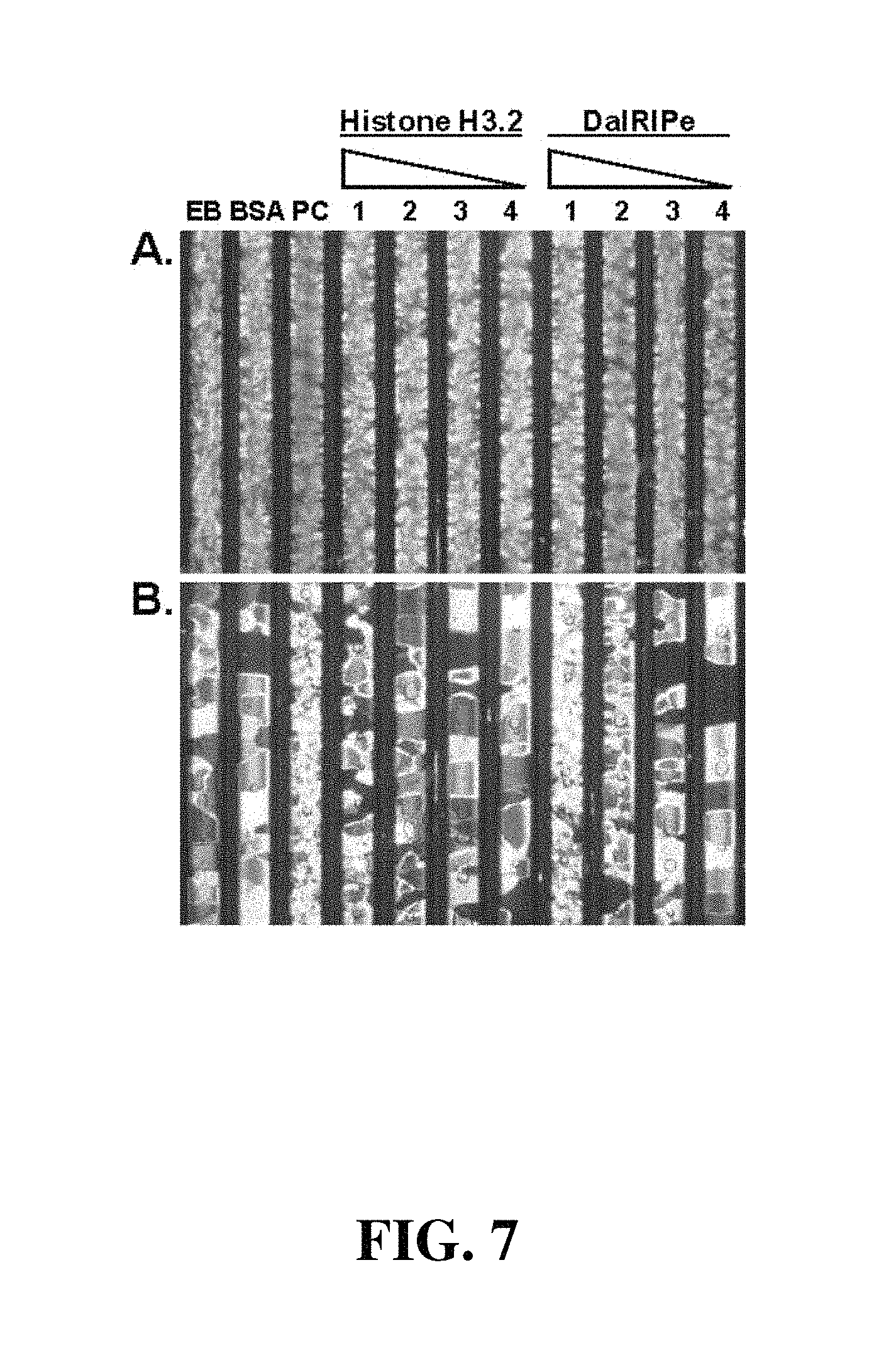
D00014

D00015
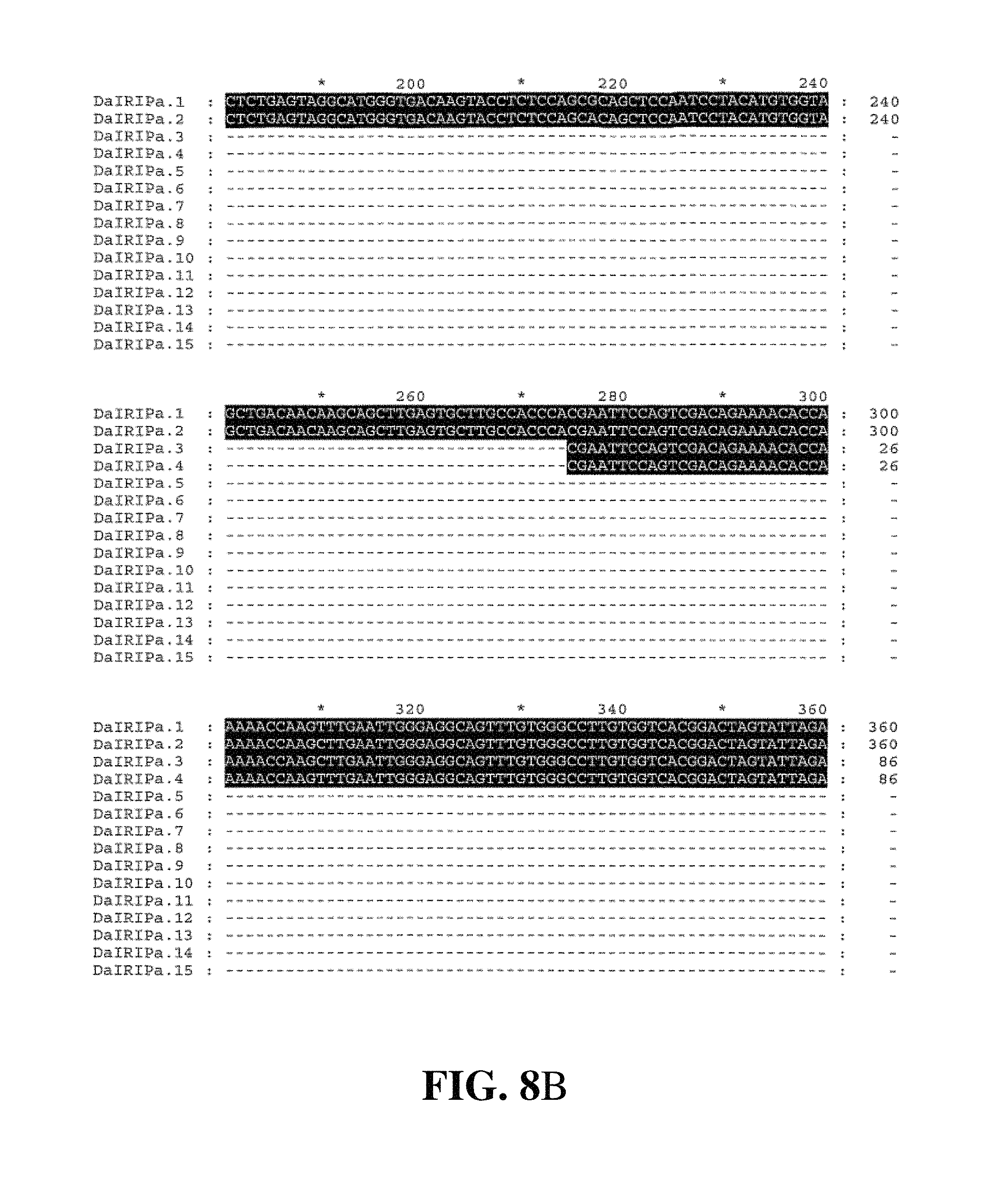
D00016
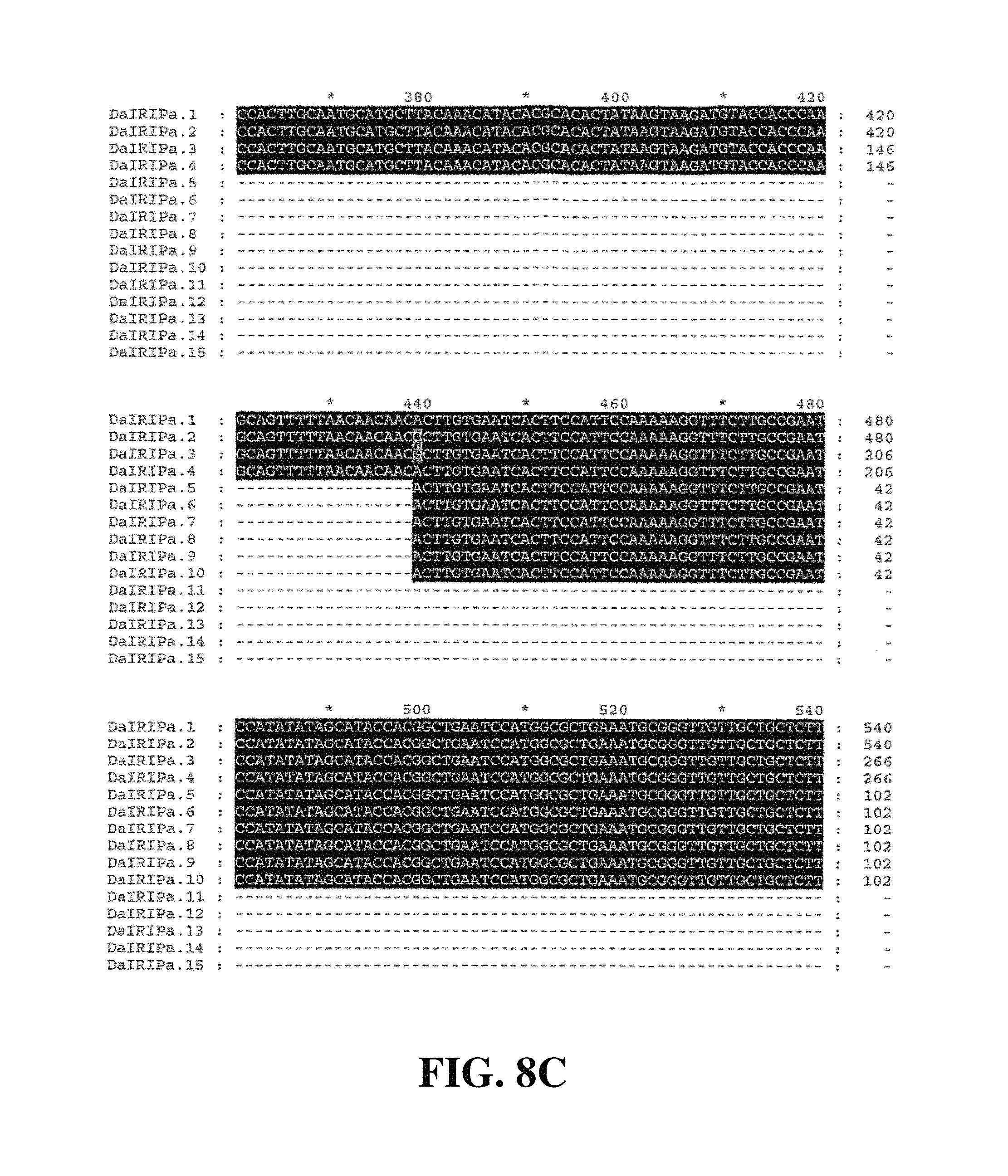
D00017
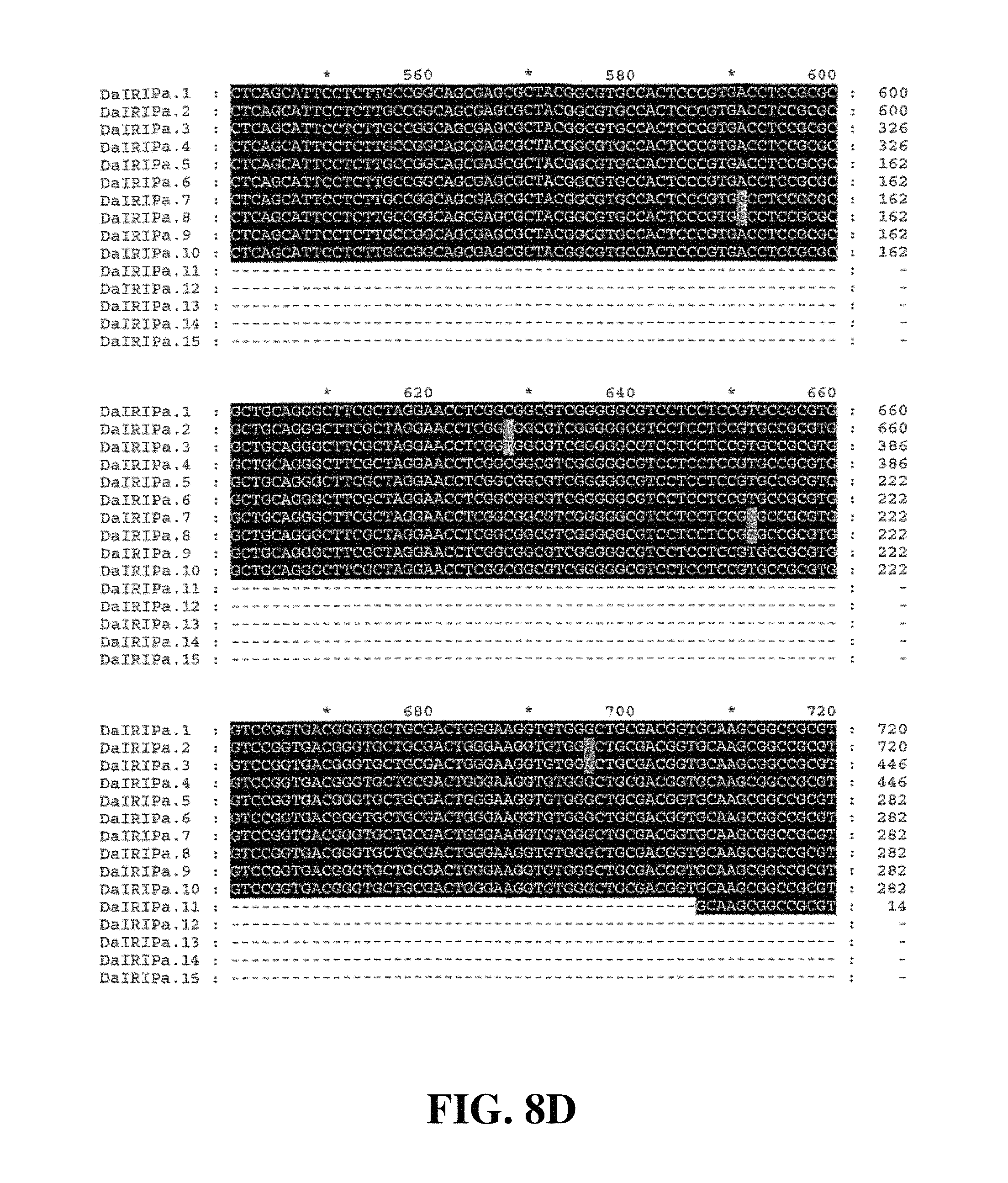
D00018
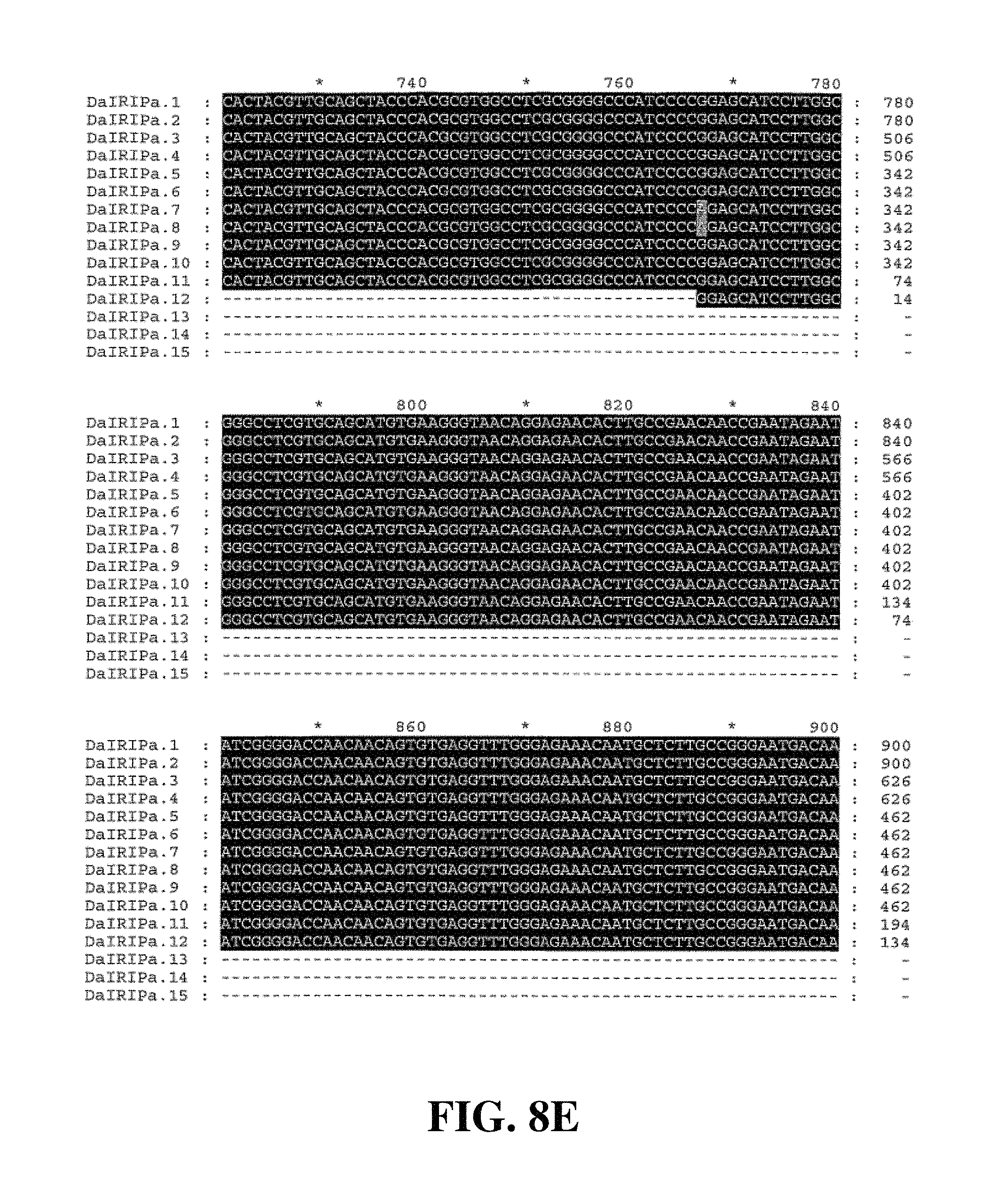
D00019
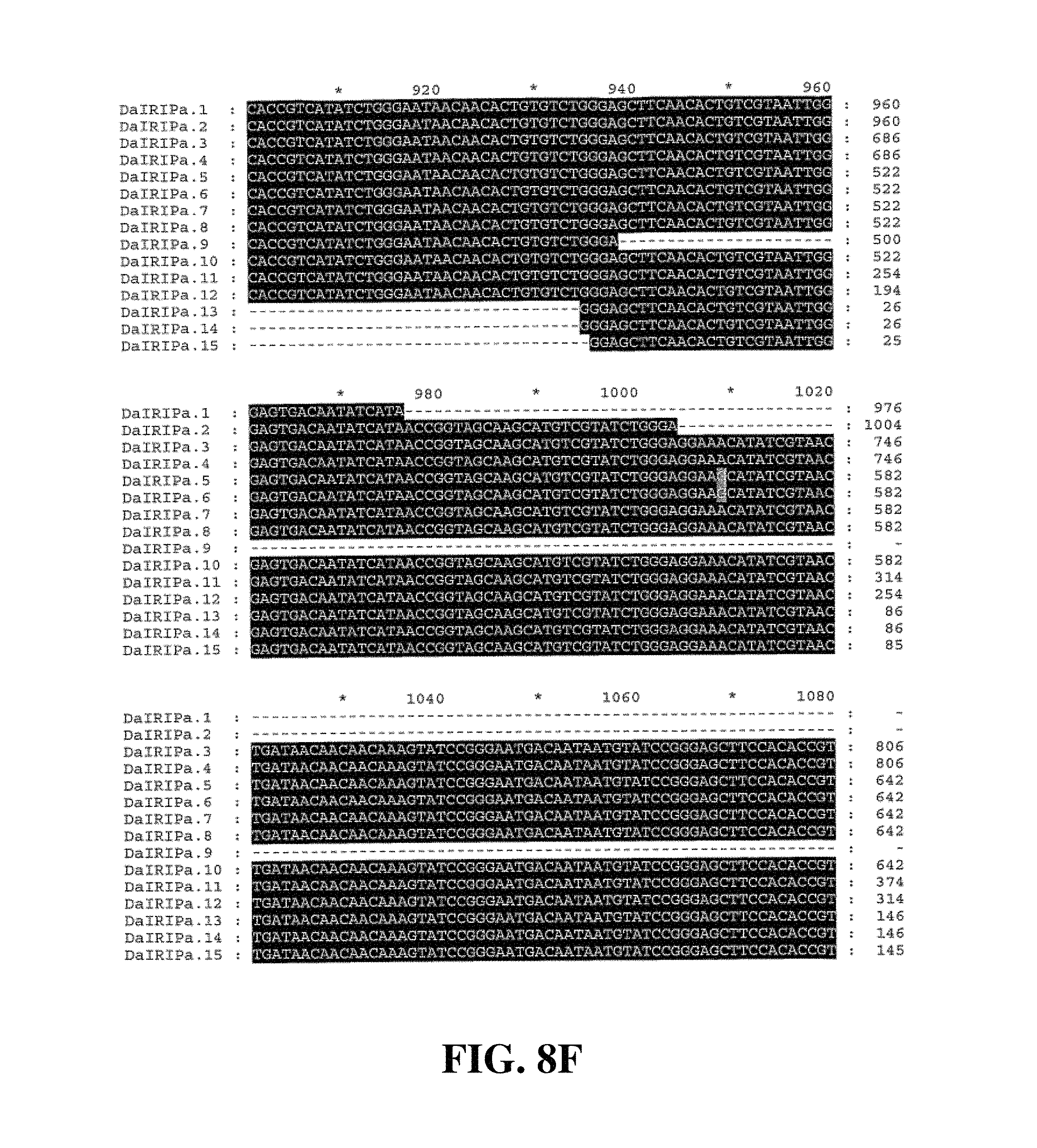
D00020
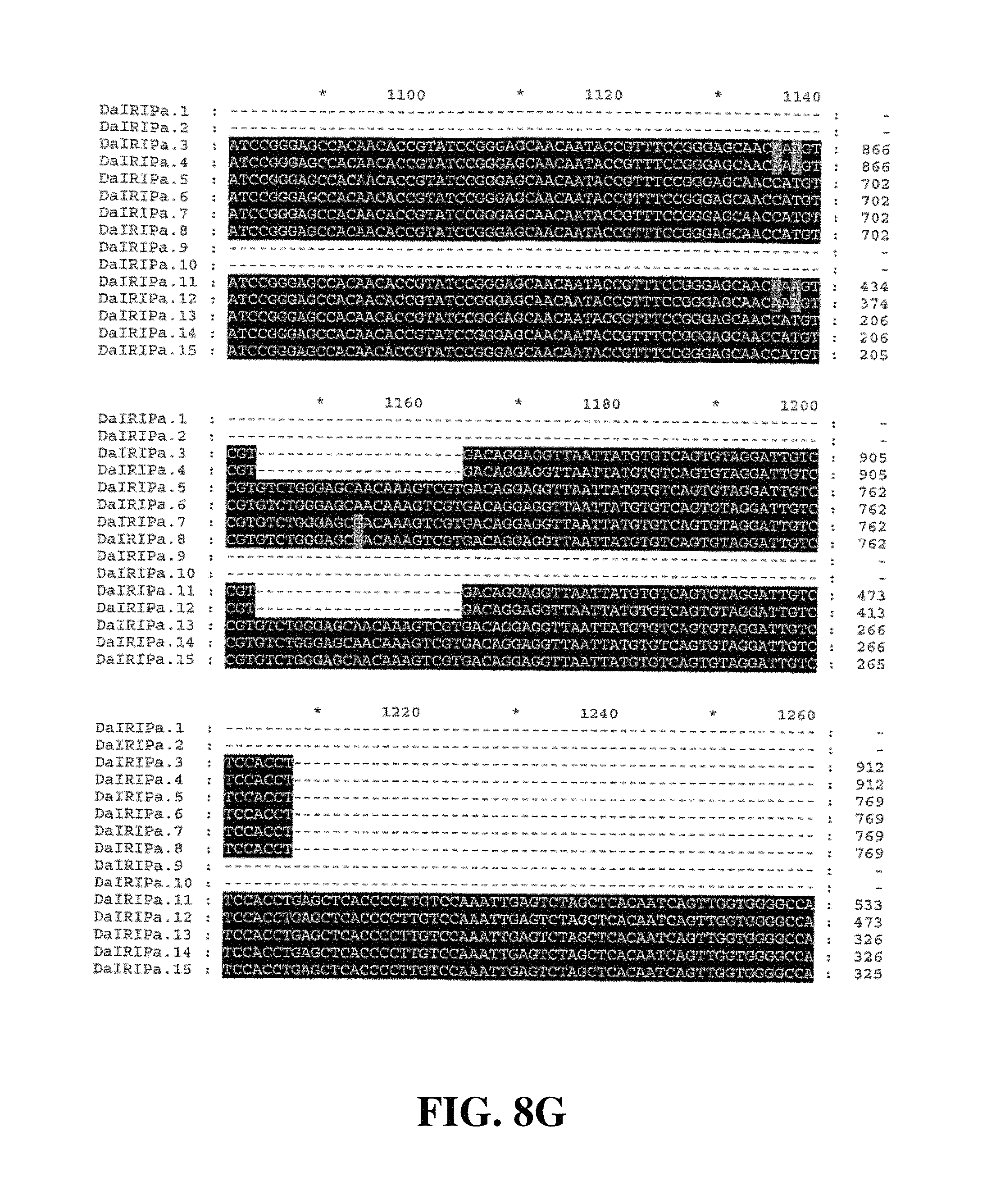
D00021
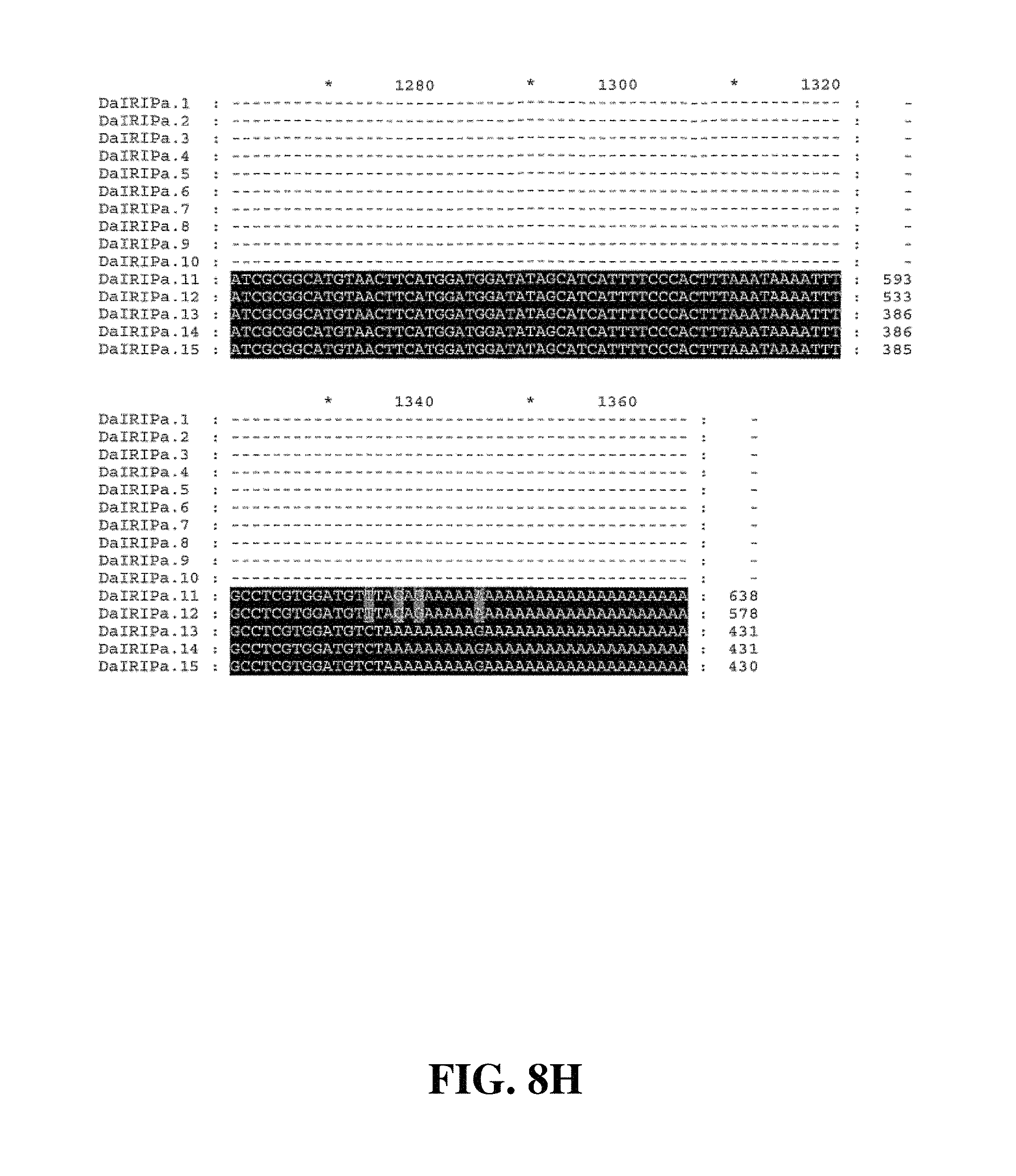
D00022
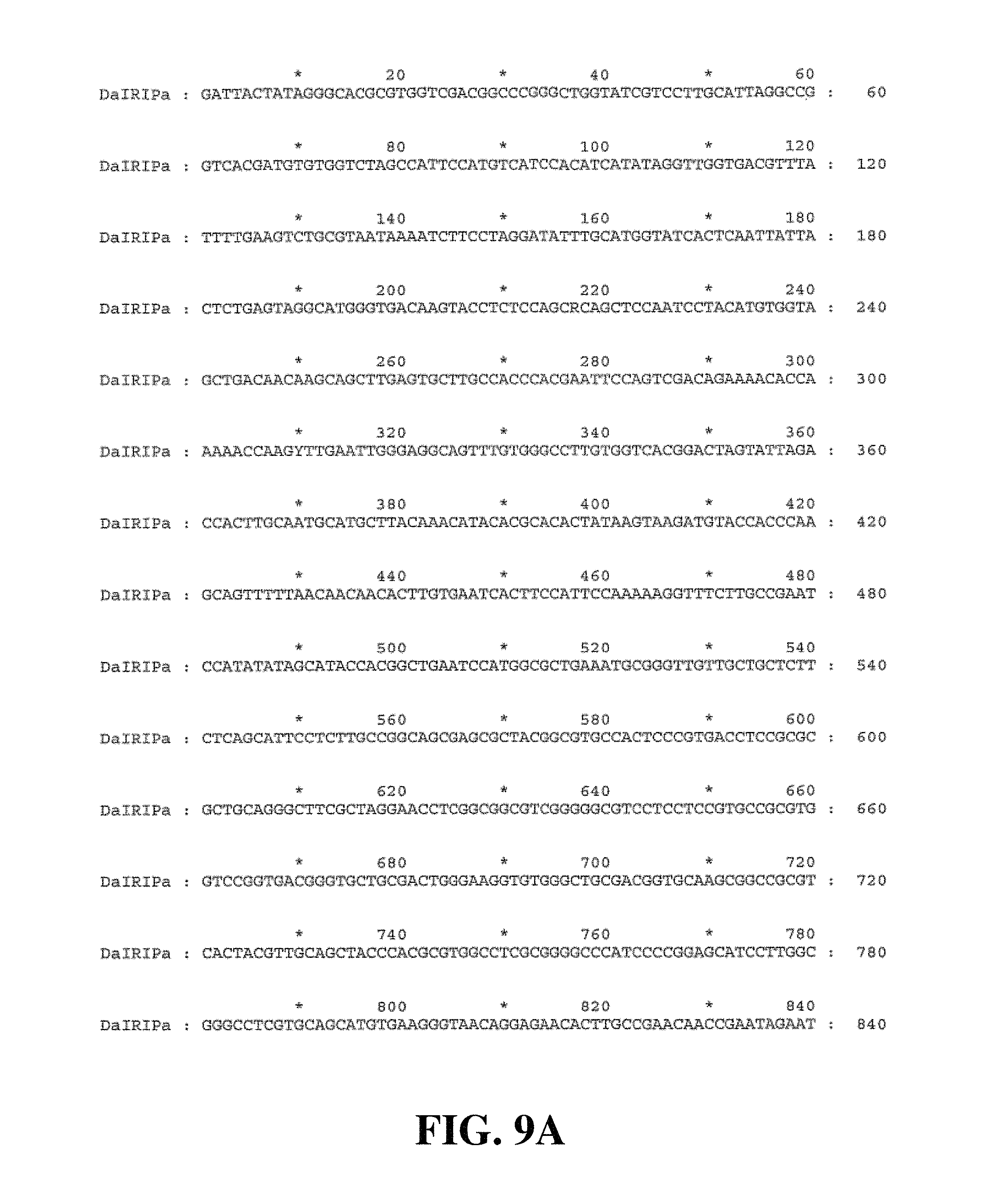
D00023
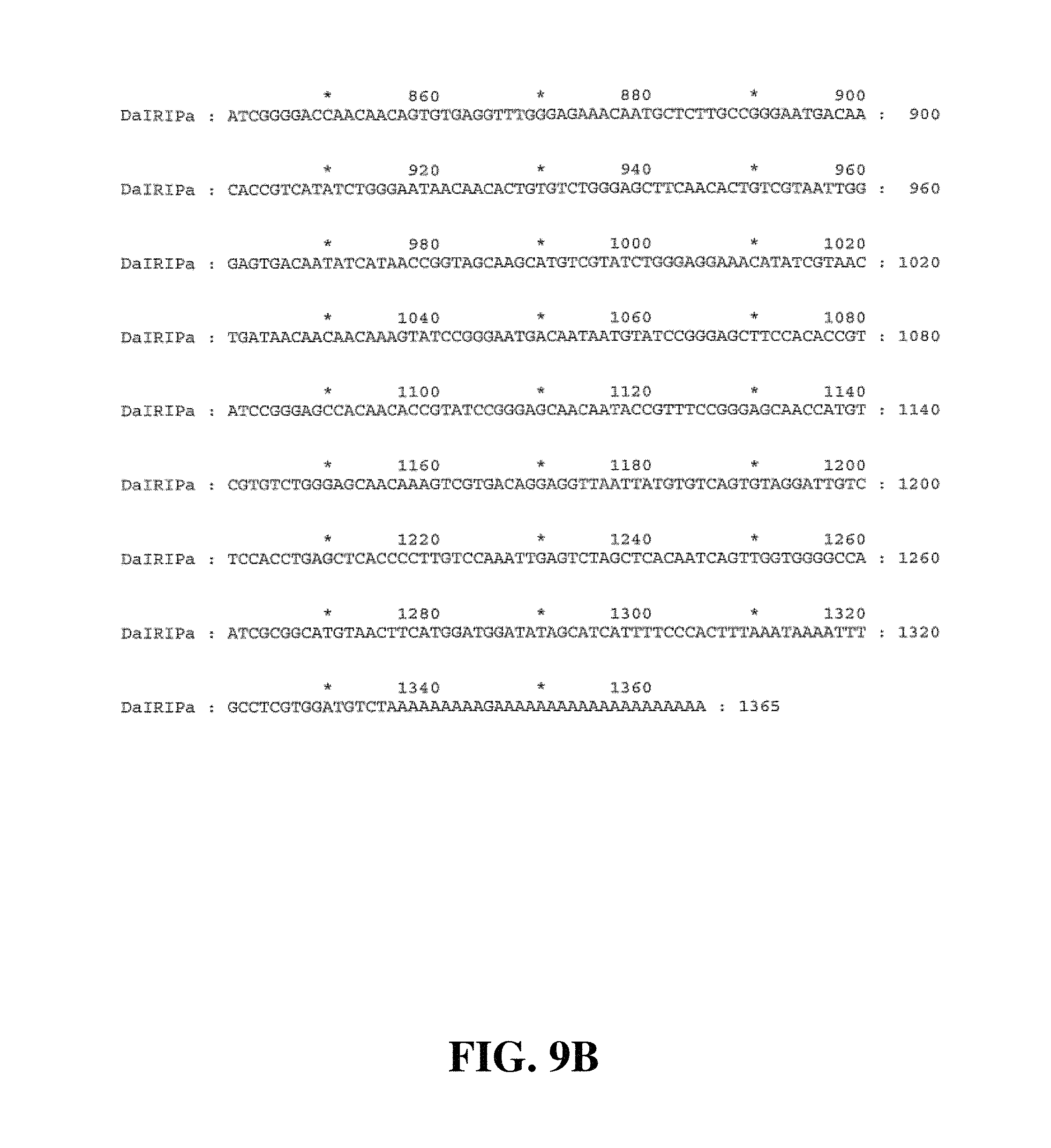
D00024
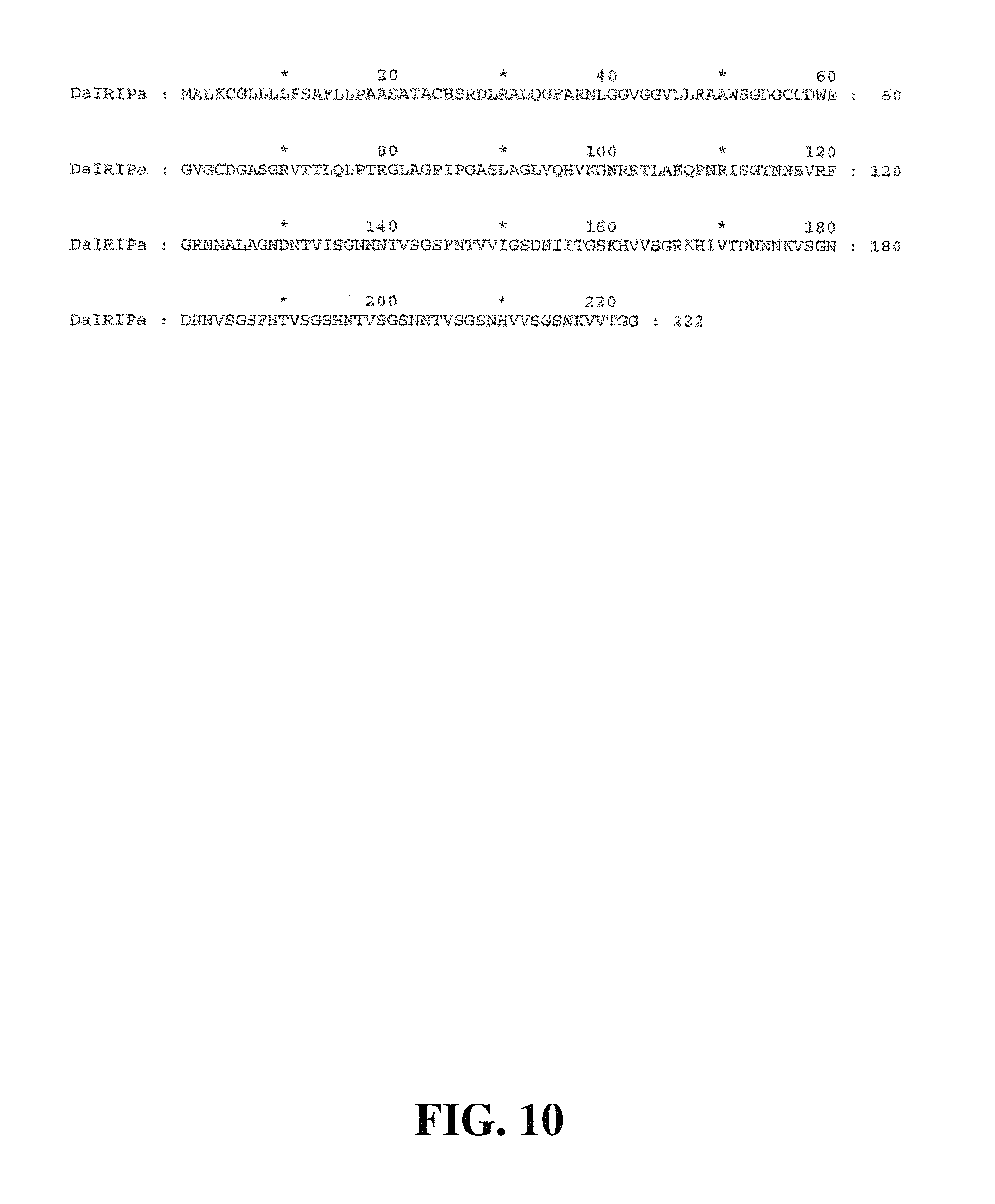
D00025

D00026
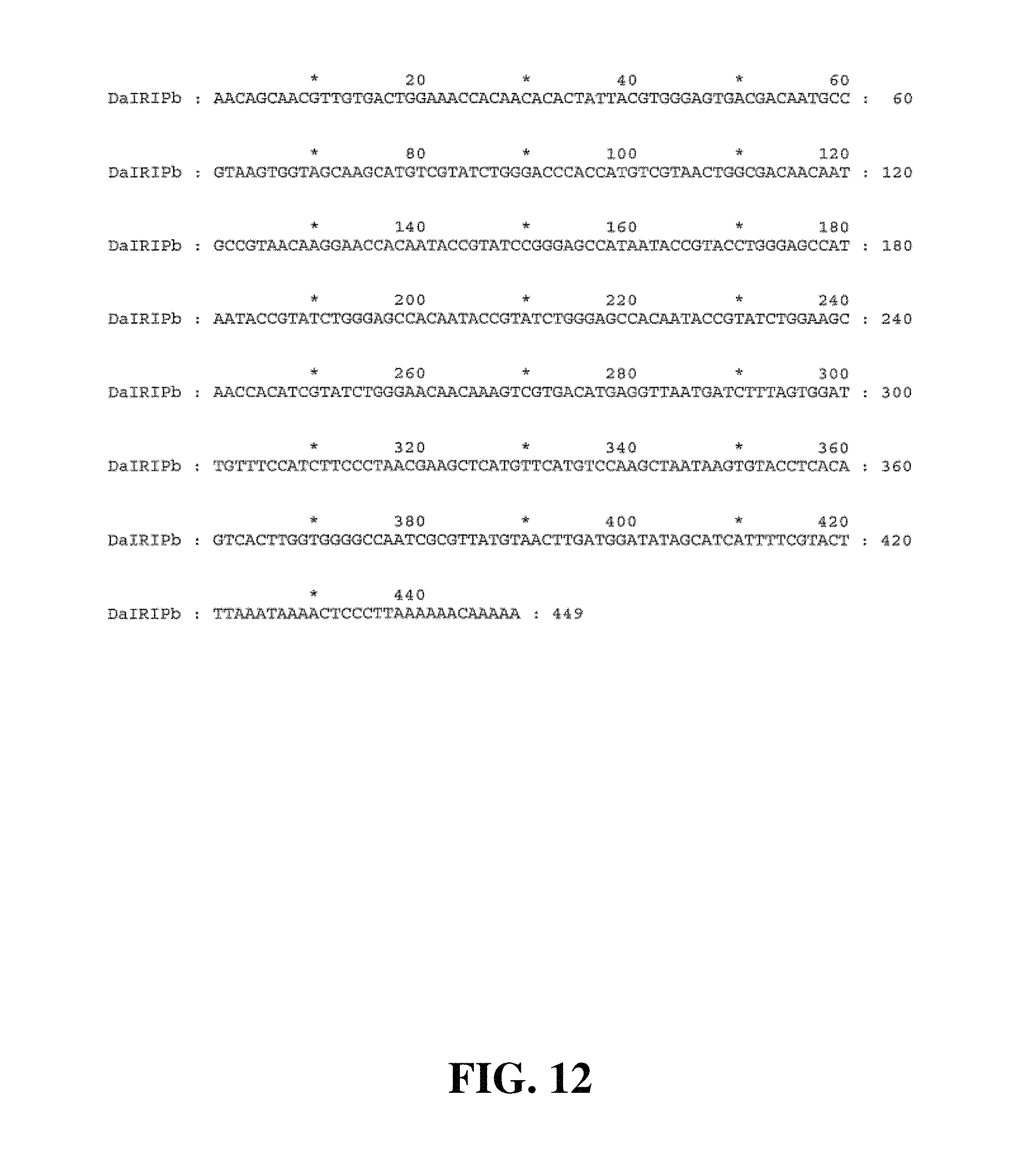
D00027
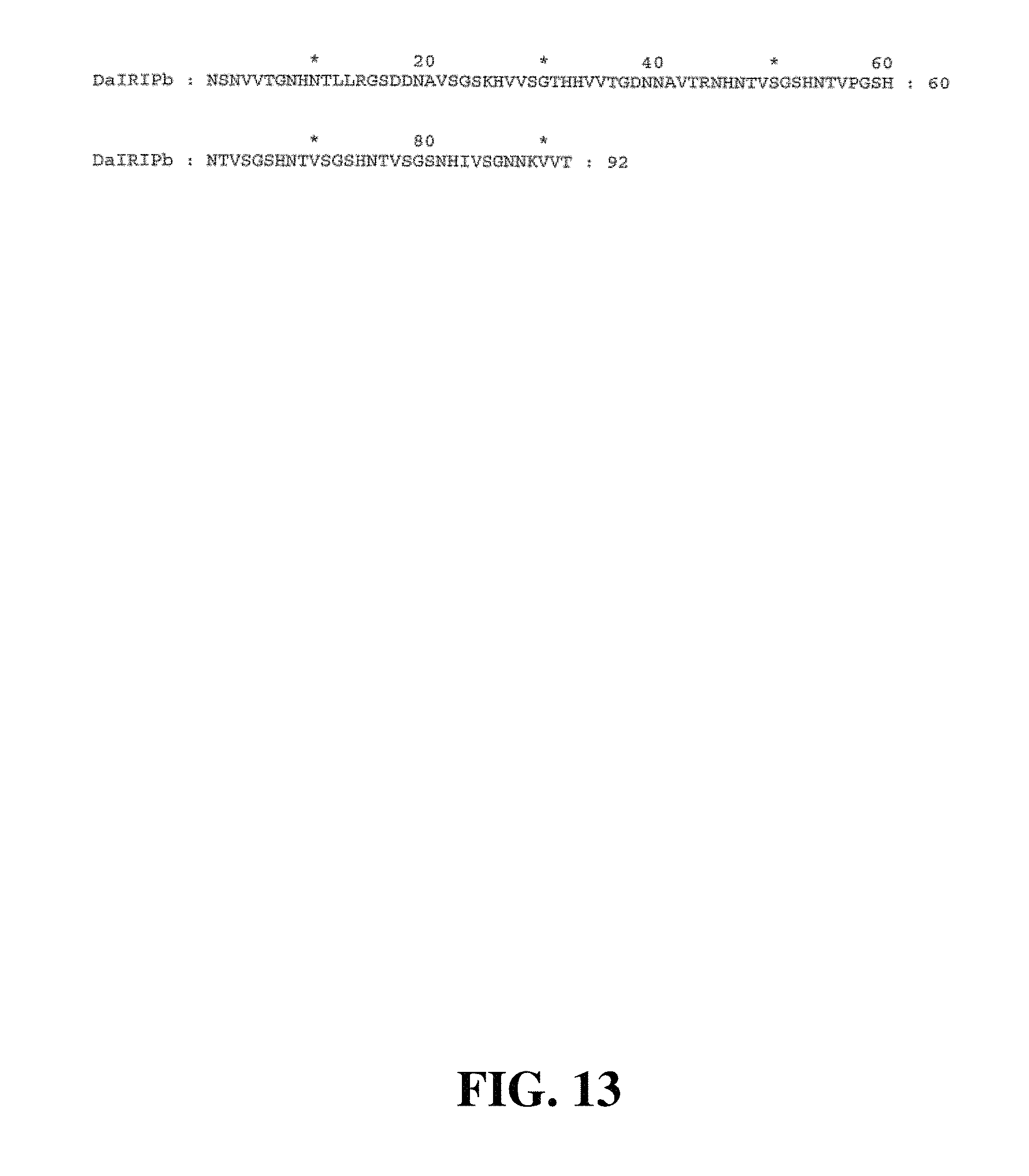
D00028
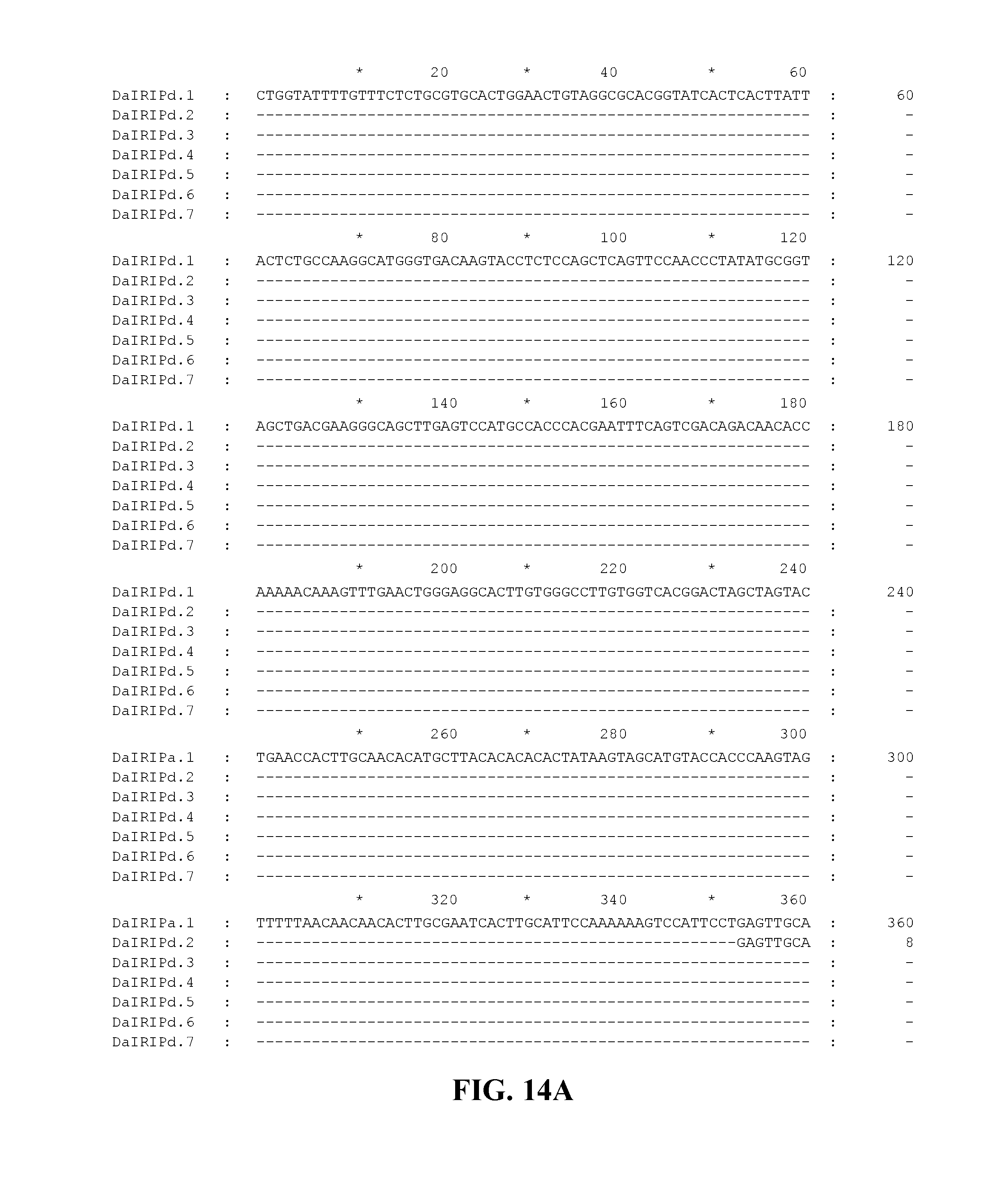
D00029
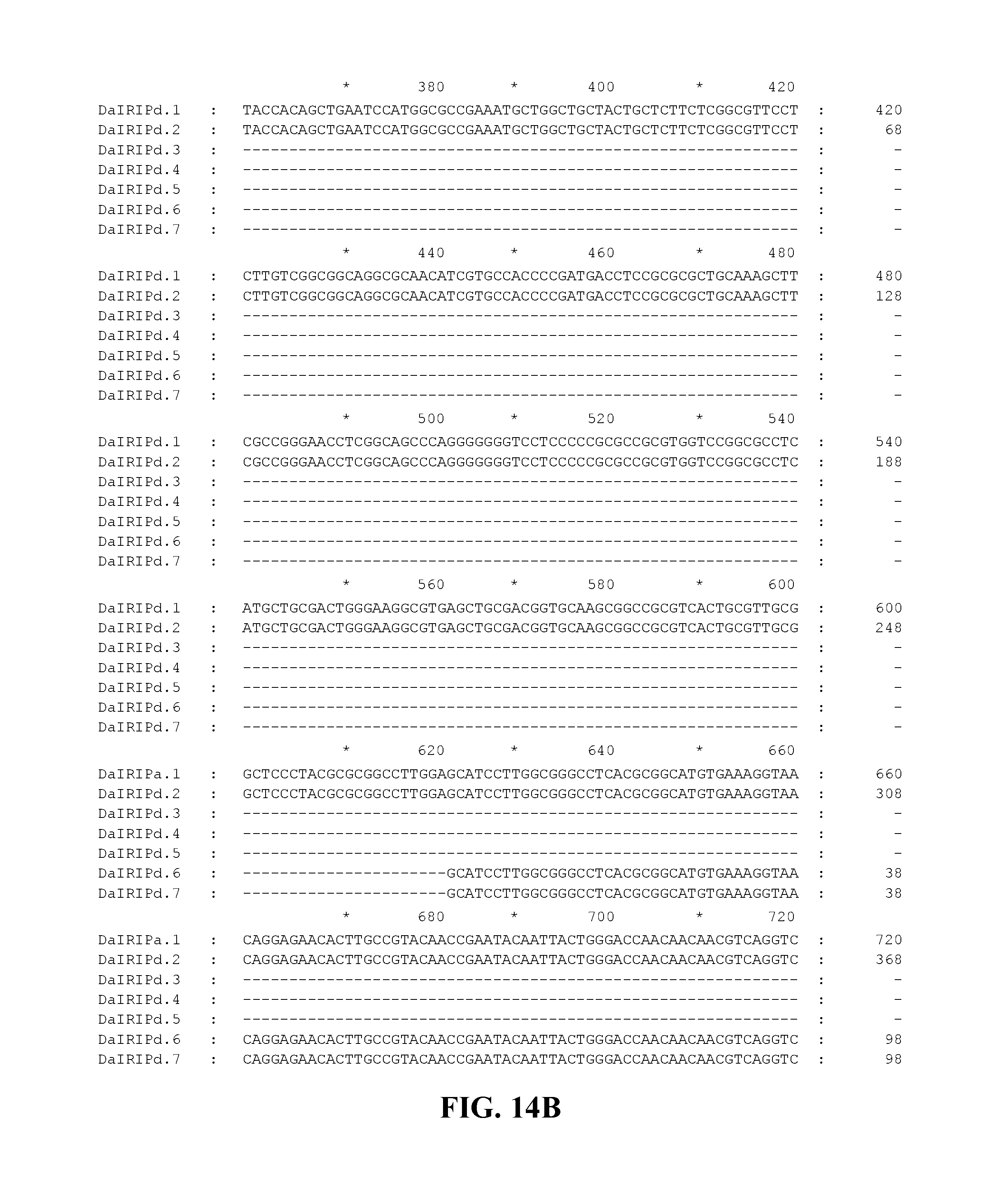
D00030

D00031
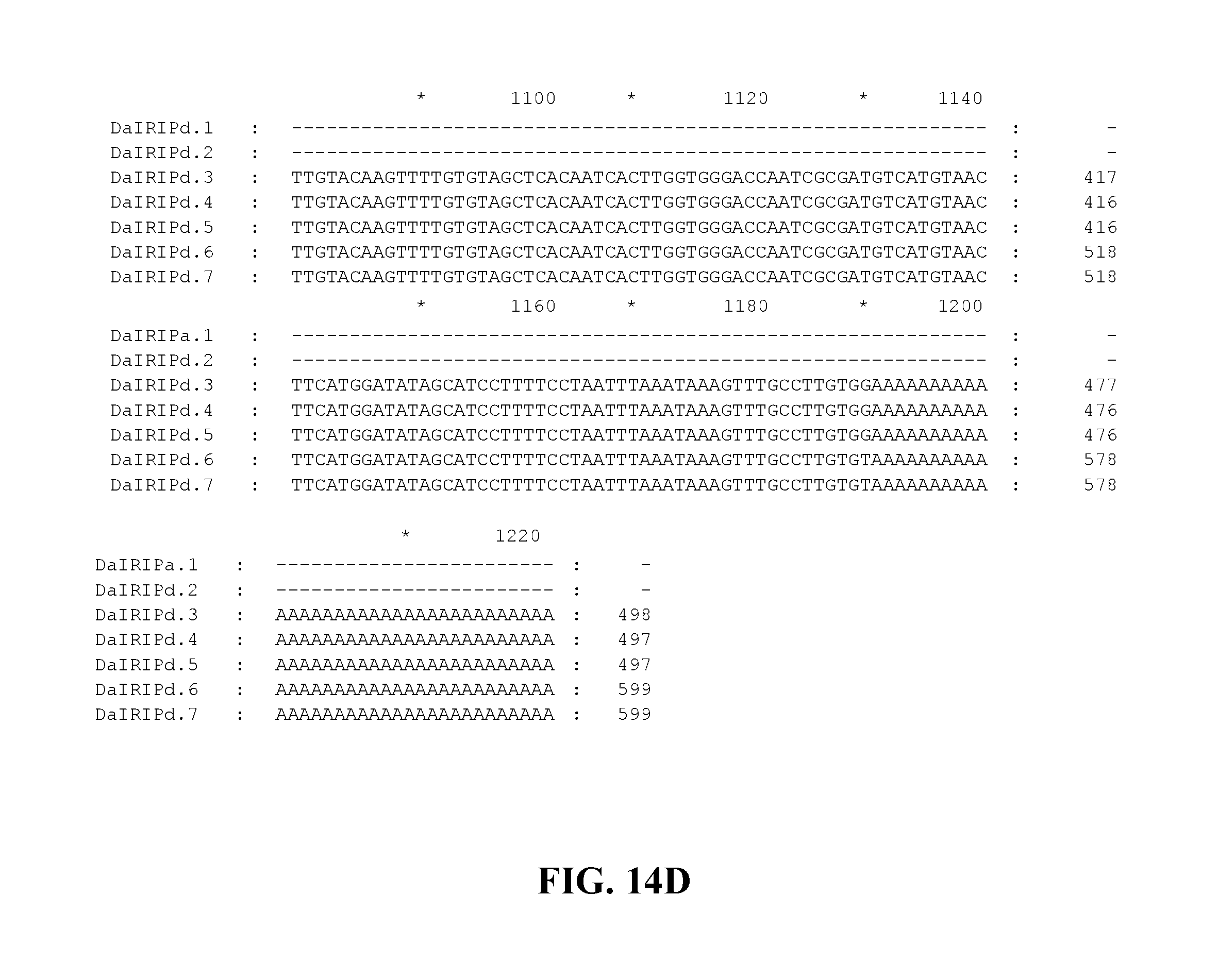
D00032
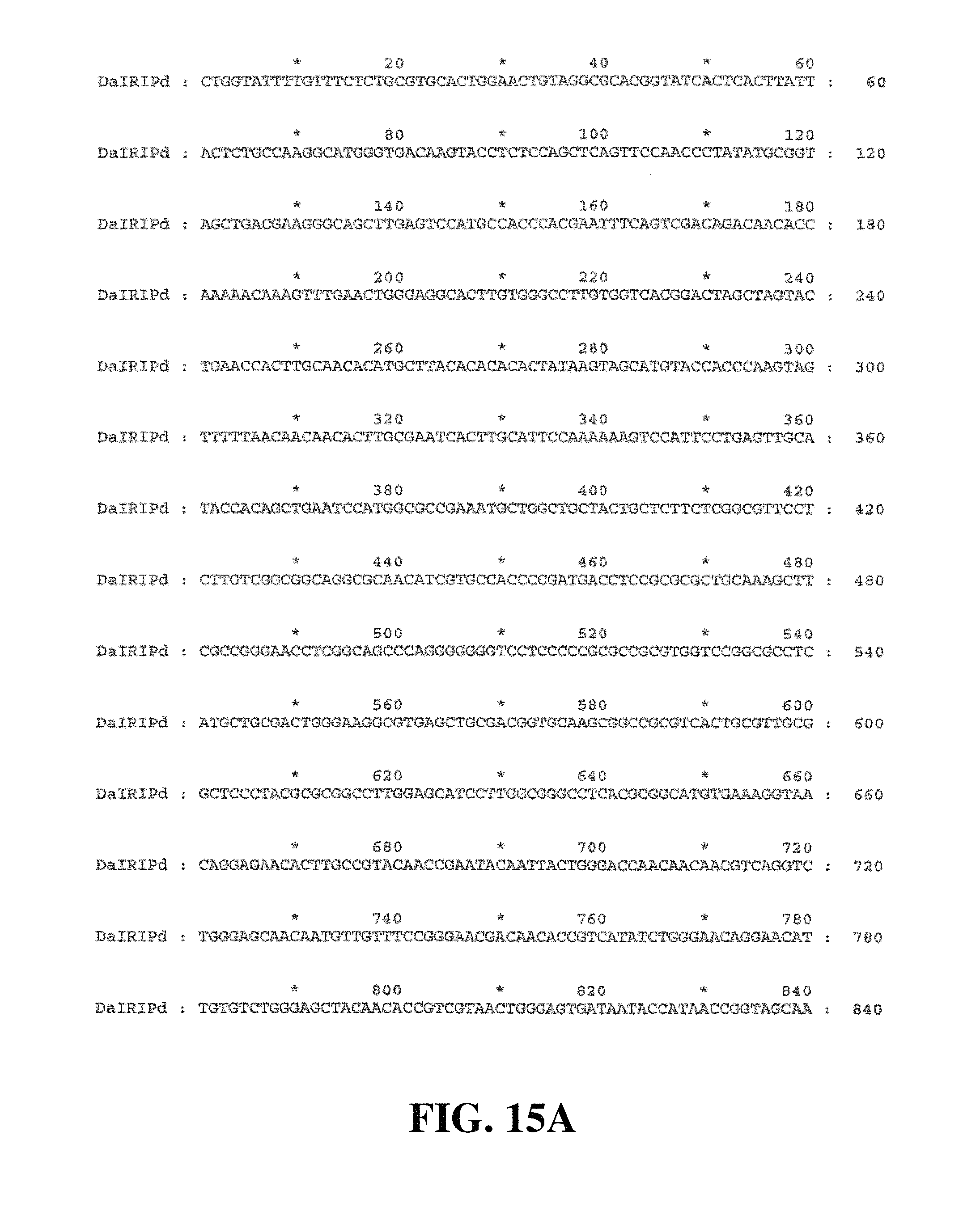
D00033
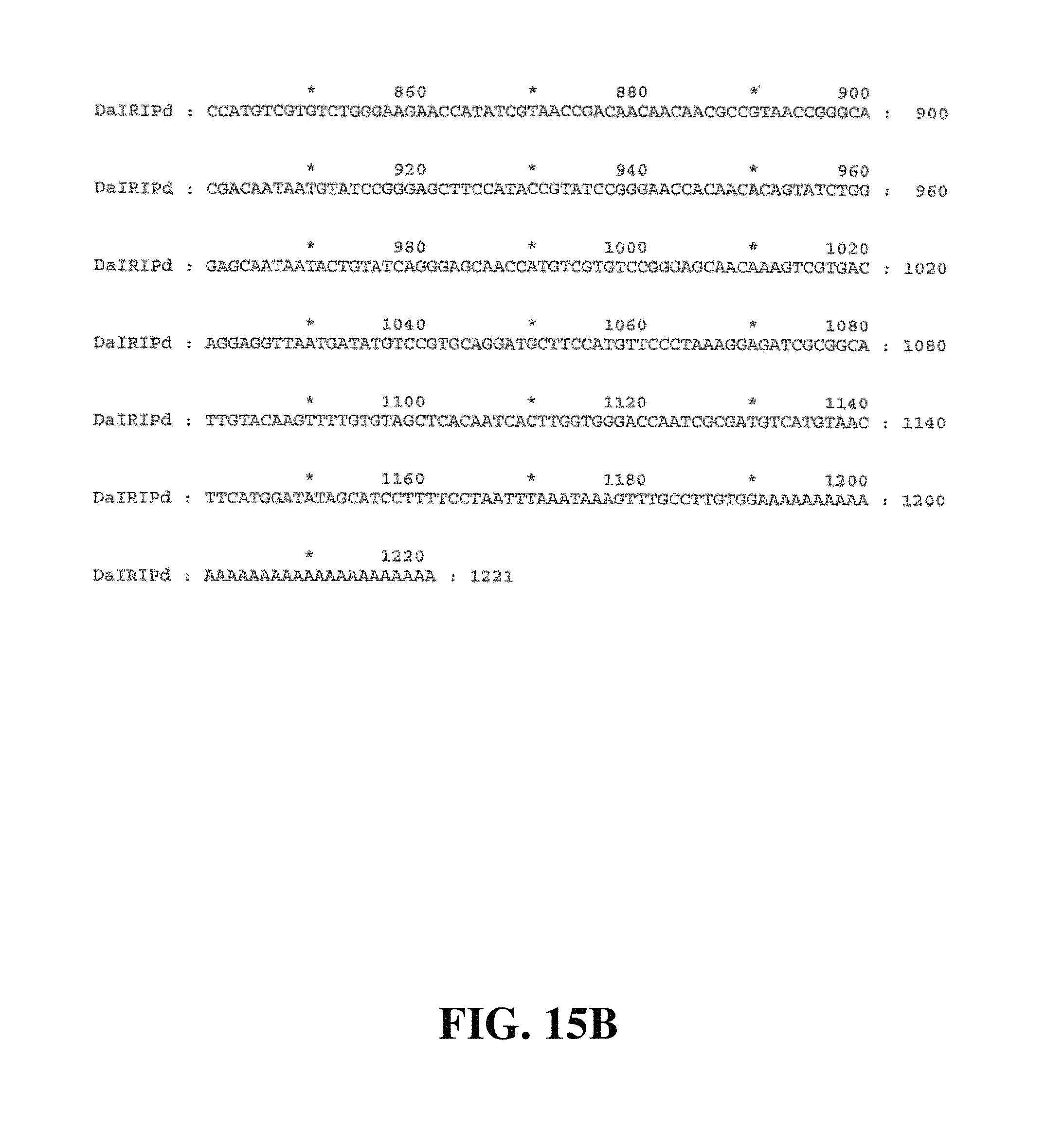
D00034
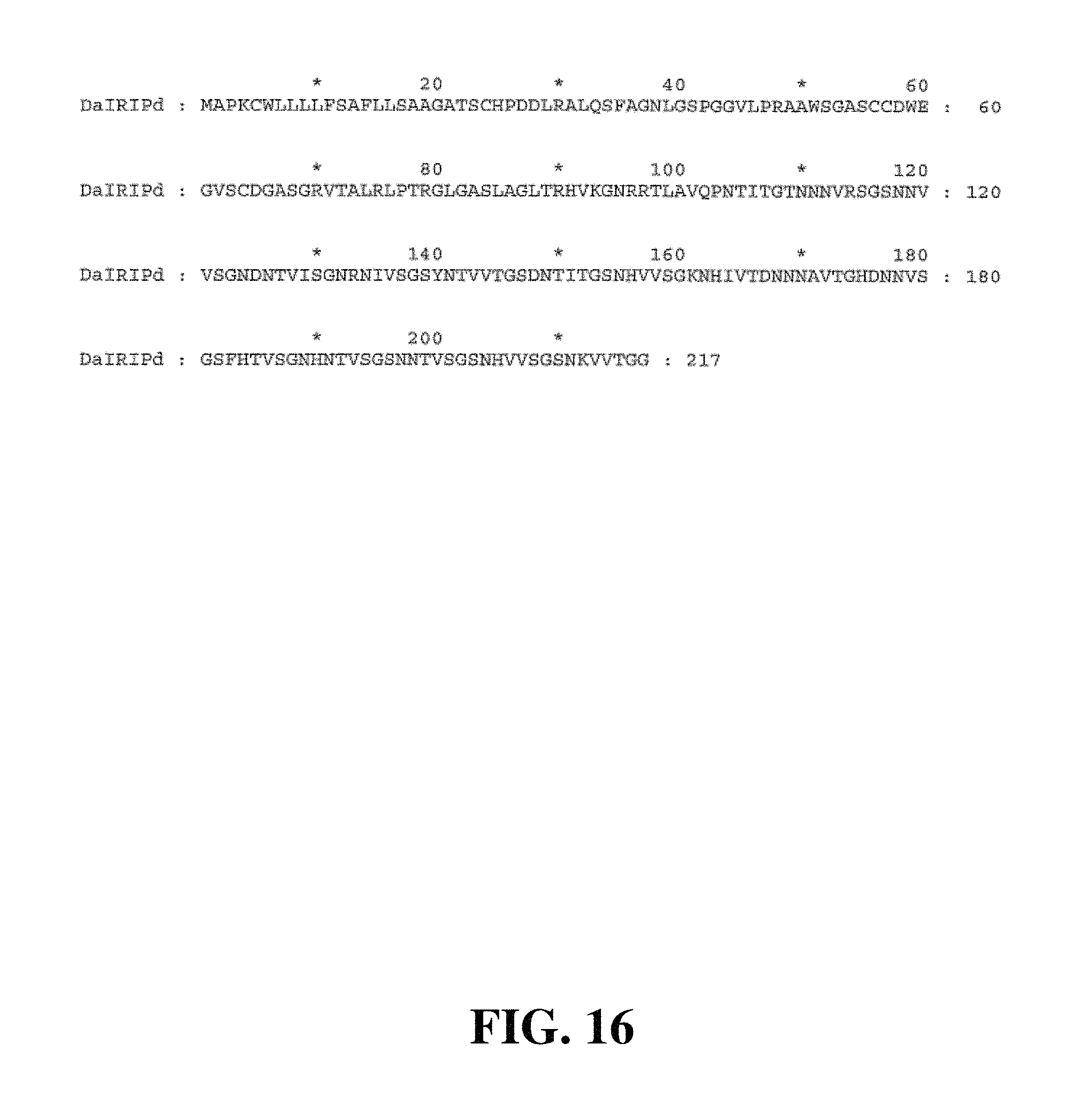
D00035
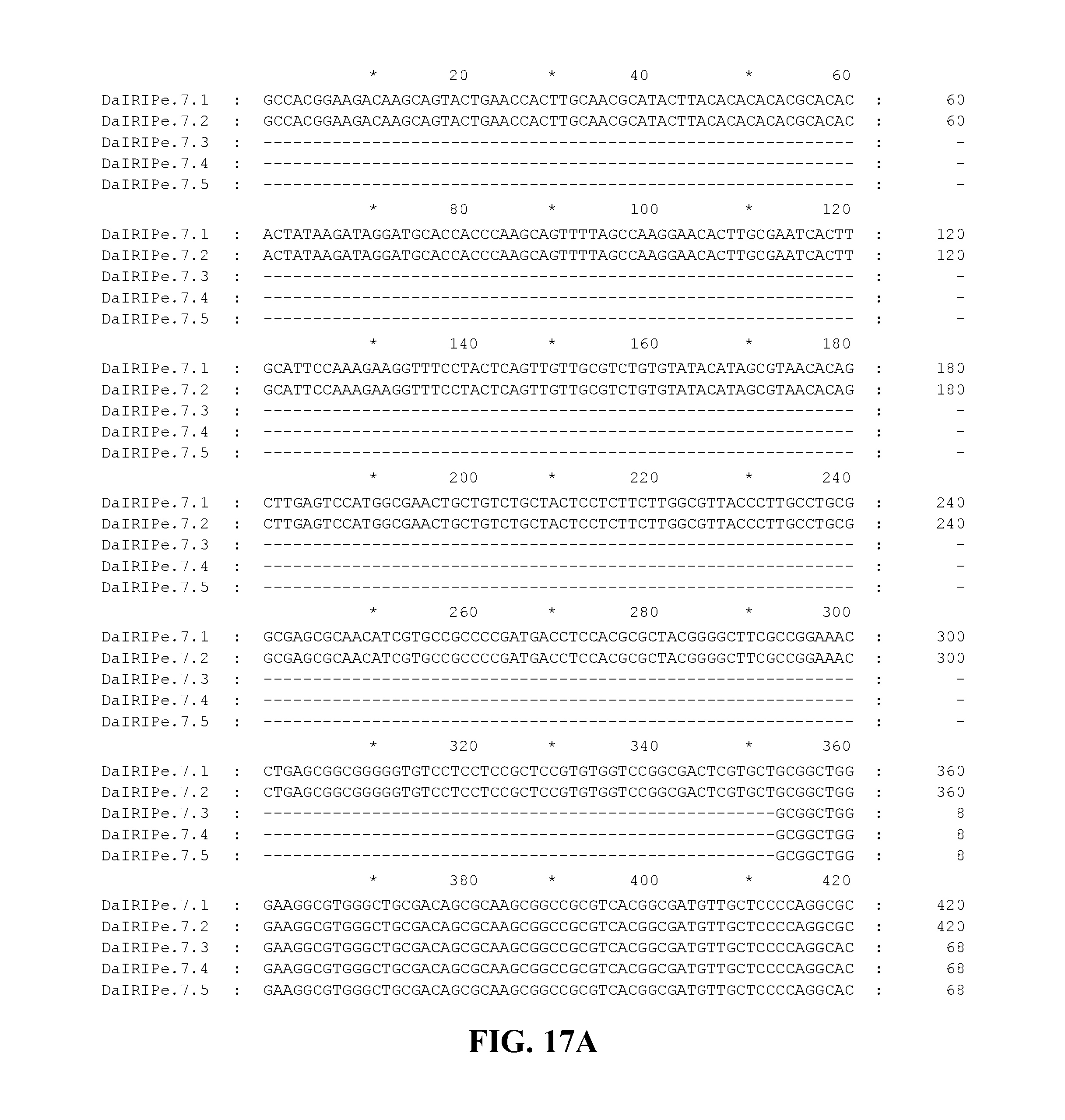
D00036

D00037
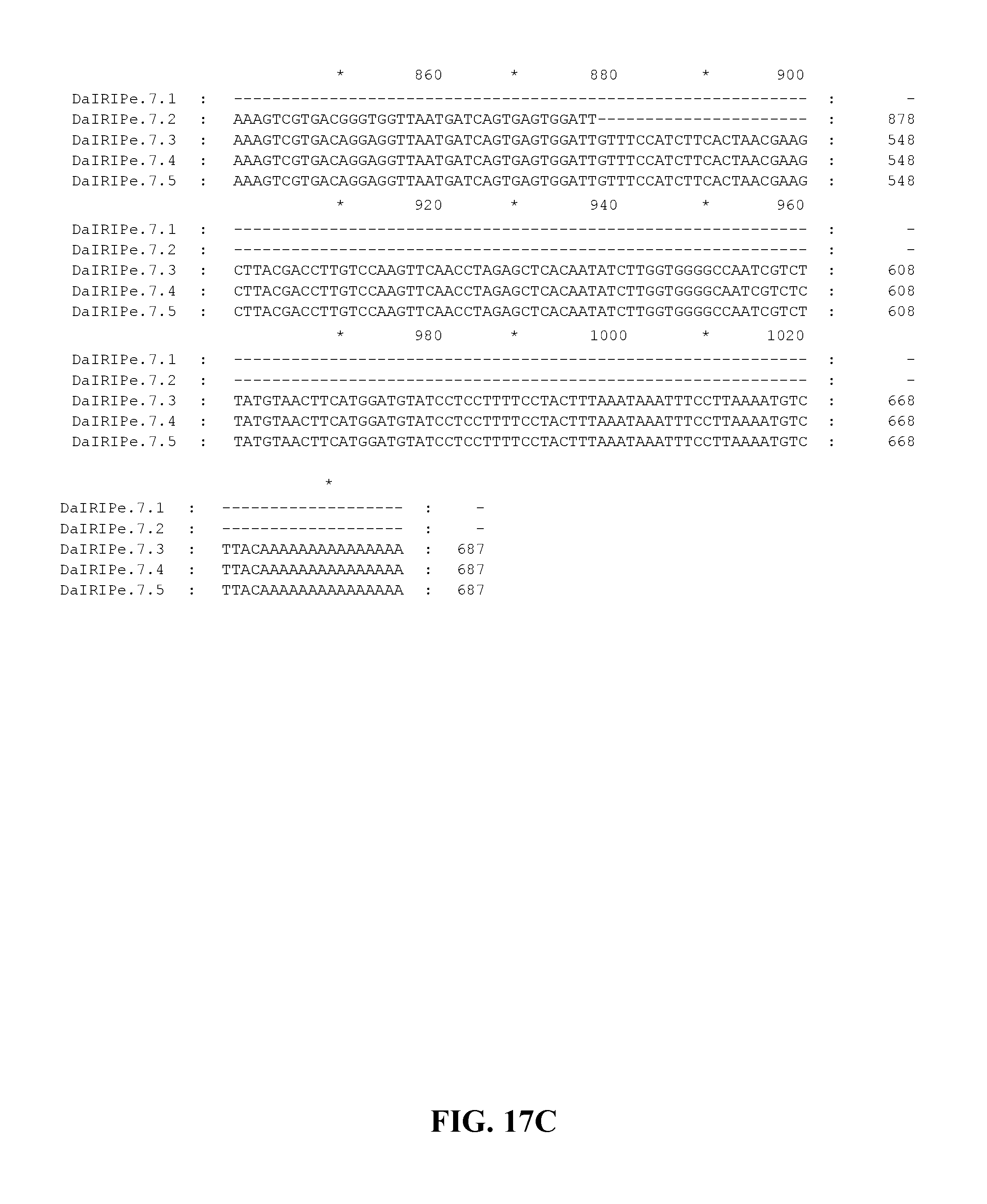
D00038
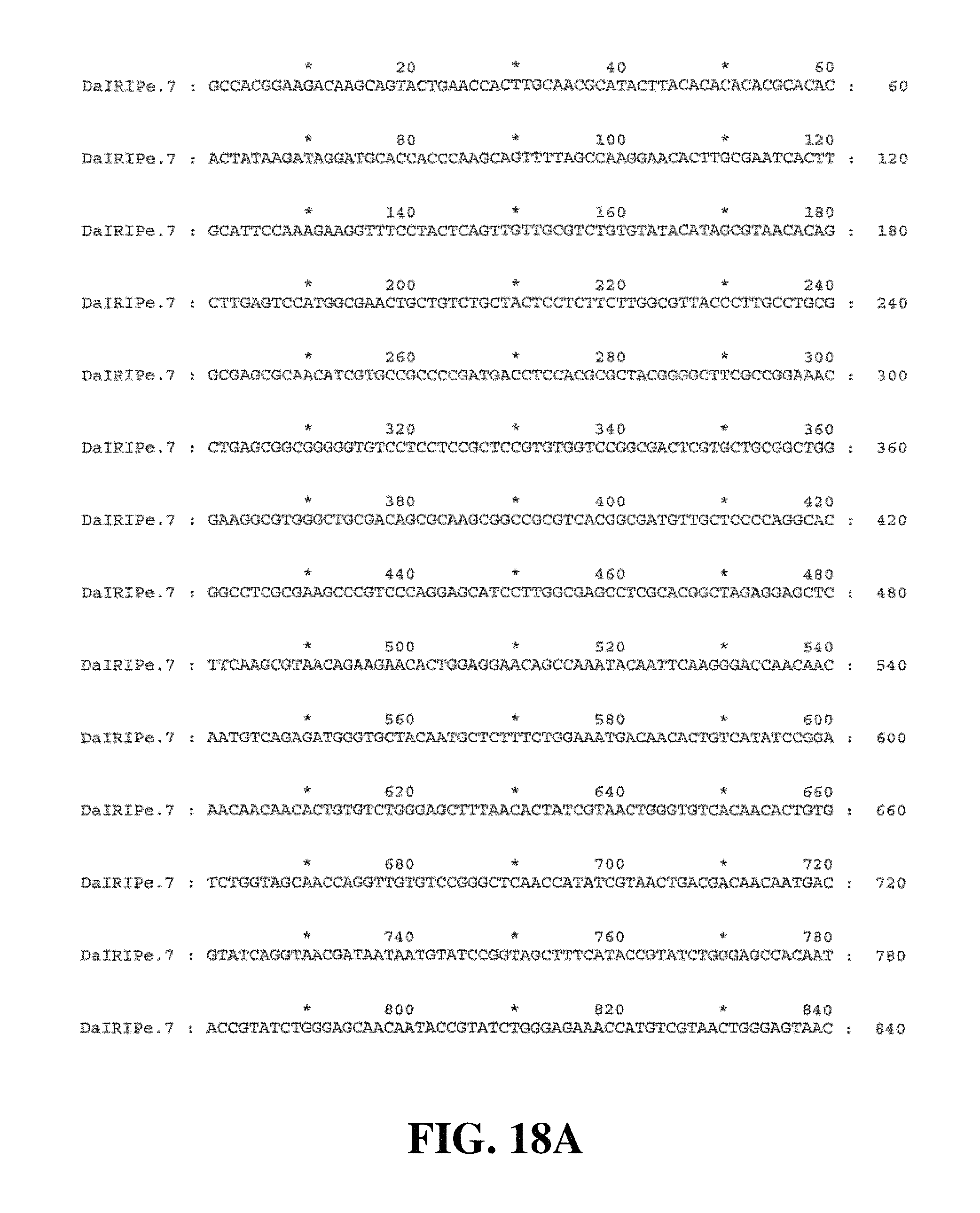
D00039

D00040
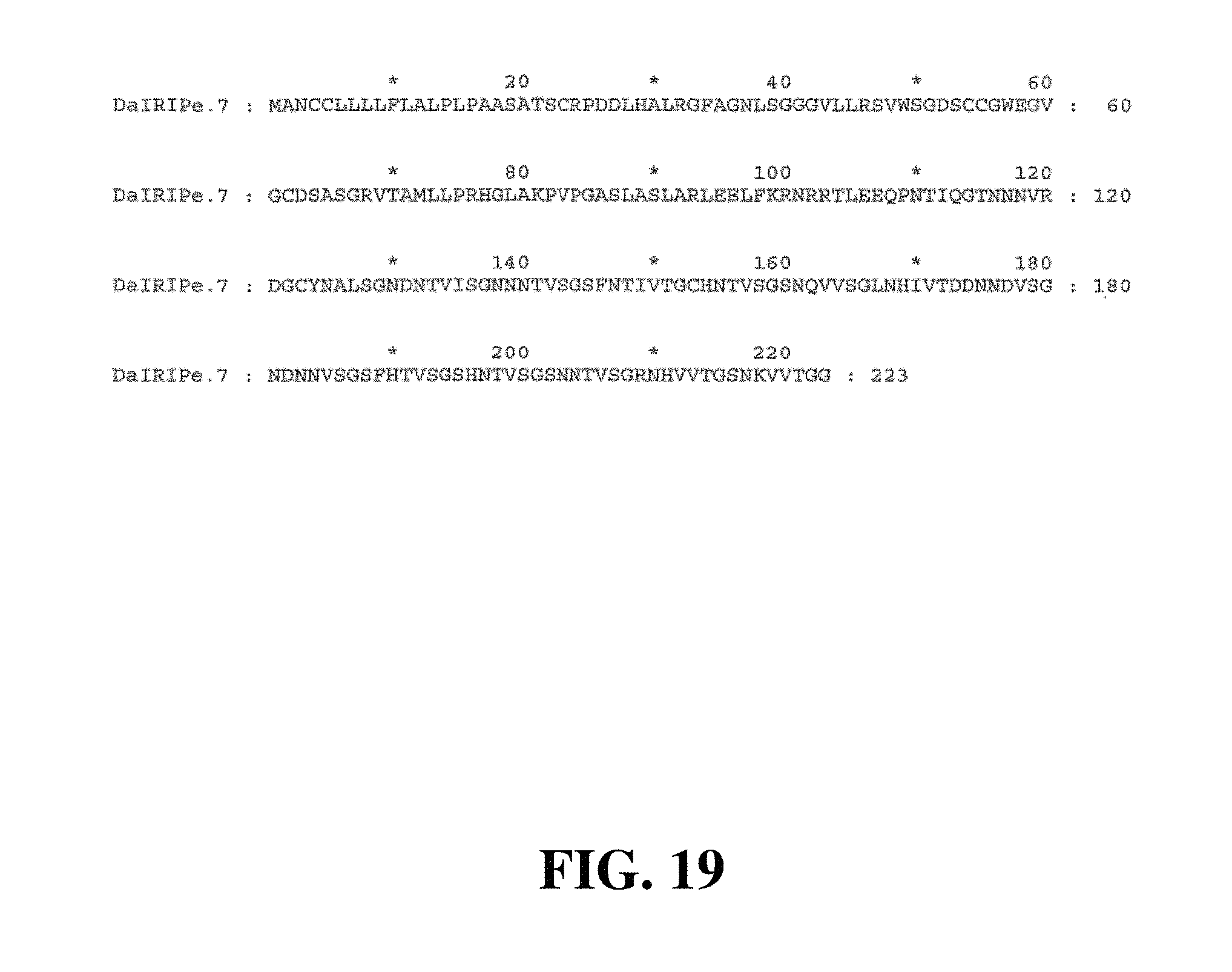
D00041
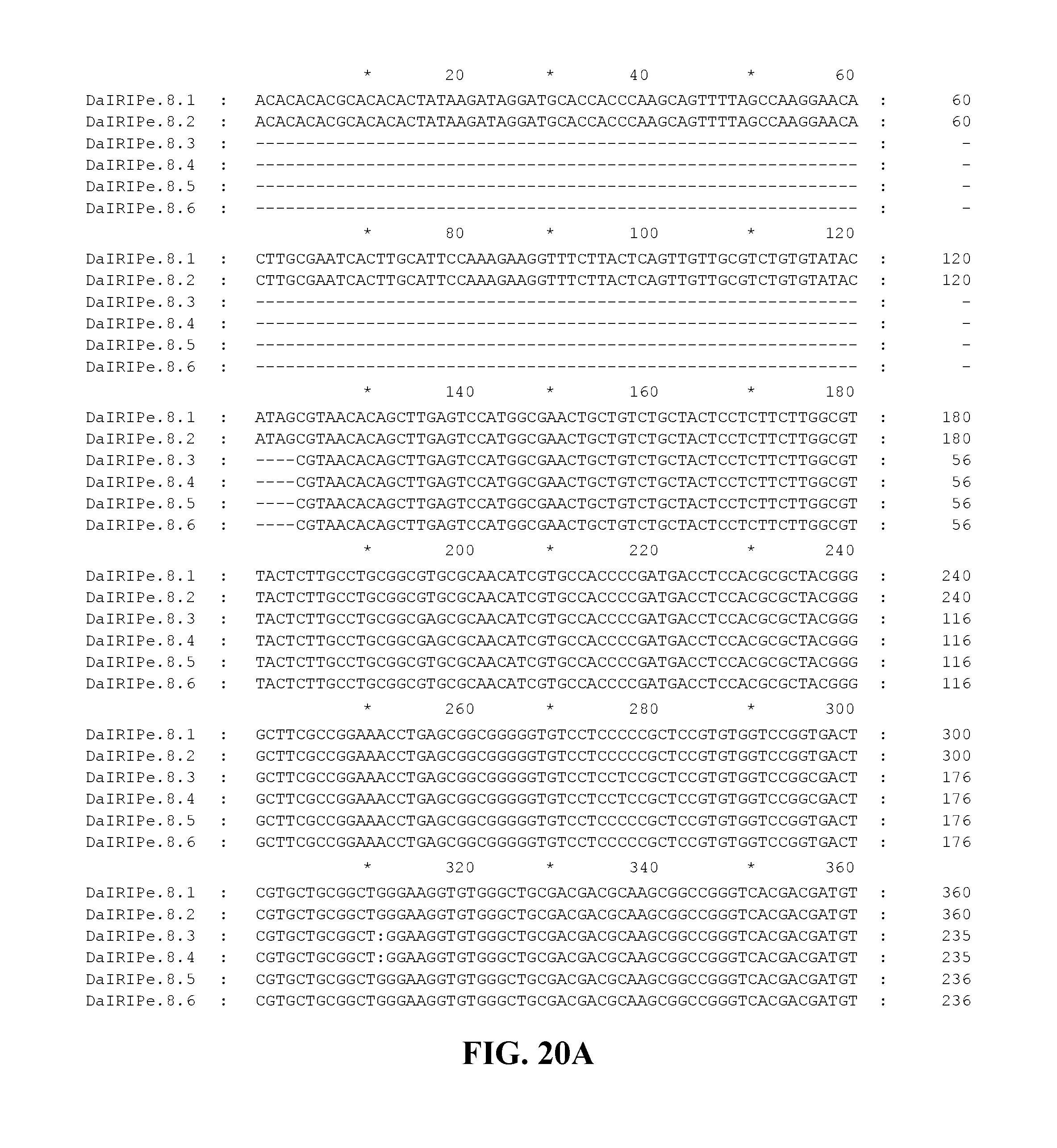
D00042

D00043
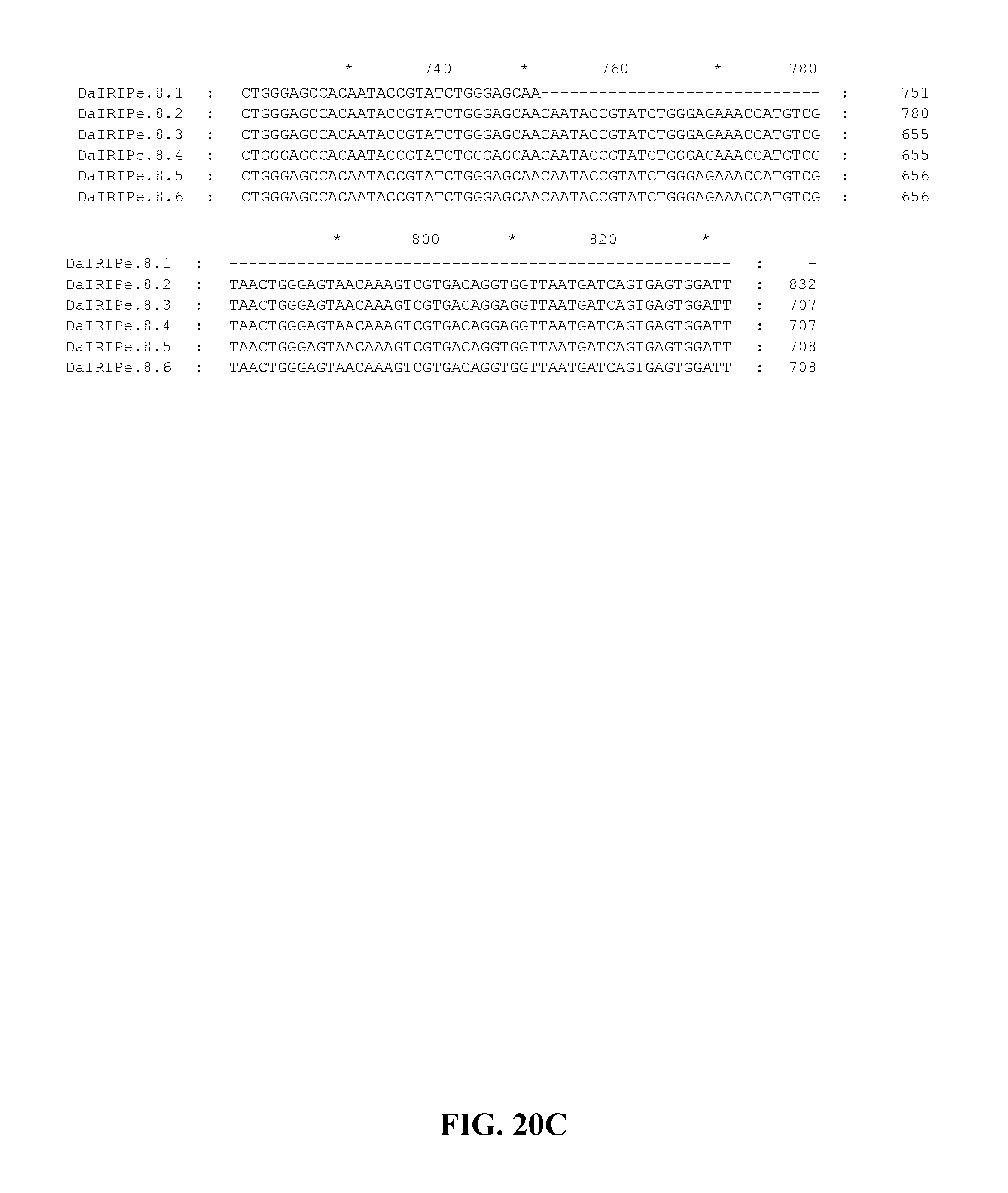
D00044
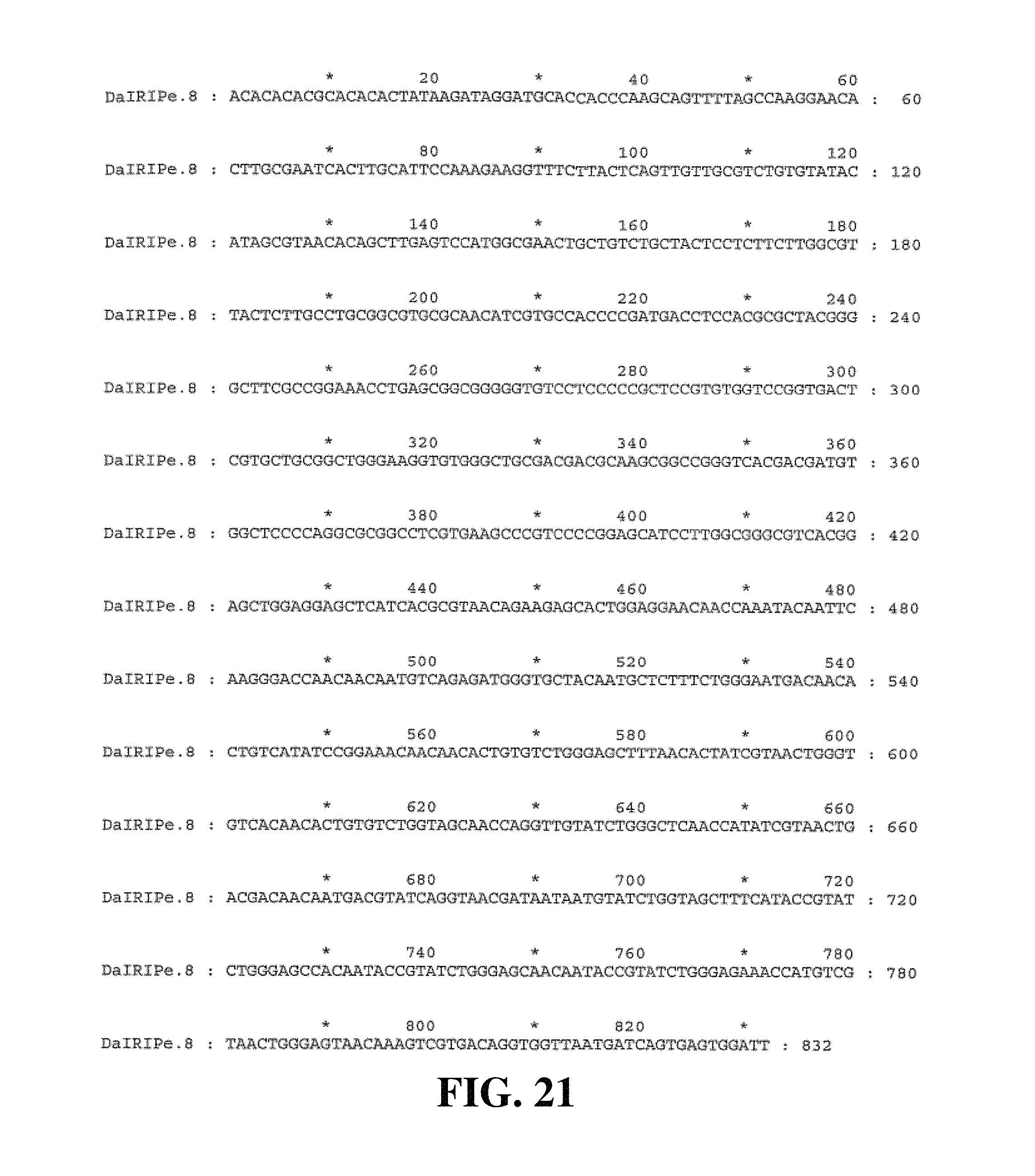
D00045

D00046

D00047

D00048
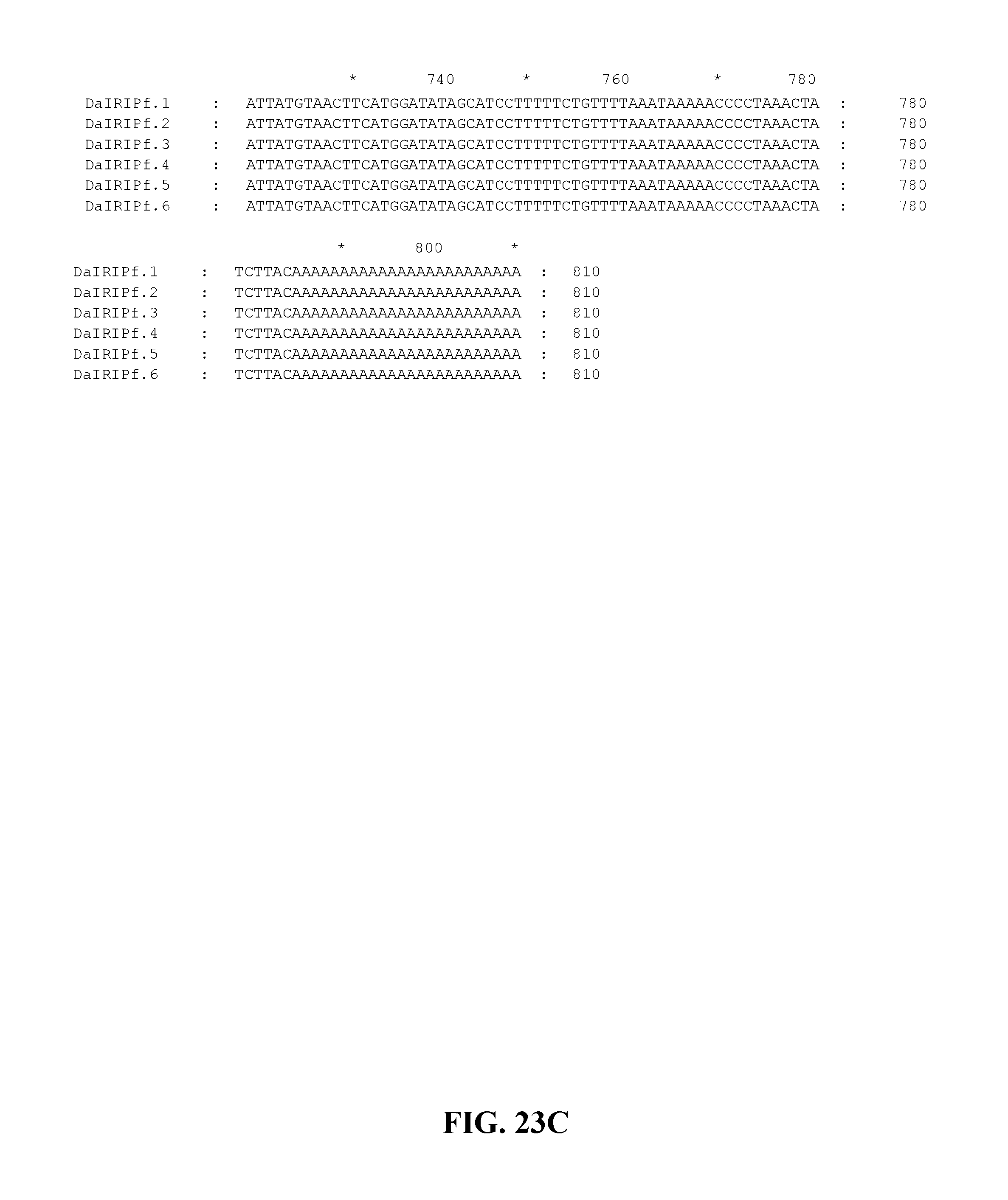
D00049
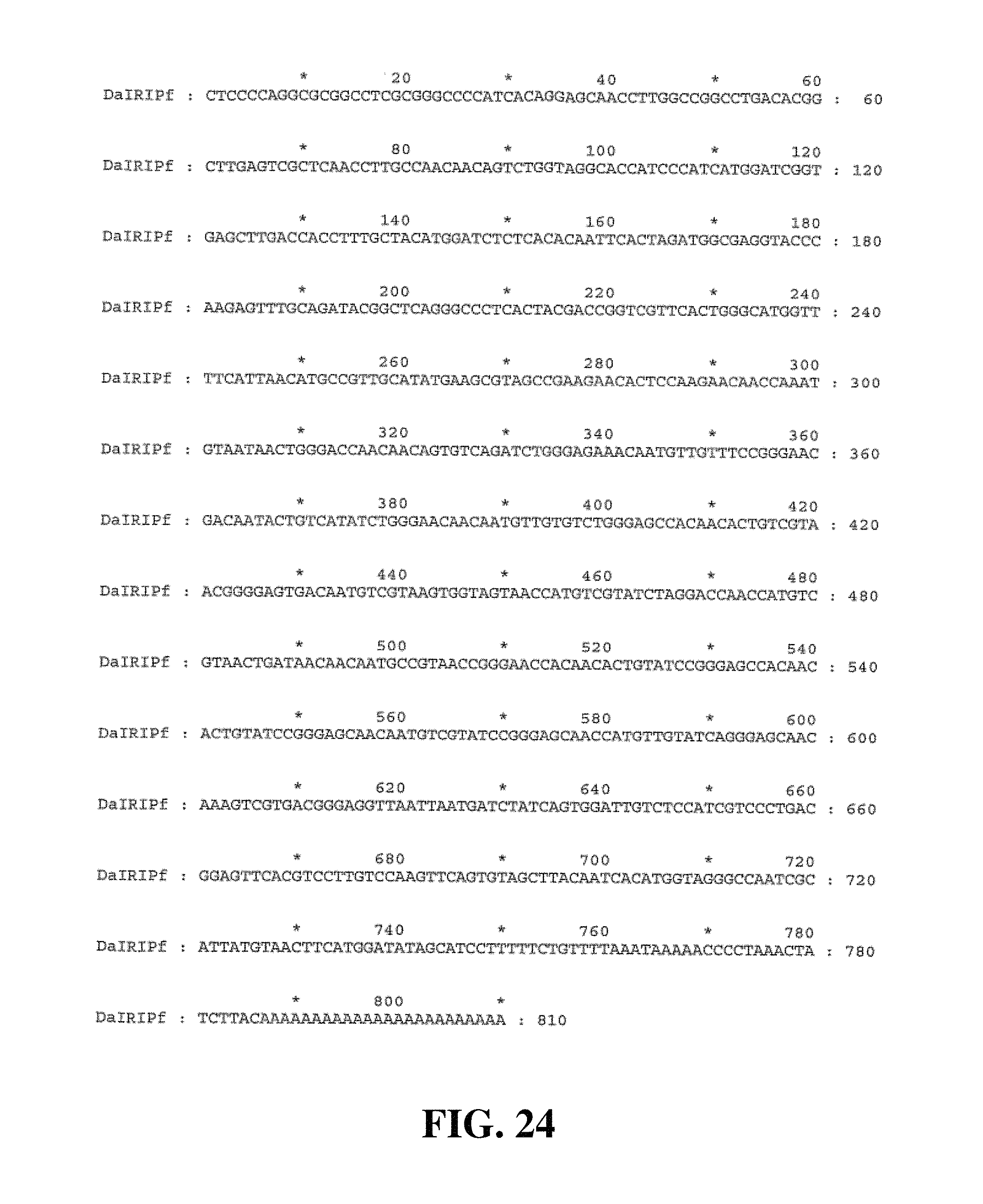
D00050
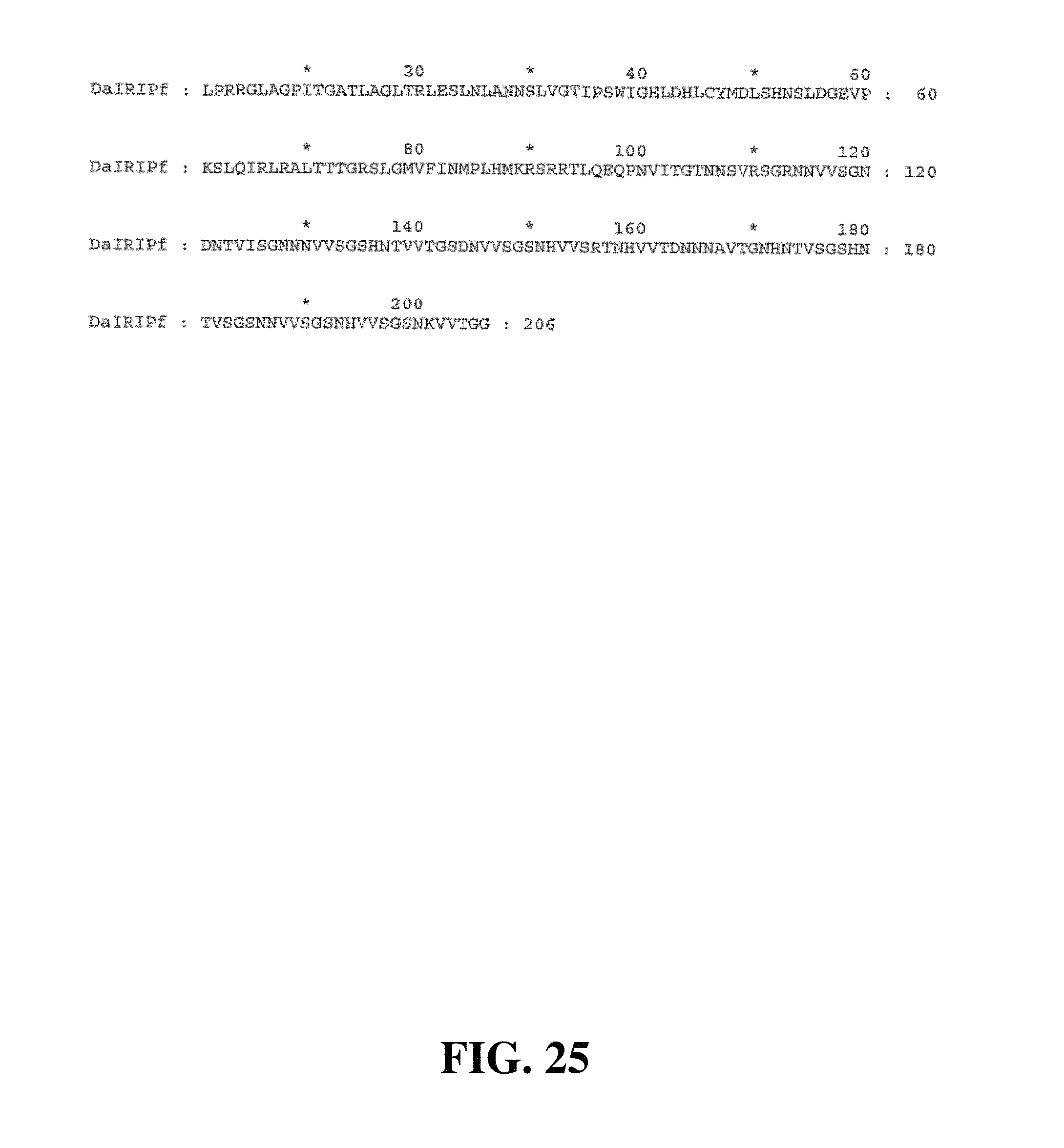
D00051
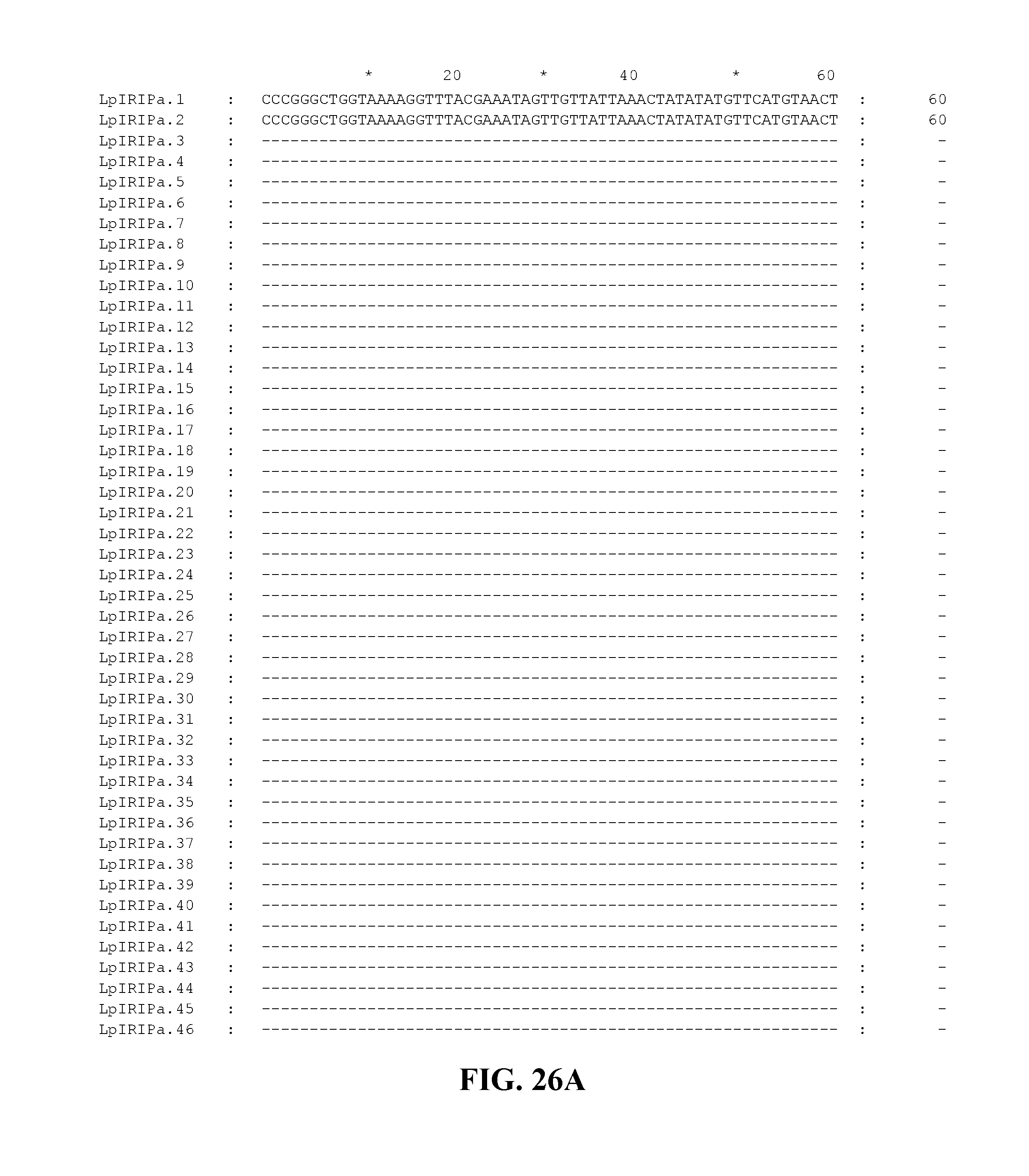
D00052
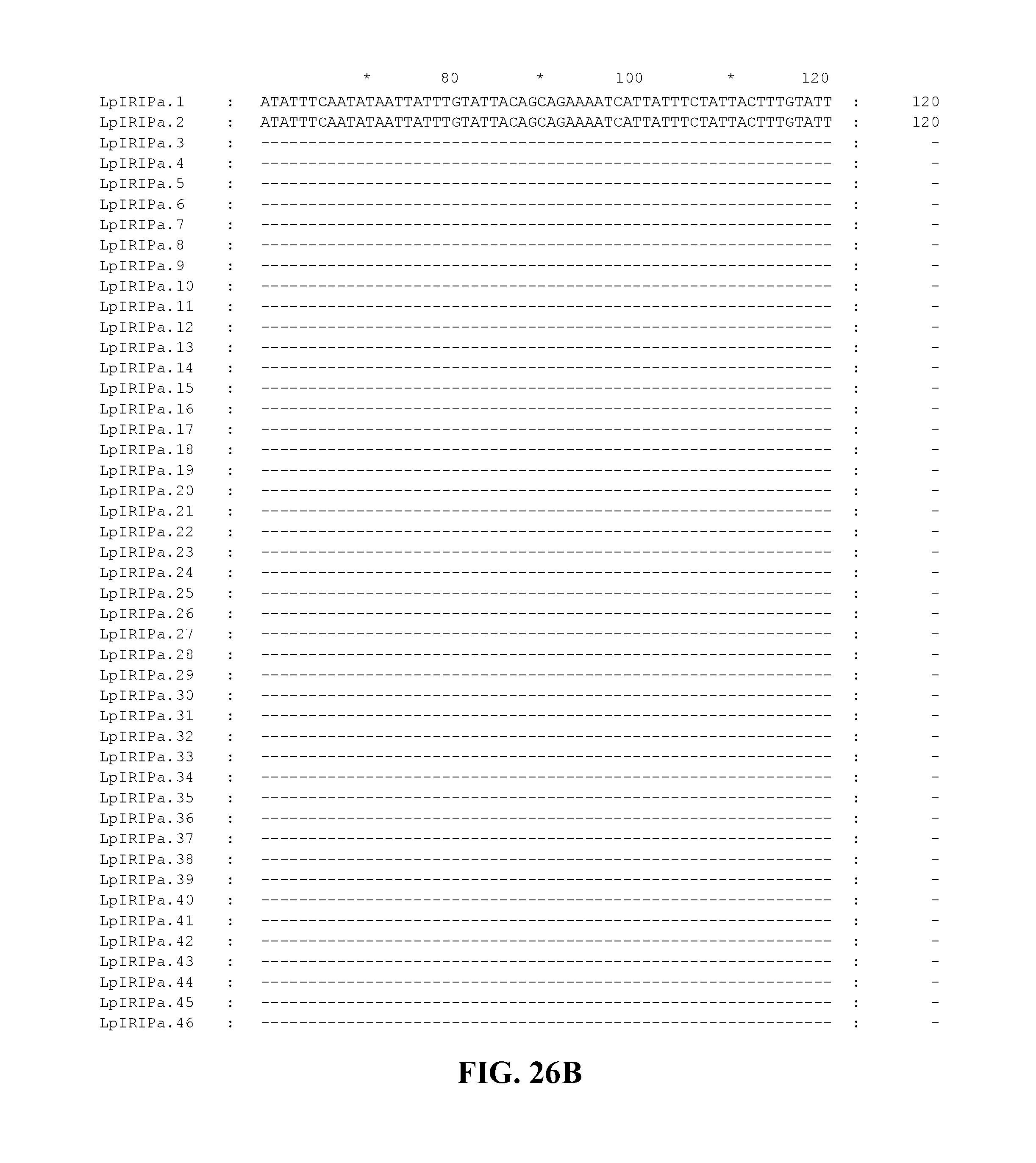
D00053

D00054
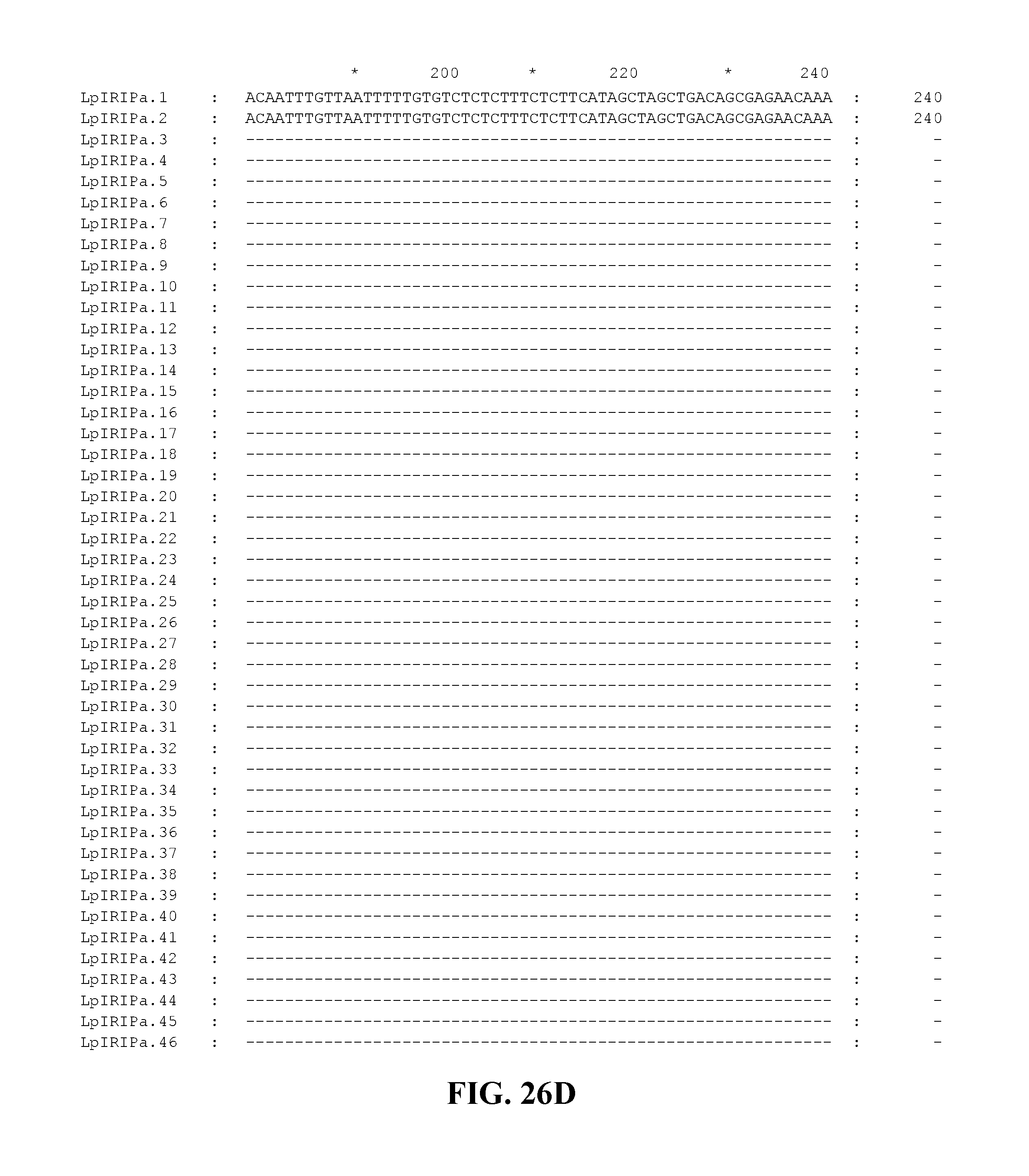
D00055
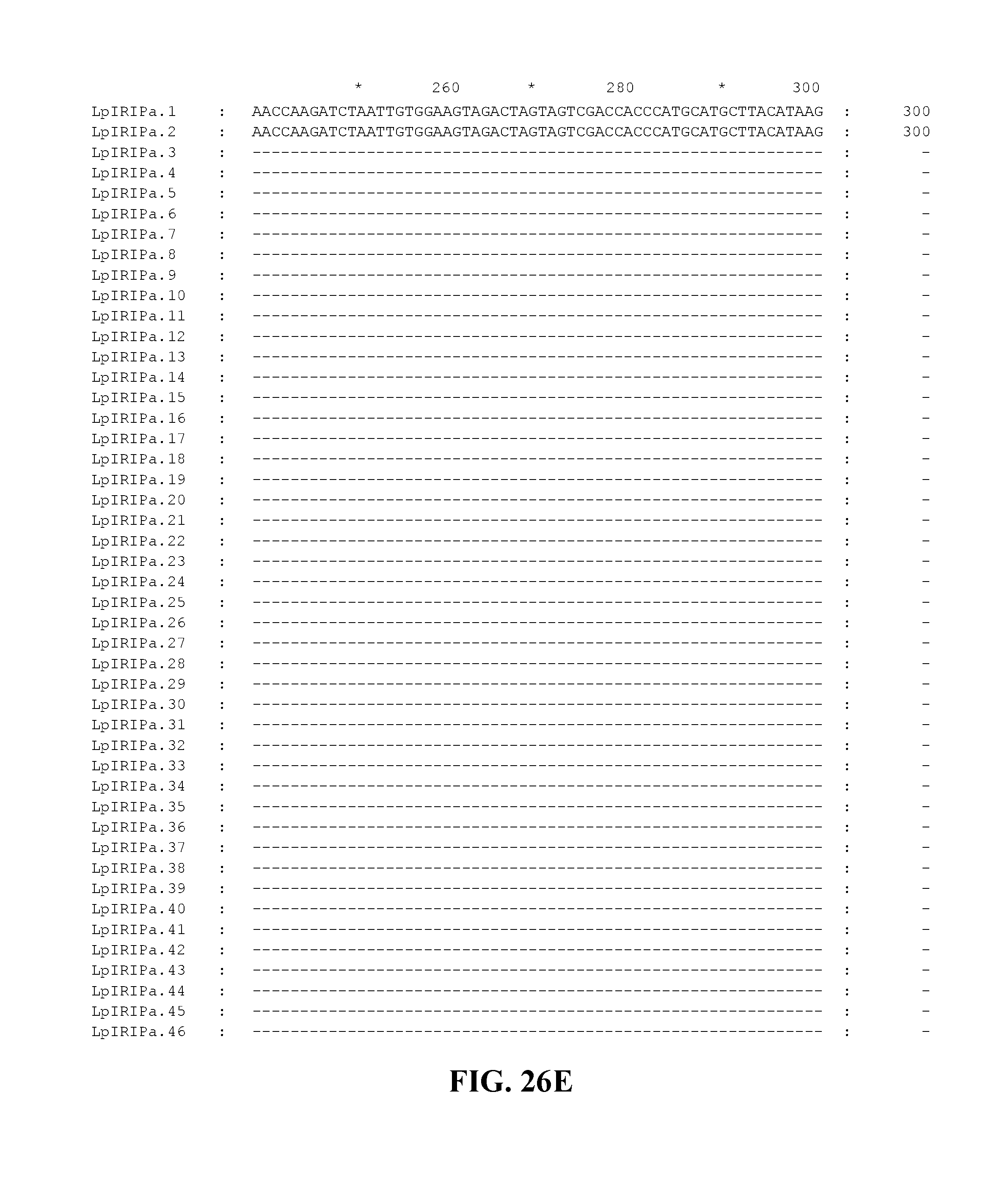
D00056

D00057
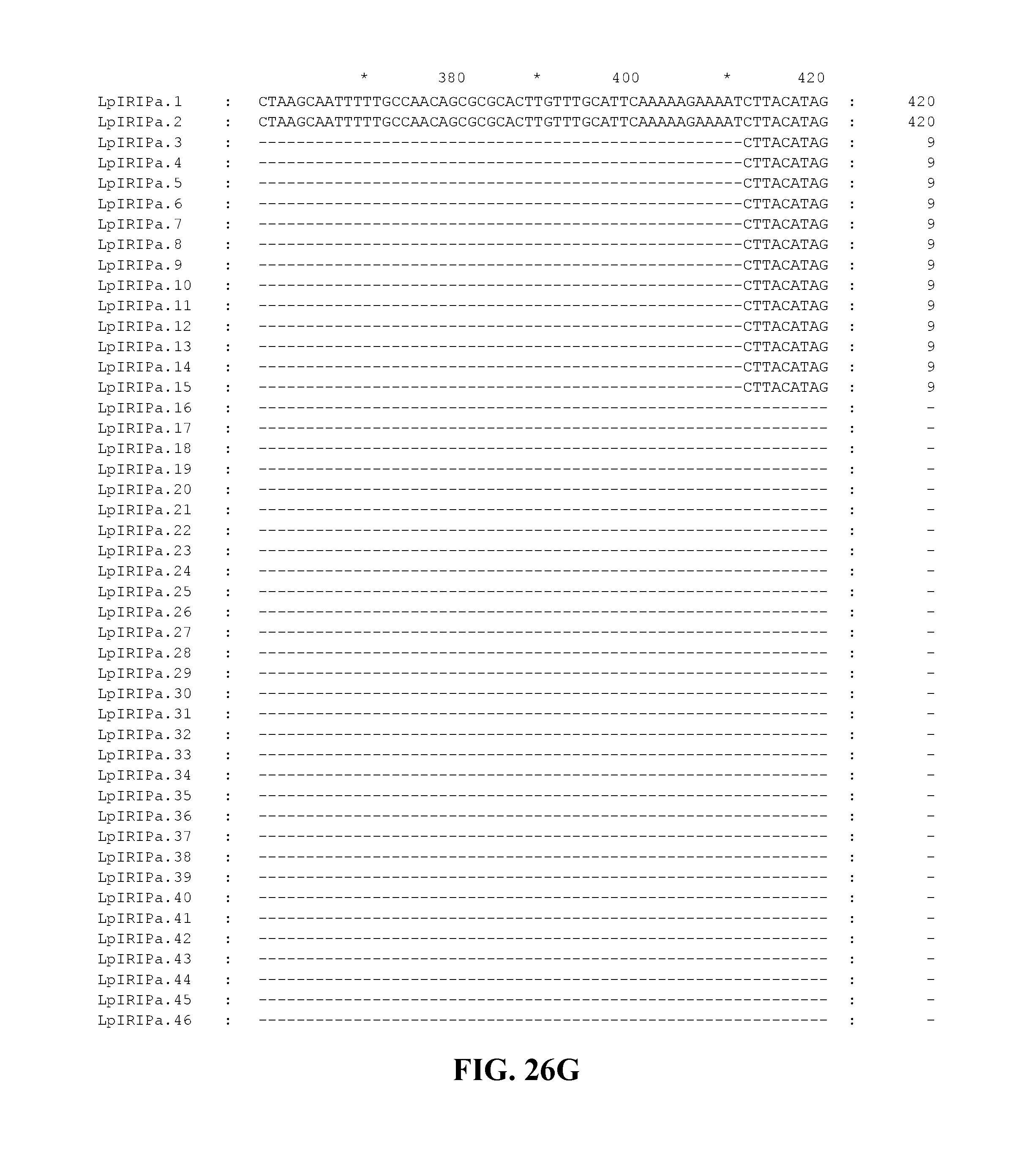
D00058
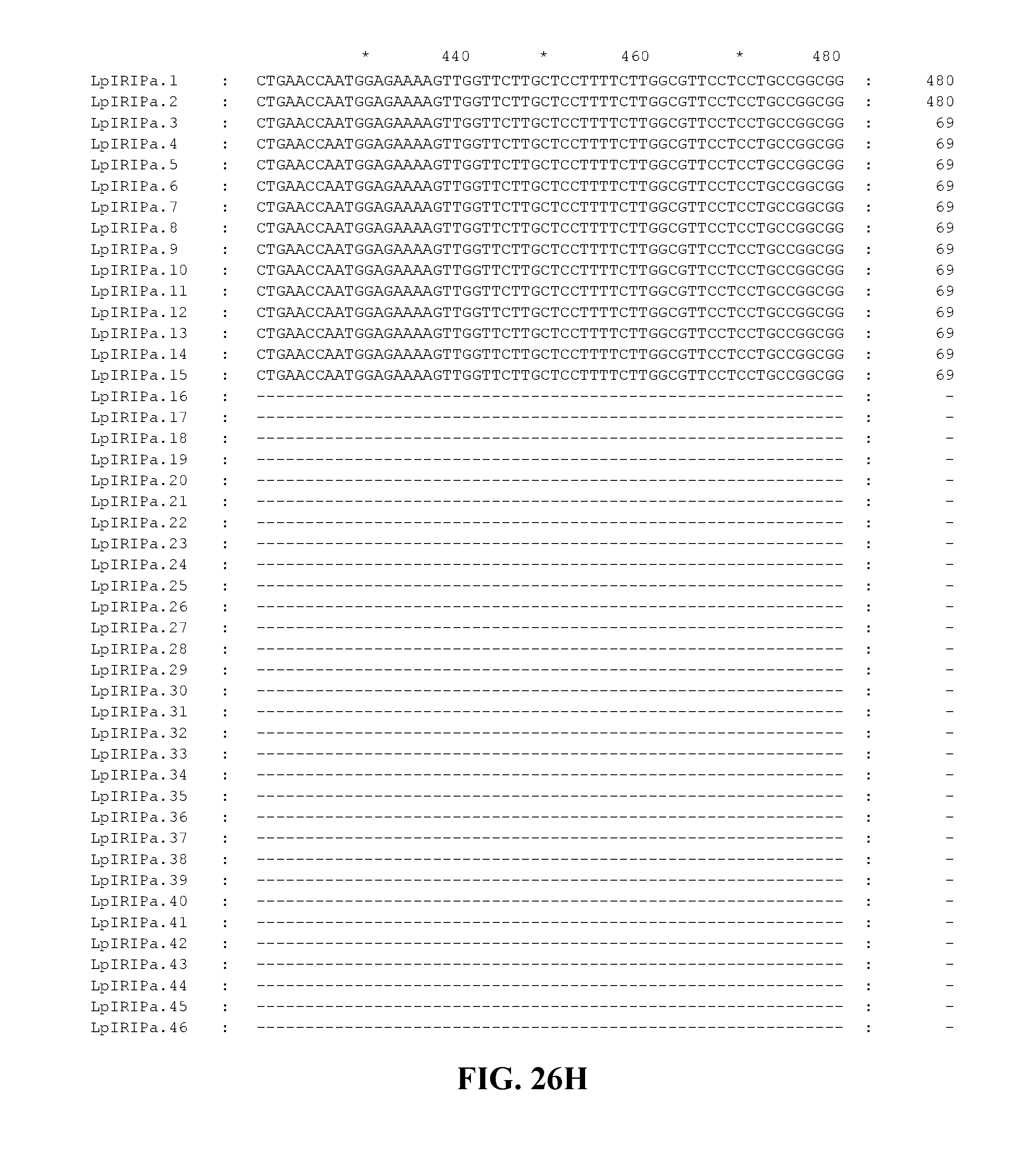
D00059

D00060
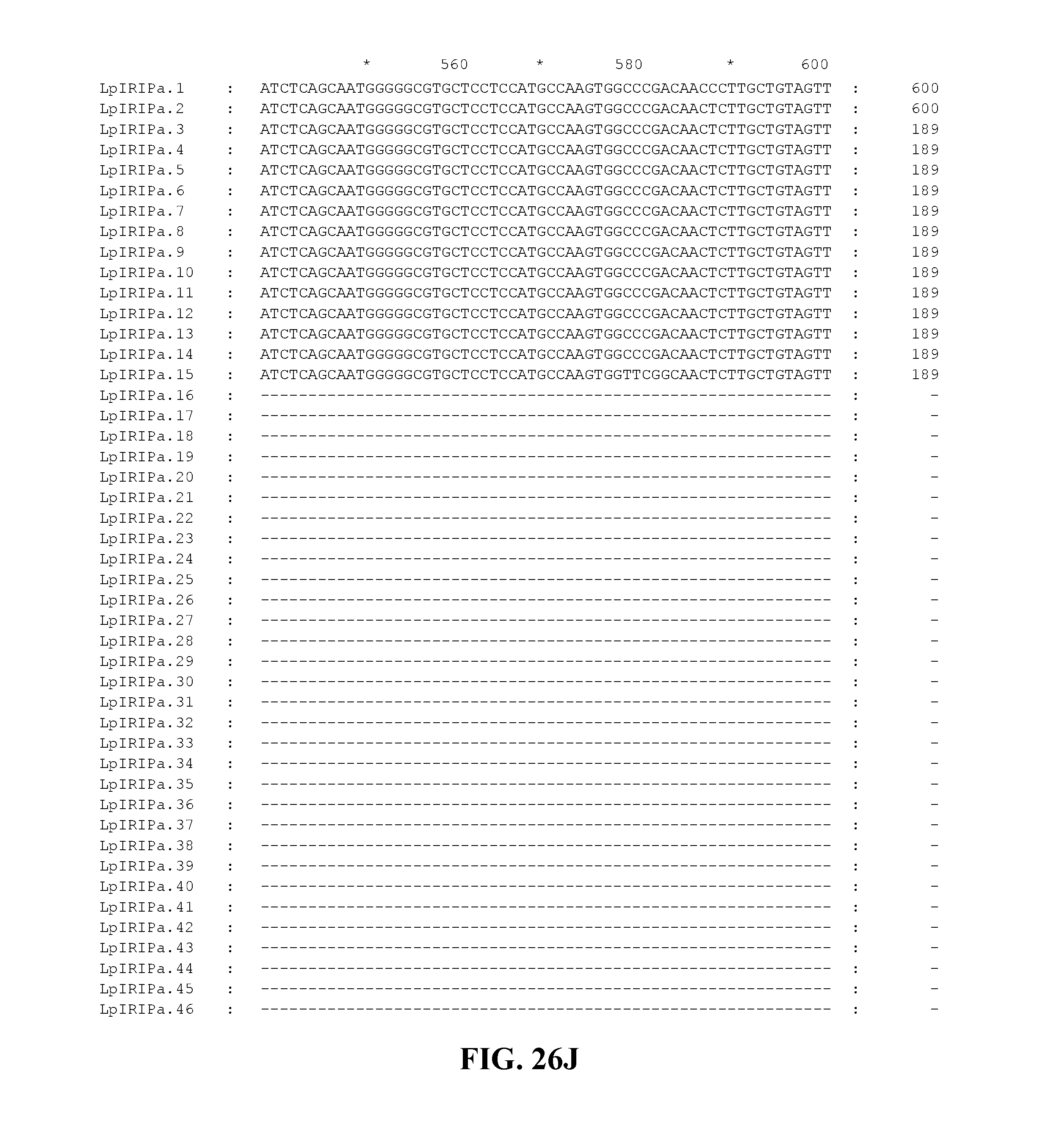
D00061
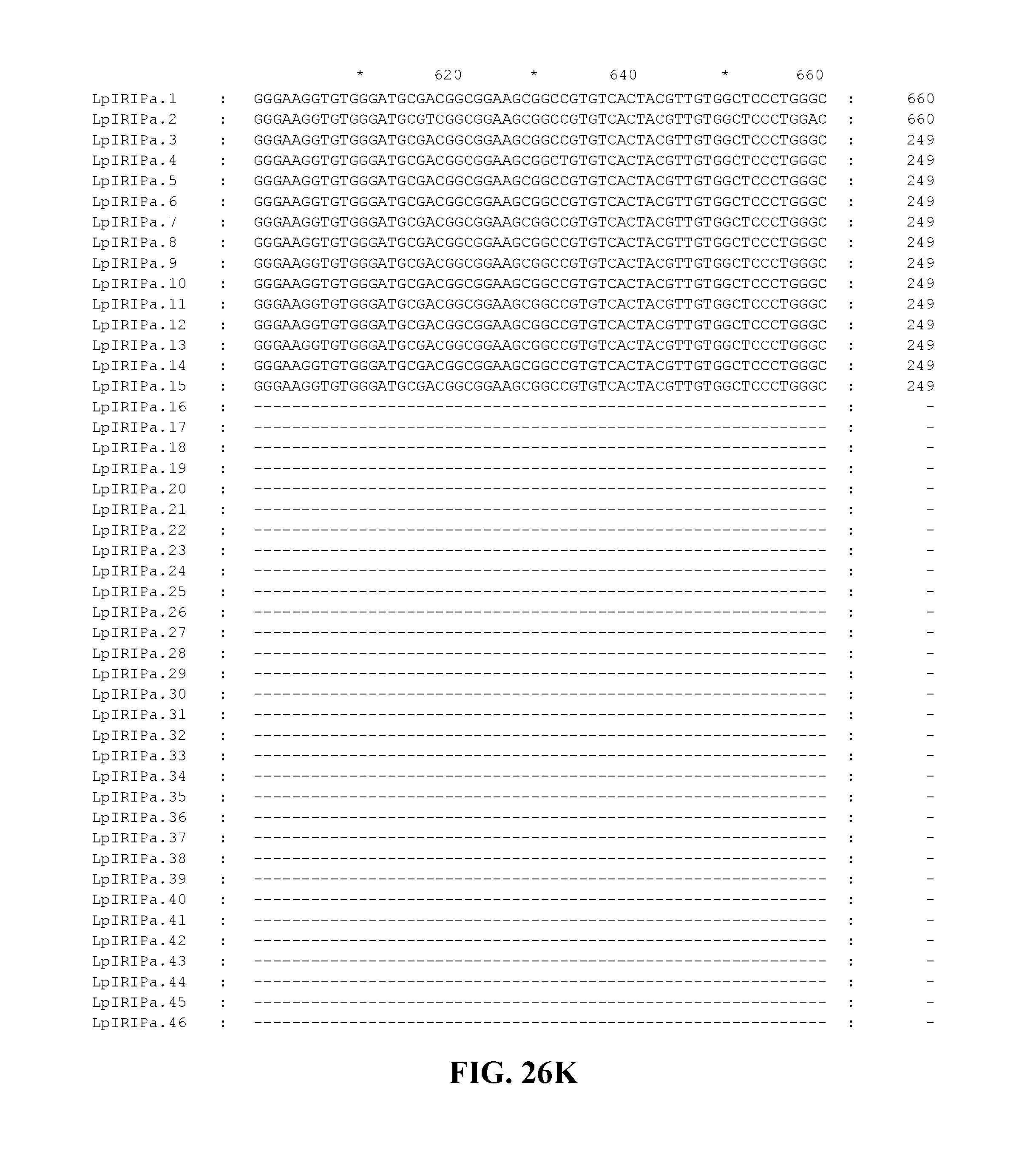
D00062
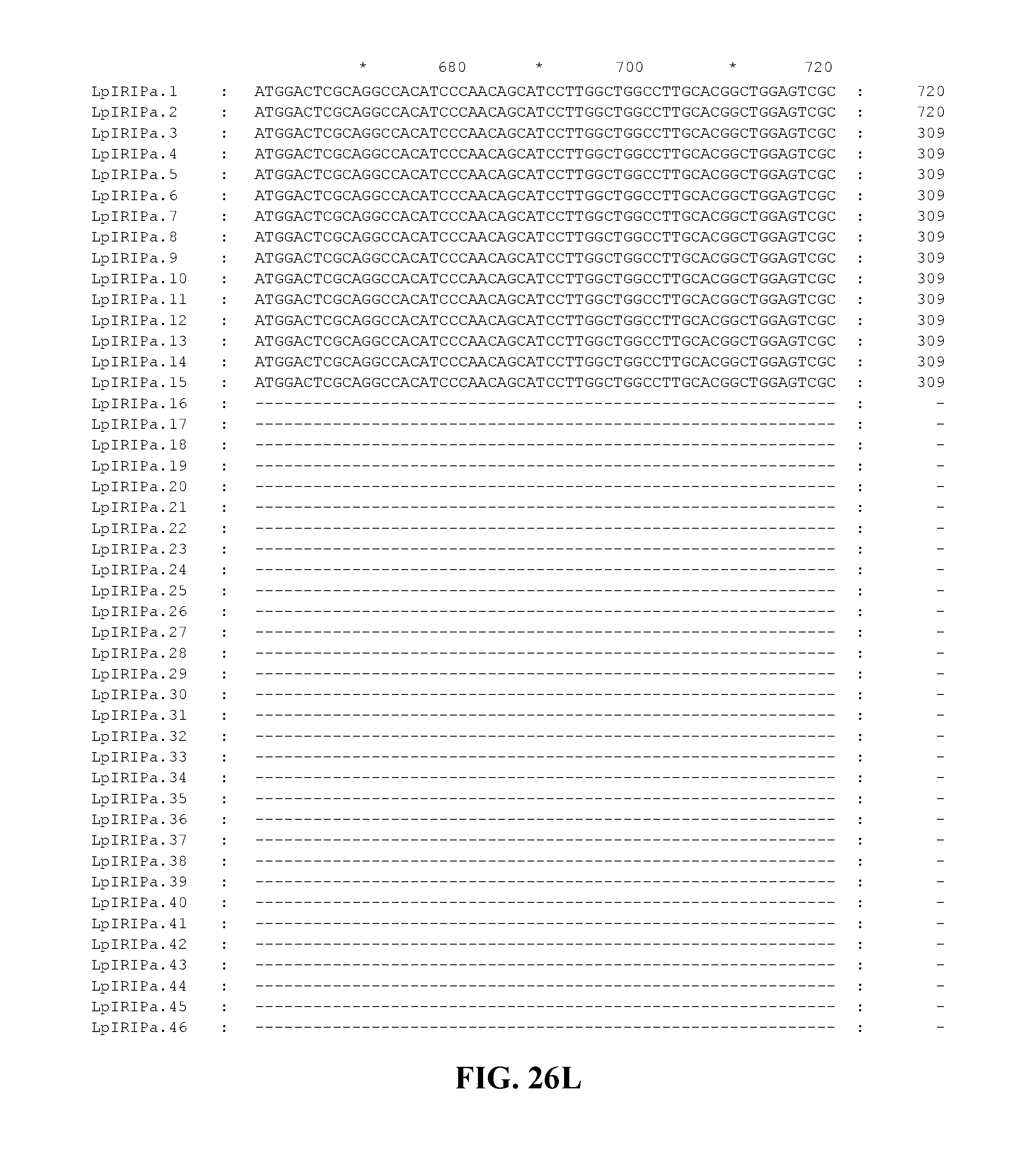
D00063
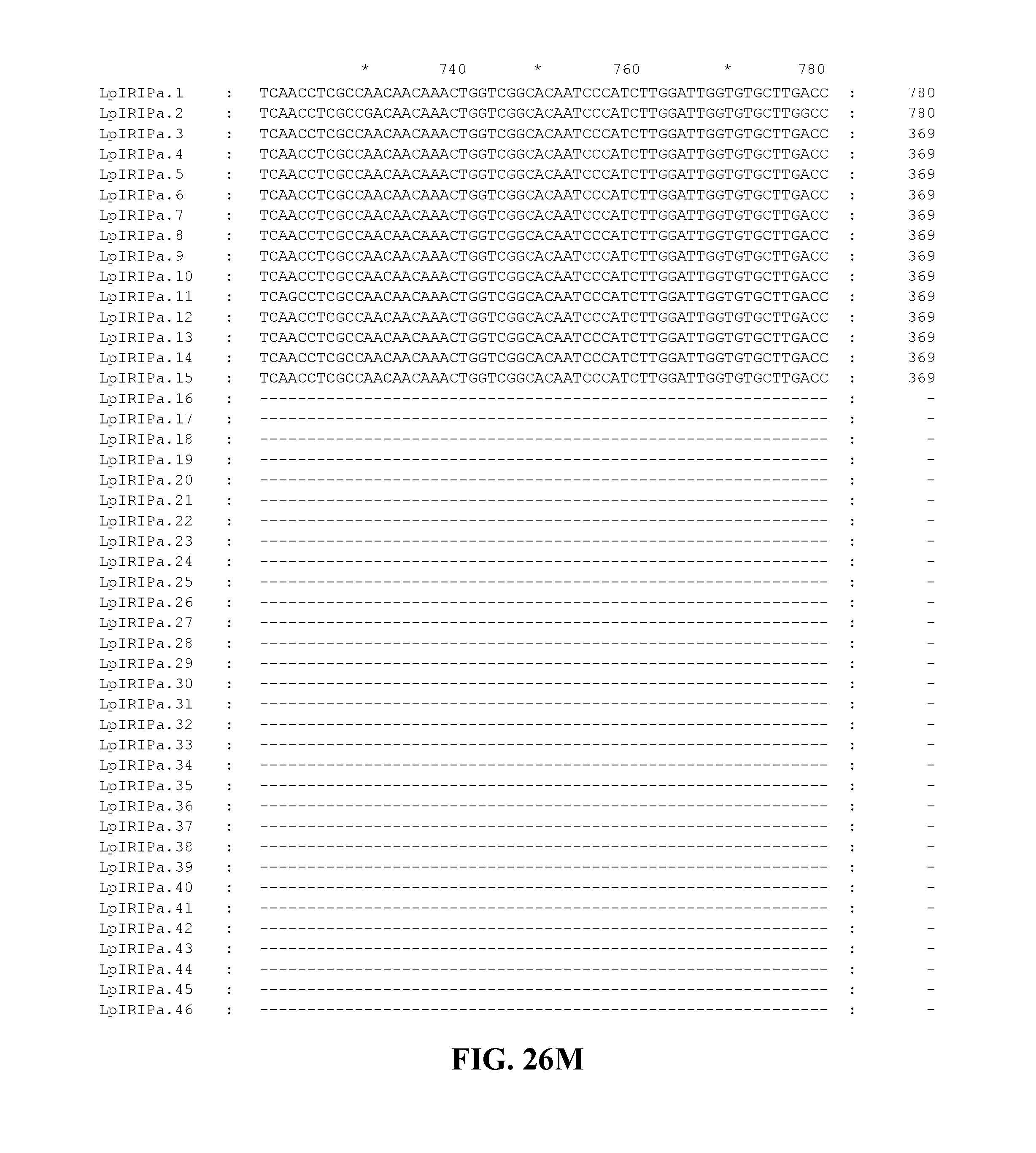
D00064
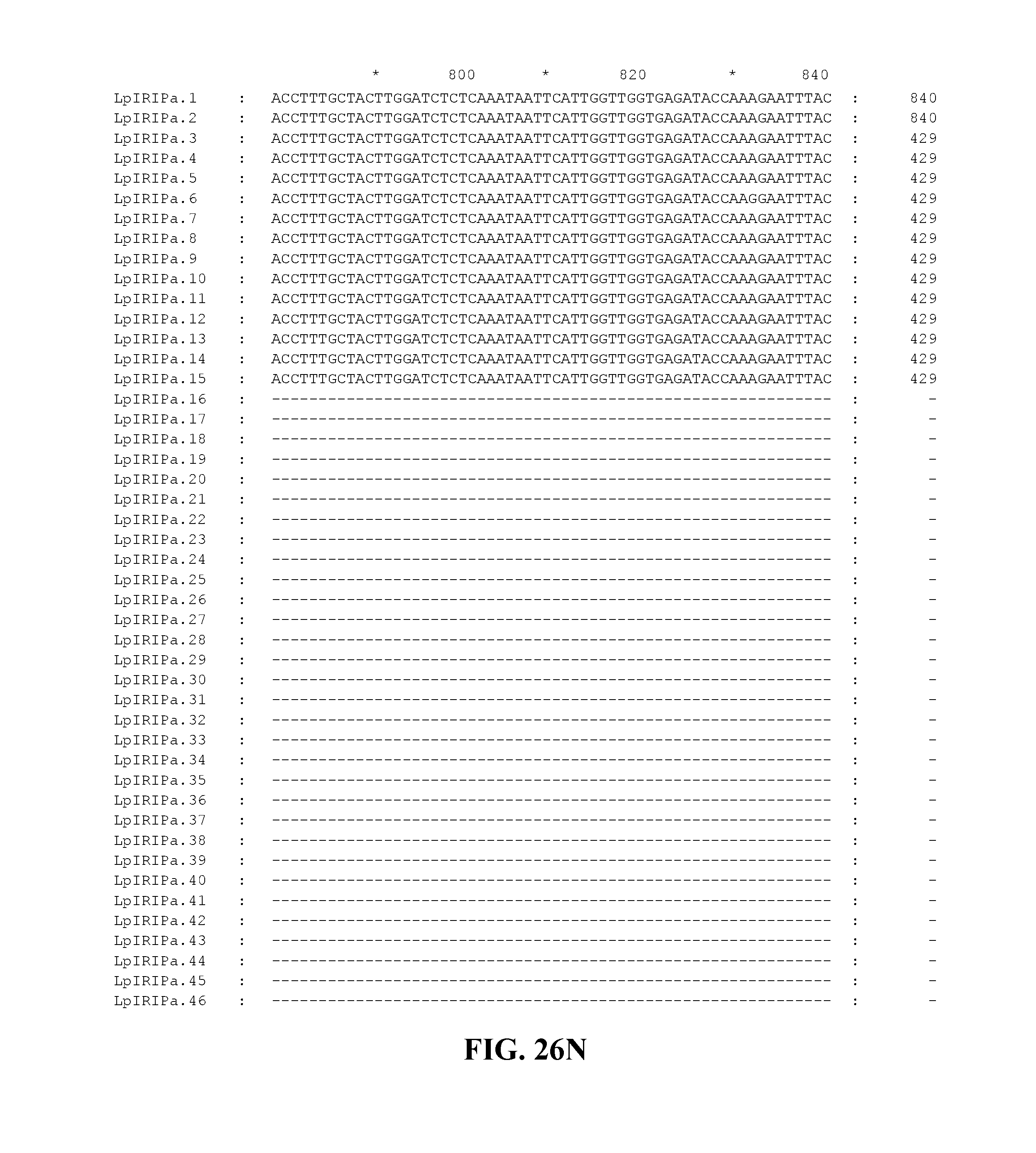
D00065

D00066

D00067
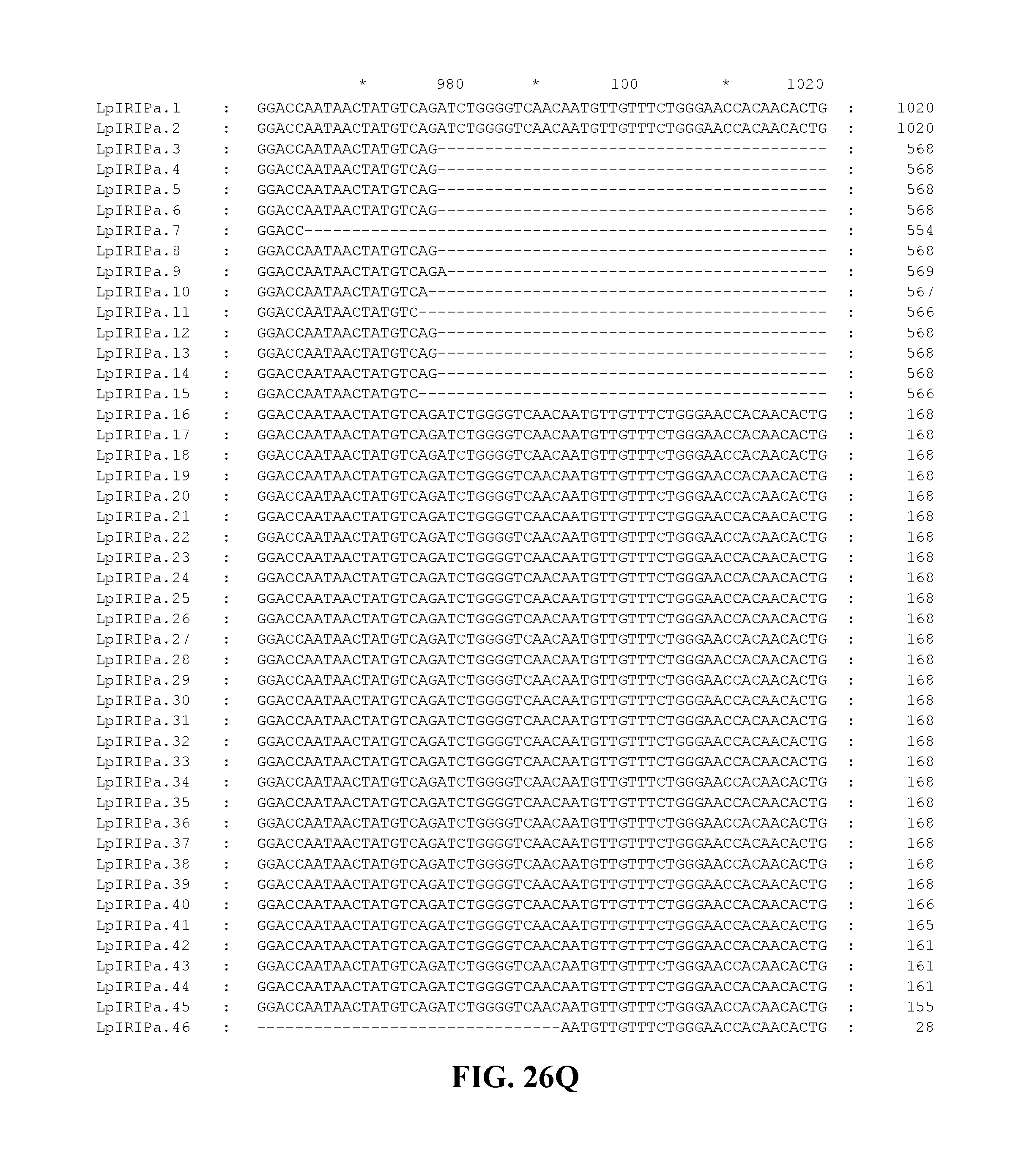
D00068

D00069
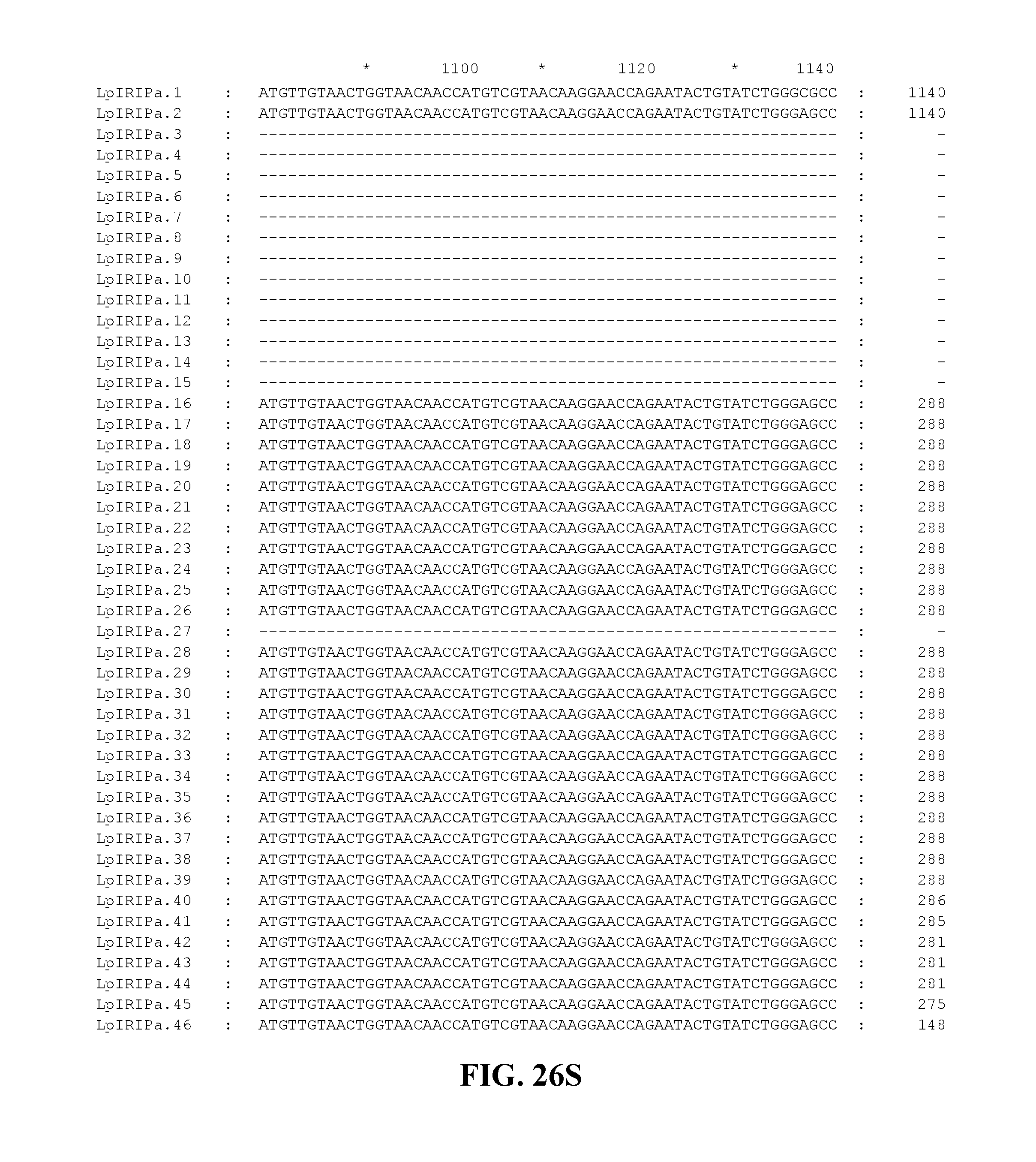
D00070
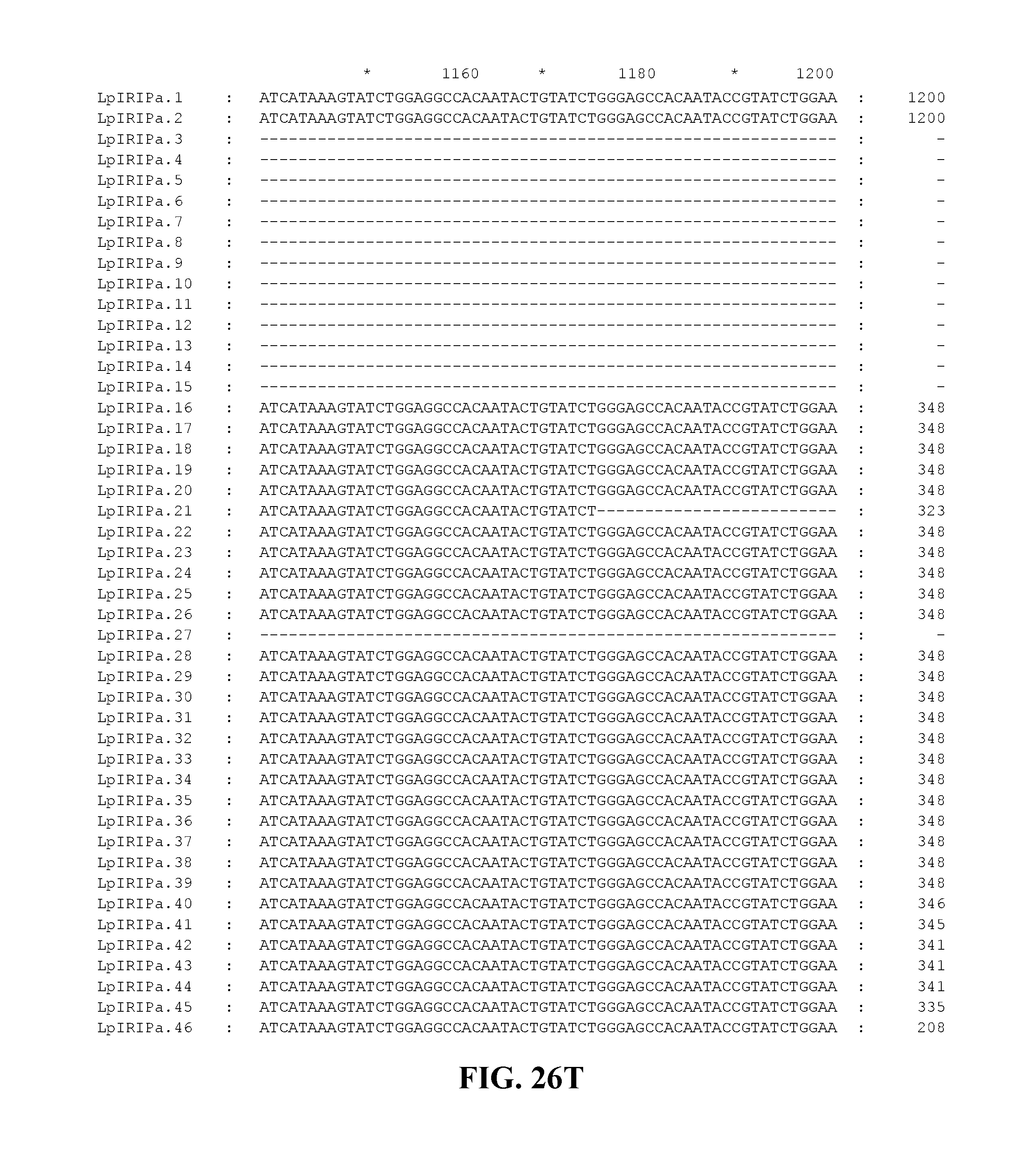
D00071
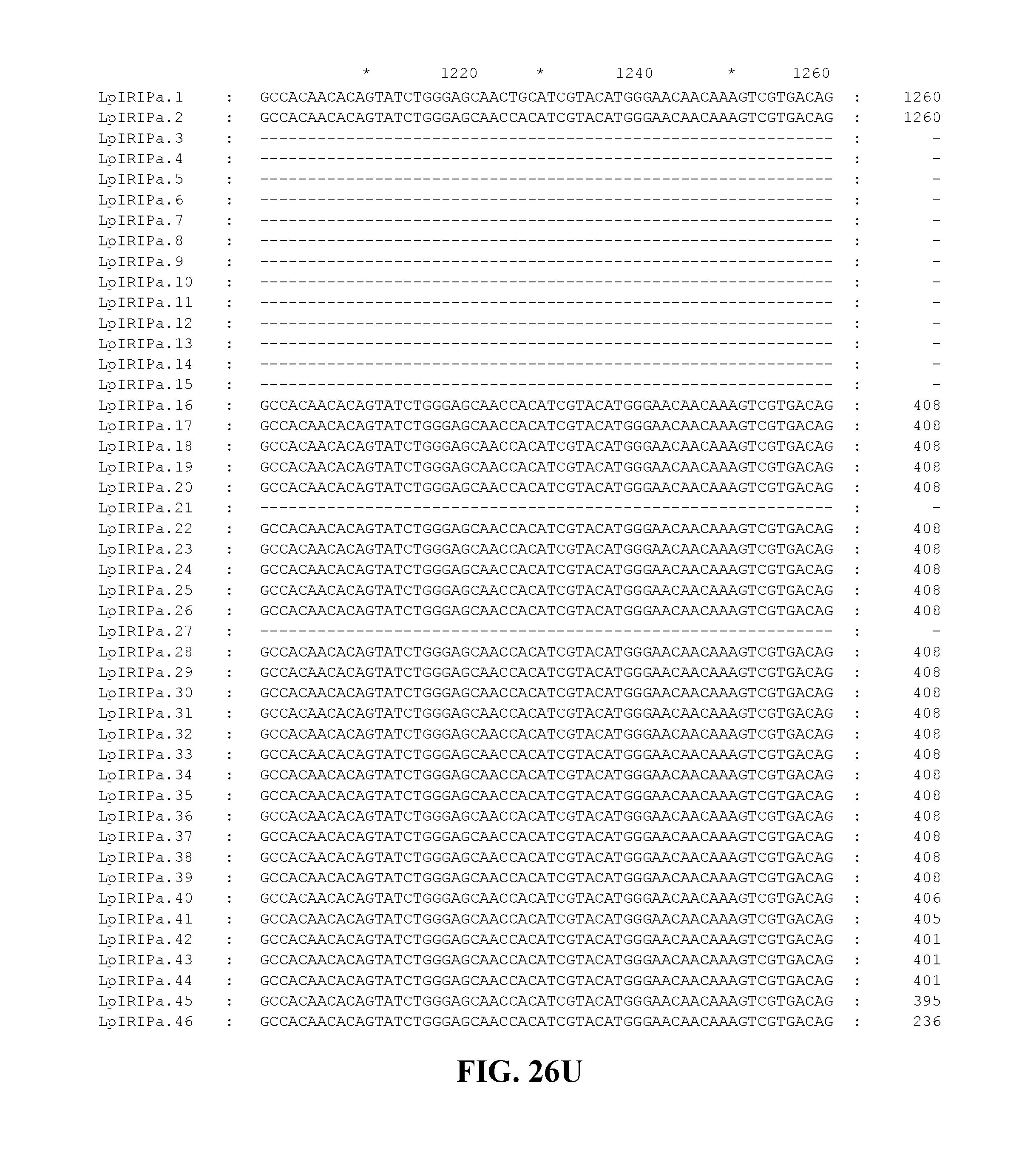
D00072
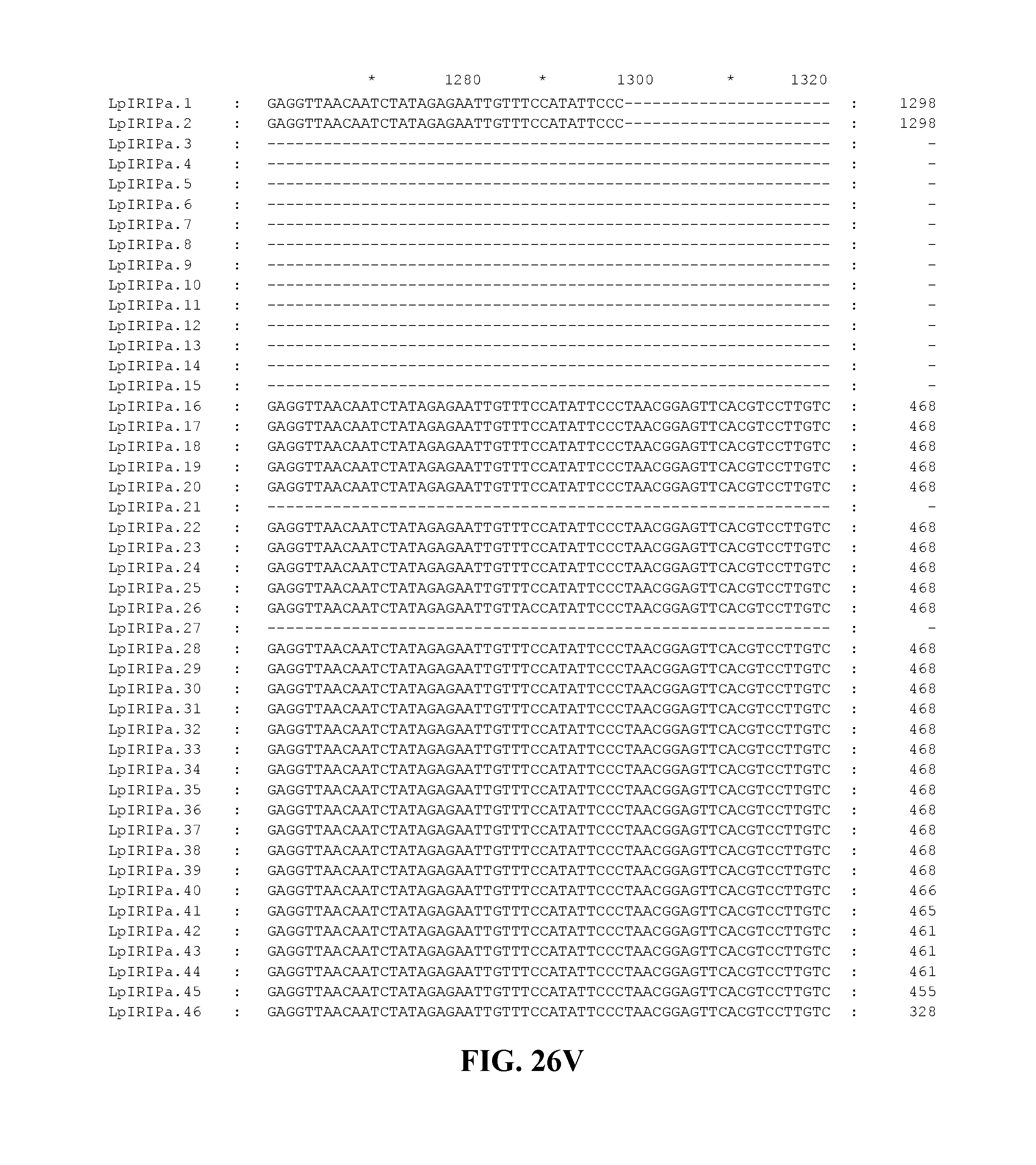
D00073
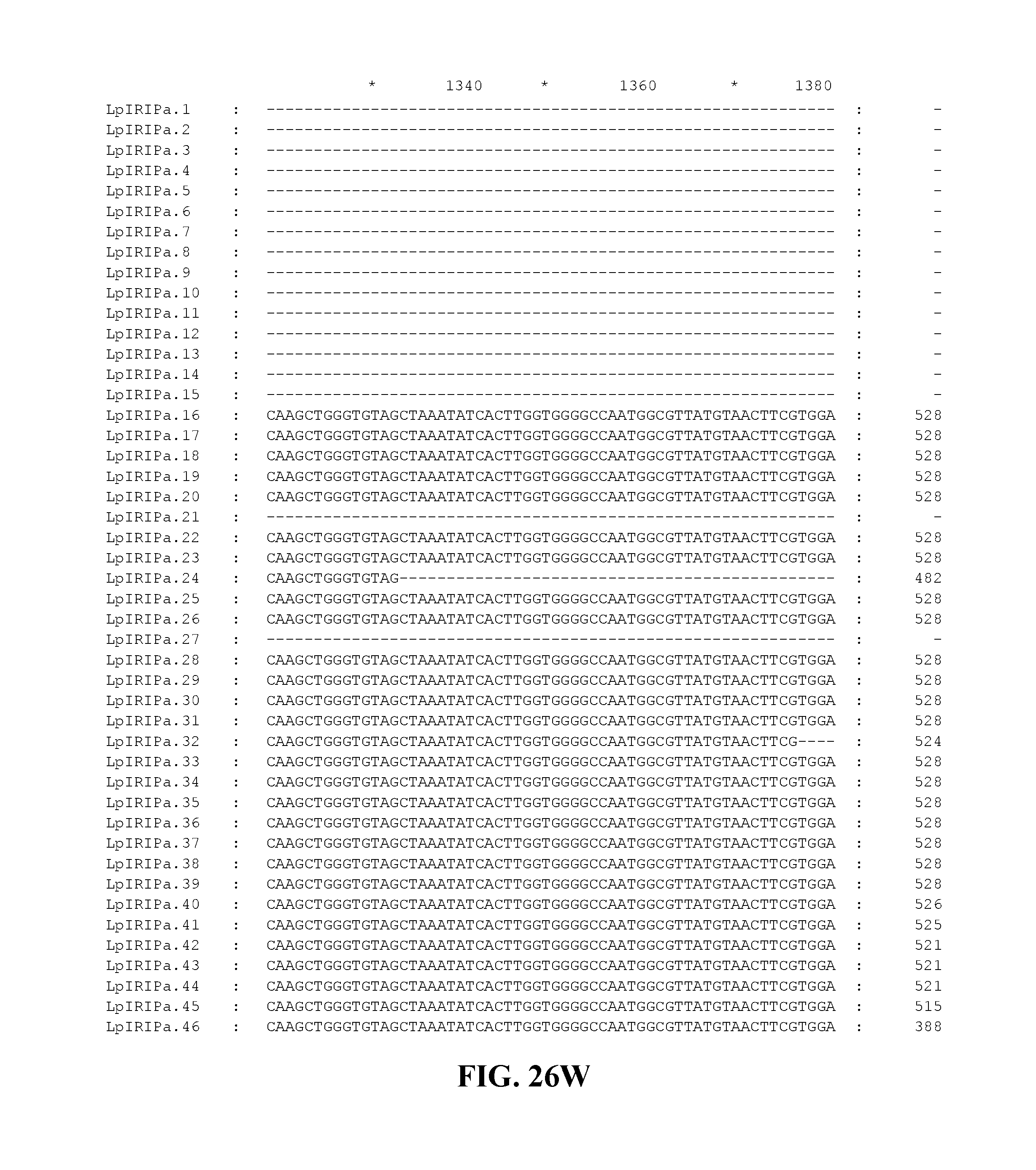
D00074
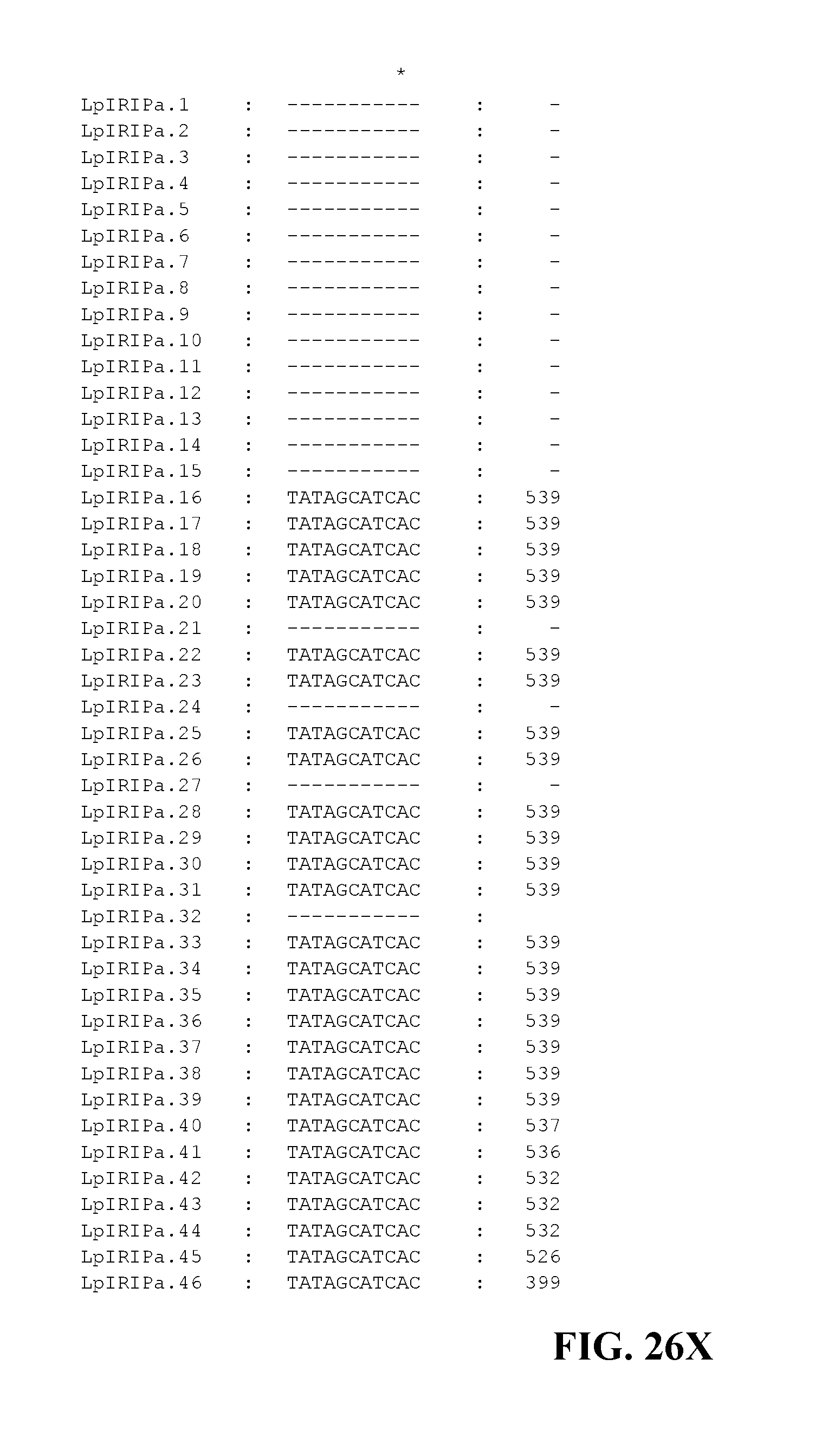
D00075
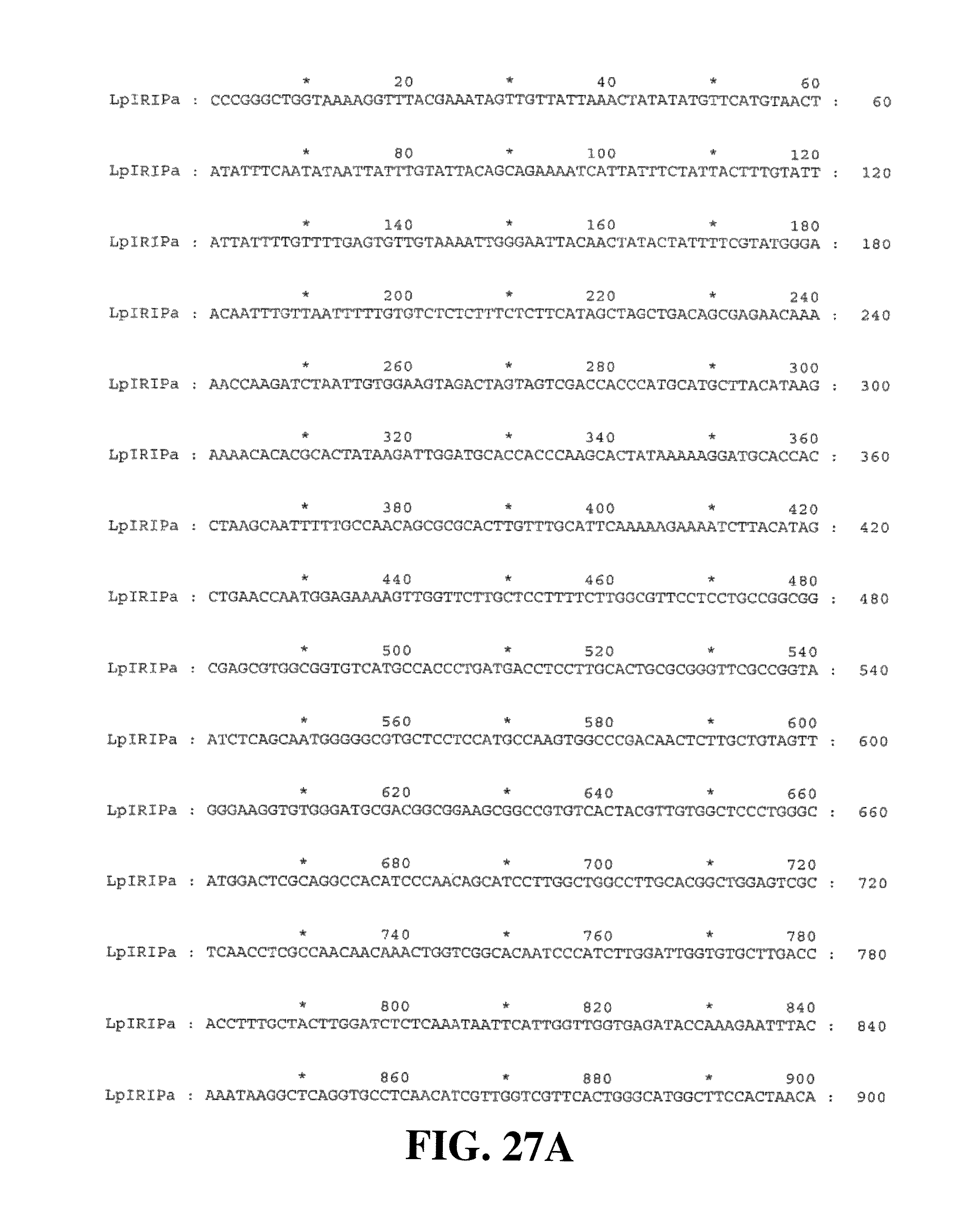
D00076
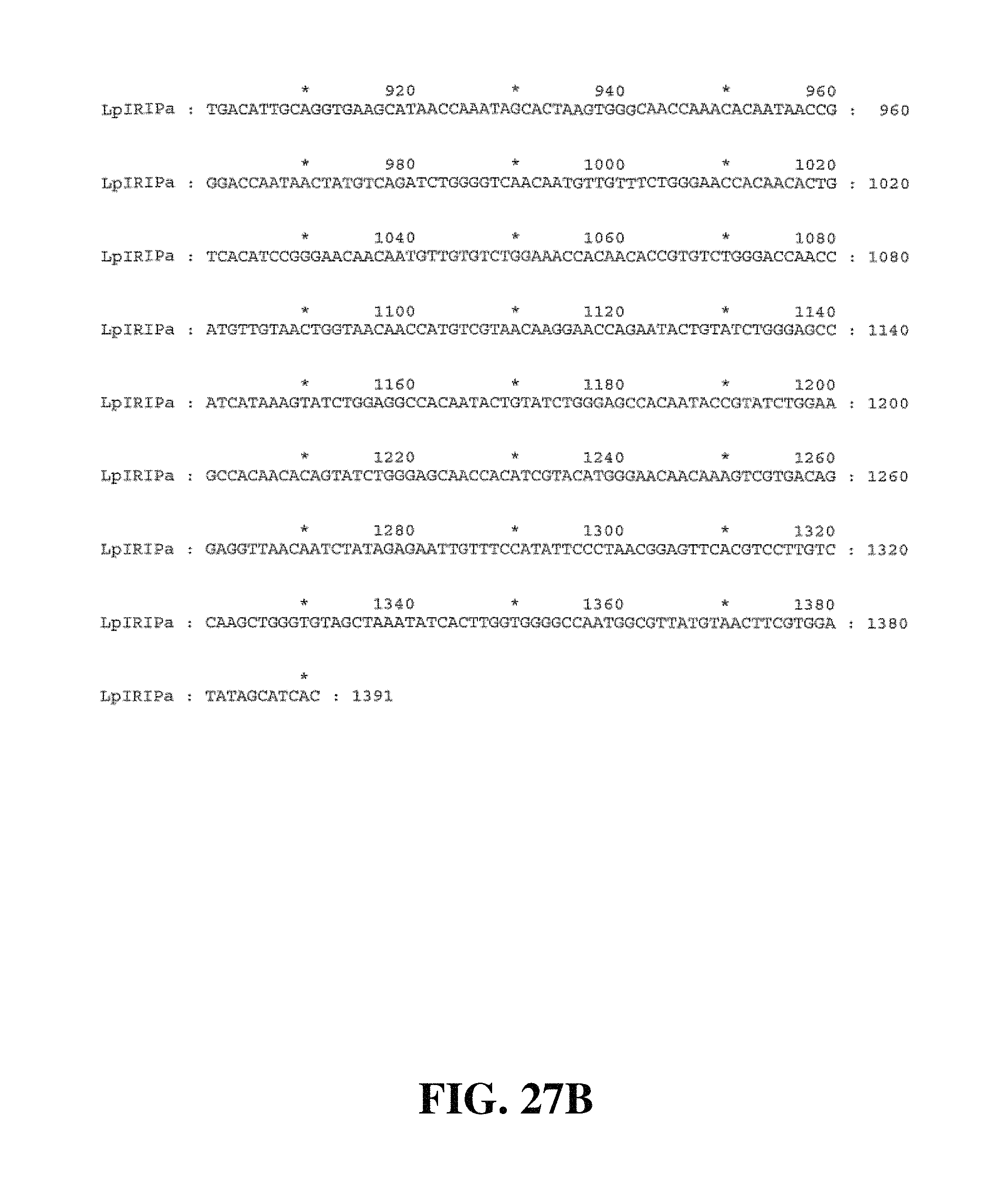
D00077
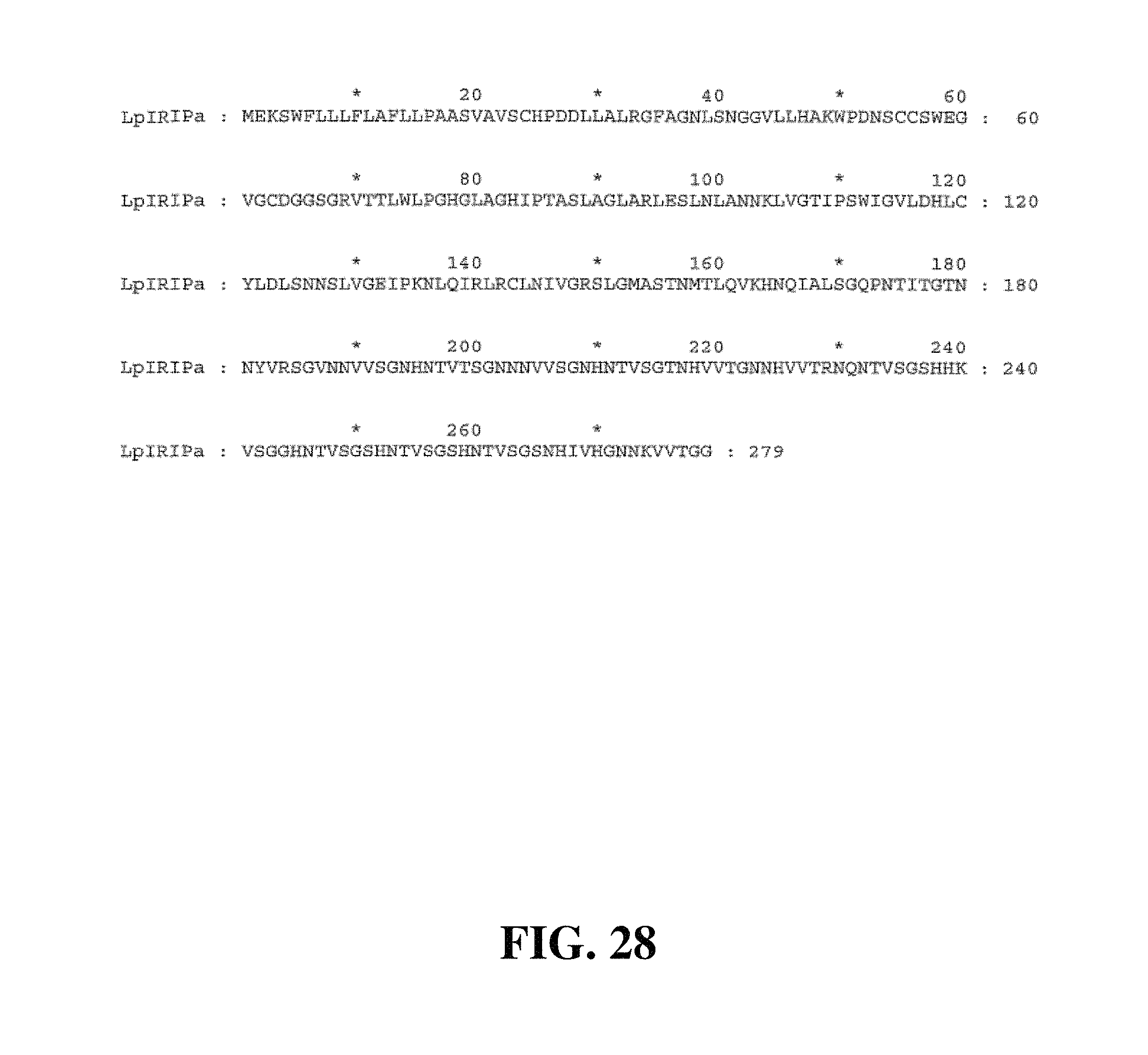
D00078

D00079
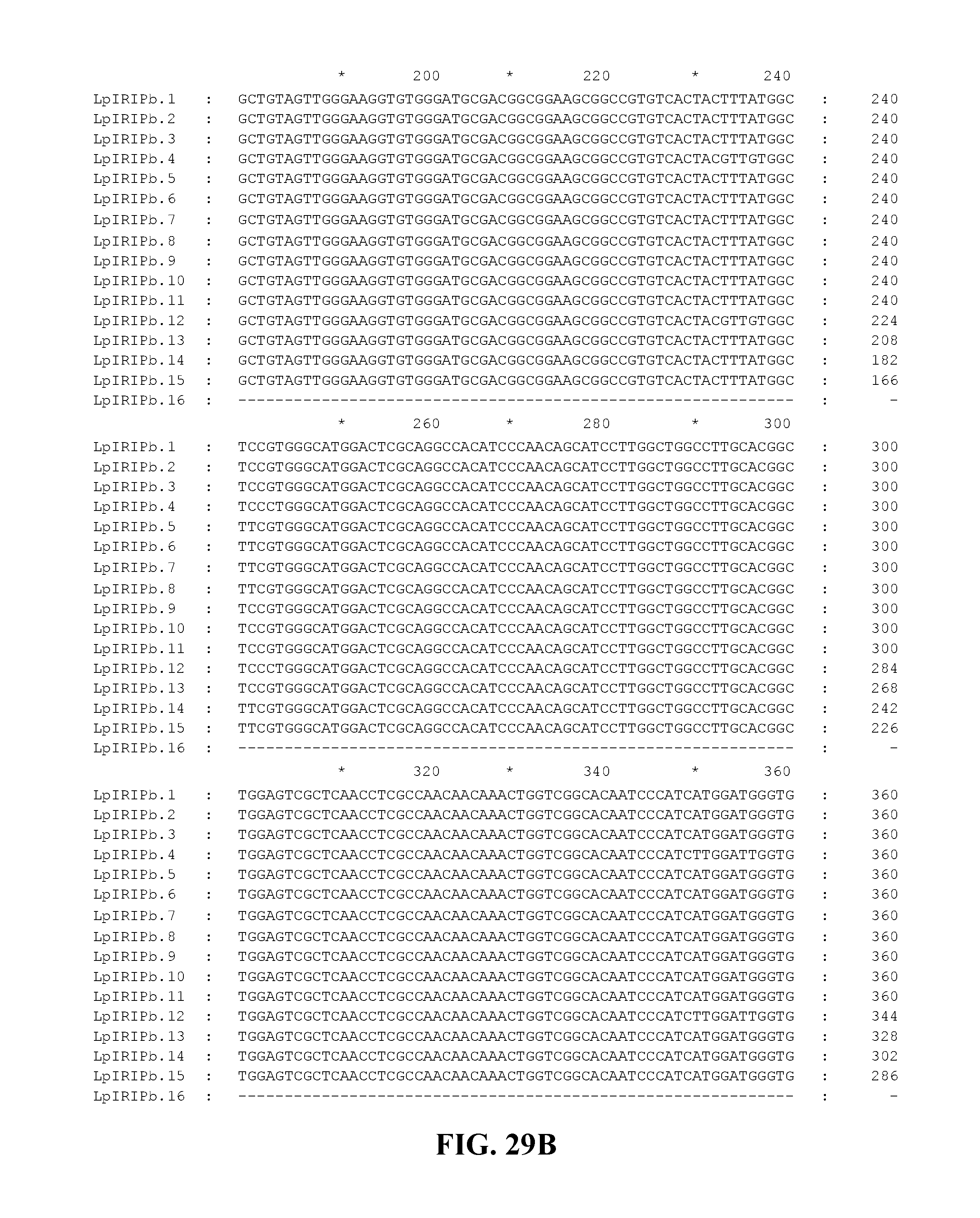
D00080

D00081

D00082
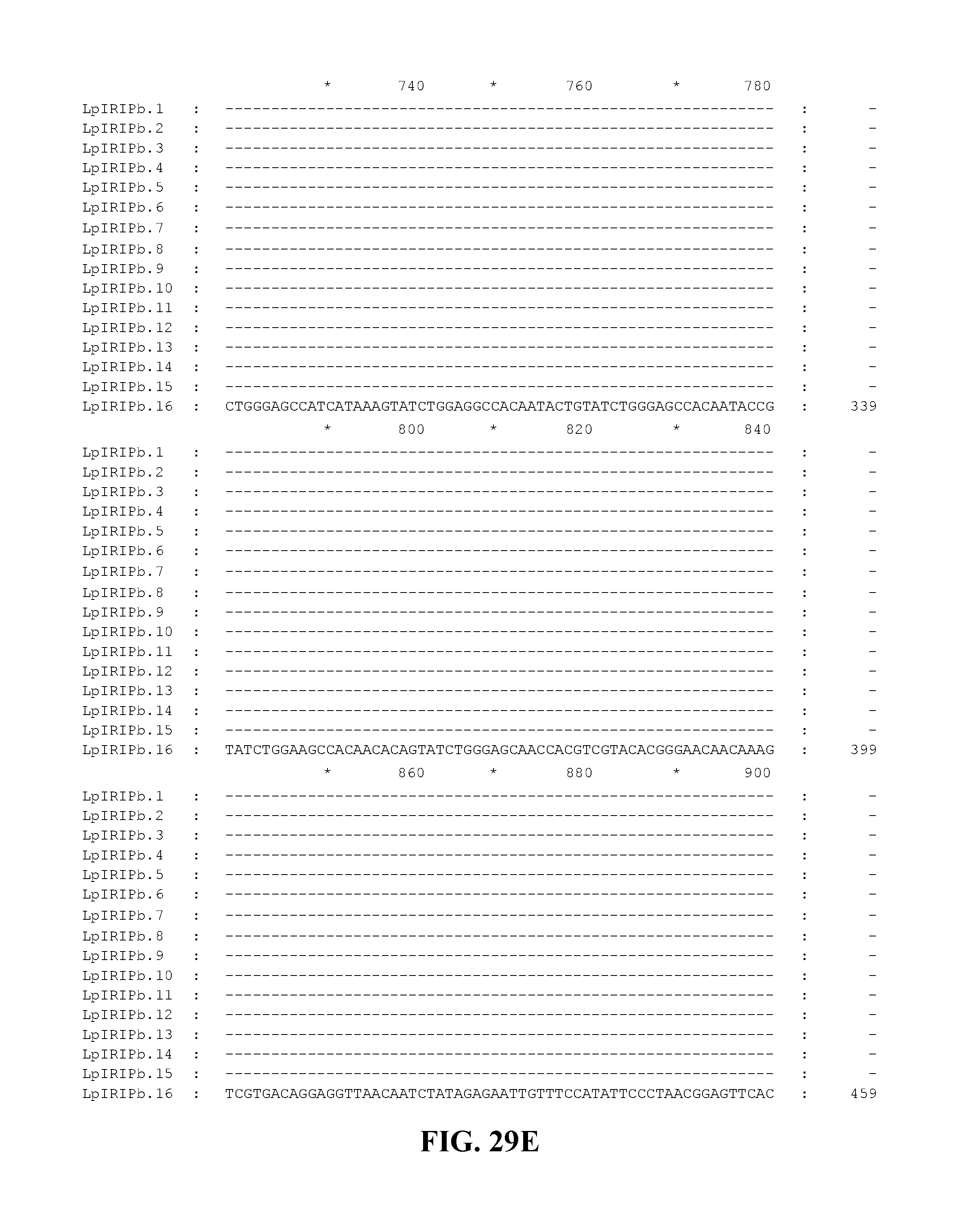
D00083

D00084
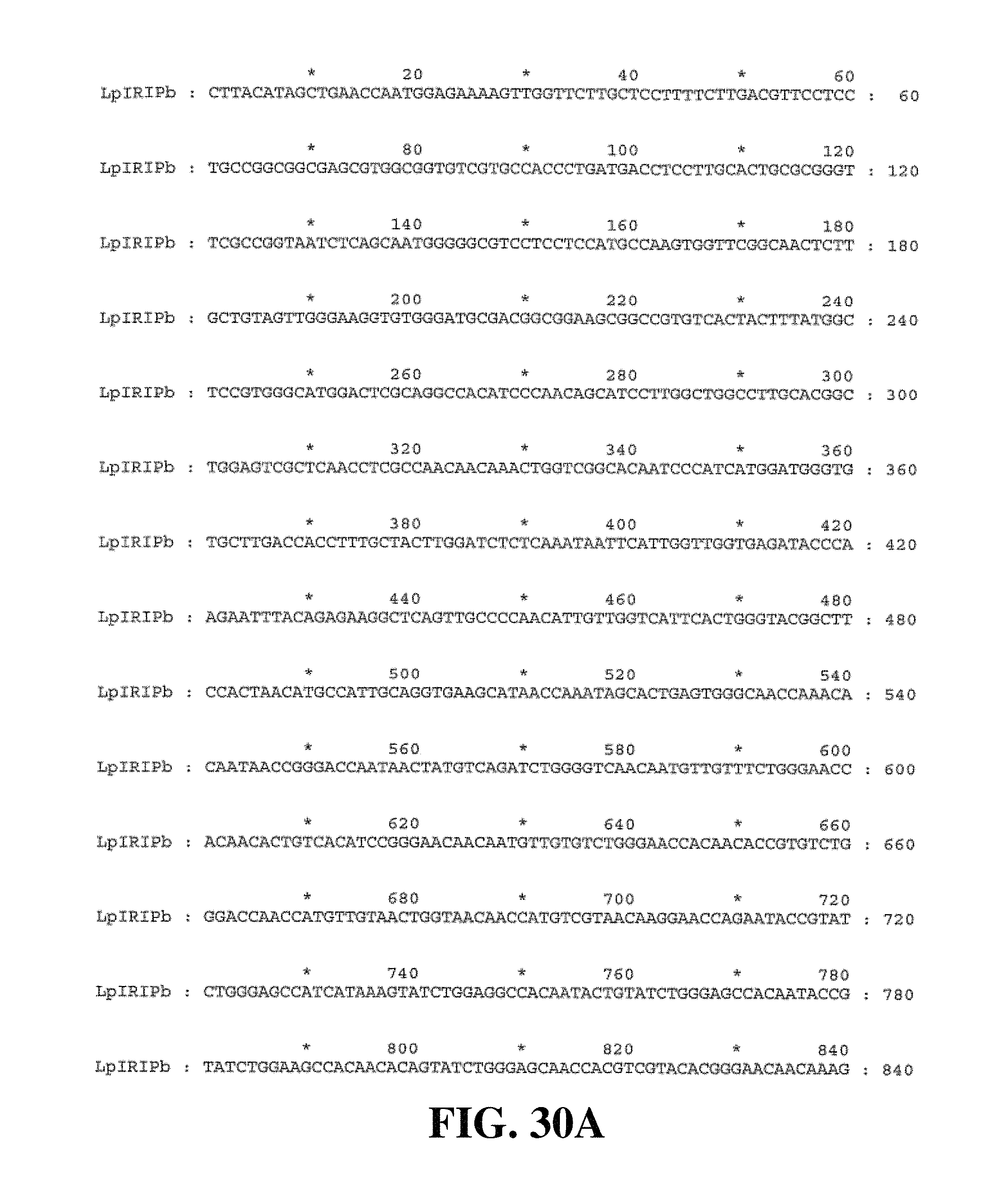
D00085

D00086

D00087
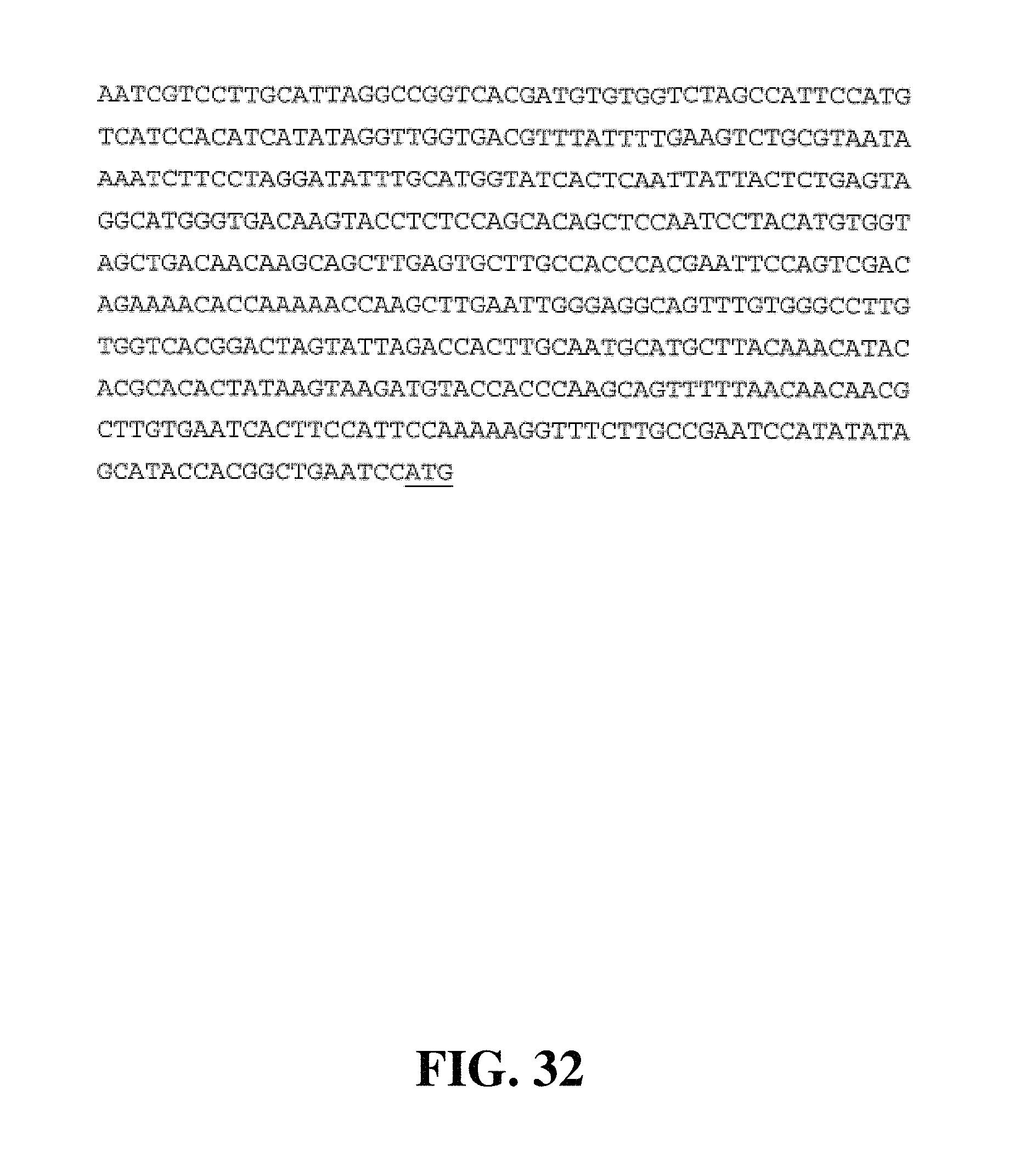
D00088
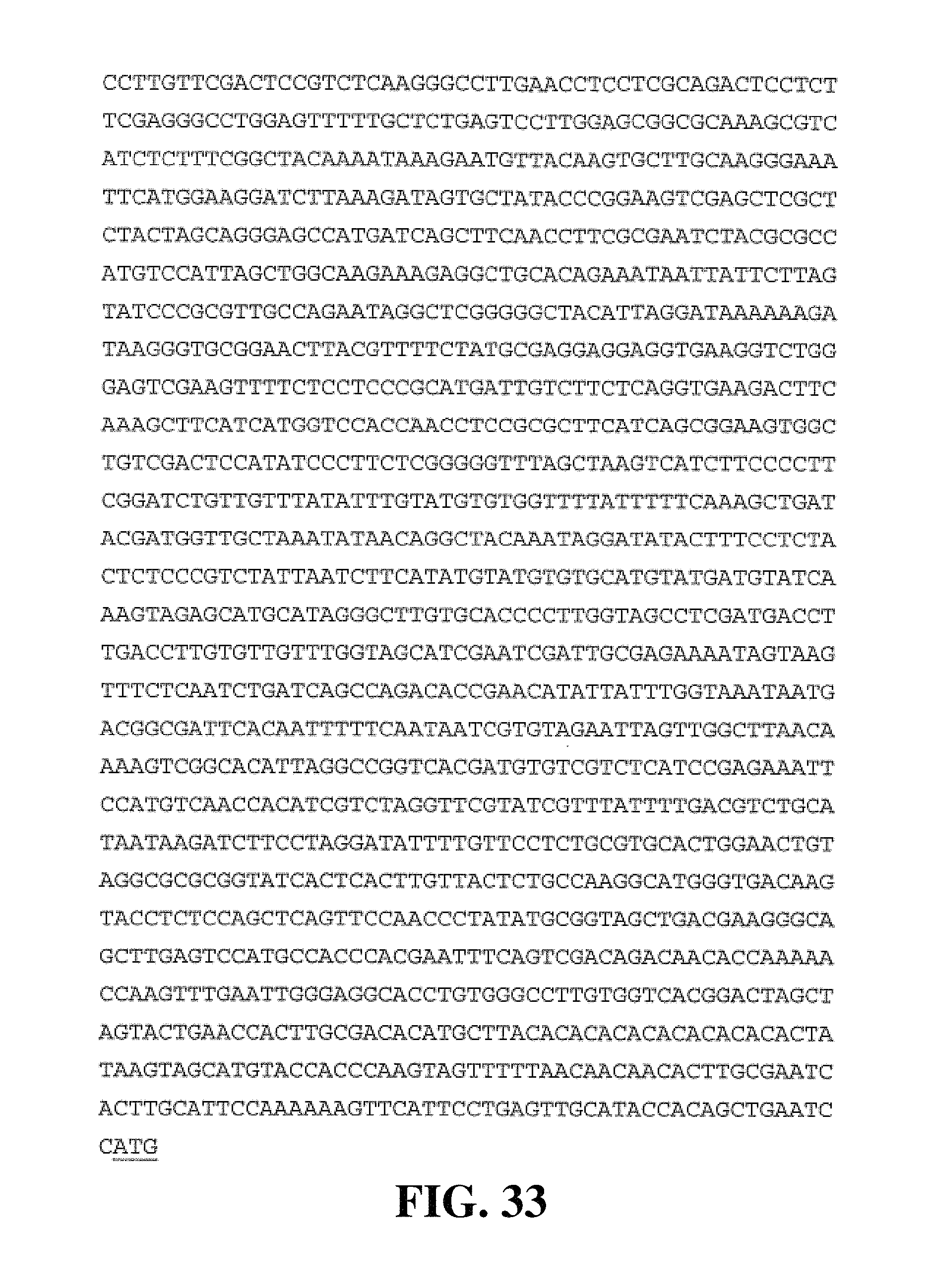
D00089
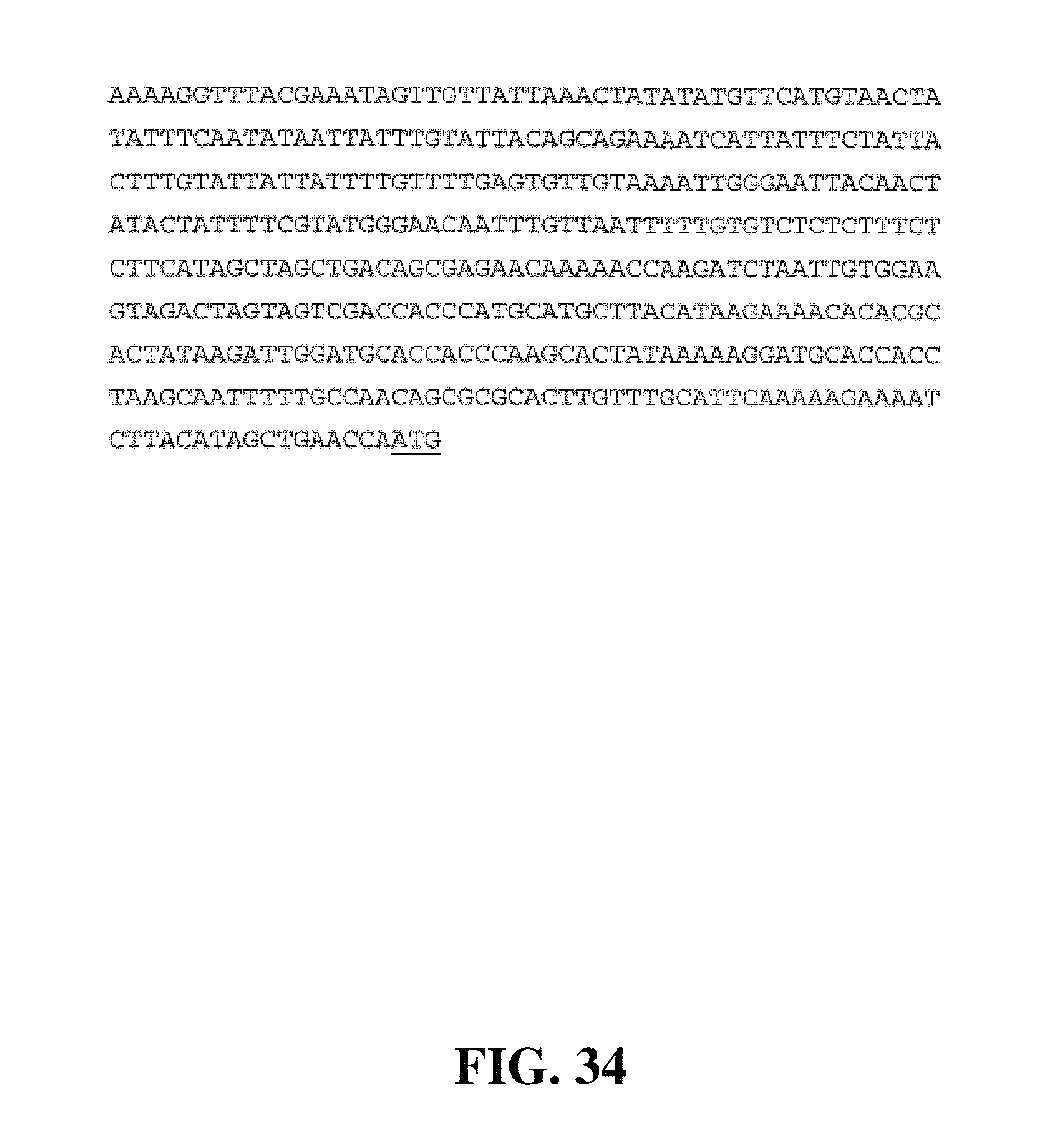
D00090
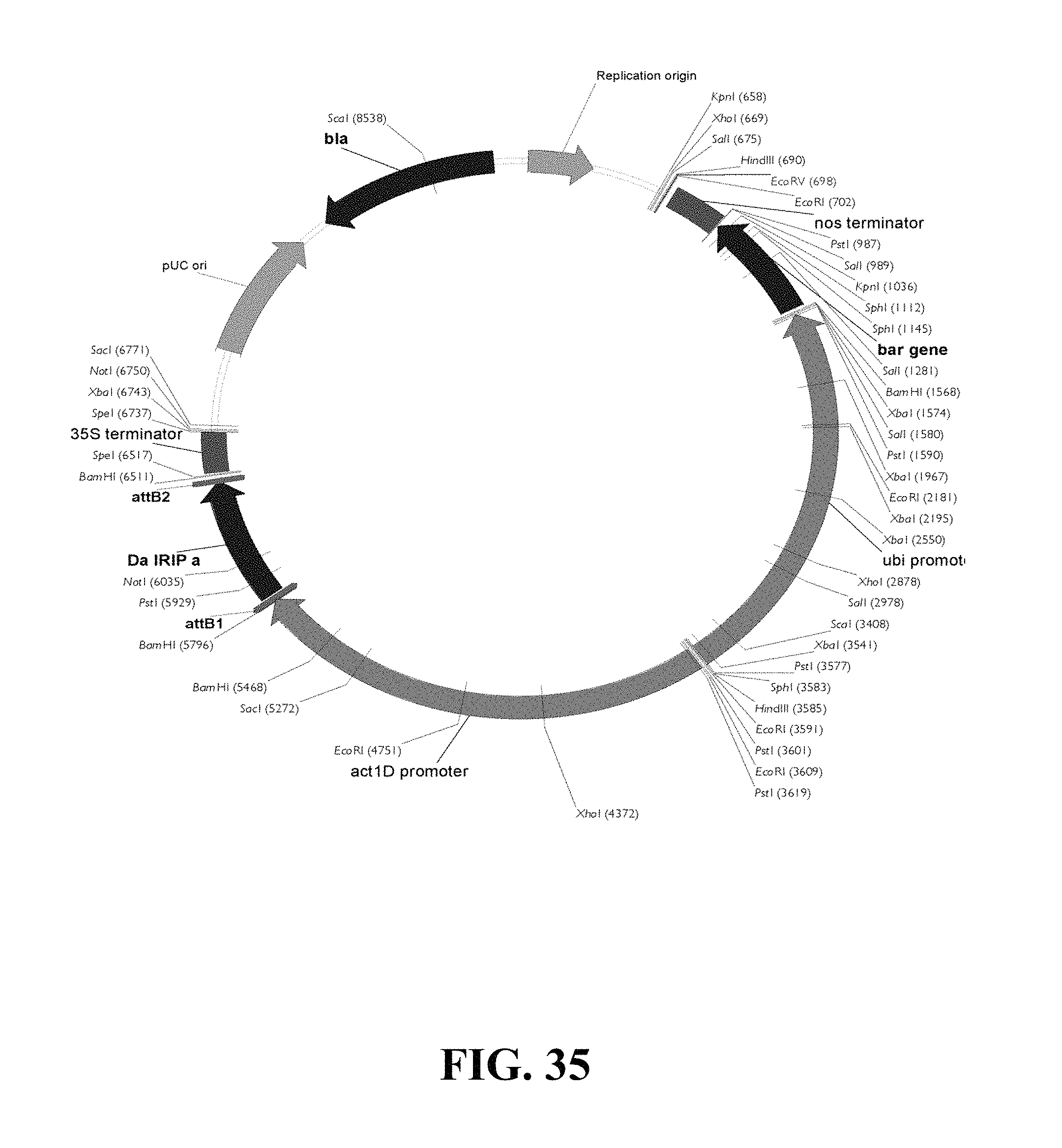
D00091
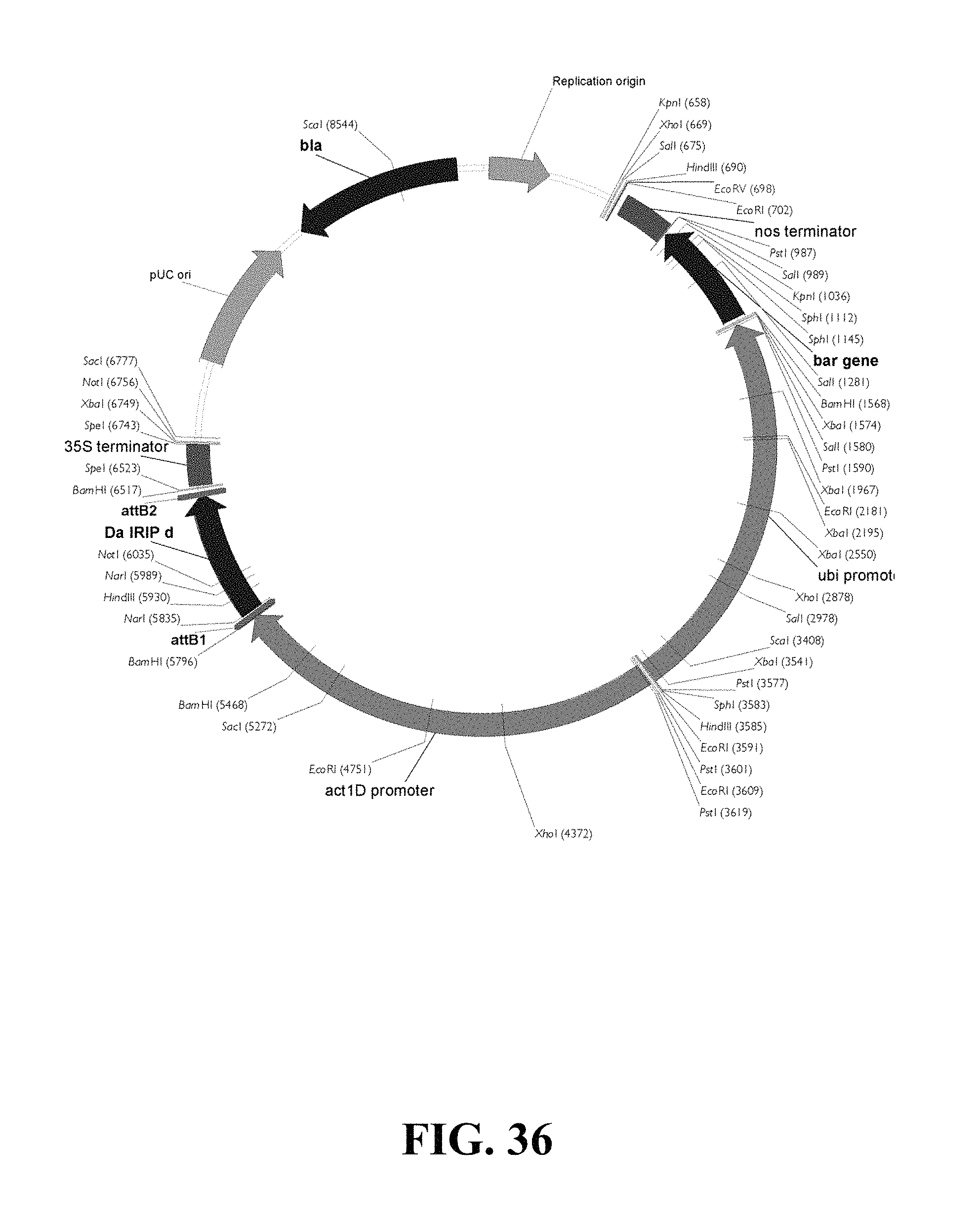
D00092
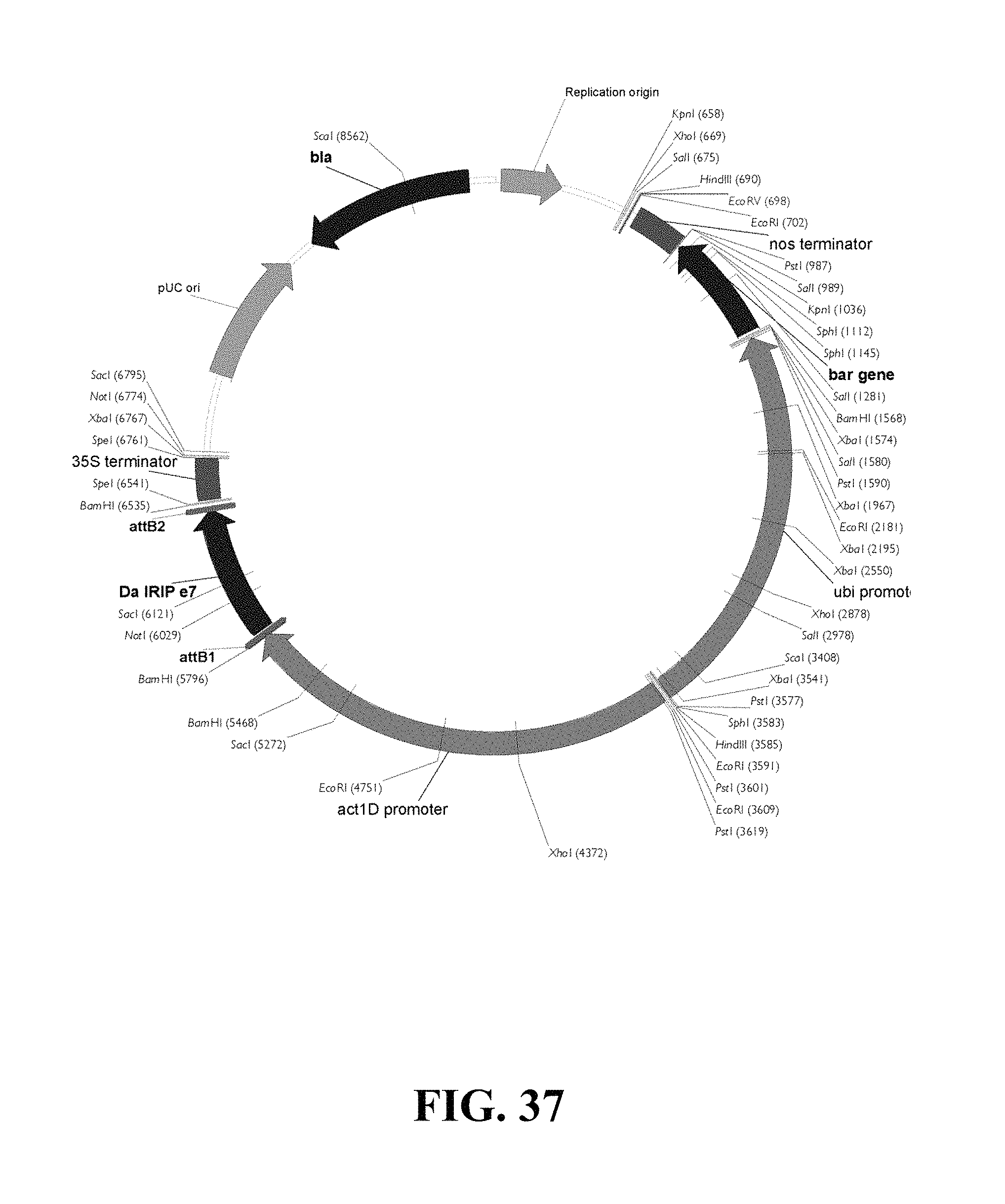
D00093
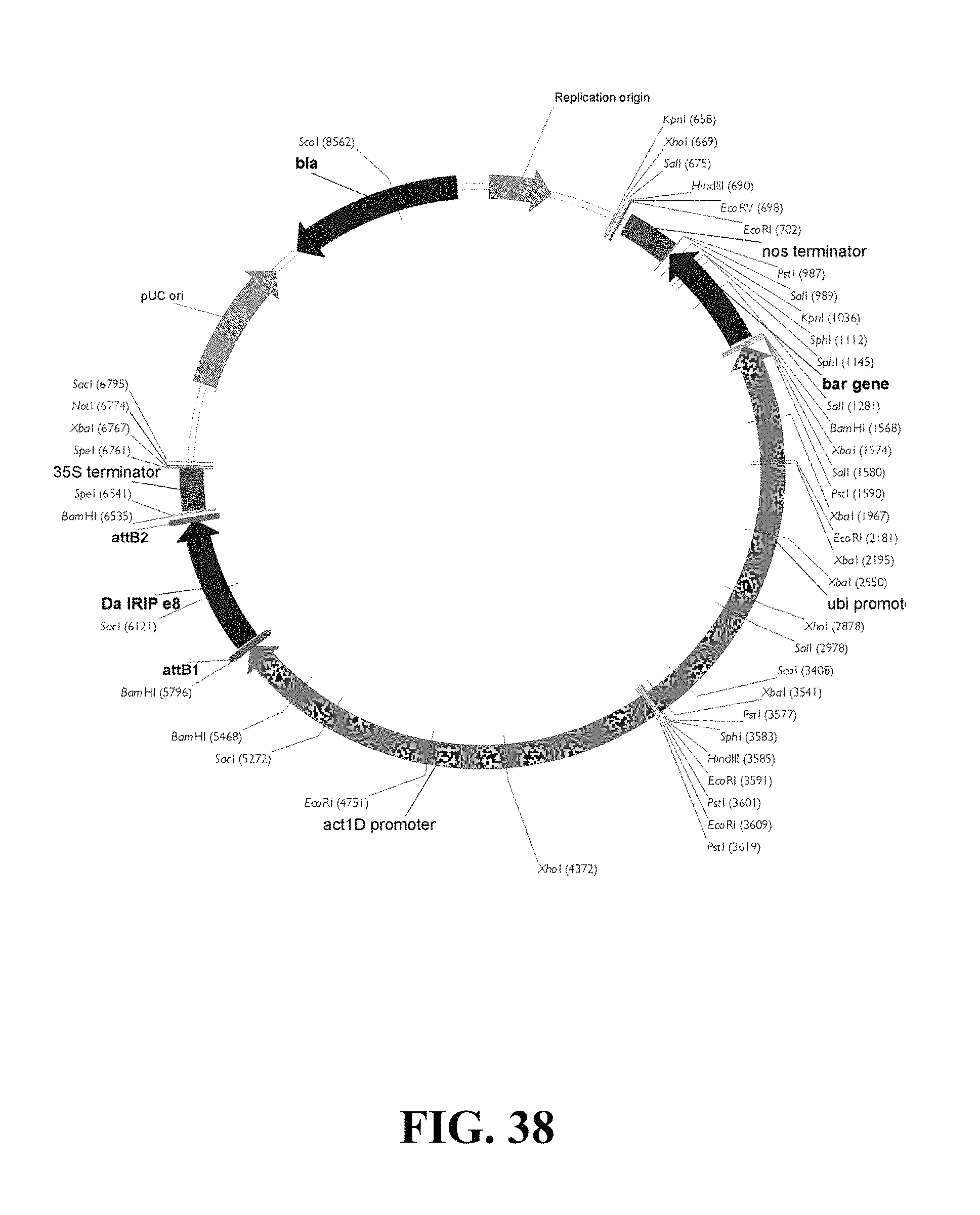
D00094

D00095
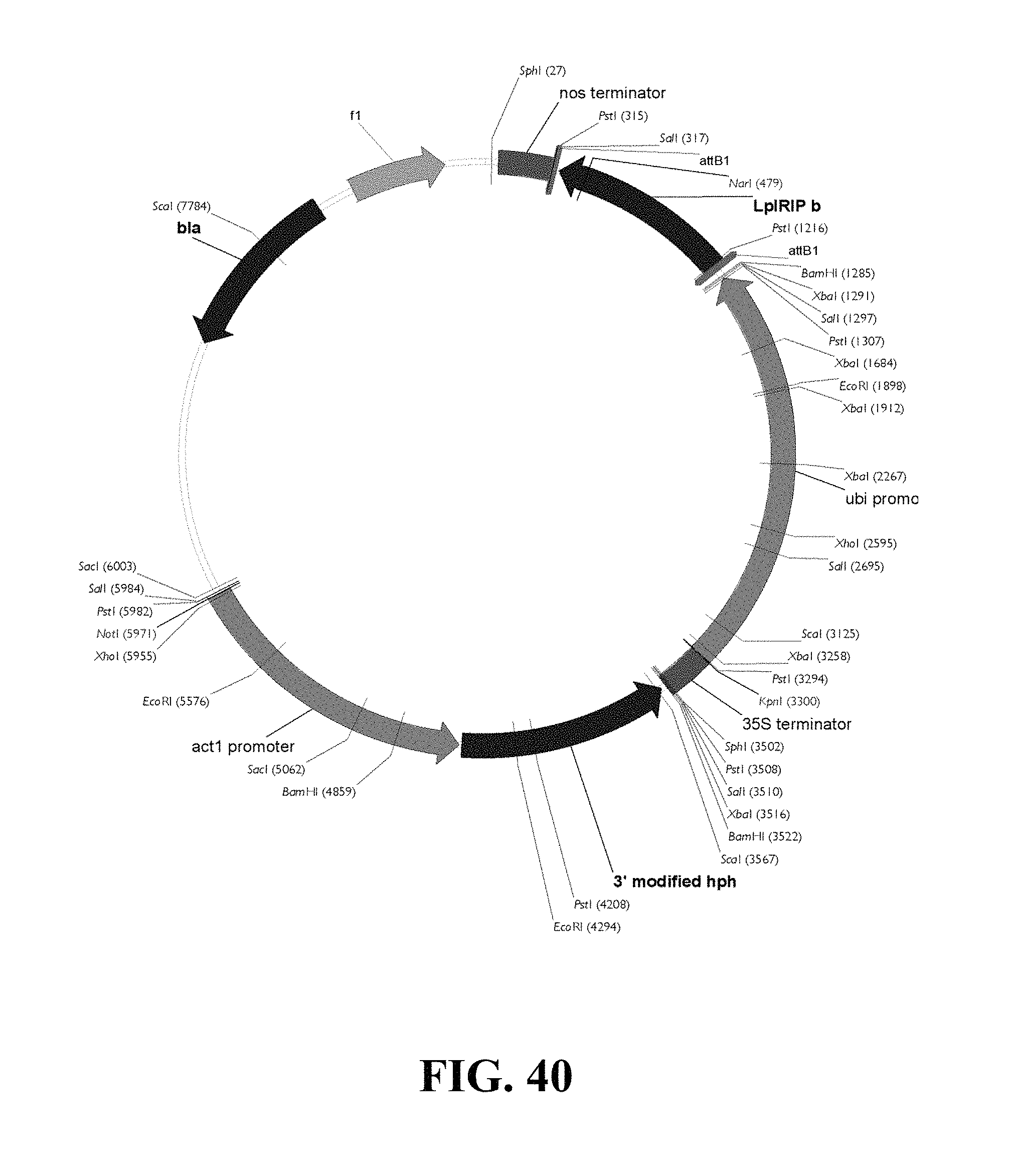
D00096

D00097

D00098
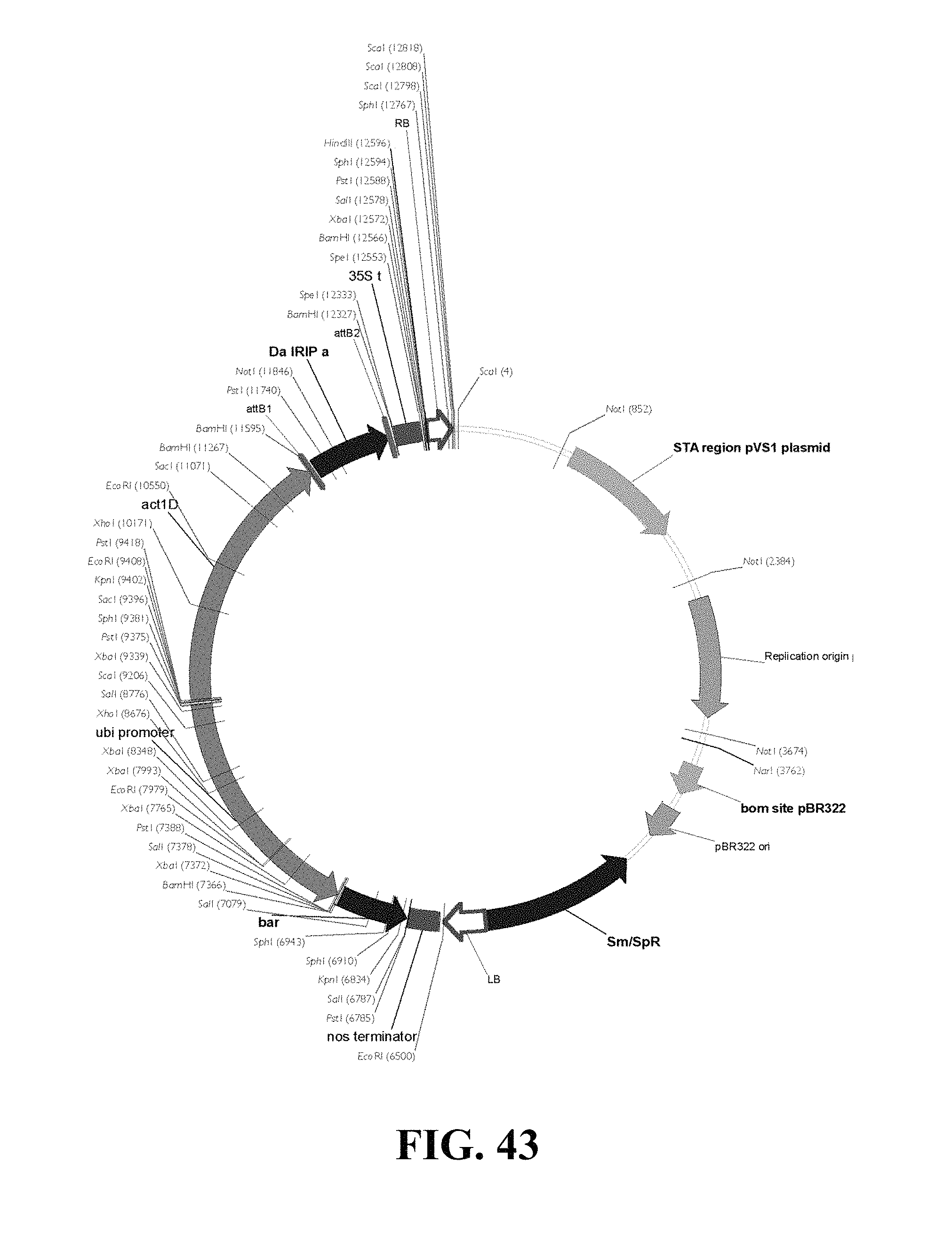
D00099

D00100
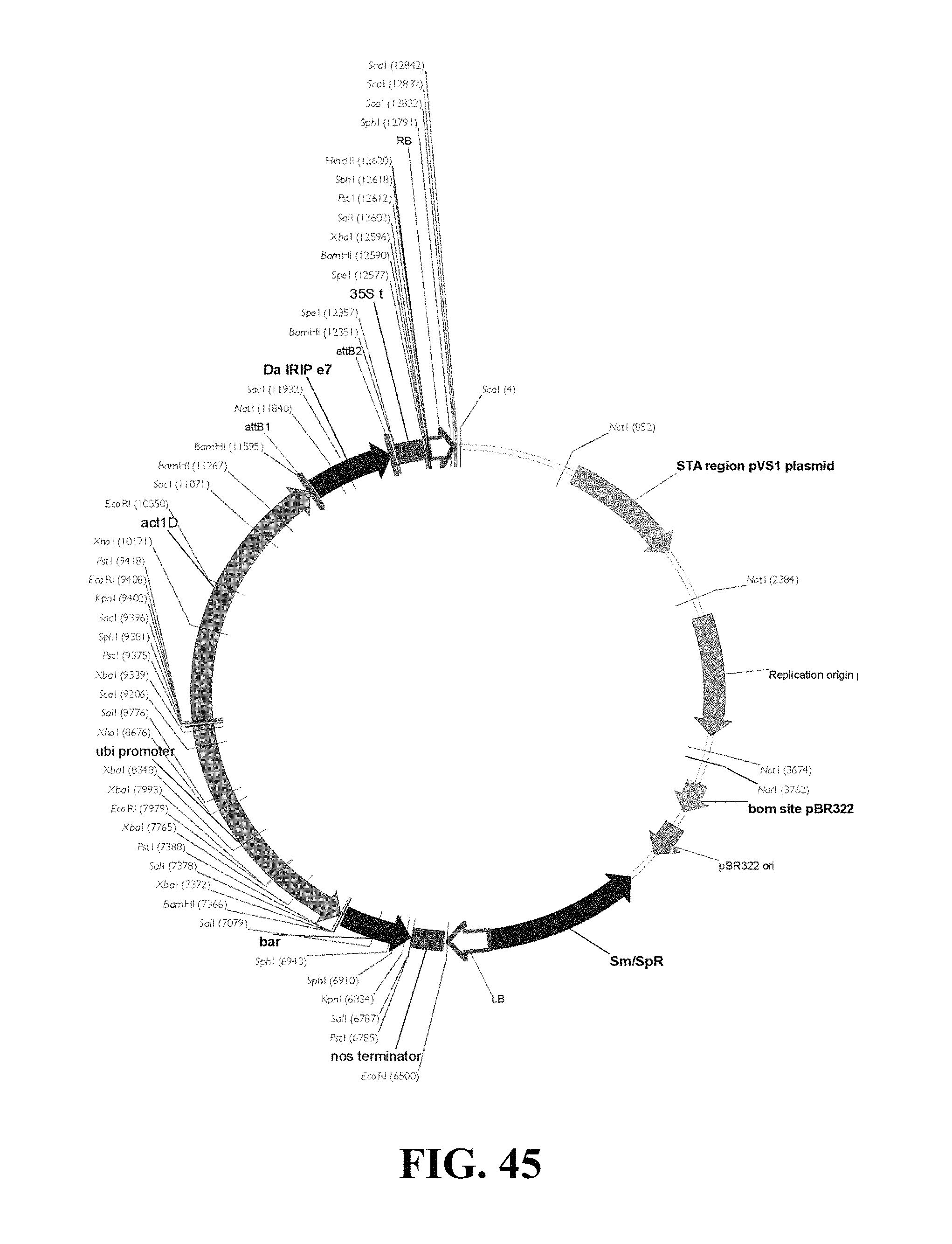
D00101

D00102
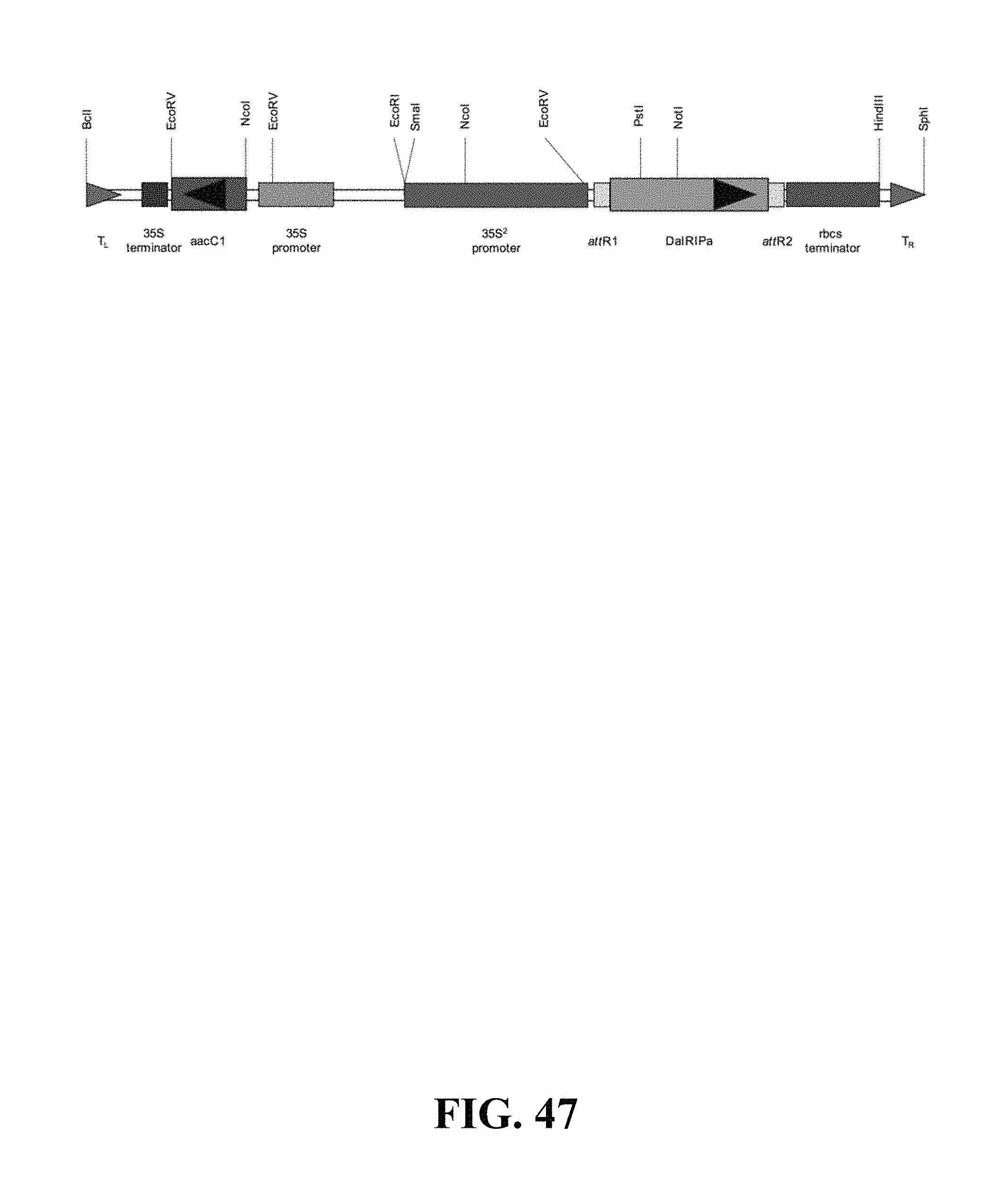
D00103

D00104
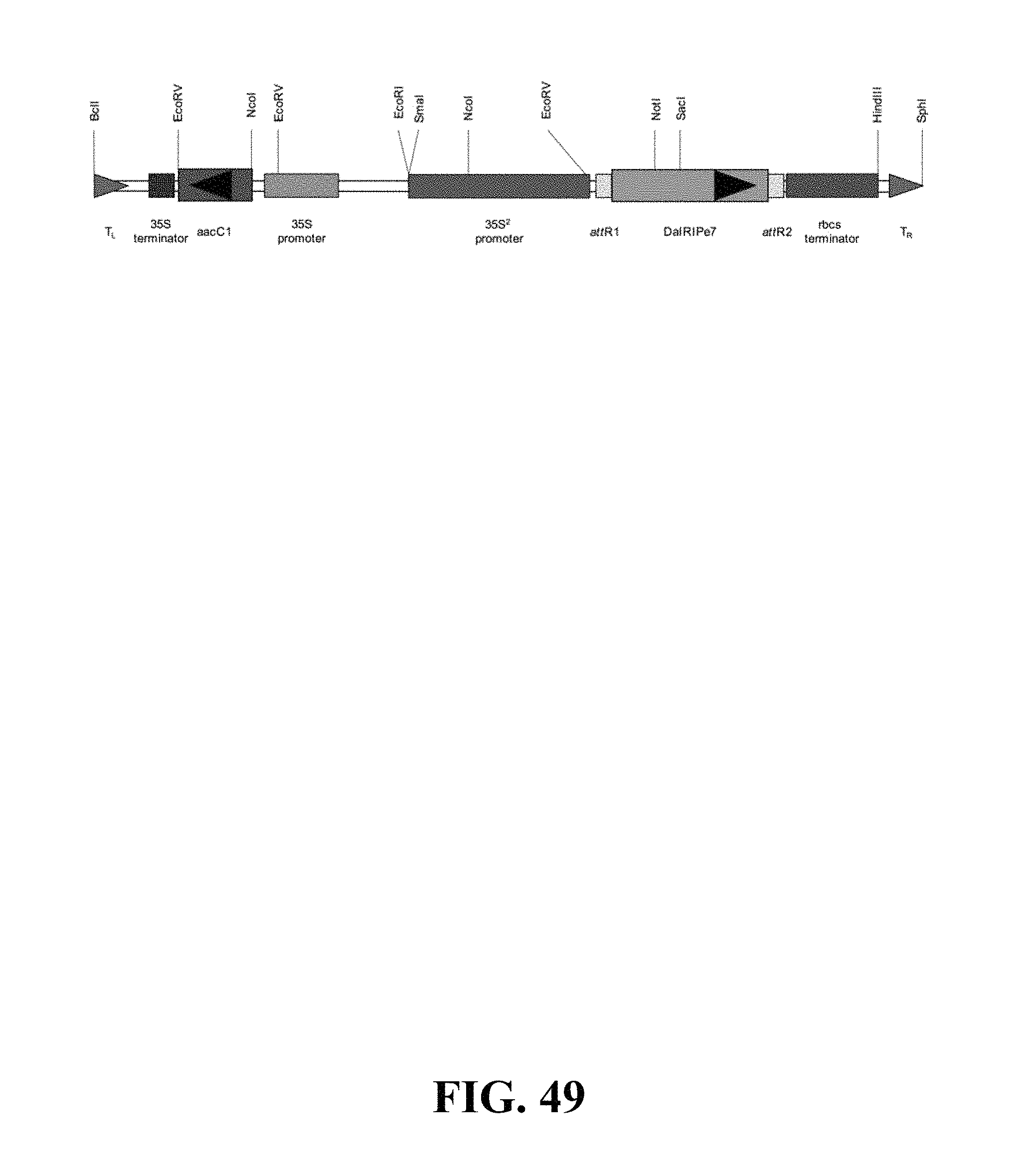
D00105
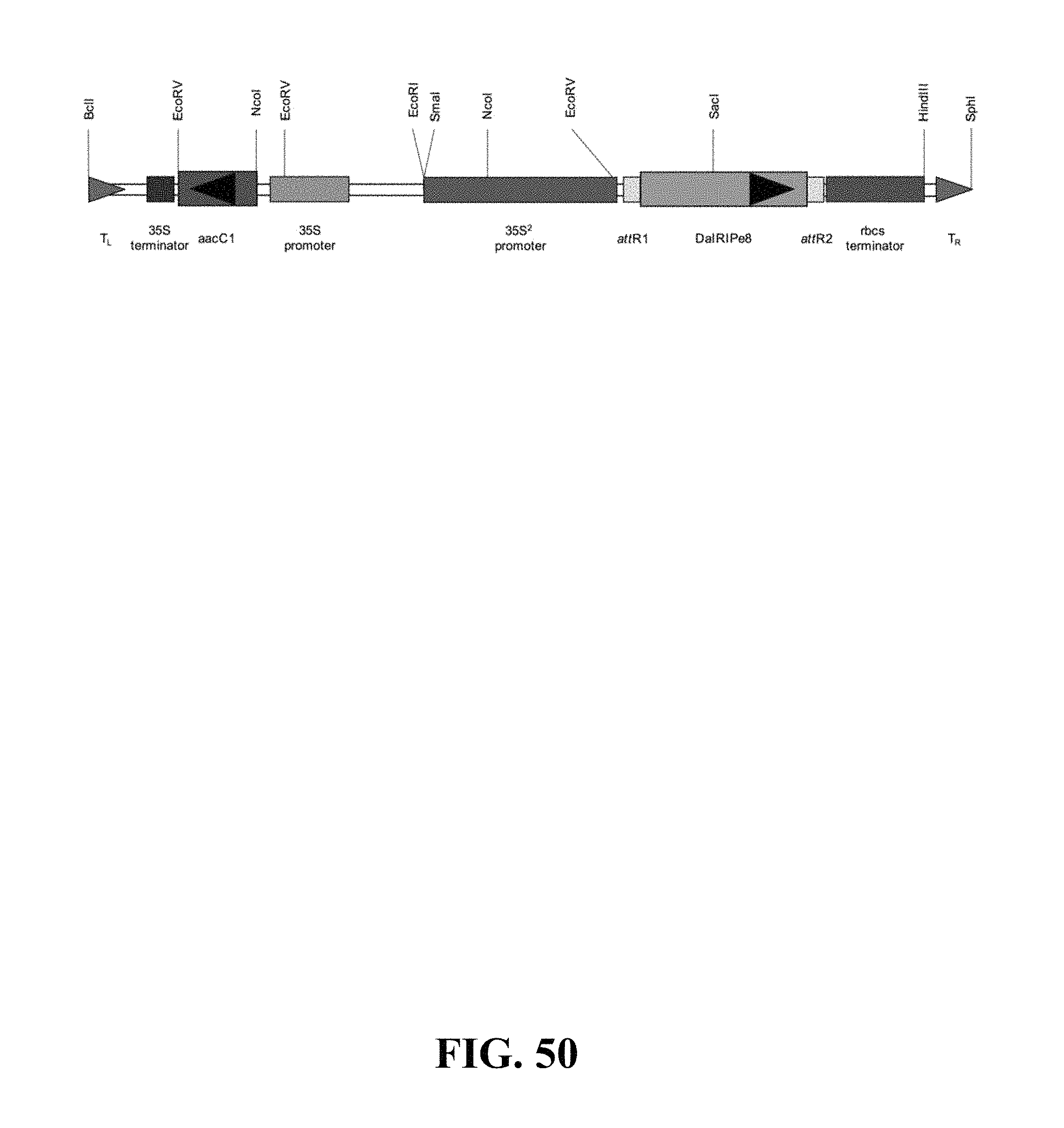
D00106
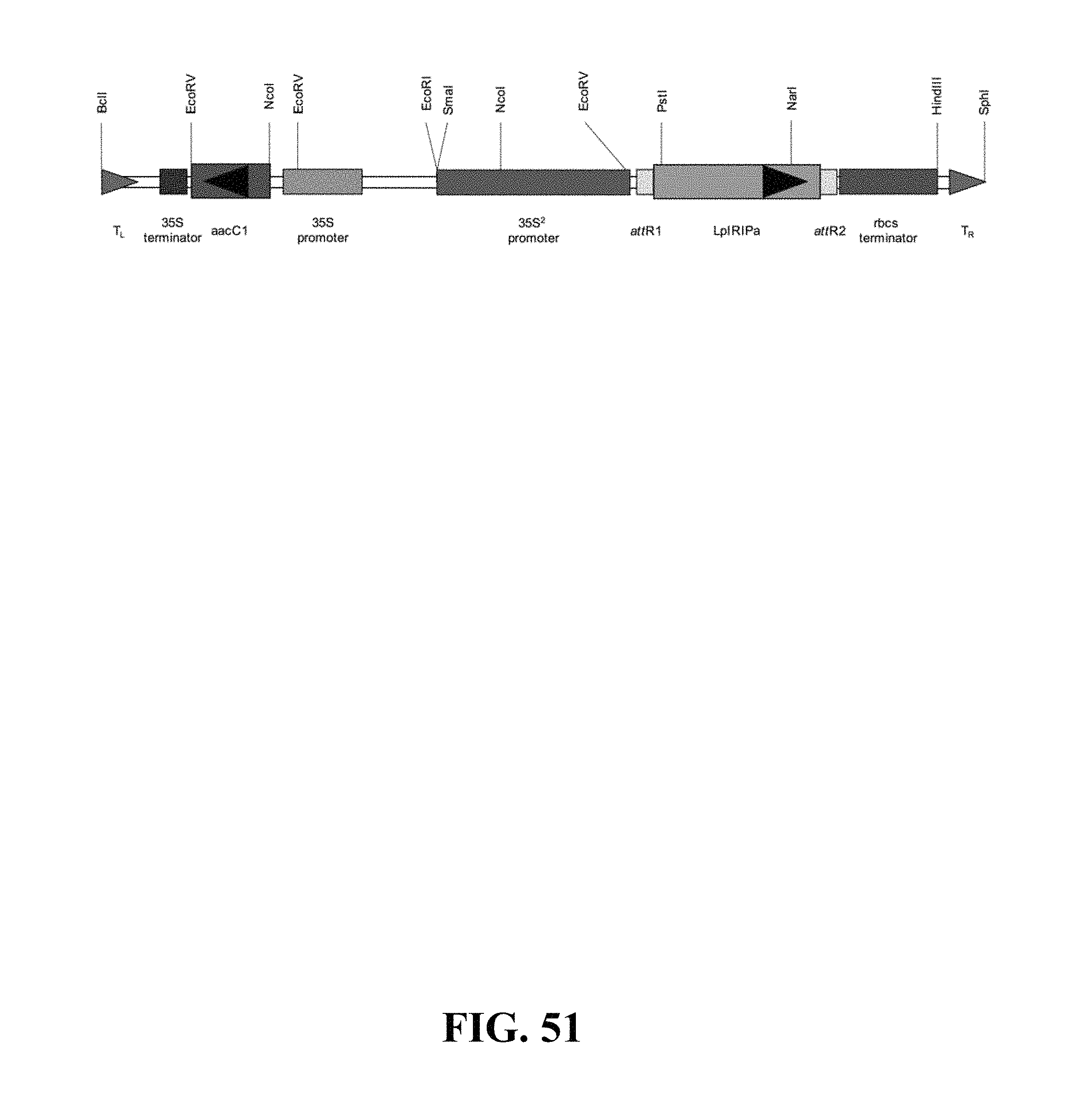
D00107
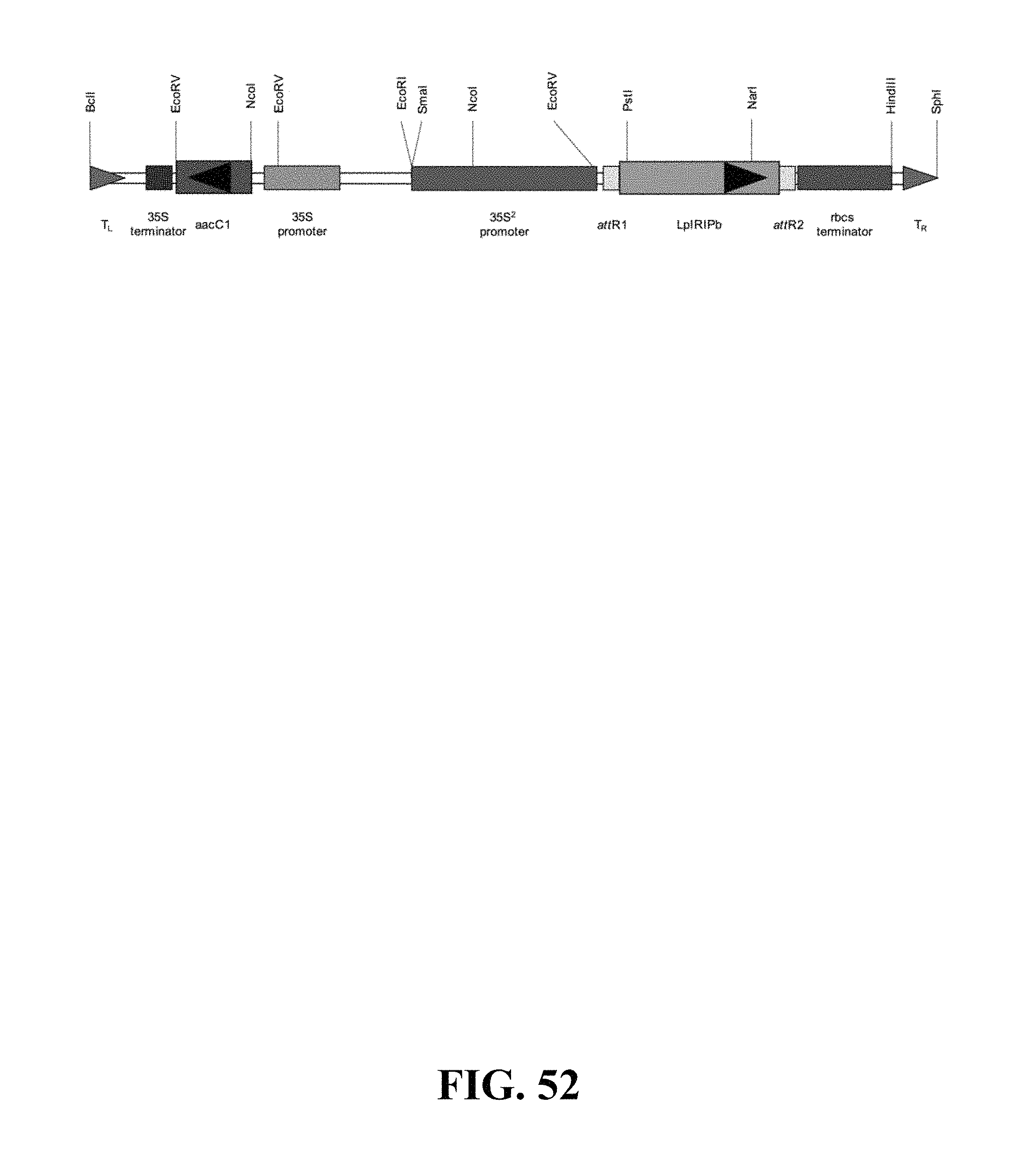
D00108
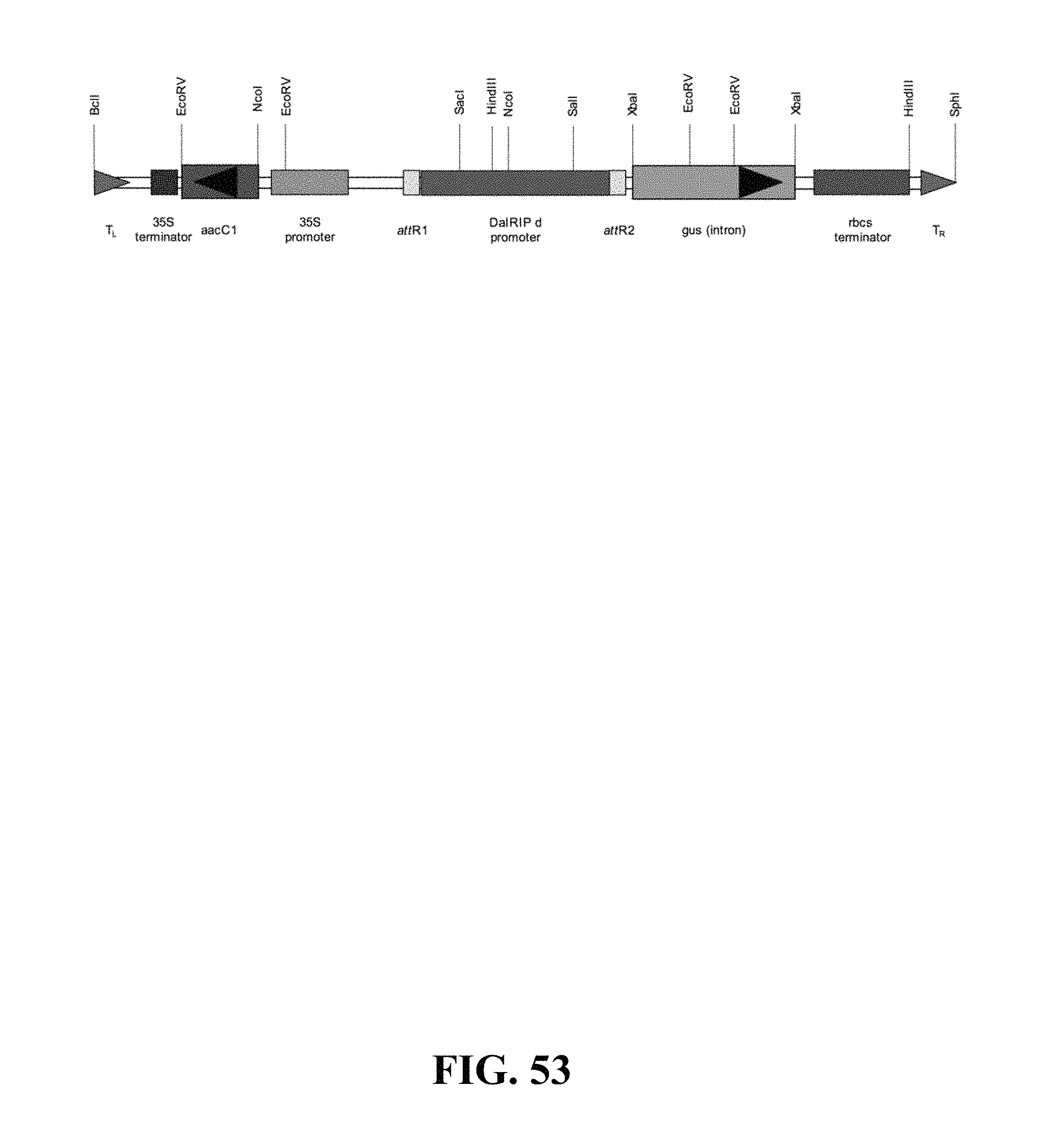
S00001
XML
uspto.report is an independent third-party trademark research tool that is not affiliated, endorsed, or sponsored by the United States Patent and Trademark Office (USPTO) or any other governmental organization. The information provided by uspto.report is based on publicly available data at the time of writing and is intended for informational purposes only.
While we strive to provide accurate and up-to-date information, we do not guarantee the accuracy, completeness, reliability, or suitability of the information displayed on this site. The use of this site is at your own risk. Any reliance you place on such information is therefore strictly at your own risk.
All official trademark data, including owner information, should be verified by visiting the official USPTO website at www.uspto.gov. This site is not intended to replace professional legal advice and should not be used as a substitute for consulting with a legal professional who is knowledgeable about trademark law.